ZyXEL Communications NBG416N Wireless N-lite Home Router User Manual
ZyXEL Communications Corporation Wireless N-lite Home Router
User Manual

www.zyxel.com
www.zyxel.com
NBG-416N
Wireless N-lite Home Router
Copyright © 2011
ZyXEL Communications Corporation
Firmware Version 1.0
Edition 1, 12/2010
Default Login Details
IP Address http://192.168.1.1
Username admin
Password 1234

About This User's Guide
NBG-416N User’s Guide 3
About This User's Guide
Intended Audience
This manual is intended for people who want to configure the NBG-416N using the
Web Configurator. You should have at least a basic knowledge of TCP/IP
networking concepts and topology.
Tips for Reading User’s Guides On-Screen
When reading a ZyXEL User’s Guide On-Screen, keep the following in mind:
• If you don’t already have the latest version of Adobe Reader, you can download
it from http://www.adobe.com.
• Use the PDF’s bookmarks to quickly navigate to the areas that interest you.
Adobe Reader’s bookmarks pane opens by default in all ZyXEL User’s Guide
PDFs.
• If you know the page number or know vaguely which page-range you want to
view, you can enter a number in the toolbar in Reader, then press [ENTER] to
jump directly to that page.
• Type [CTRL]+[F] to open the Adobe Reader search utility and enter a word or
phrase. This can help you quickly pinpoint the information you require. You can
also enter text directly into the toolbar in Reader.
• To quickly move around within a page, press the [SPACE] bar. This turns your
cursor into a “hand” with which you can grab the page and move it around freely
on your screen.
• Embedded hyperlinks are actually cross-references to related text. Click them to
jump to the corresponding section of the User’s Guide PDF.
Related Documentation
•Quick Start Guide
The Quick Start Guide is designed to help you get your NBG-416N up and
running right away. It contains information on setting up your network and
configuring for Internet access.
• Supporting Disc
The embedded Web Help contains descriptions of individual screens and
supplementary information.
• Support Disc
Refer to the included CD for support documents.

About This User's Guide
NBG-416N User’s Guide
4
Documentation Feedback
Send your comments, questions or suggestions to: techwriters@zyxel.com.tw
Thank you!
The Technical Writing Team, ZyXEL Communications Corp.,
6 Innovation Road II, Science-Based Industrial Park, Hsinchu, 30099, Taiwan.
Need More Help?
More help is available at www.zyxel.com.
• Download Library
Search for the latest product updates and documentation from this link. Read
the Tech Doc Overview to find out how to efficiently use the User Guide, Quick
Start Guide and Command Line Interface Reference Guide in order to better
understand how to use your product.
• Knowledge Base
If you have a specific question about your product, the answer may be here.
This is a collection of answers to previously asked questions about ZyXEL
products.
•Forum
This contains discussions on ZyXEL products. Learn from others who use ZyXEL
products and share your experiences as well.

About This User's Guide
NBG-416N User’s Guide 5
Customer Support
Should problems arise that cannot be solved by the methods listed above, you
should contact your vendor. If you cannot contact your vendor, then contact a
ZyXEL office for the region in which you bought the device.
See http://www.zyxel.com/web/contact_us.php for contact information. Please
have the following information ready when you contact an office.
• Product model and serial number.
•Warranty Information.
• Date that you received your device.

Document Conventions
NBG-416N User’s Guide
6
Document Conventions
Warnings and Notes
These are how warnings and notes are shown in this User’s Guide.
Warnings tell you about things that could harm you or your device.
Note: Notes tell you other important information (for example, other things you may
need to configure or helpful tips) or recommendations.
Syntax Conventions
• The NBG-416N may be referred to as the “NBG-416N”, the “device”, the
“product” or the “system” in this User’s Guide.
• Product labels, screen names, field labels and field choices are all in bold font.
• A key stroke is denoted by square brackets and uppercase text, for example,
[ENTER] means the “enter” or “return” key on your keyboard.
• “Enter” means for you to type one or more characters and then press the
[ENTER] key. “Select” or “choose” means for you to use one of the predefined
choices.
• A right angle bracket ( > ) within a screen name denotes a mouse click. For
example, Maintenance > Log > Log Setting means you first click
Maintenance in the navigation panel, then the Log sub menu and finally the
Log Setting tab to get to that screen.
• Units of measurement may denote the “metric” value or the “scientific” value.
For example, “k” for kilo may denote “1000” or “1024”, “M” for mega may
denote “1000000” or “1048576” and so on.
• “e.g.,” is a shorthand for “for instance”, and “i.e.,” means “that is” or “in other
words”.

Document Conventions
NBG-416N User’s Guide 7
Icons Used in Figures
Figures in this User’s Guide may use the following generic icons. The NBG-416N
icon is not an exact representation of your device.
NBG-416N Computer Notebook computer
Server Modem Firewall
Telephone Switch Router

Safety Warnings
NBG-416N User’s Guide
8
Safety Warnings
• Do NOT use this product near water, for example, in a wet basement or near a swimming
pool.
• Do NOT expose your device to dampness, dust or corrosive liquids.
• Do NOT store things on the device.
• Do NOT install, use, or service this device during a thunderstorm. There is a remote risk
of electric shock from lightning.
• Connect ONLY suitable accessories to the device.
• Do NOT open the device or unit. Opening or removing covers can expose you to
dangerous high voltage points or other risks. ONLY qualified service personnel should
service or disassemble this device. Please contact your vendor for further information.
• Make sure to connect the cables to the correct ports.
• Place connecting cables carefully so that no one will step on them or stumble over them.
• Always disconnect all cables from this device before servicing or disassembling.
• Use ONLY an appropriate power adaptor or cord for your device.
• Connect the power adaptor or cord to the right supply voltage (for example, 110V AC in
North America or 230V AC in Europe).
• Do NOT allow anything to rest on the power adaptor or cord and do NOT place the
product where anyone can walk on the power adaptor or cord.
• Do NOT use the device if the power adaptor or cord is damaged as it might cause
electrocution.
• If the power adaptor or cord is damaged, remove it from the power outlet.
• Do NOT attempt to repair the power adaptor or cord. Contact your local vendor to order a
new one.
• Do not use the device outside, and make sure all the connections are indoors. There is a
remote risk of electric shock from lightning.
• Do NOT obstruct the device ventilation slots, as insufficient airflow may harm your
device.
• Antenna Warning! This device meets ETSI and FCC certification requirements when using
the included antenna(s). Only use the included antenna(s).
• If you wall mount your device, make sure that no electrical lines, gas or water pipes will
be damaged.
Your product is marked with this symbol, which is known as the WEEE mark. WEEE
stands for Waste Electronics and Electrical Equipment. It means that used electrical
and electronic products should not be mixed with general waste. Used electrical and
electronic equipment should be treated separately.

Contents Overview
NBG-416N User’s Guide 9
Contents Overview
User’s Guide ...........................................................................................................................17
Introduction ................................................................................................................................ 19
The WPS Button ........................................................................................................................ 23
The Web Configurator ............................................................................................................... 25
Connection Wizard .................................................................................................................... 35
AP Mode .................................................................................................................................... 49
Tutorials ..................................................................................................................................... 57
Technical Reference ..............................................................................................................65
Wireless LAN ............................................................................................................................. 67
WAN .......................................................................................................................................... 83
LAN ............................................................................................................................................ 91
DHCP Server ............................................................................................................................. 95
Network Address Translation (NAT) ........................................................................................ 101
Firewall .................................................................................................................................... 109
Remote Management ...............................................................................................................113
Universal Plug-and-Play (UPnP) ..............................................................................................117
System ..................................................................................................................................... 125
Logs ......................................................................................................................................... 131
Tools ........................................................................................................................................ 133
Sys OP Mode .......................................................................................................................... 139
Language ................................................................................................................................. 143
Troubleshooting ....................................................................................................................... 145
Product Specifications ............................................................................................................. 153

Contents Overview
NBG-416N User’s Guide
10

Table of Contents
NBG-416N User’s Guide 11
Table of Contents
About This User's Guide..........................................................................................................3
Document Conventions............................................................................................................6
Safety Warnings........................................................................................................................8
Contents Overview ...................................................................................................................9
Table of Contents....................................................................................................................11
Part I: User’s Guide................................................................................ 17
Chapter 1
Introduction.............................................................................................................................19
1.1 Overview .............................................................................................................................. 19
1.2 Applications ......................................................................................................................... 19
1.3 Ways to Manage the NBG-416N ......................................................................................... 20
1.4 Good Habits for Managing the NBG-416N .......................................................................... 20
1.5 LEDs .................................................................................................................................... 20
Chapter 2
The WPS Button......................................................................................................................23
2.1 Overview .............................................................................................................................. 23
Chapter 3
The Web Configurator ............................................................................................................25
3.1 Overview .............................................................................................................................. 25
3.2 Accessing the Web Configurator ......................................................................................... 25
3.3 Resetting the NBG-416N .....................................................................................................27
3.3.1 Using the RESET Button ............................................................................................ 27
3.4 Navigating the Web Configurator ...................................................................................... 27
3.5 Status Screen (Router Mode) .............................................................................................. 28
3.5.1 Navigation Panel ........................................................................................................ 30
3.5.2 Summary: DHCP Table ........................................................................................... 32
3.5.3 Summary: Packet Statistics ..................................................................................... 33
3.5.4 Summary: WLAN Station Status ............................................................................ 34
Chapter 4
Connection Wizard .................................................................................................................35

Table of Contents
NBG-416N User’s Guide
12
4.1 Wizard Setup ....................................................................................................................... 35
4.2 Connection Wizard: STEP 1: System Information ............................................................... 36
4.2.1 System Name ............................................................................................................. 36
4.2.2 Domain Name ............................................................................................................ 37
4.3 Connection Wizard: STEP 2: Wireless LAN ........................................................................ 38
4.3.1 Extend (WPA-PSK or WPA2-PSK) Security ............................................................... 39
4.4 Connection Wizard: STEP 3: Internet Configuration ........................................................... 39
4.4.1 Ethernet Connection .................................................................................................. 40
4.4.2 PPPoE Connection .................................................................................................... 40
4.4.3 PPTP Connection ....................................................................................................... 42
4.4.4 Your IP Address ......................................................................................................... 43
4.4.5 WAN IP Address Assignment ..................................................................................... 44
4.4.6 IP Address and Subnet Mask ..................................................................................... 44
4.4.7 DNS Server Address Assignment .............................................................................. 45
4.4.8 WAN IP and DNS Server Address Assignment ......................................................... 46
4.4.9 WAN MAC Address .................................................................................................... 47
4.5 Connection Wizard Complete .............................................................................................. 48
Chapter 5
AP Mode...................................................................................................................................49
5.1 Overview .............................................................................................................................. 49
5.2 Setting your NBG-416N to AP Mode ................................................................................... 49
5.3 Status Screen (AP Mode) ....................................................................................................50
5.3.1 Navigation Panel ........................................................................................................ 52
5.4 Configuring Your Settings .................................................................................................... 53
5.4.1 LAN Settings .............................................................................................................. 53
5.4.2 WLAN and Maintenance Settings .............................................................................. 54
5.5 Logging in to the Web Configurator in AP Mode ................................................................. 54
Chapter 6
Tutorials...................................................................................................................................57
6.1 Overview .............................................................................................................................. 57
6.2 How to Connect to the Internet from an AP ......................................................................... 57
6.2.1 Configure Wireless Security Using WPS on both your NBG-416N and Wireless Client
57
6.3 Enable and Configure Wireless Security without WPS on your NBG-416N ........................ 61
Part II: Technical Reference .................................................................. 65
Chapter 7
Wireless LAN...........................................................................................................................67
7.1 Overview .............................................................................................................................. 67

Table of Contents
NBG-416N User’s Guide 13
7.2 What You Can Do ................................................................................................................ 68
7.3 What You Should Know .......................................................................................................68
7.3.1 Wireless Security Overview ....................................................................................... 68
7.4 General Wireless LAN Screen ............................................................................................ 71
7.4.1 No Security ................................................................................................................. 72
7.4.2 WEP Encryption ......................................................................................................... 73
7.4.3 WPA-PSK/WPA2-PSK ................................................................................................ 75
7.5 MAC Filter ............................................................................................................................ 76
7.6 Wireless LAN Advanced Screen ......................................................................................... 77
7.7 Quality of Service (QoS) Screen ......................................................................................... 79
7.8 WPS Screen ........................................................................................................................ 80
7.9 WPS Station Screen ............................................................................................................ 81
7.10 Scheduling Screen ............................................................................................................ 81
Chapter 8
WAN..........................................................................................................................................83
8.1 Overview .............................................................................................................................. 83
8.2 What You Need To Know ..................................................................................................... 83
8.2.1 Configuring Your Internet Connection ........................................................................ 84
8.3 Internet Connection ............................................................................................................. 85
8.3.1 Ethernet Encapsulation .............................................................................................. 85
8.3.2 PPPoE Encapsulation ................................................................................................ 87
8.3.3 PPTP Encapsulation .................................................................................................. 88
Chapter 9
LAN...........................................................................................................................................91
9.1 Overview .............................................................................................................................. 91
9.2 What You Need To Know ..................................................................................................... 92
9.2.1 IP Pool Setup ............................................................................................................. 92
9.2.2 LAN TCP/IP ................................................................................................................ 92
9.3 LAN IP Screen ..................................................................................................................... 93
Chapter 10
DHCP Server............................................................................................................................95
10.1 Overview ............................................................................................................................ 95
10.2 What You Can Do .............................................................................................................. 95
10.3 What You Need To Know ................................................................................................... 95
10.4 General Screen ................................................................................................................. 96
10.5 Advanced Screen ........................................................................................................... 96
10.6 Client List Screen .............................................................................................................. 98
Chapter 11
Network Address Translation (NAT)....................................................................................101

Table of Contents
NBG-416N User’s Guide
14
11.1 Overview ....................................................................................................................... 101
11.2 What You Can Do ............................................................................................................ 102
11.2.1 What You Need To Know ........................................................................................ 102
11.3 General NAT Screen ........................................................................................................104
11.4 NAT Application Screen ................................................................................................. 105
11.5 Technical Reference ........................................................................................................ 107
11.5.1 NAT Port Forwarding: Services and Port Numbers ................................................ 107
11.5.2 NAT Port Forwarding Example ............................................................................... 108
Chapter 12
Firewall...................................................................................................................................109
12.1 Overview ........................................................................................................................ 109
12.2 What You Can Do ............................................................................................................ 109
12.3 What You Need To Know ..................................................................................................110
12.3.1 About the NBG-416N Firewall .................................................................................110
12.3.2 VPN Pass Through Features ..................................................................................110
12.4 General Firewall Screen ................................................................................................ 111
12.5 Services Screen ............................................................................................................111
Chapter 13
Remote Management............................................................................................................ 113
13.1 Overview ...........................................................................................................................113
13.2 What You Need To Know ..................................................................................................113
13.2.1 Remote Management Limitations ...........................................................................114
13.2.2 Remote Management and NAT ...............................................................................114
13.2.3 System Timeout ......................................................................................................114
13.3 WWW Screen ................................................................................................................115
Chapter 14
Universal Plug-and-Play (UPnP).......................................................................................... 117
14.1 Overview ..........................................................................................................................117
14.2 What You Need to Know ...................................................................................................117
14.3 UPnP Screen ....................................................................................................................118
14.4 Technical Reference .........................................................................................................119
14.4.1 Using UPnP in Windows XP Example ....................................................................119
14.4.2 Web Configurator Easy Access ............................................................................. 122
Chapter 15
System ...................................................................................................................................125
15.1 Overview .......................................................................................................................... 125
15.2 What You Can Do ............................................................................................................ 125
15.3 System General Screen ................................................................................................. 125
15.4 Time Setting Screen ........................................................................................................ 127

Table of Contents
NBG-416N User’s Guide 15
Chapter 16
Logs .......................................................................................................................................131
16.1 Overview .......................................................................................................................... 131
16.2 What You Need to Know .................................................................................................. 131
16.3 View Log Screen .............................................................................................................. 131
Chapter 17
Tools.......................................................................................................................................133
17.1 Overview .......................................................................................................................... 133
17.2 What You Can Do ............................................................................................................ 133
17.3 Firmware Upload Screen ................................................................................................. 133
17.4 Configuration Screen ....................................................................................................... 136
17.4.1 Backup Configuration ............................................................................................. 136
17.4.2 Restore Configuration ............................................................................................ 137
17.4.3 Back to Factory Defaults ........................................................................................ 138
17.5 Restart Screen ................................................................................................................. 138
Chapter 18
Sys OP Mode.........................................................................................................................139
18.1 Overview .......................................................................................................................... 139
18.2 What You Need to Know .................................................................................................. 139
18.3 General Screen ............................................................................................................... 140
Chapter 19
Language...............................................................................................................................143
19.1 Language Screen ............................................................................................................ 143
Chapter 20
Troubleshooting....................................................................................................................145
20.1 Power, Hardware Connections, and LEDs ...................................................................... 145
20.2 NBG-416N Access and Login .......................................................................................... 146
20.3 Internet Access ................................................................................................................ 148
20.4 Resetting the NBG-416N to Its Factory Defaults ............................................................. 149
20.5 Wireless Router/AP Troubleshooting ............................................................................... 150
Chapter 21
Product Specifications.........................................................................................................153
Appendix A IP Addresses and Subnetting ...........................................................................157
Appendix B Pop-up Windows, JavaScript and Java Permissions........................................167
Appendix C Setting up Your Computer’s IP Address ...........................................................175
21.0.1 Verifying Settings ................................................................................................... 192

Table of Contents
NBG-416N User’s Guide
16
Appendix D Wireless LANs ..................................................................................................193
21.0.2 WPA(2)-PSK Application Example ......................................................................... 203
21.0.3 WPA(2) with RADIUS Application Example ........................................................... 203
Appendix E Services ............................................................................................................205
Appendix F Open Software Announcements .......................................................................209
Appendix G Legal Information..............................................................................................231
Index.......................................................................................................................................239

17
PART I
User’s Guide

18
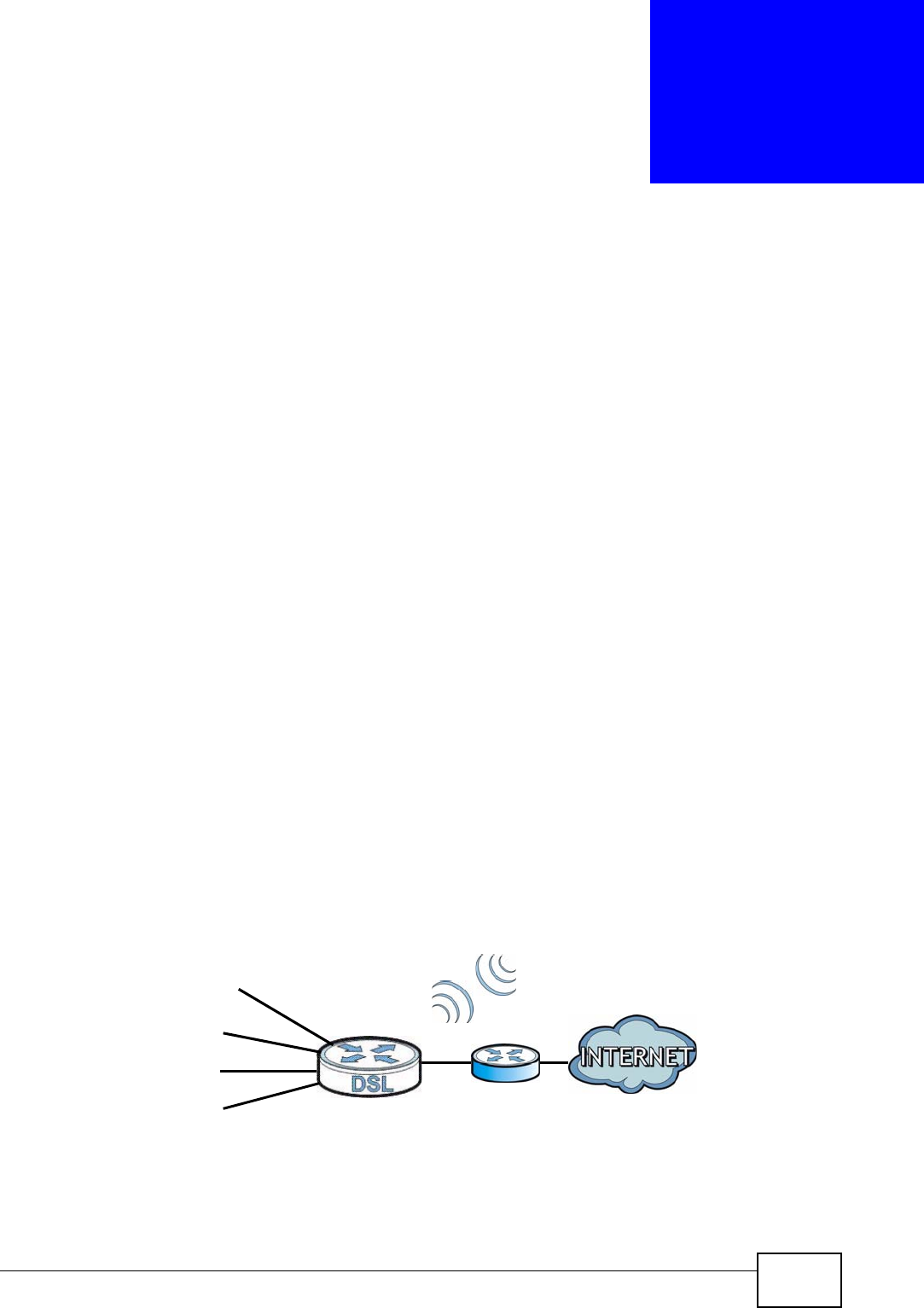
NBG-416N User’s Guide 19
CHAPTER 1
Introduction
1.1 Overview
This chapter introduces the main features and applications of the NBG-416N.
The NBG-416N extends the range of your existing wired network without
additional wiring, providing easy network access to mobile users. You can set up a
wireless network with other IEEE 802.11b/g/n compatible devices.
A range of services such as a firewall and content filtering are also available for
secure Internet computing.
1.2 Applications
Your can create the following networks using the NBG-416N:
•Wired. You can connect network devices via the Ethernet ports of the NBG-
416N so that they can communicate with each other and access the Internet.
•Wireless. Wireless clients can connect to the NBG-416N to access network
resources.
•WAN. Connect to a broadband modem/router for Internet access.
Figure 1 NBG-416N Network
LAN1
LAN2
LAN3
LAN4
WLAN

Chapter 1 Introduction
NBG-416N User’s Guide
20
1.3 Ways to Manage the NBG-416N
Use any of the following methods to manage the NBG-416N.
• WPS (Wi-Fi Protected Setup). You can use the WPS button or the WPS section of
the Web Configurator to set up a wireless network with your ZyXEL Device.
• Web Configurator. This is recommended for everyday management of the NBG-
416N using a (supported) web browser.
1.4 Good Habits for Managing the NBG-416N
Do the following things regularly to make the NBG-416N more secure and to
manage the NBG-416N more effectively.
• Change the password. Use a password that’s not easy to guess and that consists
of different types of characters, such as numbers and letters.
• Write down the password and put it in a safe place.
• Back up the configuration (and make sure you know how to restore it).
Restoring an earlier working configuration may be useful if the device becomes
unstable or even crashes. If you forget your password, you will have to reset the
NBG-416N to its factory default settings. If you backed up an earlier
configuration file, you would not have to totally re-configure the NBG-416N. You
could simply restore your last configuration.
1.5 LEDs
Figure 2 Front Panel
The following table describes the LEDs and the WPS button.
Table 1 Front Panel LEDs and WPS Button
LED COLOR STATUS DESCRIPTION
POWER Green On The NBG-416N is receiving power and
functioning properly.
Off The NBG-416N is not receiving power.

Chapter 1 Introduction
NBG-416N User’s Guide 21
LAN 1-4 Green On The NBG-416N has a successful 10/100MB LAN
connection.
Blinking The NBG-416N is sending/receiving data through
the LAN.
Off The LAN is not connected.
WAN Green On The NBG-416N has a successful 10/100MB WAN
connection.
Blinking The NBG-416N is sending/receiving data through
the WAN.
Off The WAN connection is not ready, or has failed.
WLAN Green On The NBG-416N is ready, but is not sending/
receiving data through the wireless LAN.
Blinking The NBG-416N is sending/receiving data through
the wireless LAN.
The NBG-416N is negotiating a WPS connection
with a wireless client.
Off The wireless LAN is not ready or has failed.
WPS Green On WPS status is configured.
Blinking The NBG-416N is negotiating a WPS connection
with a wireless client.
Off The WPS status is not configured or disabled.
Table 1 Front Panel LEDs and WPS Button (continued)
LED COLOR STATUS DESCRIPTION

Chapter 1 Introduction
NBG-416N User’s Guide
22

NBG-416N User’s Guide 23
CHAPTER 2
The WPS Button
2.1 Overview
Your NBG-416N supports WiFi Protected Setup (WPS), which is an easy way to set
up a secure wireless network. WPS is an industry standard specification, defined
by the WiFi Alliance.
WPS allows you to quickly set up a wireless network with strong security, without
having to configure security settings manually. Each WPS connection works
between two devices. Both devices must support WPS (check each device’s
documentation to make sure).
Depending on the devices you have, you can either press a button (on the device
itself, or in its configuration utility) or enter a PIN (a unique Personal Identification
Number that allows one device to authenticate the other) in each of the two
devices. When WPS is activated on a device, it has two minutes to find another
device that also has WPS activated. Then, the two devices connect and set up a
secure network by themselves.
For more information on using WPS, see Section 6.2.1 on page 57.

Chapter 2 The WPS Button
NBG-416N User’s Guide
24

NBG-416N User’s Guide 25
CHAPTER 3
The Web Configurator
3.1 Overview
This chapter describes how to access the NBG-416N Web Configurator and
provides an overview of its screens.
The Web Configurator is an HTML-based management interface that allows easy
setup and management of the NBG-416N via Internet browser. Use Internet
Explorer 6.0 and later versions, Mozilla Firefox 3 and later versions, or Safari 2.0
and later versions. The recommended screen resolution is 1024 by 768 pixels.
In order to use the Web Configurator you need to allow:
• Web browser pop-up windows from your device. Web pop-up blocking is enabled
by default in Windows XP SP (Service Pack) 2.
• JavaScript (enabled by default).
• Java permissions (enabled by default).
Refer to Chapter 20 Troubleshooting to see how to make sure these functions are
allowed in Internet Explorer.
3.2 Accessing the Web Configurator
1Make sure your NBG-416N hardware is properly connected and prepare your
computer or computer network to connect to the NBG-416N (refer to the Quick
Start Guide).
2Launch your web browser.
3Type "http://192.168.1.1" as the website address.
Your computer must be in the same subnet in order to access this website
address.

Chapter 3 The Web Configurator
NBG-416N User’s Guide
26
4Type admin (default) as the user name and 1234 (default) as the password and
click OK.
Figure 3 Login Screen
5You should see a screen asking you to change your password (highly
recommended) as shown next. Type a new password (and retype it to confirm)
and click Apply or click Ignore.
Figure 4 Change Password Screen
Note: The management session automatically times out when the time period set in
the Administrator Inactivity Timer field expires (default five minutes). Simply
log back into the NBG-416N if this happens.
6Select the setup mode you want to use.
•Click Go to Wizard Setup to use the Configuration Wizard for basic Internet
and Wireless setup.
•Click Go to Advanced Setup to view and configure all the NBG-416N’s
settings.

Chapter 3 The Web Configurator
NBG-416N User’s Guide 27
• Select a language to go to the basic Web Configurator in that language. To
change to the advanced configurator see Chapter 19 on page 143.
Figure 5 Selecting the setup mode
3.3 Resetting the NBG-416N
If you forget your password or IP address, or you cannot access the Web
Configurator, you will need to use the RESET button at the back of the NBG-416N
to reload the factory-default configuration file. This means that you will lose all
configurations that you had previously saved, the username will be reset to
admin and password will be reset to 1234. The IP address will be reset to
“192.168.1.1”.
3.3.1 Using the RESET Button
1Make sure the power LED is on.
2Press the RESET button for longer than 1 second to restart/reboot the NBG-416N.
3Press the RESET button for longer than five seconds to set the NBG-416N back to
its factory-default configurations.
3.4 Navigating the Web Configurator
The following summarizes how to navigate the Web Configurator from the Status
screen in Router Mode and AP Mode.

Chapter 3 The Web Configurator
NBG-416N User’s Guide
28
3.5 Status Screen (Router Mode)
Click on Status. The screen below shows the status screen in Router Mode.
(For information on the status screen in AP Mode see Chapter 5 on page 50.)
Figure 6 Status Screen (Router Mode)
The following table describes the icons shown in the Status screen.
Table 2 Status Screen Icon Key
ICON DESCRIPTION
Click this icon to open the setup wizard.
Click this icon to view copyright and a link for related product information.
Click this icon at any time to exit the Web Configurator.
Select a number of seconds or None from the drop-down list box to refresh
all screen statistics automatically at the end of every time interval or to not
refresh the screen statistics.
Click this button to refresh the status screen statistics.

Chapter 3 The Web Configurator
NBG-416N User’s Guide 29
The following table describes the labels shown in the Status screen.
Table 3 Web Configurator Status Screen (Router Mode)
LABEL DESCRIPTION
Device Information
System Name This is the System Name you enter in the Maintenance > System >
General screen. It is for identification purposes.
Firmware Version This is the current firmware version of the NBG-416N.
WAN Information
- MAC Address This shows the WAN Ethernet adapter MAC Address of your device.
- Connection Type This shows the current connection type.
- IP Address This shows the WAN port’s IP address.
- IP Subnet Mask This shows the WAN port’s subnet mask.
- Gateway This shows the WAN port’s gateway IP address.
- DNS This shows the IP address of your DNS server.
LAN Information
- MAC Address This shows the LAN Ethernet adapter MAC Address of your device.
- IP Address This shows the LAN port’s IP address.
- IP Subnet Mask This shows the LAN port’s subnet mask.
- DHCP This shows the LAN port’s DHCP role - Server or None.
WLAN Information
- MAC Address This shows the wireless adapter MAC Address of your device.
- Status This shows the current status of the Wireless LAN - On, Off or Off by
scheduler.
- Name (SSID) This shows a descriptive name used to identify the NBG-416N in the
wireless LAN.
- Channel This shows the channel number which you select manually.
- Security Mode This shows the level of wireless security the NBG-416N is using.
- 802.11 Mode This shows the wireless standard.
- WPS This displays Configured when the WPS has been set up.
This displays Unconfigured if the WPS has not been set up.
Click the status to display Network > Wireless LAN > WPS screen.
System Status
System Up Time This is the total time the NBG-416N has been on.
Current Date/Time This field displays your NBG-416N’s present date and time.
System Resource
- CPU Usage This displays what percentage of the NBG-416N’s processing ability is
currently used. When this percentage is close to 100%, the NBG-416N is
running at full load, and the throughput is not going to improve anymore.
If you want some applications to have more throughput, you should turn
off other applications.
- Memory Usage This shows what percentage of the heap memory the NBG-416N is using.

Chapter 3 The Web Configurator
NBG-416N User’s Guide
30
3.5.1 Navigation Panel
Use the sub-menus on the navigation panel to configure NBG-416N features.
The following table describes the sub-menus.
System Setting
- Firewall This shows whether the firewall is active or not.
- UPnP This shows whether UPnP is active or not.
Interface Status
Interface This displays the NBG-416N port types. The port types are: WAN, LAN
and WLAN.
Status For the LAN and WAN ports, this field displays Down (line is down) or Up
(line is up or connected).
For the WLAN, it displays Up when the WLAN is enabled or Down when
the WLAN is disabled.
Rate For the LAN ports, this displays the port speed and duplex setting or N/A
when the line is disconnected.
For the WAN port, it displays the port speed and duplex setting if you’re
using Ethernet encapsulation and Idle (line (ppp) idle), Dial (starting to
trigger a call) and Drop (dropping a call) if you're using PPPoE or PPTP
encapsulation. This field displays N/A when the line is disconnected.
For the WLAN, it displays the maximum transmission rate when the WLAN
is enabled and N/A when the WLAN is disabled.
Summary
DHCP Table Use this screen to view current DHCP client information.
Packet Statistics Use this screen to view port status and packet specific statistics.
WLAN Station Status Use this screen to view the wireless stations that are currently associated
to the NBG-416N.
Table 3 Web Configurator Status Screen (Router Mode) (continued)
LABEL DESCRIPTION
Table 4 Screens Summary
LINK TAB FUNCTION
Status This screen shows the NBG-416N’s general device, system
and interface status information. Use this screen to access
the wizard, and summary statistics tables.
Network
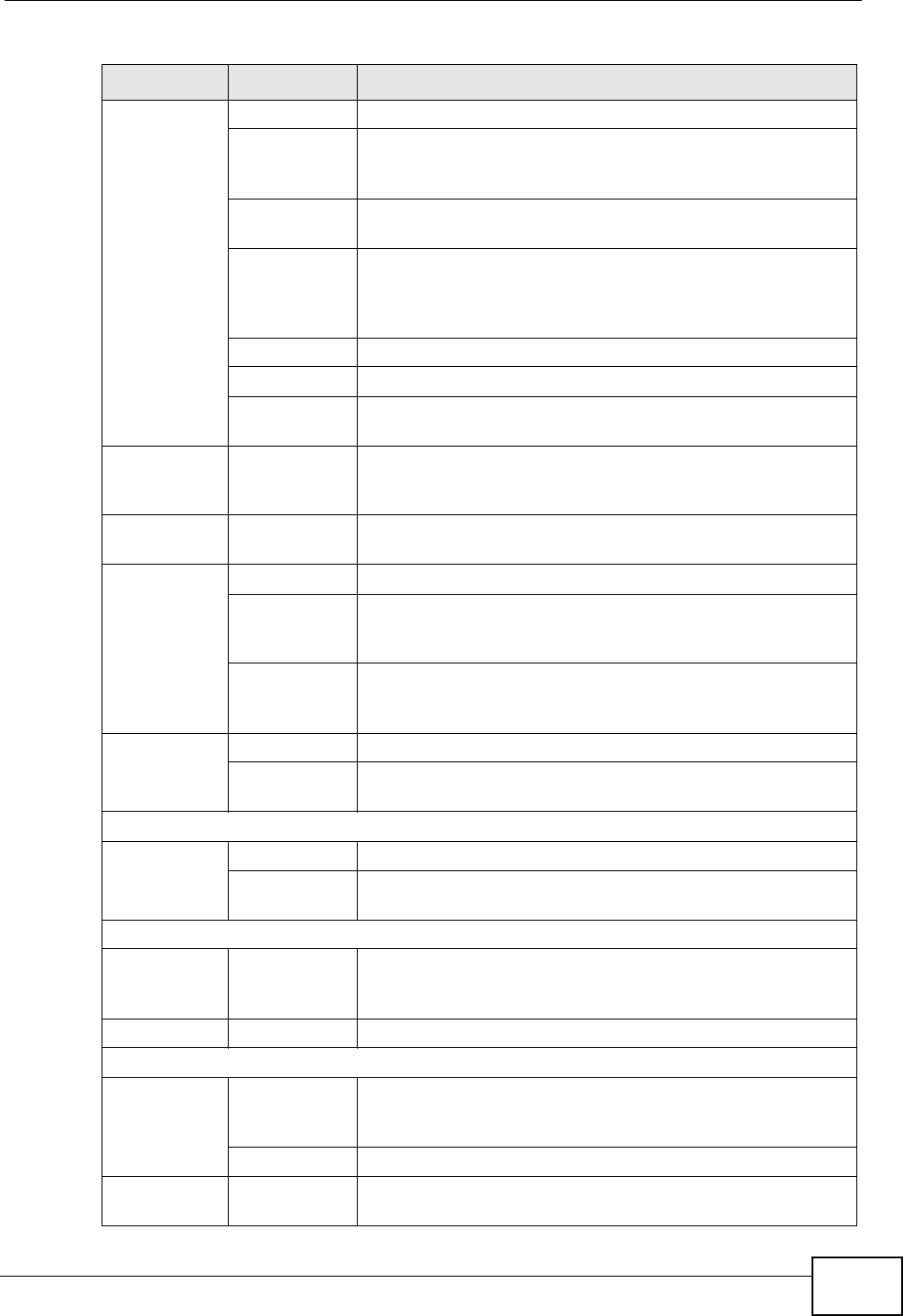
Chapter 3 The Web Configurator
NBG-416N User’s Guide 31
Wireless
LAN General Use this screen to configure wireless LAN.
MAC Filter Use the MAC filter screen to configure the NBG-416N to
block access to devices or block the devices from
accessing the NBG-416N.
Advanced This screen allows you to configure advanced wireless
settings.
QoS Use this screen to configure Wi-Fi Multimedia Quality of
Service (WMM QoS). WMM QoS allows you to prioritize
wireless traffic according to the delivery requirements of
individual services.
WPS Use this screen to configure WPS.
WPS Station Use this screen to add a wireless station using WPS.
Scheduling Use this screen to schedule the times the Wireless LAN is
enabled.
WAN Internet
Connection This screen allows you to configure ISP parameters, WAN
IP address assignment, DNS servers and the WAN MAC
address.
LAN IP Use this screen to configure LAN IP address and subnet
mask.
DHCP
Server General Use this screen to enable the NBG-416N’s DHCP server.
Advanced Use this screen to assign IP addresses to specific
individual computers based on their MAC addresses and to
have DNS servers assigned by the DHCP server.
Client List Use this screen to view current DHCP client information
and to always assign an IP address to a MAC address (and
host name).
NAT General Use this screen to enable NAT.
Application Use this screen to configure servers behind the NBG-
416N.
Security
Firewall General Use this screen to activate/deactivate the firewall.
Services Use this screen to enable or disable ICMP and VPN
passthrough features.
Management
Remote
MGMT WWW Use this screen to configure through which interface(s)
and from which IP address(es) users can use HTTP to
manage the NBG-416N.
UPnP General Use this screen to enable UPnP on the NBG-416N.
Maintenance
System General Use this screen to view and change administrative settings
such as system and domain names, password and
inactivity timer.
Time Setting Use this screen to change your NBG-416N’s time and date.
Logs View Log Use this screen to view the logs for the categories that you
selected.
Table 4 Screens Summary (continued)
LINK TAB FUNCTION
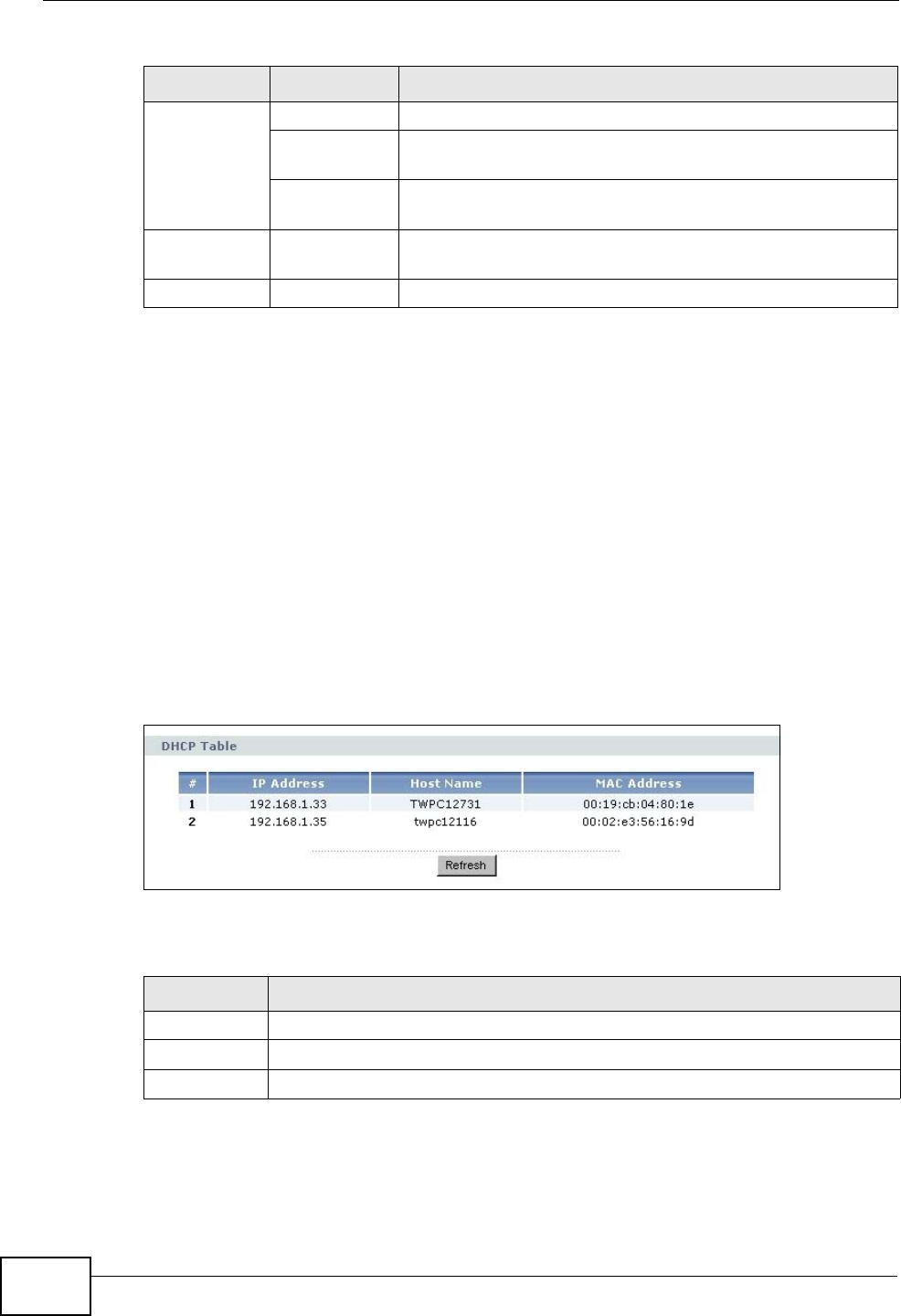
Chapter 3 The Web Configurator
NBG-416N User’s Guide
32
3.5.2 Summary: DHCP Table
DHCP (Dynamic Host Configuration Protocol, RFC 2131 and RFC 2132) allows
individual clients to obtain TCP/IP configuration at start-up from a server. You can
configure the NBG-416N’s LAN as a DHCP server or disable it. When configured as
a server, the NBG-416N provides the TCP/IP configuration for the clients. If DHCP
service is disabled, you must have another DHCP server on that network, or else
the computer must be manually configured.
Click the DHCP Table (Details...) hyperlink in the Status screen. Read-only
information here relates to your DHCP status. The DHCP table shows current
DHCP client information (including IP Address, Host Name and MAC Address)
of all network clients using the NBG-416N’s DHCP server.
Figure 7 Summary: DHCP Table
The following table describes the labels in this screen.
Tools Firmware Use this screen to upload firmware to your NBG-416N.
Configuration Use this screen to backup and restore the configuration or
reset the factory defaults to your NBG-416N.
Restart This screen allows you to reboot the NBG-416N without
turning the power off.
Sys OP
Mode General This screen allows you to select whether your device acts
as a Router or a Access Point.
Language Language This screen allows you to select the language you prefer.
Table 4 Screens Summary (continued)
LINK TAB FUNCTION
Table 5 Summary: DHCP Table
LABEL DESCRIPTION
# This is the index number of the host computer.
IP Address This field displays the IP address relative to the # field listed above.
Host Name This field displays the computer host name.

Chapter 3 The Web Configurator
NBG-416N User’s Guide 33
3.5.3 Summary: Packet Statistics
Click the Packet Statistics (Details...) hyperlink in the Status screen. Read-
only information here includes port status, packet specific statistics and the
"system up time". The Poll Interval(s) field is configurable and is used for
refreshing the screen.
Figure 8 Summary: Packet Statistics
The following table describes the labels in this screen.
MAC Address This field shows the MAC address of the computer with the name in the
Host Name field.
Every Ethernet device has a unique MAC (Media Access Control) address
which uniquely identifies a device. The MAC address is assigned at the
factory and consists of six pairs of hexadecimal characters, for example,
00:A0:C5:00:00:02.
Refresh Click Refresh to renew the screen.
Table 5 Summary: DHCP Table (continued)
LABEL DESCRIPTION
Table 6 Summary: Packet Statistics
LABEL DESCRIPTION
Port This is the NBG-416N’s port type.
Status For the LAN ports, this displays the port speed and duplex setting or
Down when the line is disconnected.
For the WAN port, it displays the port speed and duplex setting if
you’re using Ethernet encapsulation and Idle (line (ppp) idle), Dial
(starting to trigger a call) and Drop (dropping a call) if you're using
PPPoE or PPTP encapsulation. This field displays Down when the line
is disconnected.
For the WLAN, it displays the maximum transmission rate when the
WLAN is enabled and Down when the WLAN is disabled.
TxPkts This is the number of transmitted packets on this port.
RxPkts This is the number of received packets on this port.
Collisions This is the number of collisions on this port.

Chapter 3 The Web Configurator
NBG-416N User’s Guide
34
3.5.4 Summary: WLAN Station Status
Click the WLAN Station Status (Details...) hyperlink in the Status screen. View
the wireless stations that are currently associated to the NBG-416N in the
Association List. Association means that a wireless client (for example, your
network or computer with a wireless network card) has connected successfully to
the AP (or wireless router) using the same SSID, channel and security settings.
Figure 9 Summary: Wireless Association List
The following table describes the labels in this screen.
Tx B/s This displays the transmission speed in bytes per second on this port.
Rx B/s This displays the reception speed in bytes per second on this port.
System Up Time This is the total time the NBG-416N has been on.
Poll Interval(s) Enter the time interval for refreshing statistics in this field.
Set Interval Click this button to apply the new poll interval you entered in the Poll
Interval(s) field.
Stop Click Stop to stop refreshing statistics.
Table 6 Summary: Packet Statistics (continued)
LABEL DESCRIPTION
Table 7 Summary: Wireless Association List
LABEL DESCRIPTION
# This is the index number of an associated wireless station.
MAC Address This field displays the MAC address of an associated wireless station.
Association Time This field displays the time a wireless station first associated with the
NBG-416N’s WLAN network.
Refresh Click Refresh to reload the list.
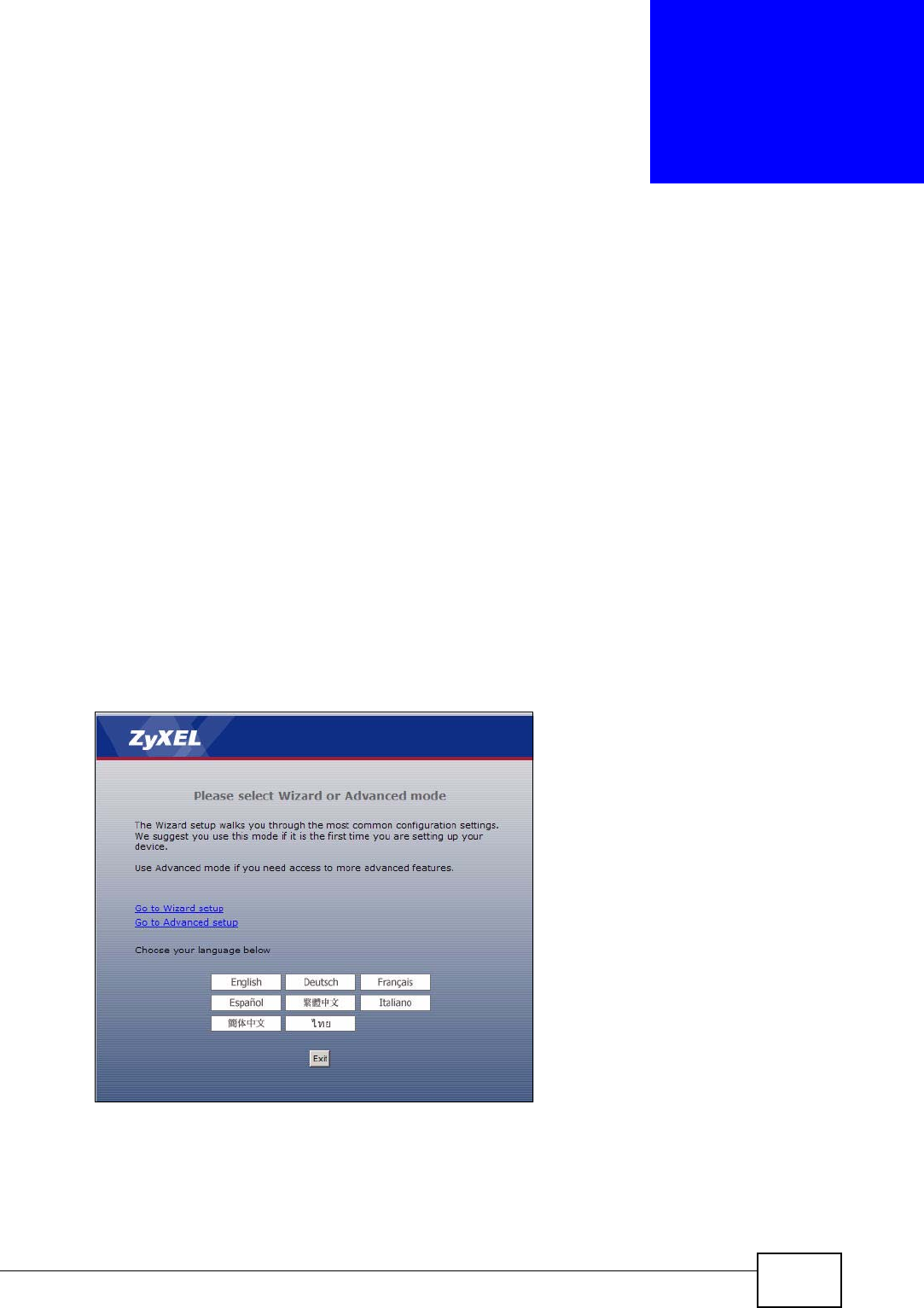
NBG-416N User’s Guide 35
CHAPTER 4
Connection Wizard
4.1 Wizard Setup
This chapter provides information on the wizard setup screens in the Web
Configurator.
The Web Configurator’s wizard setup helps you configure your device to access the
Internet. Refer to your ISP (Internet Service Provider) checklist in the Quick Start
Guide to know what to enter in each field. Leave a field blank if you don’t have
that information.
1After you access the NBG-416N Web Configurator, click Go to Wizard setup.
You can click Go to Advanced setup to skip this wizard setup and configure basic
or advanced features accordingly.
Figure 10 Select Wizard or Advanced Mode
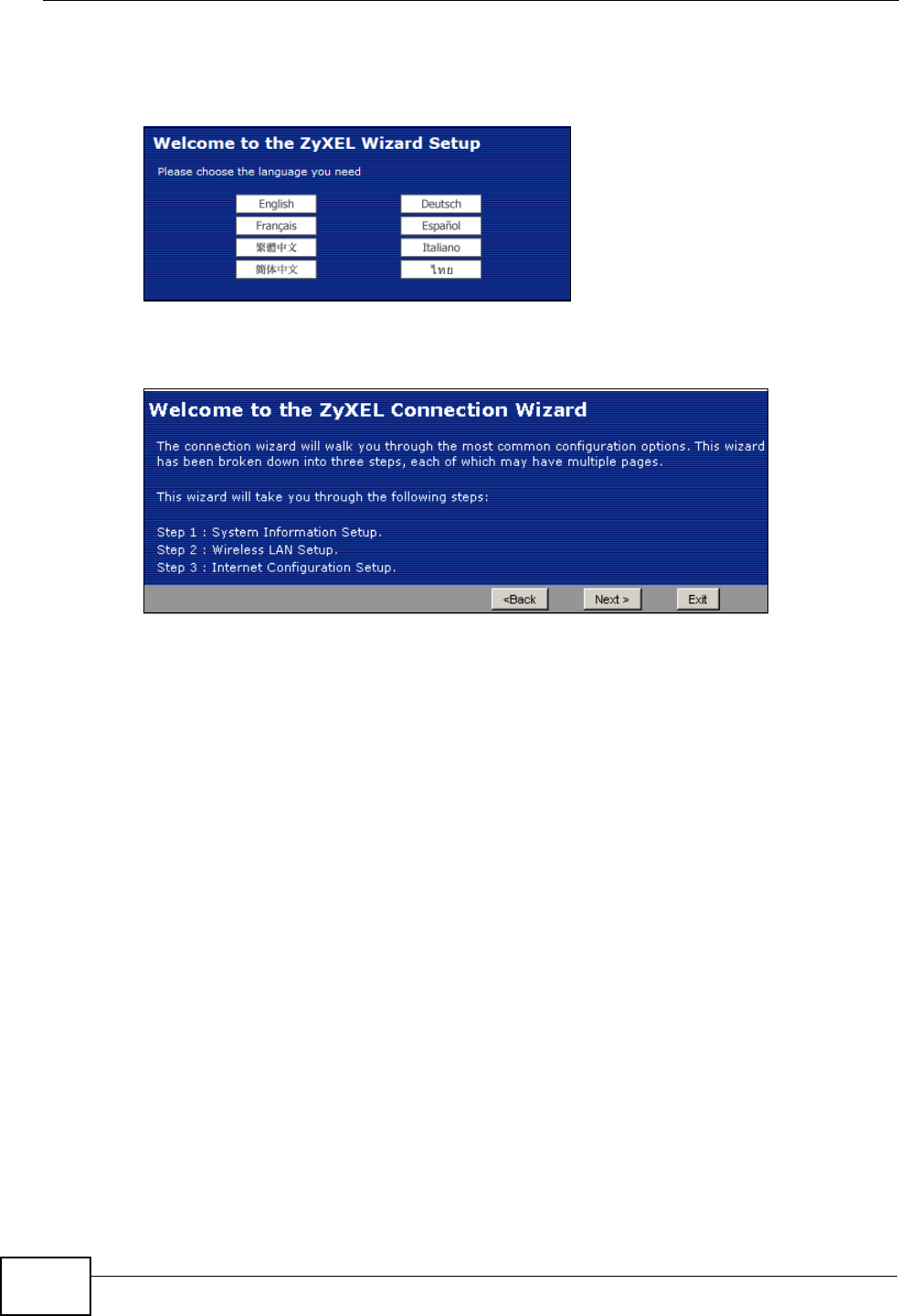
Chapter 4 Connection Wizard
NBG-416N User’s Guide
36
2Choose a language by clicking on the language’s button. The screen will update.
Click the Next button to proceed to the next screen.
Figure 11 Select a Language
3Read the on-screen information and click Next.
Figure 12 Welcome to the Connection Wizard
4.2 Connection Wizard: STEP 1: System
Information
System Information contains administrative and system-related information.
4.2.1 System Name
System Name is for identification purposes. However, because some ISPs check
this name you should enter your computer's "Computer Name".
• In Windows 95/98 click Start > Settings > Control Panel > Network. Click
the Identification tab, note the entry for the Computer Name field and enter it
as the System Name.
• In Windows 2000, click Start > Settings and Control Panel and then double-
click System. Click the Network Identification tab and then the Properties
button. Note the entry for the Computer name field and enter it as the
System Name.
• In Windows XP, click Start > My Computer > View system information and
then click the Computer Name tab. Note the entry in the Full computer
name field and enter it as the NBG-416N System Name.

Chapter 4 Connection Wizard
NBG-416N User’s Guide 37
4.2.2 Domain Name
The Domain Name entry is what is propagated to the DHCP clients on the LAN. If
you leave this blank, the domain name obtained by DHCP from the ISP is used.
While you must enter the host name (System Name) on each individual computer,
the domain name can be assigned from the NBG-416N via DHCP.
Click Next to configure the NBG-416N for Internet access.
Figure 13 Wizard Step 1: System Information
The following table describes the labels in this screen.
Table 8 Wizard Step 1: System Information
LABEL DESCRIPTION
System
Name System Name is a unique name to identify the NBG-416N in an Ethernet
network. Enter a descriptive name. This name can be up to 30
alphanumeric characters long. Spaces are not allowed, but dashes "-" and
underscores "_" are accepted.
Domain
Name Type the domain name (if you know it) here. If you leave this field blank,
the ISP may assign a domain name via DHCP. The domain name entered
by you is given priority over the ISP assigned domain name.
Back Click Back to display the previous screen.
Next Click Next to proceed to the next screen.
Exit Click Exit to close the wizard screen without saving.

Chapter 4 Connection Wizard
NBG-416N User’s Guide
38
4.3 Connection Wizard: STEP 2: Wireless LAN
Set up your wireless LAN using the following screen.
Figure 14 Wizard Step 2: Wireless LAN
The following table describes the labels in this screen.
Table 9 Wizard Step 2: Wireless LAN
LABEL DESCRIPTION
Name
(SSID) Enter a descriptive name (up to 32 printable 7-bit ASCII characters) for the
wireless LAN.
If you change this field on the NBG-416N, make sure all wireless stations
use the same SSID in order to access the network.
Security Select a Security level from the drop-down list box.
Choose Auto (WPA2-PSK) to have the NBG-416N generate a pre-shared
key automatically. After you click Next a screen pops up displaying the
generated pre-shared key. Write down the key for use later when
connecting other wireless devices to your network. Click OK to continue.
Choose None to have no wireless LAN security configured. If you do not
enable any wireless security on your NBG-416N, your network is accessible
to any wireless networking device that is within range. If you choose this
option, skip directly to Section 4.4 on page 39.
Choose Extend (WPA-PSK or WPA2-PSK) security to configure a Pre-
Shared Key. Choose this option only if your wireless clients support WPA-
PSK or WPA2-PSK respectively. If you choose this option, skip directly to
Section 4.3.1 on page 39.
Channel
Selection The range of radio frequencies used by IEEE 802.11b/g/n wireless devices
is called a channel. The device will automatically select the channel with
the least interference.
Back Click Back to display the previous screen.
Next Click Next to proceed to the next screen.
Exit Click Exit to close the wizard screen without saving.
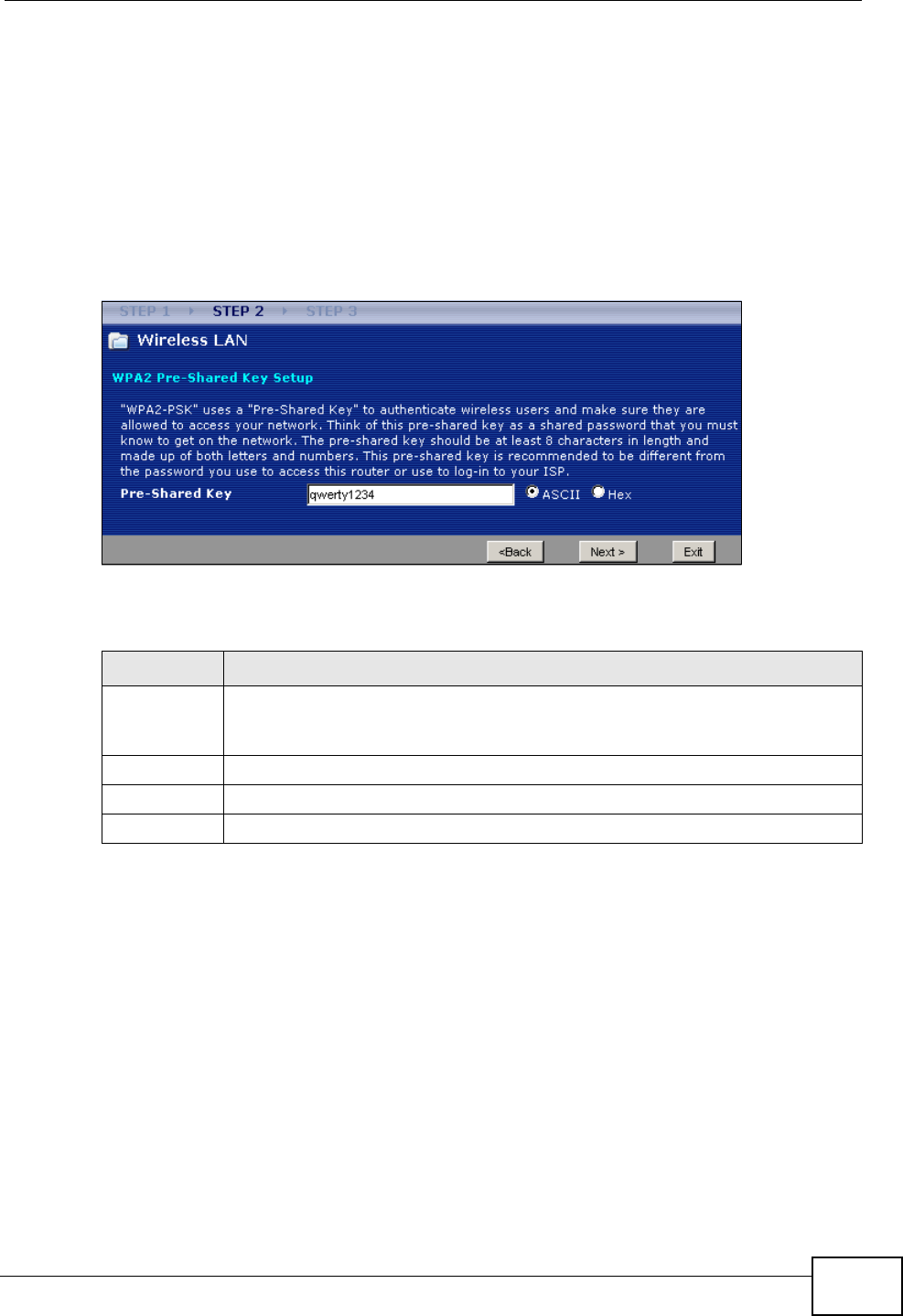
Chapter 4 Connection Wizard
NBG-416N User’s Guide 39
Note: The wireless stations and NBG-416N must use the same SSID, channel ID,
WPA-PSK (if WPA-PSK is enabled) or WPA2-PSK (if WPA2-PSK is enabled) for
wireless communication.
4.3.1 Extend (WPA-PSK or WPA2-PSK) Security
Choose Extend (WPA-PSK) or Extend (WPA2-PSK) security in the Wireless
LAN setup screen to set up a Pre-Shared Key.
Figure 15 Wizard Step 2: Extend (WPA-PSK or WPA2-PSK) Security
The following table describes the labels in this screen.
4.4 Connection Wizard: STEP 3: Internet
Configuration
The NBG-416N offers three Internet connection types. They are Ethernet, PPP
over Ethernet or PPTP. The wizard attempts to detect which WAN connection
type you are using. If the wizard does not detect a connection type, you must
select one from the drop-down list box. Check with your ISP to make sure you use
the correct type.
Table 10 Wizard Step 2: Extend (WPA-PSK or WPA2-PSK) Security
LABEL DESCRIPTION
Pre-Shared
Key Type from 8 to 63 case-sensitive ASCII or HEX characters. You can set up
the most secure wireless connection by configuring WPA in the wireless
LAN screens. You need to configure an authentication server to do this.
Back Click Back to display the previous screen.
Next Click Next to proceed to the next screen.
Exit Click Exit to close the wizard screen without saving.

Chapter 4 Connection Wizard
NBG-416N User’s Guide
40
This wizard screen varies according to the connection type that you select.
Figure 16 Wizard Step 3: ISP Parameters.
The following table describes the labels in this screen,
4.4.1 Ethernet Connection
Choose Ethernet when the WAN port is used as a regular Ethernet. Continue to
Section 4.4.4 on page 43.
Figure 17 Wizard Step 3: Ethernet Connection
4.4.2 PPPoE Connection
Point-to-Point Protocol over Ethernet (PPPoE) functions as a dial-up connection.
PPPoE is an IETF (Internet Engineering Task Force) standard specifying how a host
Table 11 Wizard Step 3: ISP Parameters
CONNECTION
TYPE DESCRIPTION
Ethernet Select the Ethernet option when the WAN port is used as a regular
Ethernet.
PPPoE Select the PPP over Ethernet option for a dial-up connection. If
your ISP gave you an IP address and/or subnet mask, then select
PPTP.
PPTP Select the PPTP option for a dial-up connection.

Chapter 4 Connection Wizard
NBG-416N User’s Guide 41
personal computer interacts with a broadband modem (for example DSL, cable,
wireless, etc.) to achieve access to high-speed data networks.
For the service provider, PPPoE offers an access and authentication method that
works with existing access control systems (for instance, RADIUS).
One of the benefits of PPPoE is the ability to let end users access one of multiple
network services, a function known as dynamic service selection. This enables the
service provider to easily create and offer new IP services for specific users.
Operationally, PPPoE saves significant effort for both the subscriber and the ISP/
carrier, as it requires no specific configuration of the broadband modem at the
subscriber’s site.
By implementing PPPoE directly on the NBG-416N (rather than individual
computers), the computers on the LAN do not need PPPoE software installed,
since the NBG-416N does that part of the task. Furthermore, with NAT, all of the
LAN's computers will have Internet access.
Figure 18 Wizard Step 3: PPPoE Connection
The following table describes the labels in this screen.
Table 12 Wizard Step 3: PPPoE Connection
LABEL DESCRIPTION
ISP Parameter for Internet Access
Connection
Type Select the PPP over Ethernet option for a dial-up connection.
Service Name Type the name of your service provider.
User Name Type the user name given to you by your ISP.
Password Type the password associated with the user name above.
Back Click Back to return to the previous screen.
Next Click Next to continue.
Exit Click Exit to close the wizard screen without saving.

Chapter 4 Connection Wizard
NBG-416N User’s Guide
42
4.4.3 PPTP Connection
Point-to-Point Tunneling Protocol (PPTP) is a network protocol that enables
transfers of data from a remote client to a private server, creating a Virtual Private
Network (VPN) using TCP/IP-based networks.
PPTP supports on-demand, multi-protocol, and virtual private networking over
public networks, such as the Internet.
Refer to the appendix for more information on PPTP.
Note: The NBG-416N supports one PPTP server connection at any given time.
Figure 19 Wizard Step 3: PPTP Connection
The following table describes the fields in this screen
Table 13 Wizard Step 3: PPTP Connection
LABEL DESCRIPTION
ISP Parameters for Internet Access
Connection Type Select PPTP from the drop-down list box. To configure a PPTP client,
you must configure the User Name and Password fields for a PPP
connection and the PPTP parameters for a PPTP connection.
User Name Type the user name given to you by your ISP.
Password Type the password associated with the User Name above.
PPTP Configuration
Server IP
Address Type the IP address of the PPTP server.

Chapter 4 Connection Wizard
NBG-416N User’s Guide 43
4.4.4 Your IP Address
The following wizard screen allows you to assign a fixed IP address or give the
NBG-416N an automatically assigned IP address depending on your ISP.
Figure 20 Wizard Step 3: Your IP Address
The following table describes the labels in this screen
Connection ID/
Name Enter the connection ID or connection name in this field. It must follow
the "c:id" and "n:name" format. For example, C:12 or N:My ISP.
This field is optional and depends on the requirements of your ISP.
Get
automatically
from ISP
Select this radio button if your ISP did not assign you a fixed IP
address.
Use fixed IP
address Select this radio button, provided by your ISP to give the NBG-416N a
fixed, unique IP address.
My IP
Address Type the (static) IP address assigned to you by your ISP.
My IP Subnet
Mask Type the subnet mask assigned to you by your ISP (if given).
Back Click Back to return to the previous screen.
Next Click Next to continue.
Exit Click Exit to close the wizard screen without saving.
Table 13 Wizard Step 3: PPTP Connection (continued)
LABEL DESCRIPTION
Table 14 Wizard Step 3: Your IP Address
LABEL DESCRIPTION
Get automatically from
your ISP Select this option If your ISP did not assign you a fixed IP
address. This is the default selection. If you choose this option,
skip directly to Section 4.4.9 on page 47.
Use fixed IP address
provided by your ISP Select this option if you were given IP address and/or DNS server
settings by the ISP. The fixed IP address should be in the same
subnet as your broadband modem or router.
Back Click Back to return to the previous screen.
Next Click Next to continue.
Exit Click Exit to close the wizard screen without saving.

Chapter 4 Connection Wizard
NBG-416N User’s Guide
44
4.4.5 WAN IP Address Assignment
Every computer on the Internet must have a unique IP address. If your networks
are isolated from the Internet, for instance, only between your two branch offices,
you can assign any IP addresses to the hosts without problems. However, the
Internet Assigned Numbers Authority (IANA) has reserved the following three
blocks of IP addresses specifically for private networks.
You can obtain your IP address from the IANA, from an ISP or have it assigned by
a private network. If you belong to a small organization and your Internet access
is through an ISP, the ISP can provide you with the Internet addresses for your
local networks. On the other hand, if you are part of a much larger organization,
you should consult your network administrator for the appropriate IP addresses.
Note: Regardless of your particular situation, do not create an arbitrary IP address;
always follow the guidelines above. For more information on address
assignment, please refer to RFC 1597, Address Allocation for Private Internets
and RFC 1466, Guidelines for Management of IP Address Space.
4.4.6 IP Address and Subnet Mask
Similar to the way houses on a street share a common street name, so too do
computers on a LAN share one common network number.
Where you obtain your network number depends on your particular situation. If
the ISP or your network administrator assigns you a block of registered IP
addresses, follow their instructions in selecting the IP addresses and the subnet
mask.
If the ISP did not explicitly give you an IP network number, then most likely you
have a single user account and the ISP will assign you a dynamic IP address when
the connection is established. The Internet Assigned Number Authority (IANA)
reserved this block of addresses specifically for private use; please do not use any
other number unless you are told otherwise. Let's say you select 192.168.1.0 as
the network number; which covers 254 individual addresses, from 192.168.1.1 to
192.168.1.254 (zero and 255 are reserved). In other words, the first three
numbers specify the network number while the last number identifies an individual
computer on that network.
Table 15 Private IP Address Ranges
10.0.0.0 -10.255.255.255
172.16.0.0 -172.31.255.255
192.168.0.0 -192.168.255.255

Chapter 4 Connection Wizard
NBG-416N User’s Guide 45
Once you have decided on the network number, pick an IP address that is easy to
remember, for instance, 192.168.1.1, for your NBG-416N, but make sure that no
other device on your network is using that IP address.
The subnet mask specifies the network number portion of an IP address. Your
NBG-416N will compute the subnet mask automatically based on the IP address
that you entered. You don't need to change the subnet mask computed by the
NBG-416N unless you are instructed to do otherwise.
4.4.7 DNS Server Address Assignment
Use DNS (Domain Name System) to map a domain name to its corresponding IP
address and vice versa, for instance, the IP address of www.zyxel.com is
204.217.0.2. The DNS server is extremely important because without it, you must
know the IP address of a computer before you can access it.
The NBG-416N can get the DNS server addresses in the following ways.
1The ISP tells you the DNS server addresses, usually in the form of an information
sheet, when you sign up. If your ISP gives you DNS server addresses, enter them
in the DNS Server fields in the Wizard and/or WAN > Internet Connection
screen.
2If the ISP did not give you DNS server information, leave the DNS Server fields
set to 0.0.0.0 in the Wizard screen and/or set to From ISP in the WAN >
Internet Connection screen for the ISP to dynamically assign the DNS server IP
addresses.

Chapter 4 Connection Wizard
NBG-416N User’s Guide
46
4.4.8 WAN IP and DNS Server Address Assignment
The following wizard screen allows you to assign a fixed WAN IP address and DNS
server addresses.
Figure 21 Wizard Step 3: WAN IP and DNS Server Addresses
The following table describes the labels in this screen
Table 16 Wizard Step 3: WAN IP and DNS Server Addresses
LABEL DESCRIPTION
WAN IP Address Assignment
My WAN IP Address Enter your WAN IP address in this field. The WAN IP address
should be in the same subnet as your DSL/Cable modem or
router.
My WAN IP Subnet
Mask Enter the IP subnet mask in this field.
Gateway IP Address Enter the gateway IP address in this field.
System DNS Server Address Assignment (if applicable)
DNS (Domain Name System) is for mapping a domain name to its corresponding IP
address and vice versa. The DNS server is extremely important because without it, you
must know the IP address of a computer before you can access it. The NBG-416N uses a
system DNS server (in the order you specify here) to resolve domain names for DDNS and
the time server.
First DNS Server
Second DNS Server
Enter the DNS server's IP address in the fields provided.
If you do not configure a system DNS server, you must use IP
addresses when configuring DDNS and the time server.
Back Click Back to return to the previous screen.
Next Click Next to continue.
Exit Click Exit to close the wizard screen without saving.

Chapter 4 Connection Wizard
NBG-416N User’s Guide 47
4.4.9 WAN MAC Address
Every Ethernet device has a unique MAC (Media Access Control) address. The MAC
address is assigned at the factory and consists of six pairs of hexadecimal
characters, for example, 00:A0:C5:00:00:02.
This screen allows users to configure the WAN port's MAC address by either using
the NBG-416N’s MAC address, copying the MAC address from a computer on your
LAN or manually entering a MAC address. Once it is successfully configured, the
address will be copied to configuration file. It is advisable to clone the MAC
address from a computer on your LAN even if your ISP does not presently require
MAC address authentication.
Figure 22 Wizard Step 3: WAN MAC Address
The following table describes the fields in this screen.
Table 17 Example of Network Properties for LAN Servers with Fixed IP Addresses
Choose an IP address 192.168.1.2-192.168.1.32; 192.168.1.65-192.168.1.254.
Subnet mask 255.255.255.0
Gateway (or default route) 192.168.1.1(NBG-416N LAN IP)
Table 18 Wizard Step 3: WAN MAC Address
LABEL DESCRIPTION
Factory Default Select Factory Default to use the factory assigned default MAC
address.
Clone the
computer’s MAC
address
Select this option and enter the IP address of the computer on the
LAN whose MAC you are cloning. It is advisable to clone the MAC
address from a computer on your LAN even if your ISP does not
presently require MAC address authentication.
Set WAN MAC
Address Select this option and enter the MAC address you want to use.
Back Click Back to return to the previous screen.
Next Click Next to continue.
Exit Click Exit to close the wizard screen without saving.
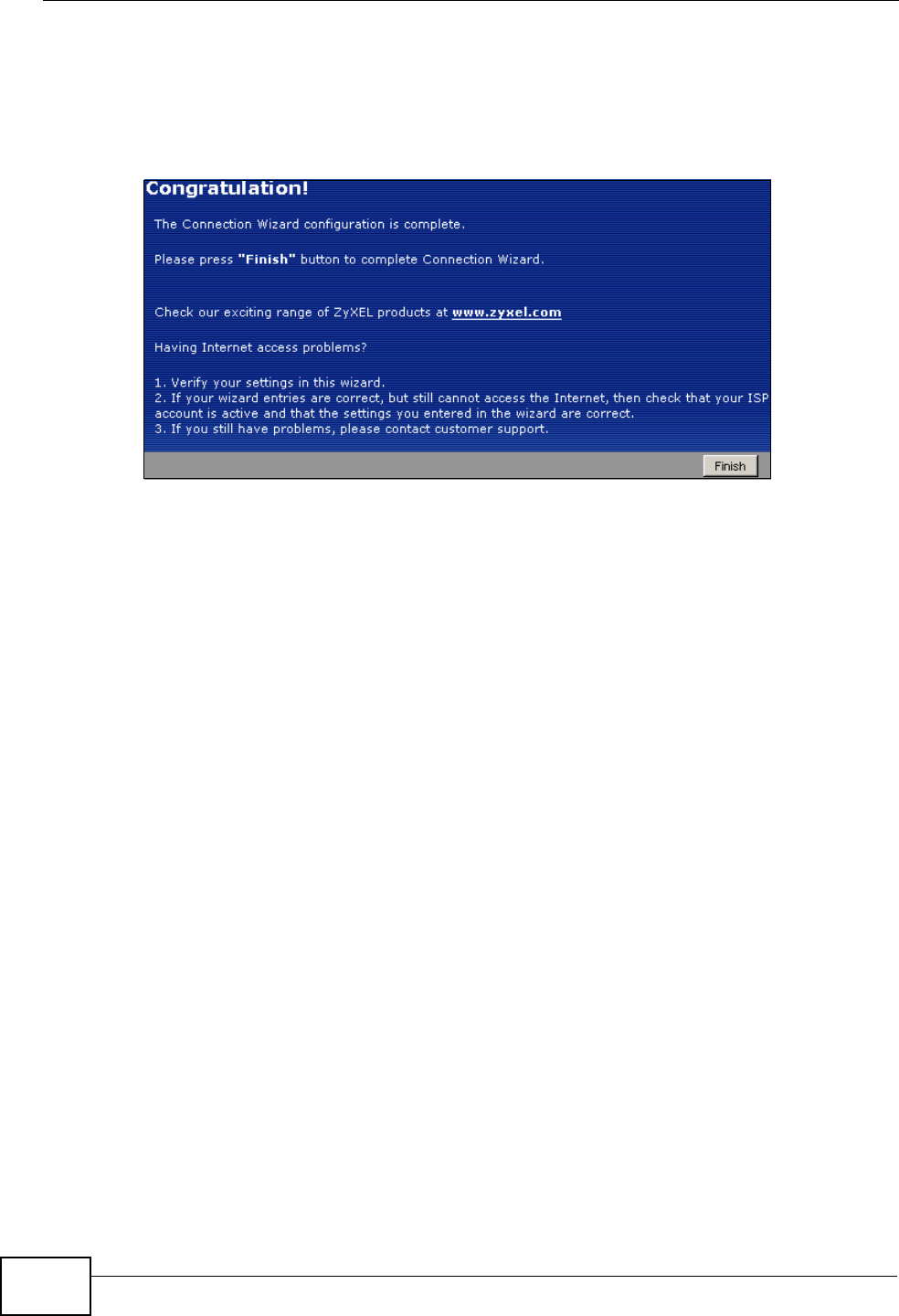
Chapter 4 Connection Wizard
NBG-416N User’s Guide
48
4.5 Connection Wizard Complete
Click Finish to complete the wizard setup.
Figure 23 Connection Wizard Complete
Well done! You have successfully set up your NBG-416N to operate on your
network and access the Internet.

NBG-416N User’s Guide 49
CHAPTER 5
AP Mode
5.1 Overview
This chapter discusses how to configure settings while your NBG-416N is set to AP
Mode. Many screens that are available in Router Mode are not available in AP
Mode.
Note: See Chapter 6 on page 57 for an example of setting up a wireless network in
AP mode.
Use your NBG-416N as an AP if you already have a router or gateway on your
network. In this mode your device bridges a wired network (LAN) and wireless
LAN (WLAN) in the same subnet. See the figure below for an example.
Figure 24 Wireless Internet Access in AP Mode
5.2 Setting your NBG-416N to AP Mode
1Log into the Web Configurator if you haven’t already. See the Quick start Guide for
instructions on how to do this.
LEW
WLAN
LAN

Chapter 5 AP Mode
NBG-416N User’s Guide
50
2To set your NBG-416N to AP Mode, go to Maintenance > Sys OP Mode >
General and select Access Point.
Figure 25 Maintenance > Sys OP Mode > General
3A pop-up appears providing information on this mode. Click OK in the pop-up
message window. (See Section 18.3 on page 140 for more information on the
pop-up.) Click Apply. Your NBG-416N is now in AP Mode.
Note: You have to log in to the Web Configurator again when you change modes.
5.3 Status Screen (AP Mode)
Click on Status. The screen below shows the status screen in AP Mode.
Figure 26 Status Screen (AP Mode)
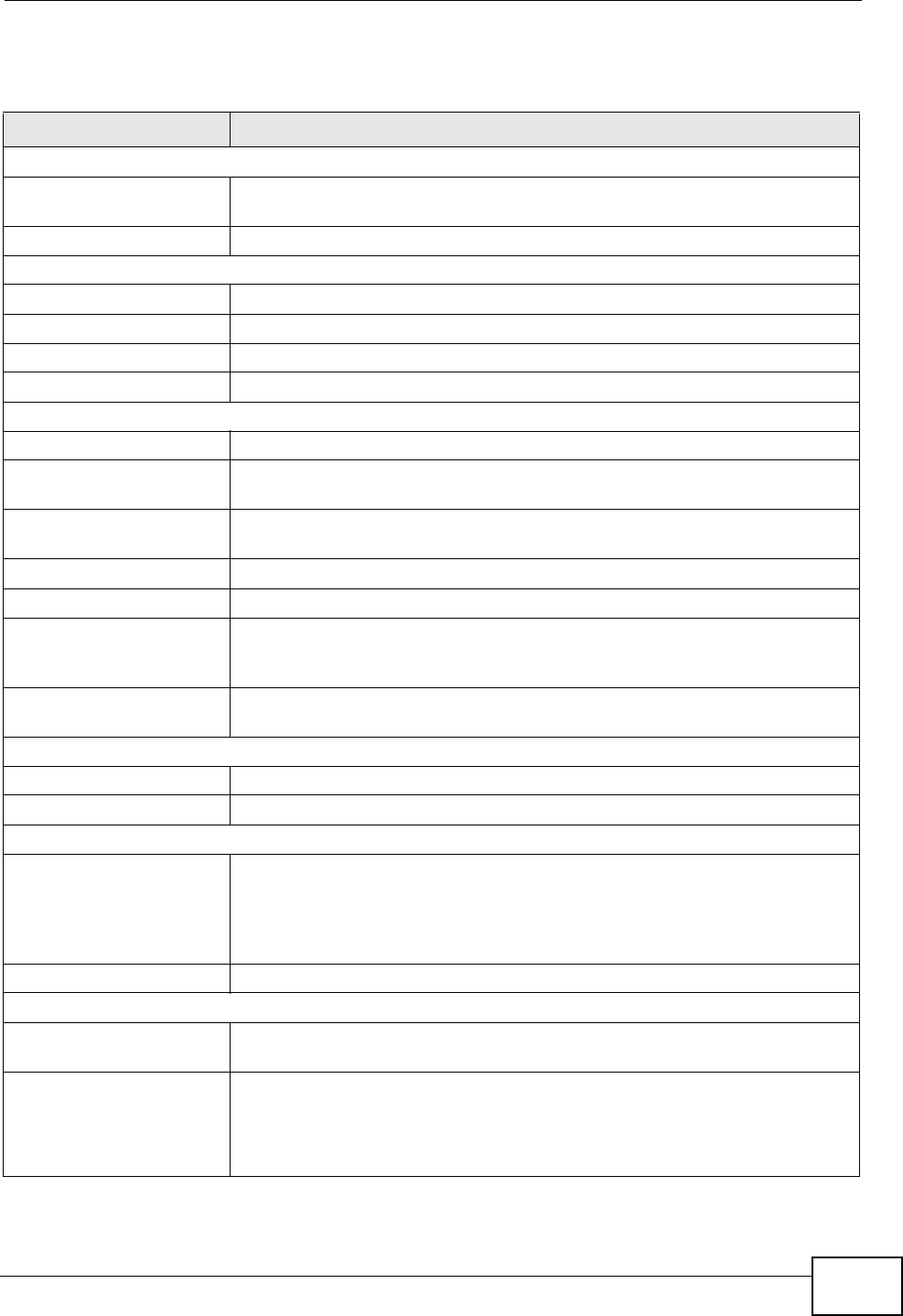
Chapter 5 AP Mode
NBG-416N User’s Guide 51
The following table describes the labels shown in the Status screen.
Table 19 Status Screen (AP Mode)
LABEL DESCRIPTION
Device Information
System Name This is the System Name you enter in the Maintenance > System >
General screen. It is for identification purposes.
Firmware Version This is the current firmware version of the NBG-416N.
LAN Information
- MAC Address This shows the LAN Ethernet adapter MAC Address of your device.
- IP Address This shows the LAN port’s IP address.
- IP Subnet Mask This shows the LAN port’s subnet mask.
- DHCP This shows the LAN port’s DHCP role - None.
WLAN Information
- MAC Address This shows the wireless adapter MAC Address of your device.
- Status This shows the current status of the Wireless LAN - On, Off, or Off by
scheduler.
- Name (SSID) This shows a descriptive name used to identify the NBG-416N in the
wireless LAN.
- Channel This shows the channel number which you select manually.
- Security Mode This shows the level of wireless security the NBG-416N is using.
- 802.11 Mode This shows the IEEE 802.11 standard that the NBG-416N supports.
Wireless clients must support the same standard in order to be able to
connect to the NBG-416N
- WPS This shows the WPS (WiFi Protected Setup) Status. Click the status to
display Network > Wireless LAN > WPS screen.
System Status
System Up Time This is the total time the NBG-416N has been on.
Current Date/Time This field displays your NBG-416N’s present date and time.
System Resource
- CPU Usage This displays what percentage of the NBG-416N’s processing ability is
currently used. When this percentage is close to 100%, the NBG-416N is
running at full load, and the throughput is not going to improve anymore.
If you want some applications to have more throughput, you should turn
off other applications.
- Memory Usage This shows what percentage of the heap memory the NBG-416N is using.
Interface Status
Interface This displays the NBG-416N port types. The port types are: LAN and
WLAN.
Status For the LAN port, this field displays Down (line is down) or Up (line is up
or connected).
For the WLAN, it displays Up when the WLAN is enabled or Down when
the WLAN is disabled.

Chapter 5 AP Mode
NBG-416N User’s Guide
52
5.3.1 Navigation Panel
Use the menu in the navigation panel to configure NBG-416N features in AP
Mode.
The following screen and table show the features you can configure in AP Mode.
Figure 27 Menu: AP Mode
The following table describes the sub-menus.
Rate For the LAN ports, this displays the port speed and duplex setting or N/A
when the line is disconnected.
For the WLAN, it displays the maximum transmission rate when the WLAN
is enabled and N/A when the WLAN is disabled.
Summary
Packet Statistics Use this screen to view port status and packet specific statistics.
WLAN Station Status Use this screen to view the wireless stations that are currently associated
to the NBG-416N.
Table 19 Status Screen (AP Mode) (continued)
LABEL DESCRIPTION
Table 20 Menu: AP Mode
LINK TAB FUNCTION
Status This screen shows the NBG-416N’s general device,
system and interface status information. Use this screen
to access the wizard, and summary statistics tables.
Network
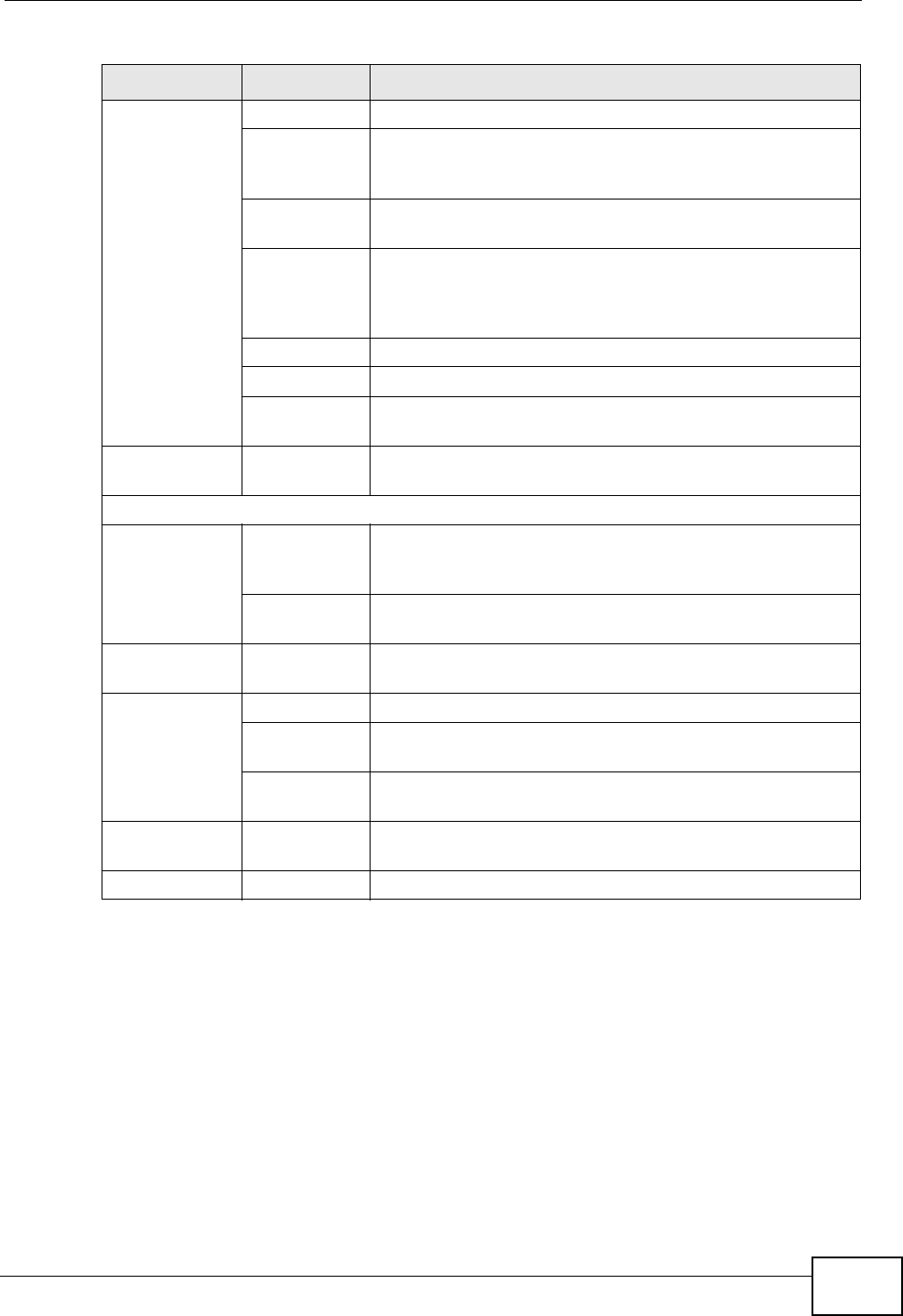
Chapter 5 AP Mode
NBG-416N User’s Guide 53
5.4 Configuring Your Settings
Use this section to configure your NBG-416N settings while in AP Mode.
5.4.1 LAN Settings
Click Network > LAN to see the screen below.
Wireless
LAN General Use this screen to configure wireless LAN.
MAC Filter Use the MAC filter screen to configure the NBG-416N to
block access to devices or block the devices from
accessing the NBG-416N.
Advanced This screen allows you to configure advanced wireless
settings.
QoS Use this screen to configure Wi-Fi Multimedia Quality of
Service (WMM QoS). WMM QoS allows you to prioritize
wireless traffic according to the delivery requirements of
individual services.
WPS Use this screen to configure WPS.
WPS Station Use this screen to add a wireless station using WPS.
Scheduling Use this screen to schedule the times the Wireless LAN is
enabled.
LAN IP Use this screen to configure LAN IP address and subnet
mask.
Maintenance
System General Use this screen to view and change administrative
settings such as system and domain names, password
and inactivity timer.
Time Setting Use this screen to change your NBG-416N’s time and
date.
Logs View Log Use this screen to view the logs for the categories that
you selected.
Tools Firmware Use this screen to upload firmware to your NBG-416N.
Configuration Use this screen to backup and restore the configuration
or reset the factory defaults to your NBG-416N.
Restart This screen allows you to reboot the NBG-416N without
turning the power off.
Sys OP
Mode General This screen allows you to select whether your device acts
as a Router or a Access Point.
Language Language This screen allows you to select the language you prefer.
Table 20 Menu: AP Mode (continued)
LINK TAB FUNCTION

Chapter 5 AP Mode
NBG-416N User’s Guide
54
Note: If you change the IP address of the NBG-416N in the screen below, you will
need to log into the NBG-416N again using the new IP address.
Figure 28 Network > LAN > IP
The table below describes the labels in the screen.
5.4.2 WLAN and Maintenance Settings
The configuration of wireless and maintenance settings in AP Mode is the same as
for Router Mode.
• See Chapter 5 on page 69 for information on the configuring your wireless
network.
• See Troubleshooting (145) for information on configuring your maintenance
settings.
5.5 Logging in to the Web Configurator in AP
Mode
1Connect your computer to the LAN port of the NBG-416N.
Table 21 Network > LAN > IP
LABEL DESCRIPTION
Get from DHCP
Server Select this to let the DHCP server in the gateway assign the NBG-
416N IP address.
User Defined LAN IP Select this to give the NBG-416N a static IP address.
IP Address Type the IP address in dotted decimal notation. The default
setting is 192.168.1.2. If you change the IP address you will have
to log in again with the new IP address.
IP Subnet Mask The subnet mask specifies the network number portion of an IP
address. Your NBG-416N will automatically calculate the subnet
mask based on the IP address that you assign. Unless you are
implementing subnetting, use the subnet mask computed by the
NBG-416N.
Apply Click Apply to save your changes to the NBG-416N.
Reset Click Reset to reload the previous configuration for this screen.

Chapter 5 AP Mode
NBG-416N User’s Guide 55
2The default IP address of the NBG-416N is “192.168.1.2”. In this case, your
computer must have an IP address in the range between “192.168.1.3” and
“192.168.1.254”.
3Click Start > Run on your computer in Windows.
4Type “cmd” in the dialog box.
5Type “ipconfig” to show your computer’s IP address. If your computer’s IP address
is not in the correct range then see Appendix C on page 175 for information on
changing your computer’s IP address.
6After you’ve set your computer’s IP address, open a web browser such as Internet
Explorer and type “192.168.1.2” as the web address in your web browser.
See Chapter 6 on page 57 for a tutorial on setting up a network with an AP.

Chapter 5 AP Mode
NBG-416N User’s Guide
56
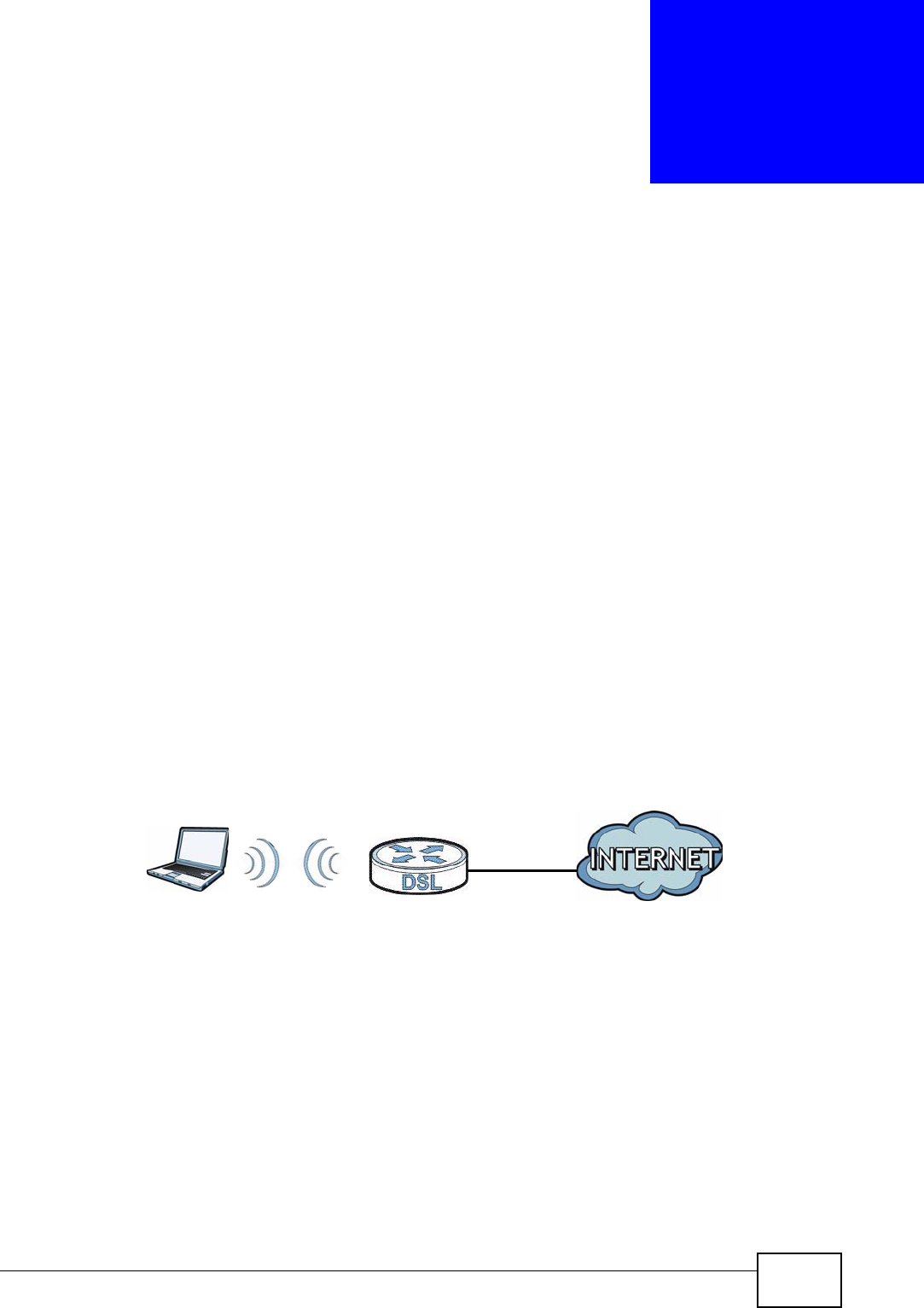
NBG-416N User’s Guide 57
CHAPTER 6
Tutorials
6.1 Overview
This chapter provides tutorials for your NBG-416N as follows:
•How to Connect to the Internet from an AP
•Configure Wireless Security Using WPS on both your NBG-416N and Wireless
Client
•Enable and Configure Wireless Security without WPS on your NBG-416N
6.2 How to Connect to the Internet from an AP
This section gives you an example of how to set up an access point (AP) and
wireless client (a notebook, B in this example) for wireless communication. B can
access the Internet through the AP wirelessly.
Figure 29 Wireless AP Connection to the Internet
6.2.1 Configure Wireless Security Using WPS on both your
NBG-416N and Wireless Client
This section gives you an example of how to set up wireless network using WPS.
This example uses the NBG-416N as the AP and NWD210N as the wireless client
which connects to a notebook.
Note: The wireless client must be a WPS-aware device (for example, a WPS USB
adapter or PCI card).
A
B

Chapter 6 Tutorials
NBG-416N User’s Guide
58
There are two WPS methods for creating a secure connection. This tutorial shows
you how to do both.
•Push Button Configuration (PBC) - create a secure wireless network simply
by pressing a button. See Section 6.2.1.1 on page 58.This is the easier method.
•PIN Configuration - create a secure wireless network simply by entering a
wireless client's PIN (Personal Identification Number) in the NBG-416N’s
interface. See Section 6.2.1.2 on page 59. This is the more secure method,
since one device can authenticate the other.
6.2.1.1 Push Button Configuration (PBC)
1Make sure that your NBG-416N is turned on and that it is within range of your
computer.
2Make sure that you have installed the wireless client (this example uses the
NWD210N) driver and utility in your notebook.
3In the wireless client utility, find the WPS settings. Enable WPS and press the WPS
button (Start or WPS button)
4Log into NBG-416N’s Web Configurator and press Push Button in the Network >
Wireless Client > WPS Station screen.
Note: Your NBG-416N has a WPS button located on its panel, as well as a WPS
button in its configuration utility. Both buttons have exactly the same function;
you can use one or the other.
Note: It doesn’t matter which button is pressed first. You must press the second
button within two minutes of pressing the first one.
The NBG-416N sends the proper configuration settings to the wireless client. This
may take up to two minutes. Then the wireless client is able to communicate with
the NBG-416N securely.
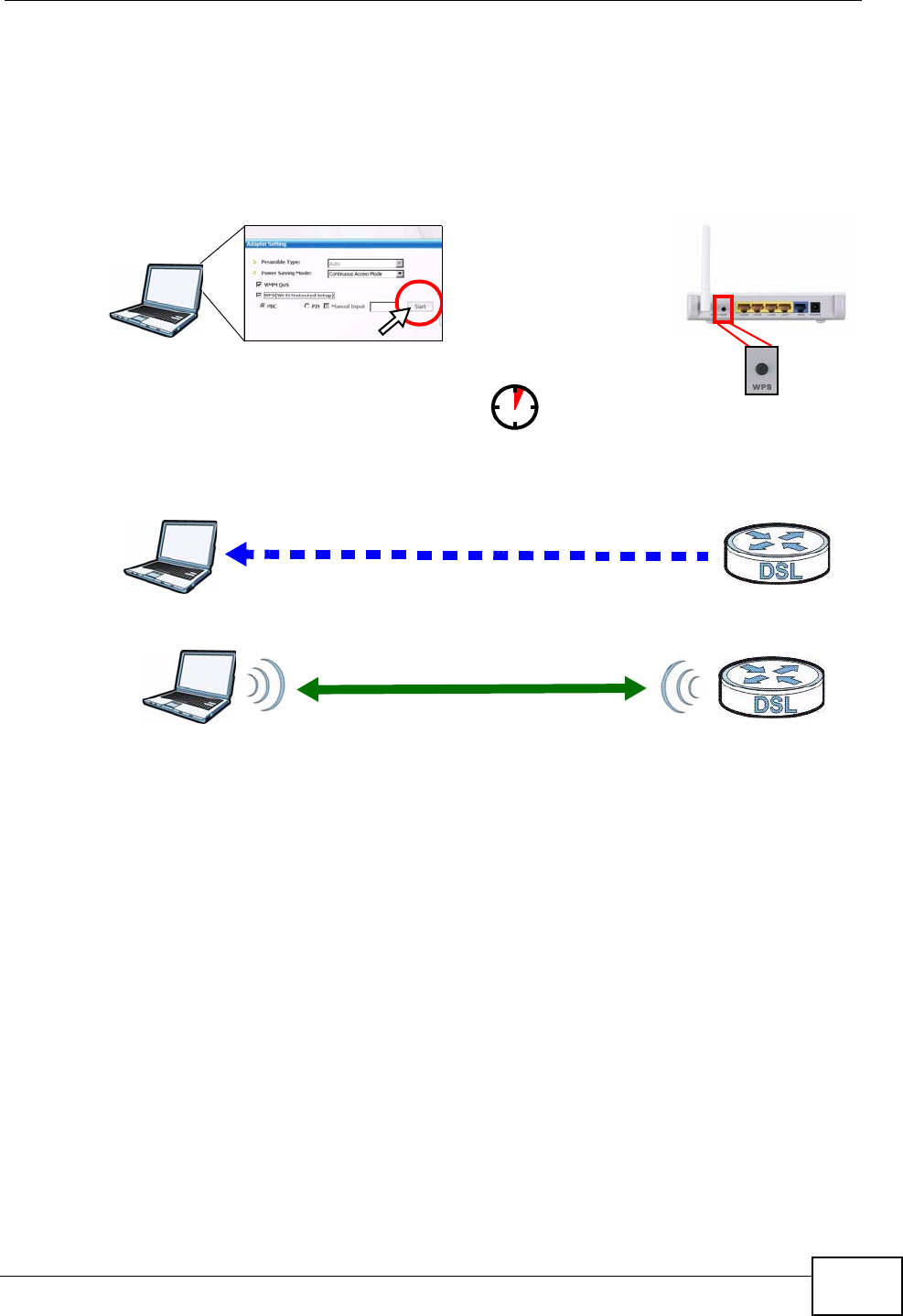
Chapter 6 Tutorials
NBG-416N User’s Guide 59
The following figure shows you an example to set up wireless network and security
by pressing a button on both NBG-416N and wireless client (the NWD210N in this
example).
Figure 30 Example WPS Process: PBC Method
6.2.1.2 PIN Configuration
When you use the PIN configuration method, you need to use both NBG-416N’s
configuration interface and the client’s utilities.
1Launch your wireless client’s configuration utility. Go to the WPS settings and
select the PIN method to get a PIN number.
2Enter the PIN number to the PIN field in the Network > Wireless LAN > WPS
Station screen on the NBG-416N.
3Click the Start buttons (or button next to the PIN field) on both the wireless client
utility screen and the NBG-416N’s WPS Station screen within two minutes.
The NBG-416N authenticates the wireless client and sends the proper
configuration settings to the wireless client. This may take up to two minutes.
Then the wireless client is able to communicate with the NBG-416N securely.
Wireless Client NBG-416N
SECURITY INFO
COMMUNICATION
WITHIN 2 MINUTES
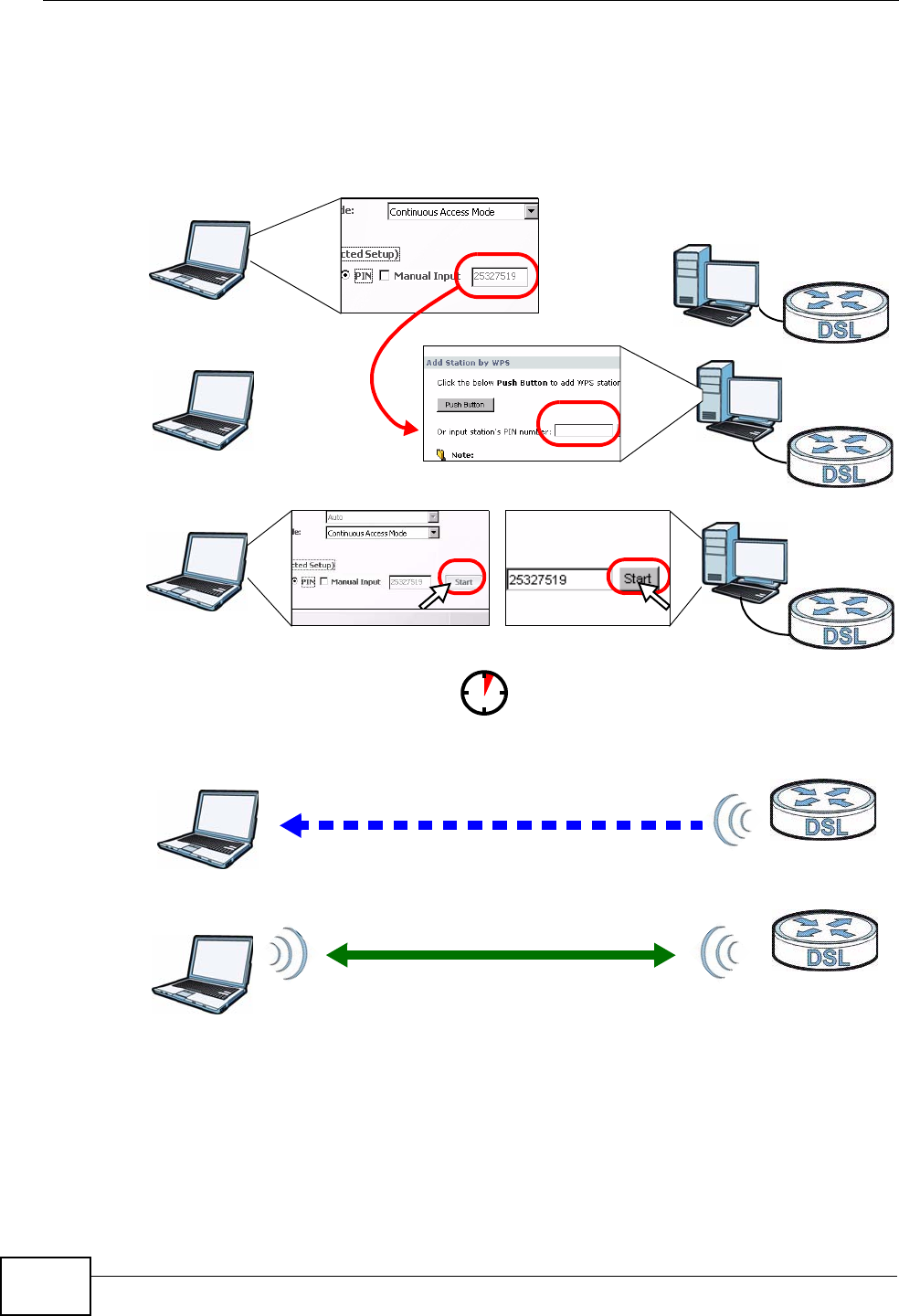
Chapter 6 Tutorials
NBG-416N User’s Guide
60
The following figure shows you the example to set up wireless network and
security on NBG-416N and wireless client (ex. NWD210N in this example) by using
PIN method.
Figure 31 Example WPS Process: PIN Method
Authentication by PIN
SECURITY INFO
WITHIN 2 MINUTES
Wireless Client
NBG-416N
COMMUNICATION

Chapter 6 Tutorials
NBG-416N User’s Guide 61
6.3 Enable and Configure Wireless Security
without WPS on your NBG-416N
This example shows you how to configure wireless security settings with the
following parameters on your NBG-416N.
Follow the steps below to configure the wireless settings on your NBG-416N.
The instructions require that your hardware is connected (see the Quick Start
Guide) and you are logged into the Web Configurator through your LAN connection
(see Section 3.2 on page 25).
1Open the Wireless LAN > General screen in the NBG-416N’s Web Configurator.
2Make sure the Enable Wireless LAN check box is selected.
3Enter SSID_Example3 as the SSID and select a channel.
4Set security mode to WPA-PSK and enter ThisismyWPA-PSKpre-sharedkey in
the Pre-Shared Key field. Click Apply.
Figure 32 Tutorial: Network > Wireless LAN > General
SSID SSID_Example3
Channel 6
Security WPA-PSK
(Pre-Shared Key: ThisismyWPA-PSKpre-sharedkey)

Chapter 6 Tutorials
NBG-416N User’s Guide
62
5Open the Status screen. Verify your wireless and wireless security settings under
Device Information and check if the WLAN connection is up under Interface
Status.
Figure 33 Tutorial: Status Screen
6.3.0.1 Configure Your Notebook
Note: We use the ZyXEL M-302 wireless adapter utility screens as an example for the
wireless client. The screens may vary for different models.
1The NBG-416N supports IEEE 802.11b, IEEE 802.11g and IEEE 802.11n wireless
clients. Make sure that your notebook or computer’s wireless adapter supports
one of these standards.
2Wireless adapters come with software sometimes called a “utility” that you install
on your computer. See your wireless adapter’s User’s Guide for information on
how to do that.
3After you’ve installed the utility, open it. If you cannot see your utility’s icon on
your screen, go to Start > Programs and click on your utility in the list of
programs that appears. The utility displays a list of APs within range, as shown in
the example screen below.

Chapter 6 Tutorials
NBG-416N User’s Guide 63
4Select SSID_Example3 and click Connect.
Figure 34 Connecting a Wireless Client to a Wireless Network t
5Select WPA-PSK and type the security key in the following screen. Click Next.
Figure 35 Security Settings
6The Confirm Save window appears. Check your settings and click Save to
continue.
Figure 36 Confirm Save
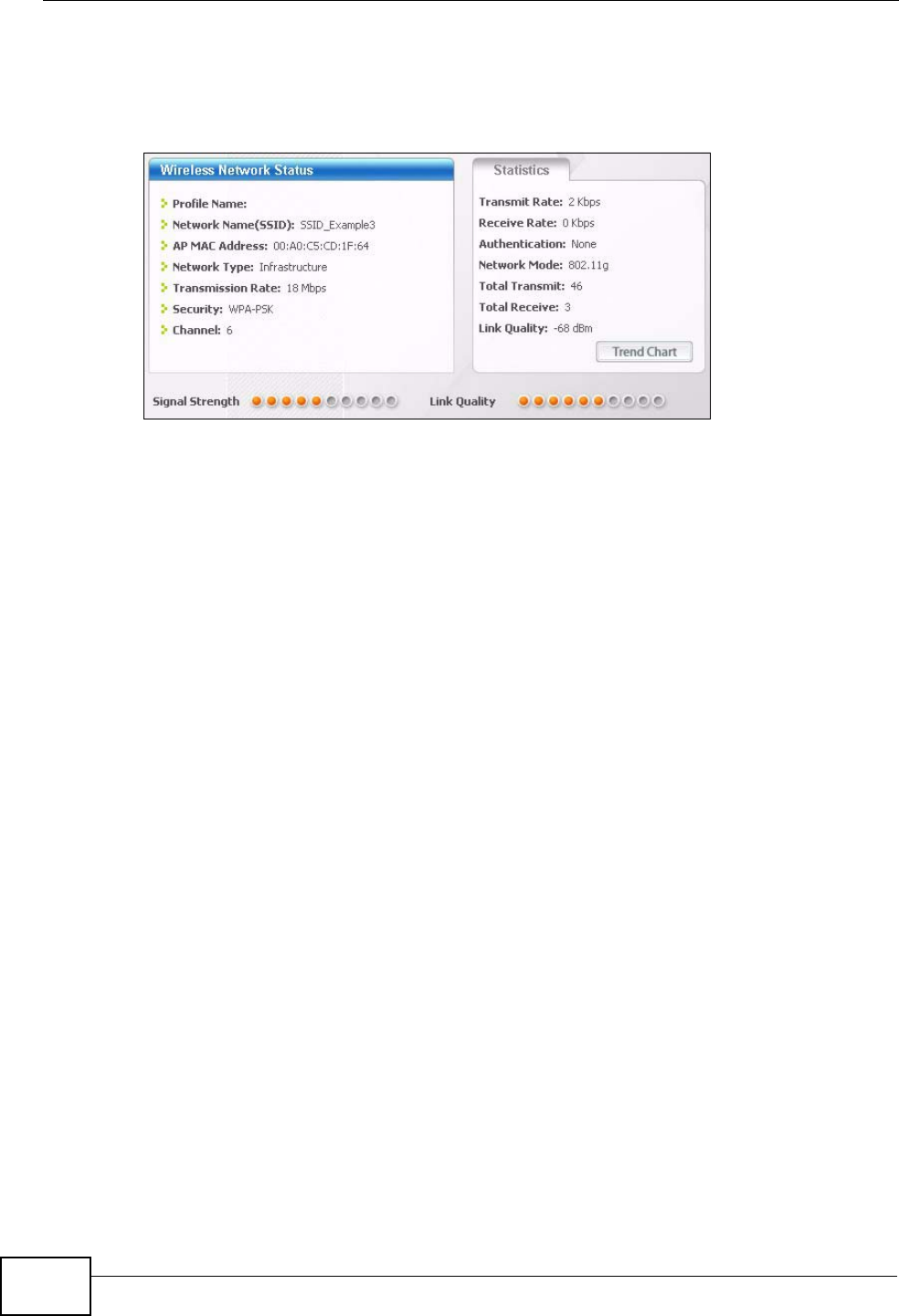
Chapter 6 Tutorials
NBG-416N User’s Guide
64
7Check the status of your wireless connection in the screen below. If your wireless
connection is weak or you have no connection, see the Troubleshooting section of
this User’s Guide.
Figure 37 Link Status
If your connection is successful, open your Internet browser and enter http://
www.zyxel.com or the URL of any other web site in the address bar. If you are able
to access the web site, your wireless connection is successfully configured.

65
PART II
Technical Reference

66

NBG-416N User’s Guide 67
CHAPTER 7
Wireless LAN
7.1 Overview
This chapter discusses how to configure the wireless network settings in your
NBG-416N. See the appendices for more detailed information about wireless
networks.
The following figure provides an example of a wireless network.
Figure 38 Example of a Wireless Network
The wireless network is the part in the blue circle. In this wireless network,
devices A and B are called wireless clients. The wireless clients use the access
point (AP) to interact with other devices (such as the printer) or with the Internet.
Your NBG-416N is the AP.

Chapter 7 Wireless LAN
NBG-416N User’s Guide
68
7.2 What You Can Do
•Use the General screen to enable the Wireless LAN, enter the SSID and select
the wireless security mode (Section 7.4 on page 71).
•Use the MAC Filter screen to allow or deny wireless stations based on their
MAC addresses from connecting to the NBG-416N (Section 7.5 on page 76).
•Use the Advanced screen to allow intra-BSS networking and set the RTS/CTS
Threshold (Section 7.6 on page 77).
•Use the QoS screen to enable Wifi MultiMedia Quality of Service (WMMQoS).
This allows the NBG-416N to automatically set priority levels to services, such
as e-mail, VoIP, chat, and so on (Section 7.7 on page 79).
•Use the WPS screen to quickly set up a wireless network with strong security,
without having to configure security settings manually (Section 7.8 on page 80).
•Use the WPS Station screen to add a wireless station using WPS (Section 7.9
on page 81).
•Use the Scheduling screen to set the times your wireless LAN is turned on and
off (Section 7.10 on page 81).
7.3 What You Should Know
Every wireless network must follow these basic guidelines.
• Every wireless client in the same wireless network must use the same SSID.
The SSID is the name of the wireless network. It stands for Service Set IDentity.
• If two wireless networks overlap, they should use different channels.
Like radio stations or television channels, each wireless network uses a specific
channel, or frequency, to send and receive information.
• Every wireless client in the same wireless network must use security compatible
with the AP.
Security stops unauthorized devices from using the wireless network. It can also
protect the information that is sent in the wireless network.
7.3.1 Wireless Security Overview
The following sections introduce different types of wireless security you can set up
in the wireless network.
7.3.1.1 SSID
Normally, the AP acts like a beacon and regularly broadcasts the SSID in the area.
You can hide the SSID instead, in which case the AP does not broadcast the SSID.

Chapter 7 Wireless LAN
NBG-416N User’s Guide 69
In addition, you should change the default SSID to something that is difficult to
guess.
This type of security is fairly weak, however, because there are ways for
unauthorized devices to get the SSID. In addition, unauthorized devices can still
see the information that is sent in the wireless network.
7.3.1.2 MAC Address Filter
Every wireless client has a unique identification number, called a MAC address.1 A
MAC address is usually written using twelve hexadecimal characters2; for
example, 00A0C5000002 or 00:A0:C5:00:00:02. To get the MAC address for each
wireless client, see the appropriate User’s Guide or other documentation.
You can use the MAC address filter to tell the AP which wireless clients are allowed
or not allowed to use the wireless network. If a wireless client is allowed to use the
wireless network, it still has to have the correct settings (SSID, channel, and
security). If a wireless client is not allowed to use the wireless network, it does not
matter if it has the correct settings.
This type of security does not protect the information that is sent in the wireless
network. Furthermore, there are ways for unauthorized devices to get the MAC
address of an authorized wireless client. Then, they can use that MAC address to
use the wireless network.
7.3.1.3 User Authentication
You can make every user log in to the wireless network before they can use it.
This is called user authentication. However, every wireless client in the wireless
network has to support IEEE 802.1x to do this.
For wireless networks, there are two typical places to store the user names and
passwords for each user.
• In the AP: this feature is called a local user database or a local database.
• In a RADIUS server: this is a server used in businesses more than in homes.
If your AP does not provide a local user database and if you do not have a RADIUS
server, you cannot set up user names and passwords for your users.
Unauthorized devices can still see the information that is sent in the wireless
network, even if they cannot use the wireless network. Furthermore, there are
ways for unauthorized wireless users to get a valid user name and password.
Then, they can use that user name and password to use the wireless network.
1. Some wireless devices, such as scanners, can detect wireless networks but cannot use wireless networks.
These kinds of wireless devices might not have MAC addresses.
2. Hexadecimal characters are 0, 1, 2, 3, 4, 5, 6, 7, 8, 9, A, B, C, D, E, and F.

Chapter 7 Wireless LAN
NBG-416N User’s Guide
70
Local user databases also have an additional limitation that is explained in the
next section.
7.3.1.4 Encryption
Wireless networks can use encryption to protect the information that is sent in the
wireless network. Encryption is like a secret code. If you do not know the secret
code, you cannot understand the message.
The types of encryption you can choose depend on the type of user
authentication. (See Section 7.3.1.3 on page 69 for information.)
For example, if users do not log in to the wireless network, you can choose no
encryption, Static WEP, WPA-PSK, or WPA2-PSK.
Usually, you should set up the strongest encryption that every wireless client in
the wireless network supports. Suppose the wireless network has two wireless
clients. Device A only supports WEP, and device B supports WEP and WPA.
Therefore, you should set up Static WEP in the wireless network.
Note: It is recommended that wireless networks use WPA-PSK, WPA, or stronger
encryption. IEEE 802.1x and WEP encryption are better than none at all, but it
is still possible for unauthorized devices to figure out the original information
pretty quickly.
Note: It is not possible to use WPA-PSK, WPA or stronger encryption with a local user
database. In this case, it is better to set up stronger encryption with no
authentication than to set up weaker encryption with the local user database.
When you select WPA2 or WPA2-PSK in your NBG-416N, you can also select an
option (WPA Compatible) to support WPA as well. In this case, if some wireless
clients support WPA and some support WPA2, you should set up WPA2-PSK or
WPA2 (depending on the type of wireless network login) and select the WPA
Compatible option in the NBG-416N.
Many types of encryption use a key to protect the information in the wireless
network. The longer the key, the stronger the encryption. Every wireless client in
the wireless network must have the same key.
Table 22 Types of Encryption for Each Type of Authentication
NO AUTHENTICATION
Weakest No Security
Static WEP
WPA-PSK
Strongest WPA2-PSK
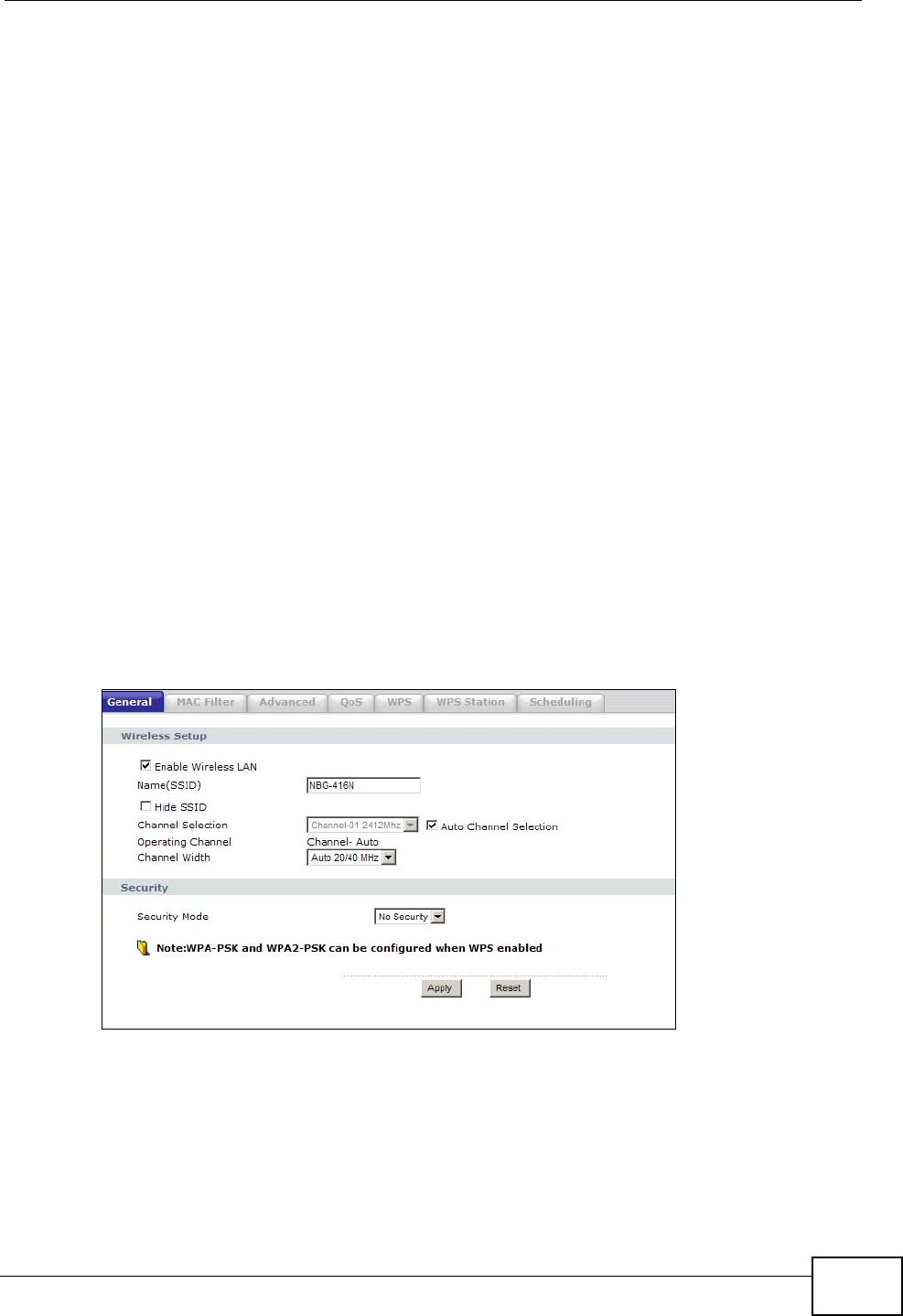
Chapter 7 Wireless LAN
NBG-416N User’s Guide 71
7.3.1.5 WPS
WiFi Protected Setup (WPS) is an industry standard specification, defined by the
WiFi Alliance. WPS allows you to quickly set up a wireless network with strong
security, without having to configure security settings manually. Depending on the
devices in your network, you can either press a button (on the device itself, or in
its configuration utility) or enter a PIN (Personal Identification Number) in the
devices. Then, they connect and set up a secure network by themselves. See how
to set up a secure wireless network using WPS in the Section 6.2.1 on page 57.
7.4 General Wireless LAN Screen
Use this screen to enable the Wireless LAN, enter the SSID and select the wireless
security mode.
Note: If you are configuring the NBG-416N from a computer connected to the wireless
LAN and you change the NBG-416N’s SSID, channel or security settings, you
will lose your wireless connection when you press Apply to confirm. You must
then change the wireless settings of your computer to match the NBG-416N’s
new settings.
Click Network > Wireless LAN to open the General screen.
Figure 39 Network > Wireless LAN > General

Chapter 7 Wireless LAN
NBG-416N User’s Guide
72
The following table describes the general wireless LAN labels in this screen.
See the rest of this chapter for information on the other labels in this screen.
7.4.1 No Security
Select No Security to allow wireless stations to communicate with the access
points without any data encryption.
Table 23 Network > Wireless LAN > General
LABEL DESCRIPTION
Enable
Wireless LAN Click the check box to activate wireless LAN.
Name(SSID) (Service Set IDentity) The SSID identifies the Service Set with which a
wireless station is associated. Wireless stations associating to the access
point (AP) must have the same SSID. Enter a descriptive name (up to 32
printable 7-bit ASCII characters) for the wireless LAN.
Hide SSID Select this check box to hide the SSID in the outgoing beacon frame so a
station cannot obtain the SSID through scanning using a site survey tool.
Channel
Selection Set the operating frequency/channel depending on your particular region.
Select a channel from the drop-down list box. The options vary depending
on the frequency band and the country you are in.
Refer to the Connection Wizard chapter for more information on channels.
This option is only available if Auto Channel Selection is disabled.
Auto Channel
Selection Select this check box for the NBG-416N to automatically choose the
channel with the least interference. Deselect this check box if you wish to
manually select the channel using the Channel Section field.
Operating
Channel This displays the channel the NBG-416N is currently using.
Channel
Width Select whether the NBG-416N uses a wireless channel width of 20MHz or
Auto 20/40MHz. A standard 20MHz channel offers transfer speeds of up
to 150Mbps whereas a 40MHz channel uses two standard channels and
offers speeds of up to 300 Mbps. Because not all devices support 40MHz
channels, select Auto 20/40MHz to allow the NBG-416N to adjust the
channel bandwidth automatically.
Security
Mode Select WPA-PSK or WPA2-PSK to add security on this wireless network.
The wireless clients which want to associate to this network must have
same wireless security settings as this device. After you select to use a
security, additional options appears in this screen. See 7.4.2 and 7.4.3
sections. Or you can select No Security to allow any client to associate
this network without authentication.
Note: If you enable the WPS function, only No Security, WPA-PSK
and WPA2-PSK are available in this field.
Apply Click Apply to save your changes back to the NBG-416N.
Reset Click Reset to reload the previous configuration for this screen.

Chapter 7 Wireless LAN
NBG-416N User’s Guide 73
Note: If you do not enable any wireless security on your NBG-416N, your network is
accessible to any wireless networking device that is within range.
Figure 40 Network > Wireless LAN > General: No Security
The following table describes the labels in this screen.
7.4.2 WEP Encryption
WEP encryption scrambles the data transmitted between the wireless stations and
the access points to keep network communications private. It encrypts unicast
and multicast communications in a network. Both the wireless stations and the
access points must use the same WEP key.
Your NBG-416N allows you to configure up to four 64-bit or 128-bit WEP keys but
only one key can be enabled at any one time.
Table 24 Network > Wireless LAN > General: No Security
LABEL DESCRIPTION
Security
Mode Choose No Security from the drop-down list box.
Apply Click Apply to save your changes back to the NBG-416N.
Reset Click Reset to reload the previous configuration for this screen.

Chapter 7 Wireless LAN
NBG-416N User’s Guide
74
In order to configure and enable WEP encryption; click Network > Wireless LAN
to display the General screen. Select Static WEP from the Security Mode list.
Figure 41 Network > Wireless LAN > General: Static WEP
The following table describes the wireless LAN security labels in this screen.
Table 25 Network > Wireless LAN > General: Static WEP
LABEL DESCRIPTION
Security Mode Choose Static WEP from the drop-down list box.
WEP Encryption Select 64-bit WEP or 128-bit WEP to enable data encryption.
Authentication
Method Select Auto, Open System or Shared Key from the drop-down list
box.
This field specifies whether the wireless clients have to provide the WEP
key to login to the wireless client. Keep this setting at Auto or Open
System unless you want to force a key verification before
communication between the wireless client and the ZyXEL Device
occurs. Select Shared Key to force the clients to provide the WEP key
prior to communication.
ASCII Select this option in order to enter ASCII characters as WEP key.
Hex Select this option in order to enter hexadecimal characters as a WEP
key.
The preceding "0x", that identifies a hexadecimal key, is entered
automatically.
Key 1 to Key 4 The WEP keys are used to encrypt data. Both the NBG-416N and the
wireless stations must use the same WEP key for data transmission.
If you chose 64-bit WEP, then enter any 5 ASCII characters or 10
hexadecimal characters ("0-9", "A-F").
If you chose 128-bit WEP, then enter 13 ASCII characters or 26
hexadecimal characters ("0-9", "A-F").
You must configure at least one key, only one key can be activated at
any one time. The default key is key 1.

Chapter 7 Wireless LAN
NBG-416N User’s Guide 75
7.4.3 WPA-PSK/WPA2-PSK
Click Network > Wireless LAN to display the General screen. Select WPA-PSK
or WPA2-PSK from the Security Mode list.
Figure 42 Network > Wireless LAN > General: WPA-PSK/WPA2-PSK
The following table describes the labels in this screen.
Apply Click Apply to save your changes back to the NBG-416N.
Reset Click Reset to reload the previous configuration for this screen.
Table 25 Network > Wireless LAN > General: Static WEP (continued)
LABEL DESCRIPTION
Table 26 Network > Wireless LAN > General: WPA-PSK/WPA2-PSK
LABEL DESCRIPTION
Security Mode Choose WPA-PSK or WPA2-PSK from the drop-down list box.
WPA
Compatible This check box is available only when you select WPA2-PSK in the
Security Mode field.
Select the check box to have both WPA2 and WPA wireless clients be
able to communicate with the NBG-416N even when the NBG-416N is
using WPA2-PSK.
Pre-Shared Key WPA-PSK/WPA2-PSK uses a simple common password for
authentication.
Type a pre-shared key from 8 to 63 case-sensitive ASCII characters
(including spaces and symbols).
Type a pre-shared key less than 64 case-sensitive HEX characters ("0-
9", "A-F").
Group Key
Update Timer The Group Key Update Timer is the rate at which the AP (if using
WPA-PSK/WPA2-PSK key management) or RADIUS server (if using
WPA/WPA2 key management) sends a new group key out to all
clients. The re-keying process is the WPA/WPA2 equivalent of
automatically changing the WEP key for an AP and all stations in a
WLAN on a periodic basis. Setting of the Group Key Update Timer is
also supported in WPA-PSK/WPA2-PSK mode.
Apply Click Apply to save your changes back to the NBG-416N.
Reset Click Reset to reload the previous configuration for this screen.

Chapter 7 Wireless LAN
NBG-416N User’s Guide
76
7.5 MAC Filter
The MAC filter screen allows you to configure the NBG-416N to give exclusive
access to up to 16 devices (Allow) or exclude up to 16 devices from accessing the
NBG-416N (Deny). Every Ethernet device has a unique MAC (Media Access
Control) address. The MAC address is assigned at the factory and consists of six
pairs of hexadecimal characters, for example, 00:A0:C5:00:00:02. You need to
know the MAC address of the devices to configure this screen.
To change your NBG-416N’s MAC filter settings, click Network > Wireless LAN >
MAC Filter. The screen appears as shown.
Figure 43 Network > Wireless LAN > MAC Filter
The following table describes the labels in this menu.
Table 27 Network > Wireless LAN > MAC Filter
LABEL DESCRIPTION
Active Select Yes from the drop down list box to enable MAC address filtering.
Filter Action Define the filter action for the list of MAC addresses in the MAC Address
table.
Select Deny to block access to the NBG-416N, MAC addresses not listed will
be allowed to access the NBG-416N.
Select Allow to permit access to the NBG-416N, MAC addresses not listed
will be denied access to the NBG-416N.

Chapter 7 Wireless LAN
NBG-416N User’s Guide 77
7.6 Wireless LAN Advanced Screen
Use this screen to allow intra-BSS networking and set the RTS/CTS Threshold.
Click Network > Wireless LAN > Advanced. The screen appears as shown.
Figure 44 Network > Wireless LAN > Advanced
The following table describes the labels in this screen.
Set This is the index number of the MAC address.
MAC
Address Enter the MAC addresses of the wireless station that are allowed or denied
access to the NBG-416N in these address fields. Enter the MAC addresses in
a valid MAC address format, that is, six hexadecimal character pairs, for
example, 12:34:56:78:9a:bc.
Apply Click Apply to save your changes back to the NBG-416N.
Reset Click Reset to reload the previous configuration for this screen.
Table 27 Network > Wireless LAN > MAC Filter (continued)
LABEL DESCRIPTION
Table 28 Network > Wireless LAN > Advanced
LABEL DESCRIPTION
Wireless Advanced Setup
RTS/CTS
Threshold Data with its frame size larger than this value will perform the RTS
(Request To Send)/CTS (Clear To Send) handshake.
Enter a value between 0 and 2347.

Chapter 7 Wireless LAN
NBG-416N User’s Guide
78
Fragmentation
Threshold The threshold (number of bytes) for the fragmentation boundary for
directed messages. It is the maximum data fragment size that can be
sent. Enter an even number between 256 and 2346.
This field is not available when Super Mode is selected.
Beacon
Interval When a wirelessly networked device sends a beacon, it includes with it a
beacon interval. This specifies the time period before the device sends
the beacon again. The interval tells receiving devices on the network
how long they can wait in low-power mode before waking up to handle
the beacon. This value can be set from 20 to 1024 ms. A high value
helps save current consumption of the access point.
DTIM Period Delivery Traffic Indication Message (DTIM) is the time period after which
broadcast and multicast packets are transmitted to mobile clients in the
Active Power Management mode. A high DTIM value can cause clients to
lose connectivity with the network. This value can be set from 1 to 10.
Preamble Type A preamble affects the timing in your wireless network. There are two
preamble modes: long and short. If a device uses a different preamble
mode than the NBG-416N does, it cannot communicate with the NBG-
416N.
CTS Protection When set to None, the NBG-416N protects wireless communication
against interference.
Select Auto to let the NBG-416N determine whether to turn this feature
on or off in the current environment.
Tx Power This field controls the transmission power of the NBG-416N. When using
the NBG-416N with a notebook computer, select a lower transmission
power level when you are close to the AP in order to conserve battery
power.
Extension
Channel If you select Auto 20/40MHz as your Channel Bandwidth in the
Wireless LAN > General screen, the extension channel enables the
NBG-419N to get higher data throughput. This also lowers radio
interference and traffic.
Aggregation Select Enable to allow the grouping of several A-MSDUs (Aggregate
MAC Service Data Units) into one large A-MPDU (Aggregate MAC Protocol
Data Unit). This function allows faster data transfer rates.
Short GI Select Enable to use Short GI (Guard Interval). The guard interval is the
gap introduced between data transmission from users in order to reduce
interference. Reducing the GI increases data transfer rates but also
increases interference. Increasing the GI reduces data transfer rates but
also reduces interference.
Enable Intra-
BSS Traffic A Basic Service Set (BSS) exists when all communications between
wireless clients or between a wireless client and a wired network client
go through one access point (AP).
Intra-BSS traffic is traffic between wireless clients in the BSS. When
Intra-BSS is enabled, wireless client A and B can access the wired
network and communicate with each other. When Intra-BSS is disabled,
wireless client A and B can still access the wired network but cannot
communicate with each other.
Apply Click Apply to save your changes to the NBG-416N.
Reset Click Reset to reload the previous configuration for this screen.
Table 28 Network > Wireless LAN > Advanced (continued)
LABEL DESCRIPTION
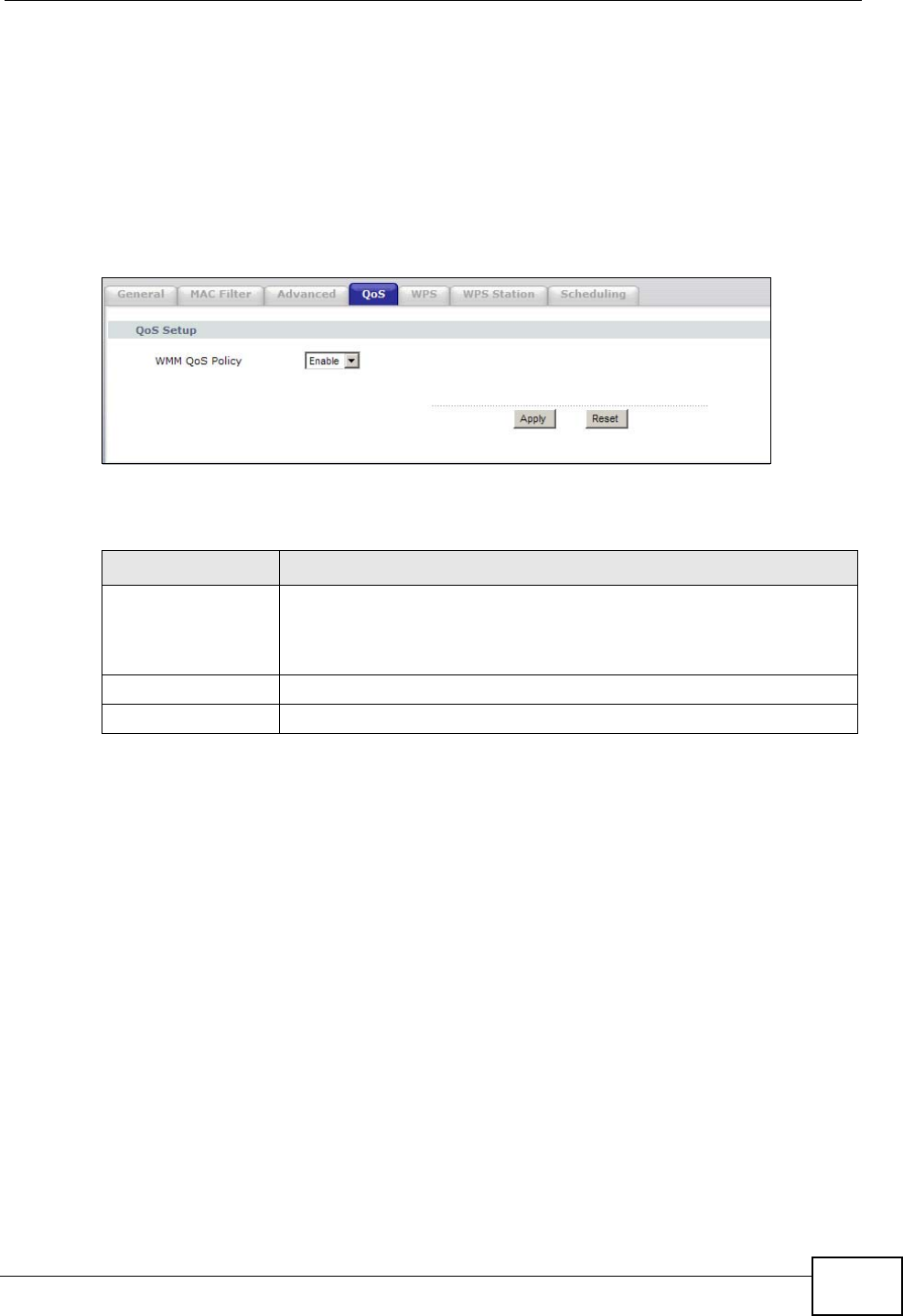
Chapter 7 Wireless LAN
NBG-416N User’s Guide 79
7.7 Quality of Service (QoS) Screen
Use the QoS screen to enable Wifi MultiMedia Quality of Service (WMMQoS). This
allows the NBG-416N to automatically set priority levels to services, such as e-
mail, VoIP, chat, and so on.
Click Network > Wireless LAN > QoS. The following screen appears.
Figure 45 Network > Wireless LAN > QoS
The following table describes the labels in this screen.
Table 29 Network > Wireless LAN > QoS
LABEL DESCRIPTION
Enable WMM QoS Check this to have the NBG-416N automatically give a service a
priority level according to the ToS value in the IP header of packets
it sends. WMM QoS (Wifi MultiMedia Quality of Service) gives high
priority to voice and video, which makes them run more smoothly.
Apply Click Apply to save your changes to the NBG-416N.
Reset Click Reset to reload the previous configuration for this screen.
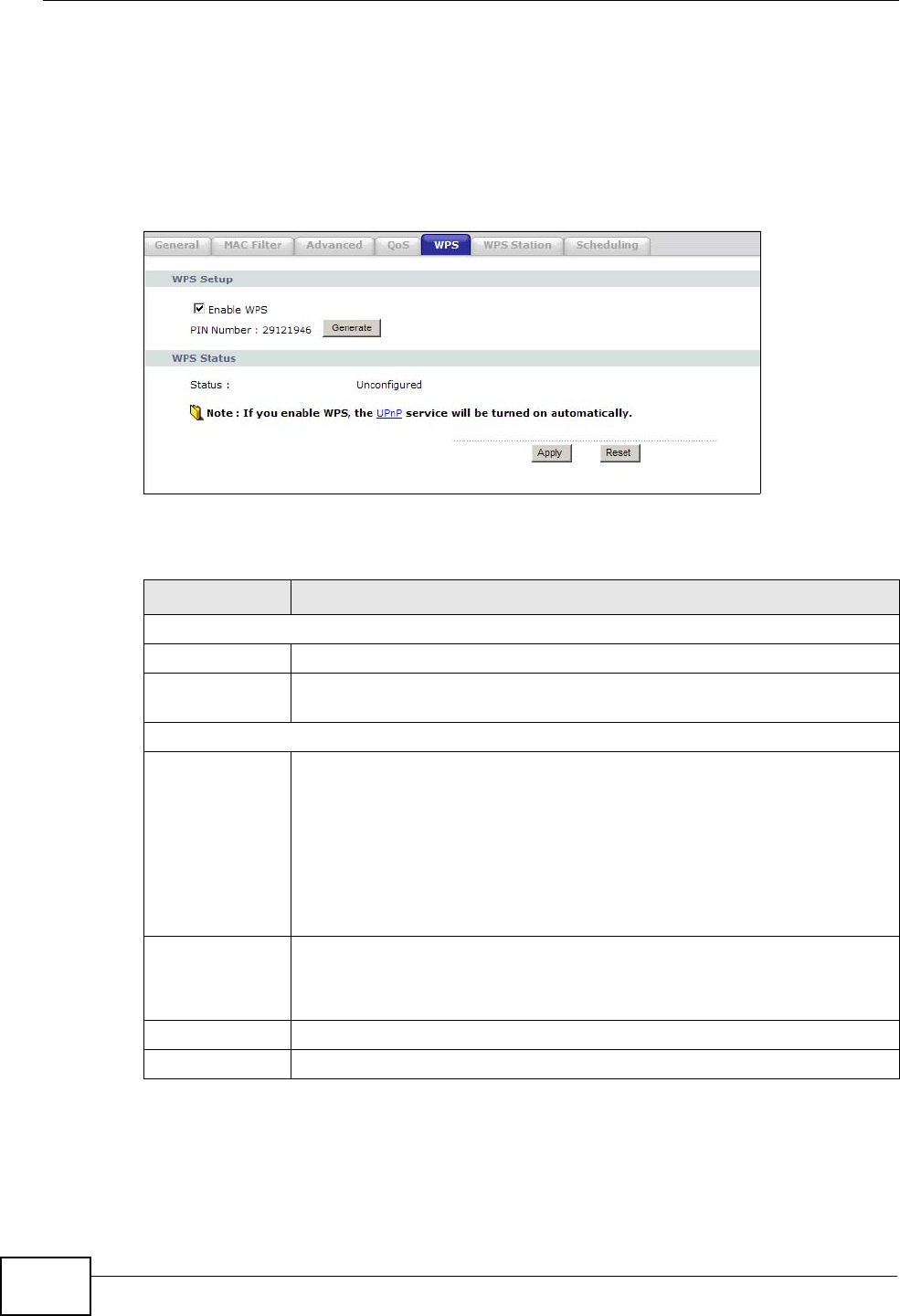
Chapter 7 Wireless LAN
NBG-416N User’s Guide
80
7.8 WPS Screen
Use this screen to enable/disable WPS, view or generate a new PIN number and
check current WPS status. To open this screen, click Network > Wireless LAN >
WPS tab.
Figure 46 Network > Wireless LAN > WPS
The following table describes the labels in this screen.
Table 30 Network > Wireless LAN > WPS
LABEL DESCRIPTION
WPS Setup
Enable WPS Select this to enable the WPS feature.
PIN Number This displays a PIN number last time system generated. Click Generate
to generate a new PIN number.
WPS Status
Status This displays Configured when the NBG-416N has connected to a
wireless network using WPS or when Enable WPS is selected and
wireless or wireless security settings have been changed. The current
wireless and wireless security settings also appear in the screen.
This displays Unconfigured if WPS is disabled and there are no
wireless or wireless security changes on the NBG-416N or you click
Release_Configuration to remove the configured wireless and
wireless security settings.
Release
Configuration This button is only available when the WPS status displays Configured.
Click this button to remove all configured wireless and wireless security
settings for WPS connections on the NBG-416N.
Apply Click Apply to save your changes back to the NBG-416N.
Refresh Click Refresh to get this screen information afresh.

Chapter 7 Wireless LAN
NBG-416N User’s Guide 81
7.9 WPS Station Screen
Use this screen when you want to add a wireless station using WPS. To open this
screen, click Network > Wireless LAN > WPS Station tab.
Note: Note: After you click Push Button on this screen, you have to press a similar
button in the wireless station utility within 2 minutes. To add the second wireless
station, you have to press these buttons on both device and the wireless station
again after the first 2 minutes.
Figure 47 Network > Wireless LAN > WPS Station
The following table describes the labels in this screen.
7.10 Scheduling Screen
Use this screen to set the times your wireless LAN is turned on and off. Wireless
LAN scheduling is disabled by default. The wireless LAN can be scheduled to turn
Table 31 Network > Wireless LAN > WPS Station
LABEL DESCRIPTION
Push Button Use this button when you use the PBC (Push Button Configuration)
method to configure wireless stations’s wireless settings. See Section
6.2.1.1 on page 58.
Click this to start WPS-aware wireless station scanning and the wireless
security information synchronization.
Or input
station’s PIN
number
Use this button when you use the PIN Configuration method to
configure wireless station’s wireless settings. See Section 6.2.1.2 on
page 59.
Type the same PIN number generated in the wireless station’s utility.
Then click Start to associate to each other and perform the wireless
security information synchronization.
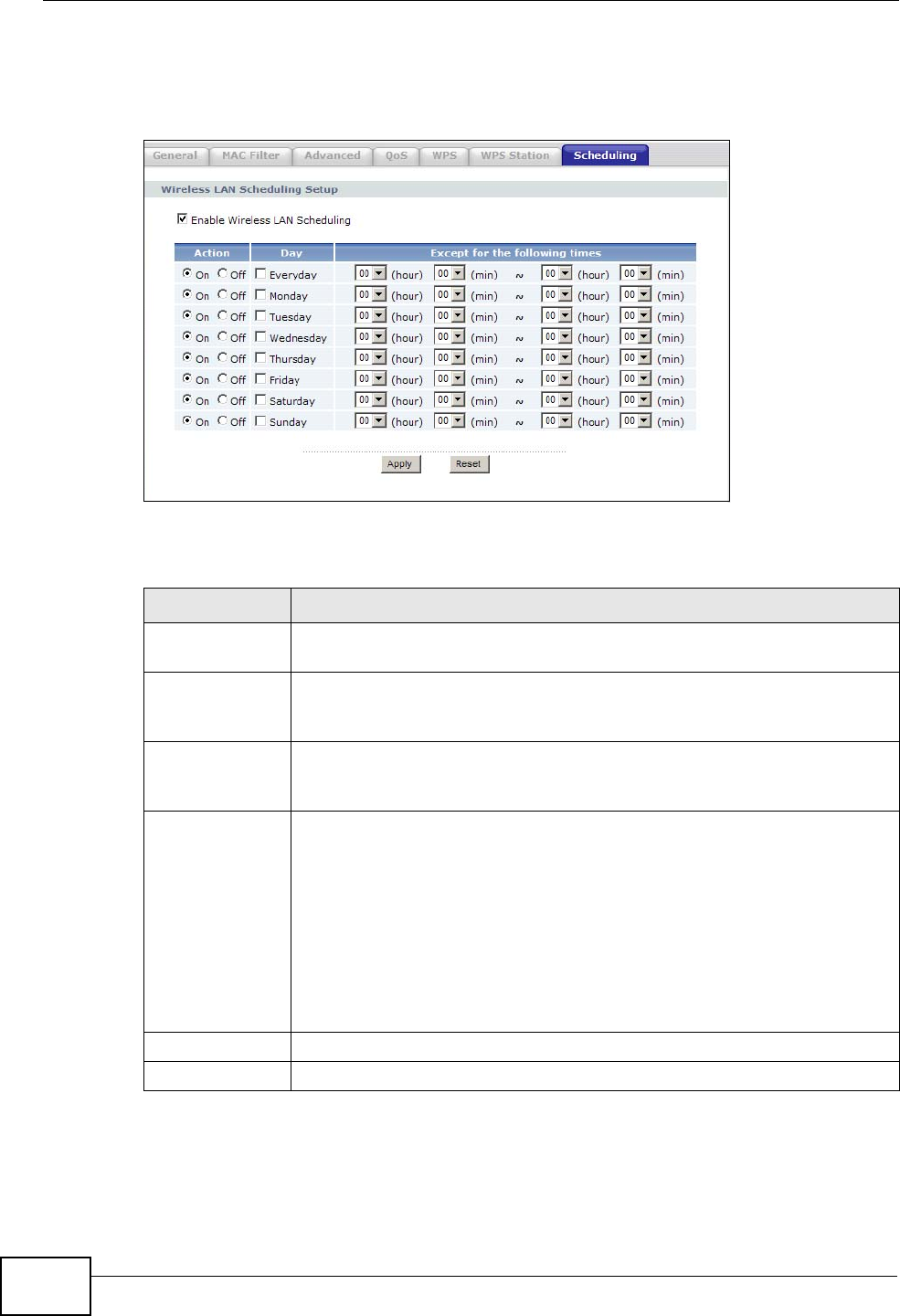
Chapter 7 Wireless LAN
NBG-416N User’s Guide
82
on or off on certain days and at certain times. To open this screen, click Network
> Wireless LAN > Scheduling tab.
Figure 48 Network > Wireless LAN > Scheduling
The following table describes the labels in this screen.
Table 32 Network > Wireless LAN > Scheduling
LABEL DESCRIPTION
Enable Wireless
LAN Scheduling Select this to enable Wireless LAN scheduling.
Action Select On or Off to specify whether the Wireless LAN is turned on or off.
This field works in conjunction with the Day and Except for the
following times fields.
Day Select Everyday or the specific days to turn the Wireless LAN on or off.
If you select Everyday you can not select any specific days. This field
works in conjunction with the Except for the following times field.
Except for the
following times Select a begin time using the first set of hour and minute (min) drop
down boxes and select an end time using the second set of hour and
minute (min) drop down boxes. If you have chosen On earlier for the
WLAN Status the Wireless LAN will turn off between the two times you
enter in these fields. If you have chosen Off earlier for the WLAN Status
the Wireless LAN will turn on between the two times you enter in these
fields.
Note: Entering the same begin time and end time will mean the
whole day.
Apply Click Apply to save your changes back to the NBG-416N.
Reset Click Reset to reload the previous configuration for this screen.

NBG-416N User’s Guide 83
CHAPTER 8
WAN
8.1 Overview
This chapter discusses the NBG-416N’s WAN screens. Use these screens to
configure your NBG-416N for Internet access.
A WAN (Wide Area Network) connection is an outside connection to another
network or the Internet. It connects your private networks (such as a LAN (Local
Area Network) and other networks, so that a computer in one location can
communicate with computers in other locations.
Figure 49 LAN and WAN
See the chapter about the connection wizard for more information on the fields in
the WAN screens.
8.2 What You Need To Know
The information in this section can help you configure the screens for your WAN
connection, as well as enable/disable some advanced features of your NBG-416N.

Chapter 8 WAN
NBG-416N User’s Guide
84
8.2.1 Configuring Your Internet Connection
Encapsulation Method
Encapsulation is used to include data from an upper layer protocol into a lower
layer protocol. To set up a WAN connection to the Internet, you need to use the
same encapsulation method used by your ISP (Internet Service Provider). If your
ISP offers a dial-up Internet connection using PPPoE (PPP over Ethernet) or PPTP
(Point-to-Point Tunneling Protocol), they should also provide a username and
password (and service name) for user authentication.
WAN IP Address
The WAN IP address is an IP address for the NBG-416N, which makes it accessible
from an outside network. It is used by the NBG-416N to communicate with other
devices in other networks. It can be static (fixed) or dynamically assigned by the
ISP each time the NBG-416N tries to access the Internet.
If your ISP assigns you a static WAN IP address, they should also assign you the
subnet mask and DNS server IP address(es) (and a gateway IP address if you use
the Ethernet or ENET ENCAP encapsulation method).
DNS Server Address Assignment
Use Domain Name System (DNS) to map a domain name to its corresponding IP
address and vice versa, for instance, the IP address of www.zyxel.com is
204.217.0.2. The DNS server is extremely important because without it, you must
know the IP address of a computer before you can access it.
The NBG-416N can get the DNS server addresses in the following ways.
1The ISP tells you the DNS server addresses, usually in the form of an information
sheet, when you sign up. If your ISP gives you DNS server addresses, manually
enter them in the DNS server fields.
2If your ISP dynamically assigns the DNS server IP addresses (along with the NBG-
416N’s WAN IP address), set the DNS server fields to get the DNS server address
from the ISP.
WAN MAC Address
The MAC address screen allows users to configure the WAN port's MAC address by
either using the factory default or cloning the MAC address from a computer on
your LAN. Choose Factory Default to select the factory assigned default MAC
Address.

Chapter 8 WAN
NBG-416N User’s Guide 85
Otherwise, click Clone the computer's MAC address - IP Address and enter
the IP address of the computer on the LAN whose MAC you are cloning. Once it is
successfully configured, the address will be copied to configuration file. It is
recommended that you clone the MAC address prior to hooking up the WAN Port.
8.3 Internet Connection
Use this screen to change your NBG-416N’s Internet access settings. Click
Network > WAN. The screen differs according to the encapsulation you choose.
8.3.1 Ethernet Encapsulation
This screen displays when you select Ethernet encapsulation.
Figure 50 Network > WAN > Internet Connection: Ethernet Encapsulation

Chapter 8 WAN
NBG-416N User’s Guide
86
The following table describes the labels in this screen.
Table 33 Network > WAN > Internet Connection: Ethernet Encapsulation
LABEL DESCRIPTION
ISP Parameters for Internet Access
Connection Type You must choose the Ethernet option when the WAN port is used as a
regular Ethernet.
WAN IP Address Assignment
Get
automatically
from ISP
Select this option If your ISP did not assign you a fixed IP address. This
is the default selection.
Use fixed IP
Address Select this option If the ISP assigned a fixed IP address.
IP Address Enter your WAN IP address in this field if you selected Use Fixed IP
Address.
IP Subnet
Mask Enter the IP Subnet Mask in this field.
Gateway IP
Address Enter a Gateway IP Address (if your ISP gave you one) in this field.
MTU Auto Select Auto if you want to have the Maximum Transmission Unit (MTU)
automatically configured. Select Manual if you want to have enter the
MTU manually in the field below.
MTU Enter the MTU or the largest packet size per frame that your NBG-416N
can receive and process.
DNS Servers
First DNS Server
Second DNS
Server
Select From ISP if your ISP dynamically assigns DNS server
information (and the NBG-416N’s WAN IP address). The field to the
right displays the (read-only) DNS server IP address that the ISP
assigns.
Select User-Defined if you have the IP address of a DNS server. Enter
the primary and secondary DNS server's IP address in the fields to the
right.
WAN MAC
Address The MAC address section allows users to configure the WAN port's MAC
address by either using the NBG-416N’s MAC address, copying the MAC
address from a computer on your LAN or manually entering a MAC
address.
Factory default Select Factory default to use the factory assigned default MAC
Address.
Clone the
computer’s MAC
address - IP
Address
Select Clone the computer's MAC address - IP Address and enter
the IP address of the computer on the LAN whose MAC you are cloning.
Once it is successfully configured, the address will be copied to the rom
file. It will not change unless you change the setting or upload a
different ROM file.
Set WAN MAC
Address Select this option and enter the MAC address you want to use.
Apply Click Apply to save your changes back to the NBG-416N.
Reset Click Reset to begin configuring this screen afresh.

Chapter 8 WAN
NBG-416N User’s Guide 87
8.3.2 PPPoE Encapsulation
The NBG-416N supports PPPoE (Point-to-Point Protocol over Ethernet). PPPoE is
an IETF standard (RFC 2516) specifying how a personal computer (PC) interacts
with a broadband modem (DSL, cable, wireless, etc.) connection. The PPP over
Ethernet option is for a dial-up connection using PPPoE.
For the service provider, PPPoE offers an access and authentication method that
works with existing access control systems (for example Radius).
One of the benefits of PPPoE is the ability to let you access one of multiple network
services, a function known as dynamic service selection. This enables the service
provider to easily create and offer new IP services for individuals.
Operationally, PPPoE saves significant effort for both you and the ISP or carrier, as
it requires no specific configuration of the broadband modem at the customer site.
By implementing PPPoE directly on the NBG-416N (rather than individual
computers), the computers on the LAN do not need PPPoE software installed,
since the NBG-416N does that part of the task. Furthermore, with NAT, all of the
LANs’ computers will have access.
This screen displays when you select PPPoE encapsulation.
Figure 51 Network > WAN > Internet Connection: PPPoE Encapsulation

Chapter 8 WAN
NBG-416N User’s Guide
88
The following table describes the labels in this screen.
8.3.3 PPTP Encapsulation
Point-to-Point Tunneling Protocol (PPTP) is a network protocol that enables secure
transfer of data from a remote client to a private server, creating a Virtual Private
Network (VPN) using TCP/IP-based networks.
Table 34 Network > WAN > Internet Connection: PPPoE Encapsulation
LABEL DESCRIPTION
ISP Parameters for Internet Access
Connection
Type Select PPP over Ethernet if you connect to your Internet via dial-up.
Service Name Type the PPPoE service name provided to you. PPPoE uses a service
name to identify and reach the PPPoE server.
User Name Type the user name given to you by your ISP.
Password Type the password associated with the user name above.
Retype to
Confirm Type your password again to make sure that you have entered is
correctly.
MTU Size Enter the MTU or the largest packet size per frame that your NBG-416N
can receive and process.
Nailed-Up
Connection Select Nailed-Up Connection if you do not want the connection to time
out.
Idle Timeout This value specifies the time in minutes that elapses before the router
automatically disconnects from the PPPoE server.
DNS Servers
First DNS
Server
Second DNS
Server
Enter the primary and secondary DNS server's IP addresses.
If you do not configure a DNS server, you must know the IP address of a
computer in order to access it.
WAN MAC
Address The MAC address section allows users to configure the WAN port's MAC
address by using the NBG-416N’s MAC address, copying the MAC
address from a computer on your LAN or manually entering a MAC
address.
Factory default Select Factory default to use the factory assigned default MAC
Address.
Clone the
computer’s
MAC address -
IP Address
Select Clone the computer's MAC address - IP Address and enter
the IP address of the computer on the LAN whose MAC you are cloning.
Once it is successfully configured, the address will be copied to the rom
file. It will not change unless you change the setting or upload a
different ROM file.
Set WAN MAC
Address Select this option and enter the MAC address you want to use.
Apply Click Apply to save your changes back to the NBG-416N.
Reset Click Reset to begin configuring this screen afresh.

Chapter 8 WAN
NBG-416N User’s Guide 89
PPTP supports on-demand, multi-protocol and virtual private networking over
public networks, such as the Internet.
This screen displays when you select PPTP encapsulation.
Figure 52 Network > WAN > Internet Connection: PPTP Encapsulation
The following table describes the labels in this screen.
Table 35 Network > WAN > Internet Connection: PPTP Encapsulation
LABEL DESCRIPTION
ISP Parameters for Internet Access
Connection Type Point-to-Point Tunneling Protocol (PPTP) is a network protocol that
enables secure transfer of data from a remote client to a private
server, creating a Virtual Private Network (VPN) using TCP/IP-based
networks. PPTP supports on-demand, multi-protocol, and virtual
private networking over public networks, such as the Internet. The
NBG-416N supports only one PPTP server connection at any given
time.
To configure a PPTP client, you must configure the User Name and
Password fields for a PPP connection and the PPTP parameters for
a PPTP connection.
User Name Type the user name given to you by your ISP.

Chapter 8 WAN
NBG-416N User’s Guide
90
Password Type the password associated with the User Name above.
Retype to Confirm Type your password again to make sure that you have entered
correctly.
MTU Size Enter the MTU or the largest packet size per frame that your NBG-
416N can receive and process.
Nailed-up
Connection Select Nailed-Up Connection if you do not want the connection to
time out.
Idle Timeout This value specifies the time in minutes that elapses before the
NBG-416N automatically disconnects from the PPTP server.
PPTP Configuration
Server IP Address/
Domain Type the IP address of the PPTP server.
Connection ID/
Name Type your identification name for the PPTP server.
Get automatically
from ISP Select this option If your ISP did not assign you a fixed IP address.
This is the default selection.
Use fixed IP
Address Select this option If the ISP assigned a fixed IP address.
My WAN IP
Address Enter your WAN IP address in this field if you selected Use Fixed IP
Address.
My IP Subnet
Mask Your NBG-416N will automatically calculate the subnet mask based
on the IP address that you assign. Unless you are implementing
subnetting, use the subnet mask computed by the NBG-416N.
My IP Gateway Enter a Gateway IP Address (if your ISP gave you one) in this field.
DNS Servers
First DNS Server
Second DNS Server
Enter the primary and secondary DNS server's IP addresses.
If you do not configure a DNS server, you must know the IP address
of a computer in order to access it.
WAN MAC Address The MAC address section allows users to configure the WAN port's
MAC address by either using the NBG-416N’s MAC address, copying
the MAC address from a computer on your LAN or manually entering
a MAC address.
Factory default Select Factory default to use the factory assigned default MAC
Address.
Clone the
computer’s MAC
address - IP
Address
Select Clone the computer's MAC address - IP Address and
enter the IP address of the computer on the LAN whose MAC you
are cloning. Once it is successfully configured, the address will be
copied to the rom file. It will not change unless you change the
setting or upload a different ROM file.
Set WAN MAC
Address Select this option and enter the MAC address you want to use.
Apply Click Apply to save your changes back to the NBG-416N.
Reset Click Reset to begin configuring this screen afresh.
Table 35 Network > WAN > Internet Connection: PPTP Encapsulation (continued)
LABEL DESCRIPTION

NBG-416N User’s Guide 91
CHAPTER 9
LAN
9.1 Overview
This chapter describes how to configure LAN settings.
A Local Area Network (LAN) is a shared communication system to which many
computers are attached. A LAN is a computer network limited to the immediate
area, usually the same building or floor of a building. The LAN screens can help
you configure a LAN DHCP server, manage IP addresses, and partition your
physical network into logical networks.
Figure 53 LAN Setup
The LAN screens can help you configure a LAN DHCP server and manage IP
addresses.

Chapter 9 LAN
NBG-416N User’s Guide
92
9.2 What You Need To Know
The actual physical connection determines whether the NBG-416N ports are LAN
or WAN ports. There are two separate IP networks, one inside the LAN network
and the other outside the WAN network as shown next.
Figure 54 LAN and WAN IP Addresses
The LAN parameters of the NBG-416N are preset in the factory with the following
values:
• IP address of 192.168.1.1 with subnet mask of 255.255.255.0 (24 bits)
• DHCP server enabled with 32 client IP addresses starting from 192.168.1.33.
These parameters should work for the majority of installations. If your ISP gives
you explicit DNS server address(es), read the embedded Web Configurator help
regarding what fields need to be configured.
9.2.1 IP Pool Setup
The NBG-416N is pre-configured with a pool of 32 IP addresses starting from
192.168.1.33 to 192.168.1.64. This configuration leaves 31 IP addresses
(excluding the NBG-416N itself) in the lower range (192.168.1.2 to 192.168.1.32)
for other server computers, for instance, servers for mail, FTP, TFTP, web, etc.,
that you may have.
Refer to Section 4.4.6 on page 44 for information on IP Address and Subnet Mask.
9.2.2 LAN TCP/IP
The NBG-416N has built-in DHCP server capability that assigns IP addresses and
DNS servers to systems that support DHCP client capability.
Refer to the Section 4.4.7 on page 45 section for information on System DNS
Servers.

Chapter 9 LAN
NBG-416N User’s Guide 93
9.3 LAN IP Screen
Use this screen to change your basic LAN settings. Click Network > LAN.
Figure 55 Network > LAN > IP
The following table describes the labels in this screen.
Table 36 Network > LAN > IP
LABEL DESCRIPTION
IP Address Type the IP address of your NBG-416N in dotted decimal notation
192.168.1.1 (factory default).
IP Subnet Mask The subnet mask specifies the network number portion of an IP
address. Your NBG-416N will automatically calculate the subnet mask
based on the IP address that you assign. Unless you are implementing
subnetting, use the subnet mask computed by the NBG-416N.
Apply Click Apply to save your changes back to the NBG-416N.
Reset Click Reset to begin configuring this screen afresh.

Chapter 9 LAN
NBG-416N User’s Guide
94

NBG-416N User’s Guide 95
CHAPTER 10
DHCP Server
10.1 Overview
DHCP (Dynamic Host Configuration Protocol, RFC 2131 and RFC 2132) allows
individual clients to obtain TCP/IP configuration at start-up from a server. You can
configure the NBG-416N’s LAN as a DHCP server or disable it. When configured as
a server, the NBG-416N provides the TCP/IP configuration for the clients. If DHCP
service is disabled, you must have another DHCP server on your LAN, or else the
computer must be manually configured.
10.2 What You Can Do
•Use the General screen to enable the DHCP server (Section 10.4 on page 96).
•Use the Advanced screen to assign IP addresses on the LAN to specific
individual computers based on their MAC Addresses (Section 10.5 on page 96).
•Use the Client List screen to view the current DHCP client information (Section
10.6 on page 98).
10.3 What You Need To Know
Every Ethernet device has a unique MAC (Media Access Control) address. The MAC
address is assigned at the factory and consists of six pairs of hexadecimal
characters, for example, 00:A0:C5:00:00:02. Find out the MAC addresses of your
network devices if you intend to add them to the DHCP Client List screen.
Refer to Section 4.4.6 on page 44 for information on IP Address and Subnet Mask.
Refer to the Section 4.4.7 on page 45 section for information on System DNS
Servers.

Chapter 10 DHCP Server
NBG-416N User’s Guide
96
10.4 General Screen
Use this screen to enable the DHCP server. Click Network > DHCP Server. The
following screen displays.
Figure 56 Network > DHCP Server > General
The following table describes the labels in this screen.
10.5 Advanced Screen
This screen allows you to assign IP addresses on the LAN to specific individual
computers based on their MAC addresses. You can also use this screen to
configure the DNS server information that the NBG-416N sends to the DHCP
clients.
Table 37 Network > DHCP Server > General
LABEL DESCRIPTION
Enable DHCP
Server Enable or Disable DHCP for LAN.
DHCP (Dynamic Host Configuration Protocol, RFC 2131 and RFC
2132) allows individual clients (computers) to obtain TCP/IP
configuration at startup from a server. Leave the Enable DHCP
Server check box selected unless your ISP instructs you to do
otherwise. Clear it to disable the NBG-416N acting as a DHCP
server. When configured as a server, the NBG-416N provides TCP/IP
configuration for the clients. If not, DHCP service is disabled and
you must have another DHCP server on your LAN, or else the
computers must be manually configured. When set as a server, fill in
the following four fields.
IP Pool Starting
Address This field specifies the first of the contiguous addresses in the IP
address pool for LAN.
Pool Size This field specifies the size, or count of the IP address pool for LAN.
Apply Click Apply to save your changes back to the NBG-416N.
Reset Click Reset to begin configuring this screen afresh.

Chapter 10 DHCP Server
NBG-416N User’s Guide 97
To change your NBG-416N’s static DHCP settings, click Network > DHCP Server
> Advanced. The following screen displays.
Figure 57 Network > DHCP Server > Advanced
The following table describes the labels in this screen.
Table 38 Network > DHCP Server > Advanced
LABEL DESCRIPTION
Static DHCP Table
# This is the index number of the static IP table entry (row).
MAC Address Type the MAC address (with colons) of a computer on your LAN.
IP Address Type the LAN IP address of a computer on your LAN.
DNS Server
DNS Servers
Assigned by
DHCP Server
The NBG-416N passes a DNS (Domain Name System) server IP
address (in the order you specify here) to the DHCP clients. If you do
not configure the DNS server, the DHCP service is disabled and you
must have another DHCP sever on your LAN, or else the computers
must have their DNS server addresses manually configured.

Chapter 10 DHCP Server
NBG-416N User’s Guide
98
10.6 Client List Screen
The DHCP table shows current DHCP client information (including IP Address,
Host Name and MAC Address) of network clients using the NBG-416N’s DHCP
servers.
Configure this screen to always assign an IP address to a MAC address (and host
name). Click Network > DHCP Server > Client List.
Note: You can also view a read-only client list by clicking the DHCP Table (Details...)
hyperlink in the Status screen.
The following screen displays.
Figure 58 Network > DHCP Server > Client List
First DNS Server
Second DNS
Server
Select User-Defined if you have the IP address of a DNS server.
Enter the DNS server's IP address in the field to the right. If you chose
User-Defined, but leave the IP address set to 0.0.0.0, User-Defined
changes to None after you click Apply. If you set a second choice to
User-Defined, and enter the same IP address, the second User-
Defined changes to None after you click Apply.
Select DNS Relay to have the NBG-416N act as a DNS proxy. The
NBG-416N's LAN IP address displays in the field to the right (read-
only). The NBG-416N tells the DHCP clients on the LAN that the NBG-
416N itself is the DNS server. When a computer on the LAN sends a
DNS query to the NBG-416N, the NBG-416N forwards the query to the
NBG-416N's system DNS server (configured in the WAN > Internet
Connection screen) and relays the response back to the computer.
You can only select DNS Relay for one of the three servers; if you
select DNS Relay for a second or third DNS server, that choice
changes to None after you click Apply.
Apply Click Apply to save your changes back to the NBG-416N.
Reset Click Reset to begin configuring this screen afresh.
Table 38 Network > DHCP Server > Advanced (continued)
LABEL DESCRIPTION

Chapter 10 DHCP Server
NBG-416N User’s Guide 99
The following table describes the labels in this screen.
Table 39 Network > DHCP Server > Client List
LABEL DESCRIPTION
# This is the index number of the host computer.
IP Address This field displays the IP address relative to the # field listed above.
Host Name This field displays the computer host name.
MAC Address The MAC (Media Access Control) or Ethernet address on a LAN
(Local Area Network) is unique to your computer (six pairs of
hexadecimal notation).
A network interface card such as an Ethernet adapter has a
hardwired address that is assigned at the factory. This address
follows an industry standard that ensures no other adapter has a
similar address.
Reserve Select this check box in the DHCP Setup section to have the NBG-
416N always assign the IP address(es) to the MAC address(es) (and
host name(s)). After you click Apply, the MAC address and IP
address also display in the Advanced screen (where you can edit
them).
Apply Click Apply to save your settings.
Refresh Click Refresh to reload the DHCP table.

Chapter 10 DHCP Server
NBG-416N User’s Guide
100

NBG-416N User’s Guide 101
CHAPTER 11
Network Address Translation
(NAT)
11.1 Overview
This chapter discusses how to configure NAT on the NBG-416N.
NAT (Network Address Translation - NAT, RFC 1631) is the translation of the IP
address of a host in a packet. For example, the source address of an outgoing
packet, used within one network is changed to a different IP address known within
another network.
Each packet has two addresses – a source address and a destination address. For
outgoing packets, NAT maps private (local) IP addresses to globally unique ones
required for communication with hosts on other networks. It replaces the original
IP source address in each packet and then forwards it to the Internet. The NBG-
416N keeps track of the original addresses and port numbers so incoming reply
packets can have their original values restored. The following figure illustrates
this.
Figure 59 NAT Example
A: 192.168.1.33
B: 192.168.1.34
C: 192.168.1.35
IP address
192.168.1.1
WANLAN
assigned by ISP
FTP, Telnet, SNMP
Port 80
Ports 21 to 25

Chapter 11 Network Address Translation (NAT)
NBG-416N User’s Guide
102
For more information on IP address translation, refer to RFC 1631, The IP Network
Address Translator (NAT).
Note: You must create a firewall rule in addition to setting up NAT, to allow traffic from
the WAN to be forwarded through the NBG-416N.
11.2 What You Can Do
•Use the General screen to enable NAT and set a default server (Section 11.3 on
page 104).
•Use the Application screen to change your NBG-416N’s port forwarding
settings (Section 11.4 on page 105).
11.2.1 What You Need To Know
The following terms and concepts may help as you read through this chapter.
Inside/Outside
This denotes where a host is located relative to the NBG-416N, for example, the
computers of your subscribers are the inside hosts, while the web servers on the
Internet are the outside hosts.
Global/Local
This denotes the IP address of a host in a packet as the packet traverses a router,
for example, the local address refers to the IP address of a host when the packet
is in the local network, while the global address refers to the IP address of the
host when the same packet is traveling in the WAN side.
Note: Inside/outside refers to the location of a host, while global/local refers to the IP
address of a host used in a packet.
An inside local address (ILA) is the IP address of an inside host in a packet when
the packet is still in the local network, while an inside global address (IGA) is the
IP address of the same inside host when the packet is on the WAN side. The
following table summarizes this information.
Table 40 NAT Definitions
ITEM DESCRIPTION
Inside This refers to the host on the LAN.
Outside This refers to the host on the WAN.
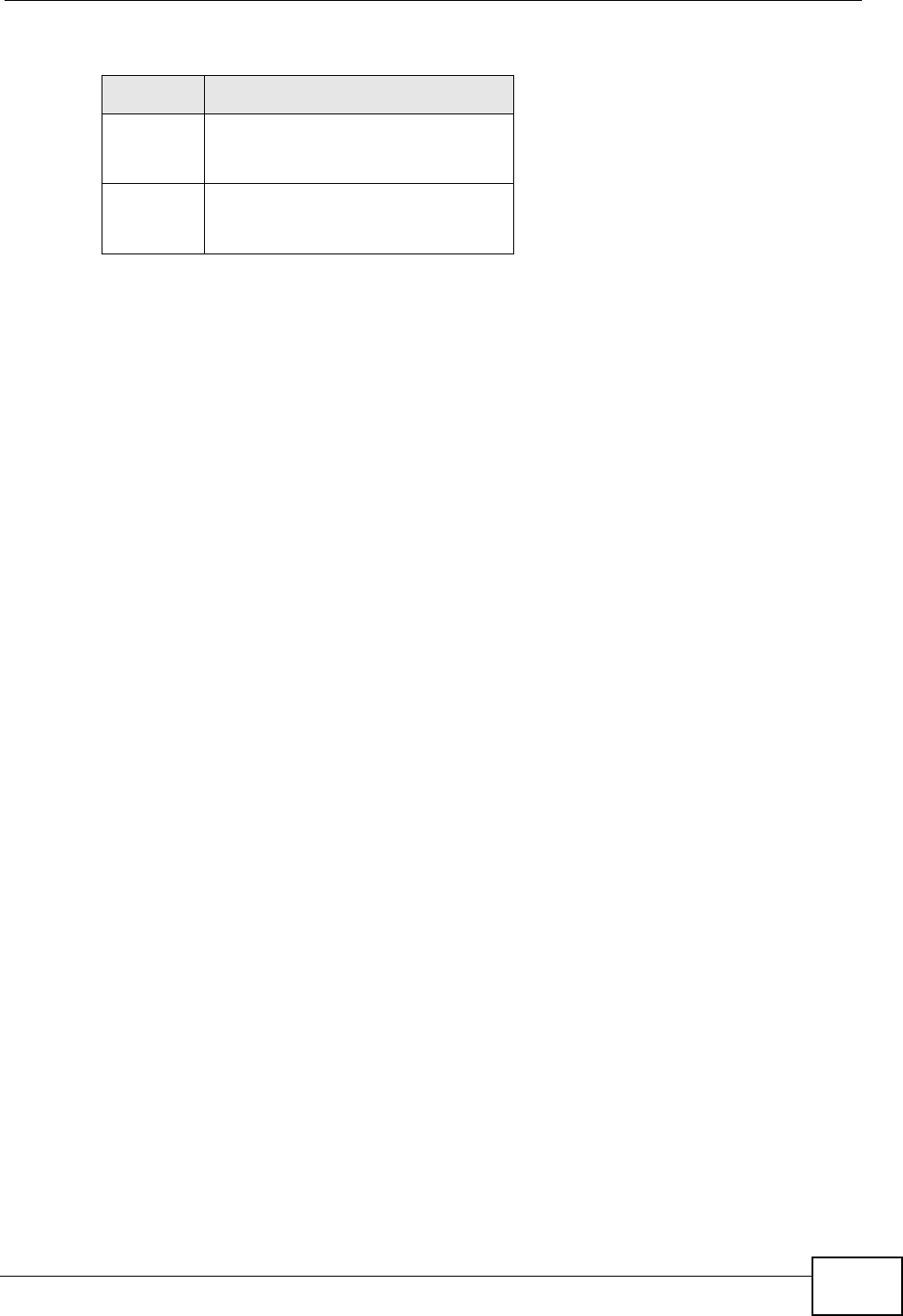
Chapter 11 Network Address Translation (NAT)
NBG-416N User’s Guide 103
Note: NAT never changes the IP address (either local or global) of an outside host.
What NAT Does
In the simplest form, NAT changes the source IP address in a packet received from
a subscriber (the inside local address) to another (the inside global address)
before forwarding the packet to the WAN side. When the response comes back,
NAT translates the destination address (the inside global address) back to the
inside local address before forwarding it to the original inside host. Note that the
IP address (either local or global) of an outside host is never changed.
The global IP addresses for the inside hosts can be either static or dynamically
assigned by the ISP. In addition, you can designate servers, for example, a web
server and a telnet server, on your local network and make them accessible to the
outside world. If you do not define any servers , NAT offers the additional benefit
of firewall protection. With no servers defined, your NBG-416N filters out all
incoming inquiries, thus preventing intruders from probing your network. For
more information on IP address translation, refer to RFC 1631, The IP Network
Address Translator (NAT).
How NAT Works
Each packet has two addresses – a source address and a destination address. For
outgoing packets, the ILA (Inside Local Address) is the source address on the LAN,
and the IGA (Inside Global Address) is the source address on the WAN. For
incoming packets, the ILA is the destination address on the LAN, and the IGA is
the destination address on the WAN. NAT maps private (local) IP addresses to
globally unique ones required for communication with hosts on other networks. It
replaces the original IP source address in each packet and then forwards it to the
Internet. The NBG-416N keeps track of the original addresses and port numbers
Local This refers to the packet address
(source or destination) as the
packet travels on the LAN.
Global This refers to the packet address
(source or destination) as the
packet travels on the WAN.
Table 40 NAT Definitions (continued)
ITEM DESCRIPTION
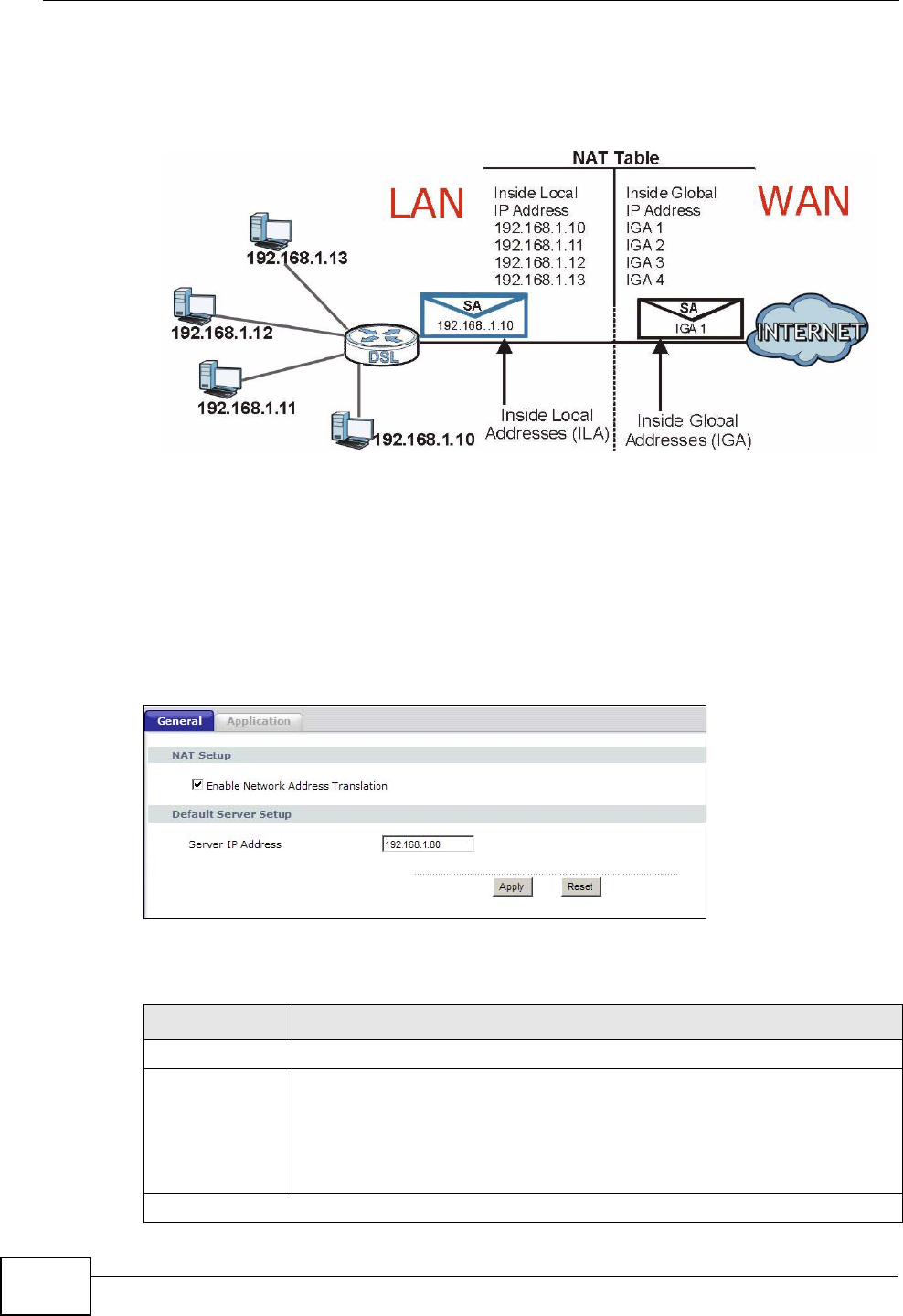
Chapter 11 Network Address Translation (NAT)
NBG-416N User’s Guide
104
so incoming reply packets can have their original values restored. The following
figure illustrates this.
Figure 60 How NAT Works
11.3 General NAT Screen
Use this screen to enable NAT and set a default server. Click Network > NAT to
open the General screen.
Figure 61 Network > NAT > General
The following table describes the labels in this screen.
Table 41 Network > NAT > General
LABEL DESCRIPTION
NAT Setup
Enable Network
Address
Translation
Network Address Translation (NAT) allows the translation of an Internet
protocol address used within one network (for example a private IP
address used in a local network) to a different IP address known within
another network (for example a public IP address used on the Internet).
Select the check box to enable NAT.
Default Server Setup

Chapter 11 Network Address Translation (NAT)
NBG-416N User’s Guide 105
11.4 NAT Application Screen
Use the Application screen to forward incoming service requests to the server(s)
on your local network. You may enter a single port number or a range of port
numbers to be forwarded, and the local IP address of the desired server. The port
number identifies a service; for example, web service is on port 80 and FTP on
port 21. In some cases, such as for unknown services or where one server can
support more than one service (for example both FTP and web service), it might
be better to specify a range of port numbers.
In addition to the servers for specified services, NAT supports a default server. A
service request that does not have a server explicitly designated for it is forwarded
to the default server. If the default is not defined, the service request is simply
discarded.
Note: Many residential broadband ISP accounts do not allow you to run any server
processes (such as a Web or FTP server) from your location. Your ISP may
periodically check for servers and may suspend your account if it discovers any
active services at your location. If you are unsure, refer to your ISP.
Port forwarding allows you to define the local servers to which the incoming
services will be forwarded. To change your NBG-416N’s port forwarding settings,
click Network > NAT > Application. The screen appears as shown.
Note: If you do not assign a Default Server IP address in the NAT > General screen,
the NBG-416N discards all packets received for ports that are not specified in
this screen or remote management.
Server IP
Address In addition to the servers for specified services, NAT supports a default
server. A default server receives packets from ports that are not
specified in the Application screen.
If you do not assign a Default Server IP address, the NBG-416N
discards all packets received for ports that are not specified in the
Application screen or remote management.
Apply Click Apply to save your changes back to the NBG-416N.
Reset Click Reset to begin configuring this screen afresh.
Table 41 Network > NAT > General (continued)
LABEL DESCRIPTION
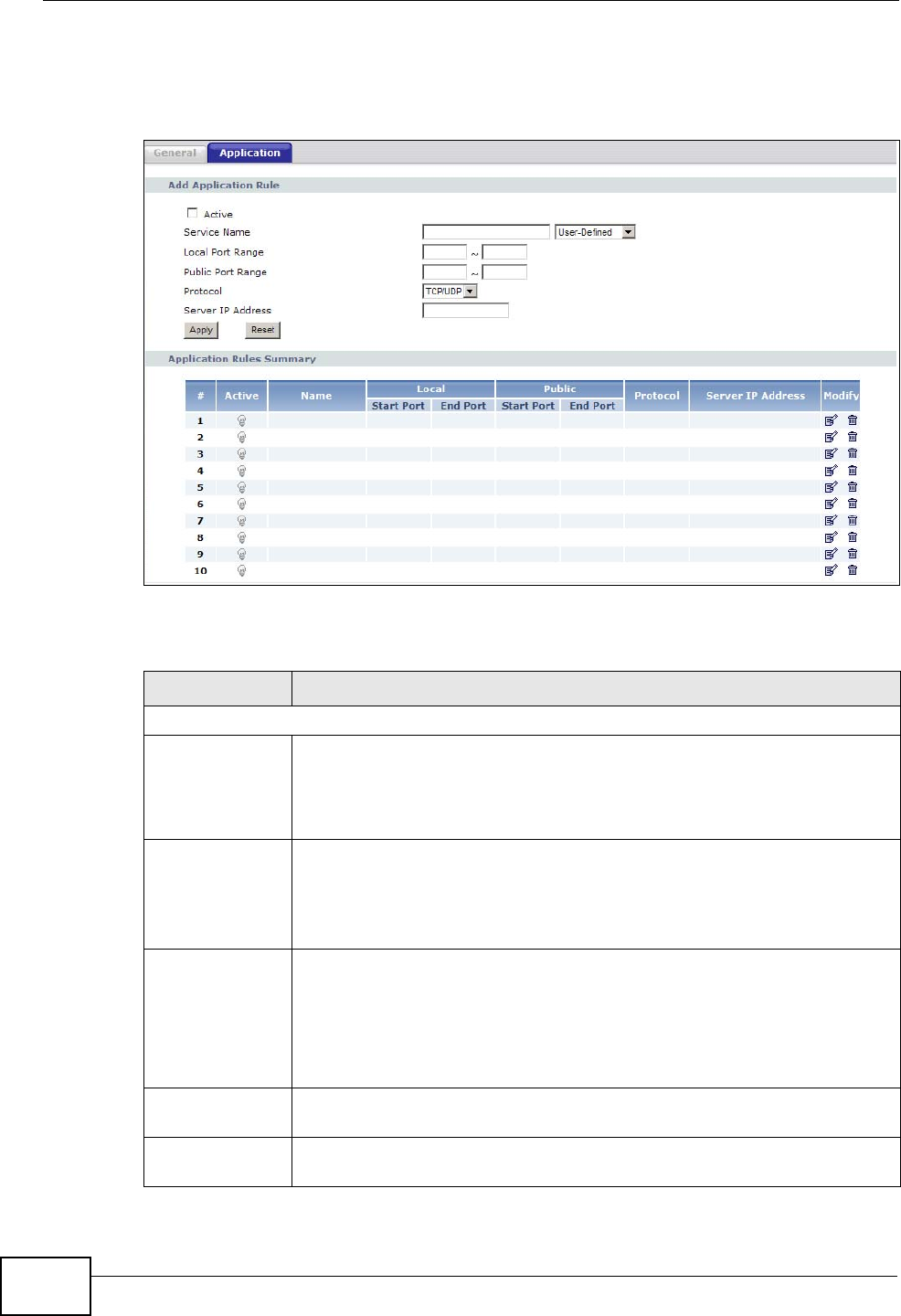
Chapter 11 Network Address Translation (NAT)
NBG-416N User’s Guide
106
Refer to Appendix E on page 205 for port numbers commonly used for particular
services.
Figure 62 Network > NAT > Application
The following table describes the labels in this screen.
Table 42 Network > NAT > Application
LABEL DESCRIPTION
Add Application Rule
Active Select the check box to enable this rule and the requested service can
be forwarded to the host with a specified internal IP address.
Clear the checkbox to disallow forwarding of these ports to an inside
server without having to delete the entry.
Service Name Type a name (of up to 31 printable characters) to identify this rule in
the first field next to Service Name. Otherwise, select a predefined
service in the second field next to Service Name. The predefined
service name and port number(s) will display in the Service Name and
Port fields.
Local Port
Range
Public Port
Range
Type a port number(s) to be forwarded.
To specify a range of ports, enter a hyphen (-) between the first port
and the last port, such as 10-20.
To specify two or more non-consecutive port numbers, separate them
by a comma without spaces, such as 123,567.
Server IP
Address Type the inside IP address of the server that receives packets from the
port(s) specified in the Port field.
Apply Click Apply to save your changes to the Application Rules Summary
table.

Chapter 11 Network Address Translation (NAT)
NBG-416N User’s Guide 107
11.5 Technical Reference
The following section contains additional technical information about the NBG-
416N features described in this chapter.
11.5.1 NAT Port Forwarding: Services and Port Numbers
A port forwarding set is a list of inside (behind NAT on the LAN) servers, for
example, web or FTP, that you can make accessible to the outside world even
though NAT makes your whole inside network appear as a single machine to the
outside world.
Use the Application screen to forward incoming service requests to the server(s)
on your local network. You may enter a single port number or a range of port
numbers to be forwarded, and the local IP address of the desired server. The port
number identifies a service; for example, web service is on port 80 and FTP on
port 21. In some cases, such as for unknown services or where one server can
support more than one service (for example both FTP and web service), it might
be better to specify a range of port numbers.
In addition to the servers for specified services, NAT supports a default server. A
service request that does not have a server explicitly designated for it is forwarded
Reset Click Reset to not save and return your new changes in the Service
Name and Port fields to the previous one.
Application Rules Summary
#This is the number of an individual port forwarding server entry.
Active This icon is turned on when the rule is enabled.
Name This field displays a name to identify this rule.
Local Start/End
Port
Public Start/End
Port
This field displays the port number(s).
Protocol This field displays the traffic protocol type.
Server IP
Address This field displays the inside IP address of the server.
Modify Click the Edit icon to display and modify an existing rule setting in the
fields under Add Application Rule.
Click the Remove icon to delete a rule.
Table 42 Network > NAT > Application (continued)
LABEL DESCRIPTION

Chapter 11 Network Address Translation (NAT)
NBG-416N User’s Guide
108
to the default server. If the default is not defined, the service request is simply
discarded.
Note: Many residential broadband ISP accounts do not allow you to run any server
processes (such as a Web or FTP server) from your location. Your ISP may
periodically check for servers and may suspend your account if it discovers any
active services at your location. If you are unsure, refer to your ISP.
11.5.2 NAT Port Forwarding Example
Let's say you want to assign ports 21-25 to one FTP, Telnet and SMTP server (A in
the example), port 80 to another (B in the example) and assign a default server IP
address of 192.168.1.35 to a third (C in the example). You assign the LAN IP
addresses and the ISP assigns the WAN IP address. The NAT network appears as a
single host on the Internet.
Figure 63 Multiple Servers Behind NAT Example

NBG-416N User’s Guide 109
CHAPTER 12
Firewall
12.1 Overview
Use these screens to enable and configure the firewall that protects your NBG-
416N and your LAN from unwanted or malicious traffic.
Enable the firewall to protect your LAN computers from attacks by hackers on the
Internet and control access between the LAN and WAN. By default the firewall:
• allows traffic that originates from your LAN computers to go to all of the
networks.
• blocks traffic that originates on the other networks from going to the LAN.
The following figure illustrates the default firewall action. User A can initiate an IM
(Instant Messaging) session from the LAN to the WAN (1). Return traffic for this
session is also allowed (2). However other traffic initiated from the WAN is blocked
(3 and 4).
Figure 64 Default Firewall Action
12.2 What You Can Do
•Use the General screen to enable or disable the NBG-416N’s firewall (Section
12.4 on page 111).

Chapter 12 Firewall
NBG-416N User’s Guide
110
•Use the Services screen to enable or disable ICMP and VPN passthrough
features (Section 12.5 on page 111).
12.3 What You Need To Know
The NBG-416N’s firewall feature physically separates the LAN and the WAN and
acts as a secure gateway for all data passing between the networks.
12.3.1 About the NBG-416N Firewall
The NBG-416N firewall is a stateful inspection firewall and is designed to protect
against Denial of Service attacks when activated (click the General tab under
Firewall and then click the Enable Firewall check box). The NBG-416N's
purpose is to allow a private Local Area Network (LAN) to be securely connected to
the Internet. The NBG-416N can be used to prevent theft, destruction and
modification of data, as well as log events, which may be important to the security
of your network.
The NBG-416N is installed between the LAN and a broadband modem connecting
to the Internet. This allows it to act as a secure gateway for all data passing
between the Internet and the LAN.
The NBG-416N has one Ethernet WAN port and four Ethernet LAN ports, which are
used to physically separate the network into two areas.The WAN (Wide Area
Network) port attaches to the broadband (cable or DSL) modem to the Internet.
The LAN (Local Area Network) port attaches to a network of computers, which
needs security from the outside world. These computers will have access to
Internet services such as e-mail, FTP and the World Wide Web. However, "inbound
access" is not allowed (by default) unless the remote host is authorized to use a
specific service.
12.3.2 VPN Pass Through Features
A Virtual Private Network (VPN) is a way to securely connect two networks over
the Internet. For example a home network and one in a business office. This
requires special equipment on both ends of the connection.
The NBG-416N is not one of the endpoints but it does allow traffic from those
endpoints to pass through. The NBG-416N allows the following types of VPN traffic
to pass through:
• IP security (IPSec)
• Point-to-Point Tunneling Protocol (PPTP)

Chapter 12 Firewall
NBG-416N User’s Guide 111
12.4 General Firewall Screen
Use this screen to enable or disable the NBG-416N’s firewall, and set up firewall
logs. Click Security > Firewall to open the General screen.
Figure 65 Security > Firewall > General
The following table describes the labels in this screen.
12.5 Services Screen
Use the Services screen to enable or disable ICMP and VPN passthrough features.
Click Security > Firewall > Services. The screen appears as shown next.
Figure 66 Security > Firewall > Services
Table 43 Security > Firewall > General
LABEL DESCRIPTION
Enable Firewall Select this check box to activate the firewall. The NBG-416N performs
access control and protects against Denial of Service (DoS) attacks
when the firewall is activated.
Apply Click Apply to save the settings.
Reset Click Reset to start configuring this screen again.

Chapter 12 Firewall
NBG-416N User’s Guide
112
The following table describes the labels in this screen.
Table 44 Security > Firewall > Services
LABEL DESCRIPTION
ICMP Internet Control Message Protocol is a message control and error-
reporting protocol between a host server and a gateway to the Internet.
ICMP uses Internet Protocol (IP) datagrams, but the messages are
processed by the TCP/IP software and directly apparent to the
application user.
Respond to Ping
on WAN The NBG-416N will not respond to any incoming Ping requests when
Disable is selected. Select Enable to reply to incoming WAN Ping
requests.
VPN
Passthrough Select the checkbox to enable the advanced pass through features:
•PPTP Passthrough: Select this option to allow the NBG-416N to
pass through VPN traffic using PPTP.
•L2TP Passthrough: Select this option to enable computers on your
LAN to make L2TP VPN connections to servers on the Internet.
•IPSEC Passthrough: Select this option to allow the NBG-416N to
pass through VPN traffic using the IPsec protocol.
Apply Click Apply to save the settings.
Reset Click Reset to start configuring this screen again.

NBG-416N User’s Guide 113
CHAPTER 13
Remote Management
13.1 Overview
This chapter provides information on the Remote Management screens.
Remote management allows you to determine which services/protocols can access
which NBG-416N interface (if any) from which computers.
You may manage your NBG-416N from a remote location via:
Note: When you configure remote management to allow management from the LAN
and WAN in the options above, you still need to configure a firewall rule to allow
access. See the firewall chapters for details on configuring firewall rules.
13.2 What You Need To Know
•LAN only •LAN and WAN

Chapter 13 Remote Management
NBG-416N User’s Guide
114
13.2.1 Remote Management Limitations
Remote management over LAN or WAN will not work when:
1You have disabled that service in one of the remote management screens.
2The IP address in the Secured Client IP Address field does not match the client
IP address. If it does not match, the NBG-416N will disconnect the session
immediately.
3There is already another remote management session with an equal or higher
priority running. You may only have one remote management session running at
one time.
4There is a firewall rule that blocks it.
13.2.2 Remote Management and NAT
When NAT is enabled:
• Use the NBG-416N’s WAN IP address when configuring from the WAN.
• Use the NBG-416N’s LAN IP address when configuring from the LAN.
13.2.3 System Timeout
There is a default system management idle timeout of five minutes (three
hundred seconds). The NBG-416N automatically logs you out if the management
session remains idle for longer than this timeout period. The management session
does not time out when a statistics screen is polling. You can change the timeout
period in the System screen.

Chapter 13 Remote Management
NBG-416N User’s Guide 115
13.3 WWW Screen
To change your NBG-416N’s World Wide Web settings, click Management >
Remote MGMT to display the WWW screen.
Figure 67 Management > Remote MGMT > WWW
The following table describes the labels in this screen.
Table 45 Management > Remote MGMT > WWW
LABEL DESCRIPTION
Server Port You may change the server port number for a service if needed,
however you must use the same port number in order to use that
service for remote management.
Server Access Select the interface(s) through which a computer may access the
NBG-416N using this service.
Secured Client IP
Address A secured client is a “trusted” computer that is allowed to
communicate with the NBG-416N using this service.
Select All to allow any computer to access the NBG-416N using
this service.
Choose Selected to just allow the computer with the IP address
that you specify to access the NBG-416N using this service.
Note: This only applies on WAN IP.
Apply Click Apply to save your customized settings and exit this screen.
Reset Click Reset to begin configuring this screen afresh.

Chapter 13 Remote Management
NBG-416N User’s Guide
116

NBG-416N User’s Guide 117
CHAPTER 14
Universal Plug-and-Play (UPnP)
14.1 Overview
This chapter introduces the UPnP feature in the Web Configurator.
Universal Plug and Play (UPnP) is a distributed, open networking standard that
uses TCP/IP for simple peer-to-peer network connectivity between devices. A
UPnP device can dynamically join a network, obtain an IP address, convey its
capabilities and learn about other devices on the network. In turn, a device can
leave a network smoothly and automatically when it is no longer in use.
14.2 What You Need to Know
How do I know if I'm using UPnP?
UPnP hardware is identified as an icon in the Network Connections folder
(Windows XP). Each UPnP compatible device installed on your network will appear
as a separate icon. Selecting the icon of a UPnP device will allow you to access the
information and properties of that device.
NAT Traversal
UPnP NAT traversal automates the process of allowing an application to operate
through NAT. UPnP network devices can automatically configure network
addressing, announce their presence in the network to other UPnP devices and
enable exchange of simple product and service descriptions. NAT traversal allows
the following:
• Dynamic port mapping
• Learning public IP addresses
• Assigning lease times to mappings
Windows Messenger is an example of an application that supports NAT traversal
and UPnP.

Chapter 14 Universal Plug-and-Play (UPnP)
NBG-416N User’s Guide
118
See the NAT chapter for more information on NAT.
Cautions with UPnP
The automated nature of NAT traversal applications in establishing their own
services and opening firewall ports may present network security issues. Network
information and configuration may also be obtained and modified by users in some
network environments.
When a UPnP device joins a network, it announces its presence with a multicast
message. For security reasons, the NBG-416N allows multicast messages on the
LAN only.
All UPnP-enabled devices may communicate freely with each other without
additional configuration. Disable UPnP if this is not your intention.
14.3 UPnP Screen
Use this screen to enable UPnP. Click the Management > UPnP to open the
following screen.
Figure 68 Management > UPnP > General

Chapter 14 Universal Plug-and-Play (UPnP)
NBG-416N User’s Guide 119
The following table describes the labels in this screen.
14.4 Technical Reference
The sections show examples of using UPnP.
14.4.1 Using UPnP in Windows XP Example
This section shows you how to use the UPnP feature in Windows XP. You must
already have UPnP installed in Windows XP and UPnP activated on the NBG-416N.
Make sure the computer is connected to a LAN port of the NBG-416N. Turn on
your computer and the NBG-416N.
14.4.1.1 Auto-discover Your UPnP-enabled Network Device
1Click start and Control Panel. Double-click Network Connections. An icon
displays under Internet Gateway.
Table 46 Management > UPnP > General
LABEL DESCRIPTION
Enable the Universal Plug
and Play (UPnP) Feature Select this check box to activate UPnP. Be aware that anyone
could use a UPnP application to open the Web Configurator's
login screen without entering the NBG-416N's IP address
(although you must still enter the password to access the Web
Configurator).
Allow users to make port
forwarding changes
through UPnP
Select this check box to allow UPnP-enabled applications to
automatically configure the NBG-416N so that they can
communicate through the NBG-416N, for example by using
NAT traversal, UPnP applications automatically reserve a NAT
forwarding port in order to communicate with another UPnP
enabled device; this eliminates the need to manually configure
port forwarding for the UPnP enabled application.
Apply Click Apply to save the setting to the NBG-416N.
Reset Click Reset to begin configuring this screen afresh.

Chapter 14 Universal Plug-and-Play (UPnP)
NBG-416N User’s Guide
120
2Right-click the icon and select Properties.
Figure 69 Network Connections
3In the Internet Connection Properties window, click Settings to see the port
mappings there were automatically created.
Figure 70 Internet Connection Properties

Chapter 14 Universal Plug-and-Play (UPnP)
NBG-416N User’s Guide 121
4You may edit or delete the port mappings or click Add to manually add port
mappings.
Figure 71 Internet Connection Properties: Advanced Settings
Figure 72 Internet Connection Properties: Advanced Settings: Add
Note: When the UPnP-enabled device is disconnected from your computer, all port
mappings will be deleted automatically.
5Select Show icon in notification area when connected option and click OK.
An icon displays in the system tray.
Figure 73 System Tray Icon

Chapter 14 Universal Plug-and-Play (UPnP)
NBG-416N User’s Guide
122
6Double-click on the icon to display your current Internet connection status.
Figure 74 Internet Connection Status
14.4.2 Web Configurator Easy Access
With UPnP, you can access the web-based configurator on the NBG-416N without
finding out the IP address of the NBG-416N first. This comes helpful if you do not
know the IP address of the NBG-416N.
Follow the steps below to access the Web Configurator.
1Click Start and then Control Panel.
2Double-click Network Connections.

Chapter 14 Universal Plug-and-Play (UPnP)
NBG-416N User’s Guide 123
3Select My Network Places under Other Places.
Figure 75 Network Connections
4An icon with the description for each UPnP-enabled device displays under Local
Network.
5Right-click on the icon for your NBG-416N and select Invoke. The Web
Configurator login screen displays.
Figure 76 Network Connections: My Network Places

Chapter 14 Universal Plug-and-Play (UPnP)
NBG-416N User’s Guide
124

NBG-416N User’s Guide 125
CHAPTER 15
System
15.1 Overview
This chapter provides information on the System screens.
See the chapter about wizard setup for more information on the next few screens.
15.2 What You Can Do
•Use the General screen to enter a name to identify the NBG-416N in the
network and set the password (Section 15.3 on page 125).
•Use the Time Setting screen to change your NBG-416N’s time and date
(Section 15.4 on page 127).
15.3 System General Screen
Use this screen to enter a name to identify the NBG-416N in the network and set
the password. Click Maintenance > System. The following screen displays.
Figure 77 Maintenance > System > General
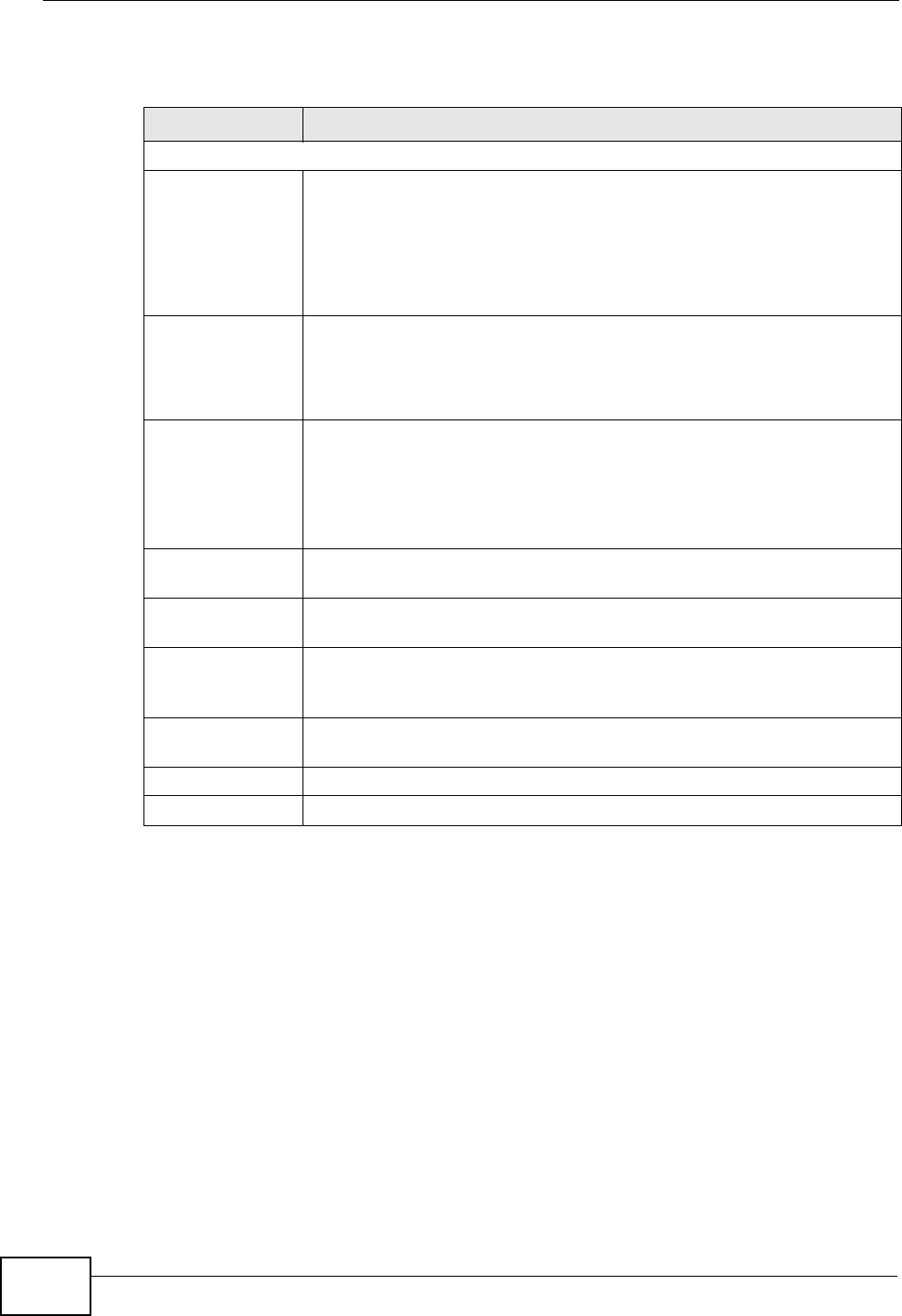
Chapter 15 System
NBG-416N User’s Guide
126
The following table describes the labels in this screen.
Table 47 Maintenance > System > General
LABEL DESCRIPTION
System Setup
System Name System Name is a unique name to identify the NBG-416N in an
Ethernet network. It is recommended you enter your computer’s
“Computer name” in this field (see the chapter about wizard setup for
how to find your computer’s name).
This name can be up to 30 alphanumeric characters long. Spaces are
not allowed, but dashes “-” and underscores "_" are accepted.
Domain Name Enter the domain name (if you know it) here. If you leave this field
blank, the ISP may assign a domain name via DHCP.
The domain name entered by you is given priority over the ISP
assigned domain name.
Administrator
Inactivity Timer Type how many minutes a management session can be left idle before
the session times out. The default is 5 minutes. After it times out you
have to log in with your password again. Very long idle timeouts may
have security risks. A value of "0" means a management session never
times out, no matter how long it has been left idle (not
recommended).
Password Setup Change your NBG-416N’s password (recommended) using the fields as
shown.
Old Password Type the default password or the existing password you use to access
the system in this field.
New Password Type your new system password (up to 30 characters). Note that as
you type a password, the screen displays an asterisk (*) for each
character you type.
Retype to
Confirm Type the new password again in this field.
Apply Click Apply to save your changes back to the NBG-416N.
Reset Click Reset to begin configuring this screen afresh.

Chapter 15 System
NBG-416N User’s Guide 127
15.4 Time Setting Screen
To change your NBG-416N’s time and date, click Maintenance > System > Time
Setting. The screen appears as shown. Use this screen to configure the NBG-
416N’s time based on your local time zone.
Figure 78 Maintenance > System > Time Setting
The following table describes the labels in this screen.
Table 48 Maintenance > System > Time Setting
LABEL DESCRIPTION
Current Time and Date
Current Time This field displays the time of your NBG-416N.
Each time you reload this page, the NBG-416N synchronizes the time
with the time server.
Current Date This field displays the date of your NBG-416N.
Each time you reload this page, the NBG-416N synchronizes the date
with the time server.
Time and Date Setup
Manual Select this radio button to enter the time and date manually. If you
configure a new time and date, Time Zone and Daylight Saving at the
same time, the new time and date you entered has priority and the
Time Zone and Daylight Saving settings do not affect it.
Copy Your
Computer’s Time
Settings
Click this to copy the time settings of your computer into the NBG-
416N’s time and date setup.

Chapter 15 System
NBG-416N User’s Guide
128
New Time
(hh:mm:ss)
This field displays the last updated time from the time server or the
last time configured manually.
When you set Time and Date Setup to Manual, enter the new time
in this field and then click Apply.
New Date
(yyyy/mm/dd)
This field displays the last updated date from the time server or the
last date configured manually.
When you set Time and Date Setup to Manual, enter the new date
in this field and then click Apply.
Get from Time
Server Select this radio button to have the NBG-416N get the time and date
from the time server you specified below.
Auto Select Auto to have the NBG-416N automatically search for an
available time server and synchronize the date and time with the time
server after you click Apply.
User Defined
Time Server
Address
Select User Defined Time Server Address and enter the IP
address or URL (up to 20 extended ASCII characters in length) of
your time server. Check with your ISP/network administrator if you
are unsure of this information.
Time Zone Setup
Time Zone Choose the time zone of your location. This will set the time
difference between your time zone and Greenwich Mean Time (GMT).
Daylight Savings Daylight saving is a period from late spring to early fall when many
countries set their clocks ahead of normal local time by one hour to
give more daytime light in the evening.
Select this option if you use Daylight Saving Time.
Start Date Configure the day and time when Daylight Saving Time starts if you
selected Daylight Savings. The o'clock field uses the 24 hour
format. Here are a couple of examples:
Daylight Saving Time starts in most parts of the United States on the
first Sunday of April. Each time zone in the United States starts using
Daylight Saving Time at 2 A.M. local time. So in the United States you
would select First, Sunday, April and type 2 in the o'clock field.
Daylight Saving Time starts in the European Union on the last Sunday
of March. All of the time zones in the European Union start using
Daylight Saving Time at the same moment (1 A.M. GMT or UTC). So
in the European Union you would select Last, Sunday, March. The
time you type in the o'clock field depends on your time zone. In
Germany for instance, you would type 2 because Germany's time
zone is one hour ahead of GMT or UTC (GMT+1).
Table 48 Maintenance > System > Time Setting (continued)
LABEL DESCRIPTION

Chapter 15 System
NBG-416N User’s Guide 129
End Date Configure the day and time when Daylight Saving Time ends if you
selected Daylight Savings. The o'clock field uses the 24 hour
format. Here are a couple of examples:
Daylight Saving Time ends in the United States on the last Sunday of
October. Each time zone in the United States stops using Daylight
Saving Time at 2 A.M. local time. So in the United States you would
select Last, Sunday, October and type 2 in the o'clock field.
Daylight Saving Time ends in the European Union on the last Sunday
of October. All of the time zones in the European Union stop using
Daylight Saving Time at the same moment (1 A.M. GMT or UTC). So
in the European Union you would select Last, Sunday, October. The
time you type in the o'clock field depends on your time zone. In
Germany for instance, you would type 2 because Germany's time
zone is one hour ahead of GMT or UTC (GMT+1).
Apply Click Apply to save your changes back to the NBG-416N.
Reset Click Reset to begin configuring this screen afresh.
Table 48 Maintenance > System > Time Setting (continued)
LABEL DESCRIPTION

Chapter 15 System
NBG-416N User’s Guide
130

NBG-416N User’s Guide 131
CHAPTER 16
Logs
16.1 Overview
This chapter contains information about configuring general log settings and
viewing the NBG-416N’s logs.
The Web Configurator allows you to look at all of the NBG-416N’s logs in one
location.
16.2 What You Need to Know
An alert is a type of log that warrants more serious attention. They include system
errors, attacks (access control) and attempted access to blocked web sites or web
sites with restricted web features such as cookies, active X and so on. Some
categories such as System Errors consist of both logs and alerts. You may
differentiate them by their color in the View Log screen. Alerts display in red and
logs display in black.
Alerts are e-mailed as soon as they happen. Logs may be e-mailed as soon as the
log is full (see Log Schedule). Selecting many alert and/or log categories
(especially Access Control) may result in many e-mails being sent.
16.3 View Log Screen
Use the View Log screen to see the logged messages for the NBG-416N. Options
include logs about system maintenance, system errors, access control, allowed or
blocked web sites, blocked web features (such as ActiveX controls, Java and
cookies), attacks (such as DoS) and IPSec.
Log entries in red indicate system error logs. The log wraps around and deletes
the old entries after it fills. Click a column heading to sort the entries. A triangle
indicates ascending or descending sort order.

Chapter 16 Logs
NBG-416N User’s Guide
132
Click Maintenance > Logs to open the View Log screen.
Figure 79 Maintenance > Logs > View Log
The following table describes the labels in this screen.
Table 49 Maintenance > Logs > View Log
LABEL DESCRIPTION
Refresh Click Refresh to renew the log screen.
Clear Logs Click Clear Logs to delete all the logs.
Next Click Next to show the next page of log entries.
Last Click Last to show the last page of log entries.
#This is the index number of the log entry.
Time This field displays the time the log was recorded. See the chapter on
system maintenance and information to configure the NBG-416N’s
time and date.
Message This field states the reason for the log.

NBG-416N User’s Guide 133
CHAPTER 17
Tools
17.1 Overview
This chapter shows you how to upload a new firmware, upload or save backup
configuration files and restart the NBG-416N.
17.2 What You Can Do
•Use the Firmware screen to upload firmware to your NBG-416N (Section 17.3
on page 133).
•Use the Configuration screen to view information related to factory defaults,
backup configuration, and restoring configuration (Section 17.4 on page 136).
•Use the Restart screen to have the NBG-416N reboot (Section 17.5 on page
138).
17.3 Firmware Upload Screen
Find firmware at www.zyxel.com in a file that (usually) uses the system model
name with a “*.bin” extension, e.g., “NBG-416N.bin”. The upload process uses
HTTP (Hypertext Transfer Protocol) and may take up to two minutes. After a
successful upload, the system will reboot.
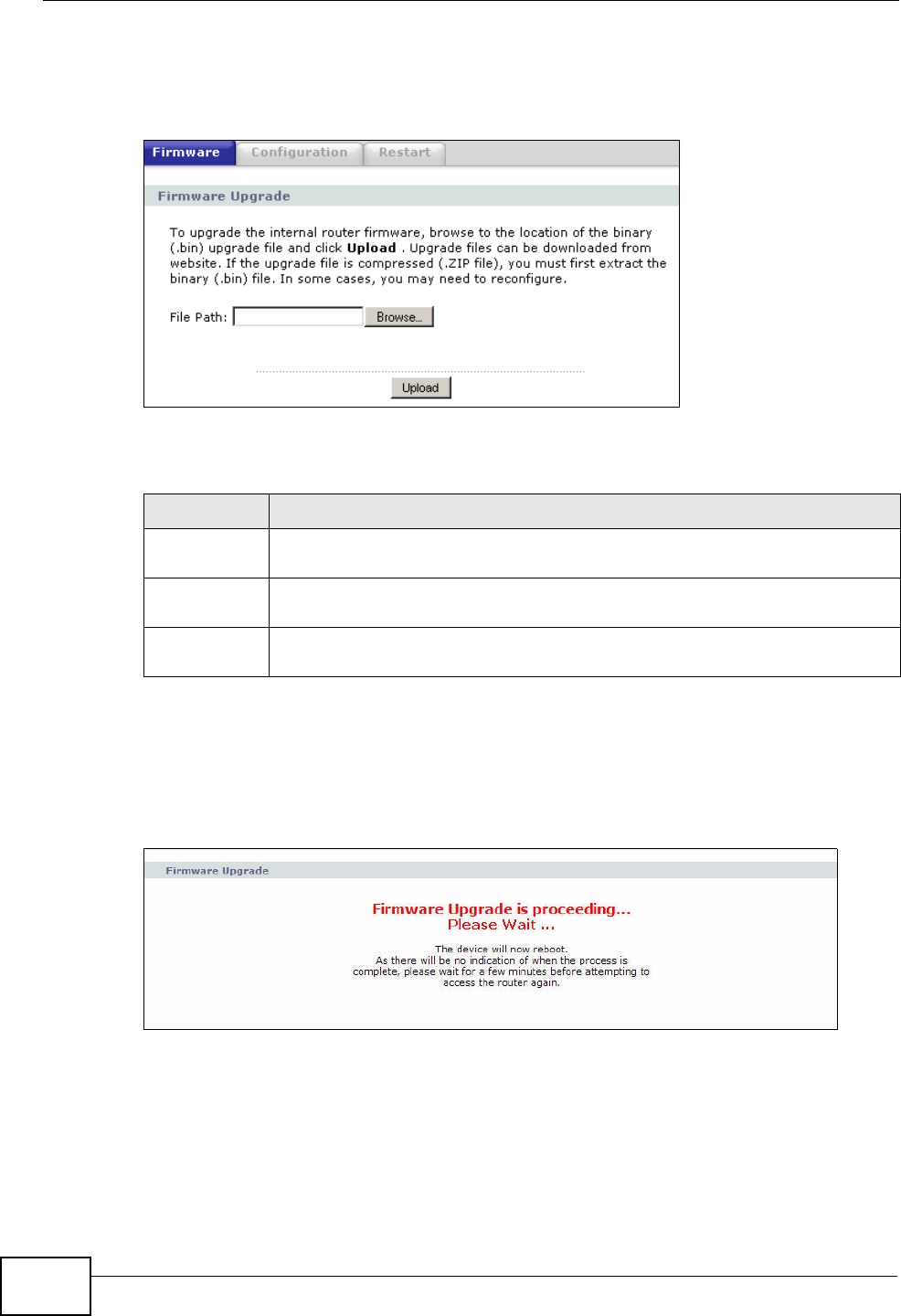
Chapter 17 Tools
NBG-416N User’s Guide
134
Click Maintenance > Tools. Follow the instructions in this screen to upload
firmware to your NBG-416N.
Figure 80 Maintenance > Tools > Firmware
The following table describes the labels in this screen.
Note: Do not turn off the NBG-416N while firmware upload is in progress!
After you see the Firmware Upload In Process screen, wait for several minutes
before logging into the NBG-416N again.
Figure 81 Upload Warning
Table 50 Maintenance > Tools > Firmware
LABEL DESCRIPTION
File Path Type in the location of the file you want to upload in this field or click
Browse... to find it.
Browse... Click Browse... to find the .bin file you want to upload. Remember that
you must decompress compressed (.zip) files before you can upload them.
Upload Click Upload to begin the upload process. This process may take up to
two minutes.

Chapter 17 Tools
NBG-416N User’s Guide 135
The NBG-416N automatically restarts in this time causing a temporary network
disconnect. In some operating systems, you may see the following icon on your
desktop.
Figure 82 Network Temporarily Disconnected
After two minutes, log in again and check your new firmware version in the
Status screen.
If the upload was not successful, the following screen will appear. Click Return to
go back to the Firmware screen.
Figure 83 Upload Error Message
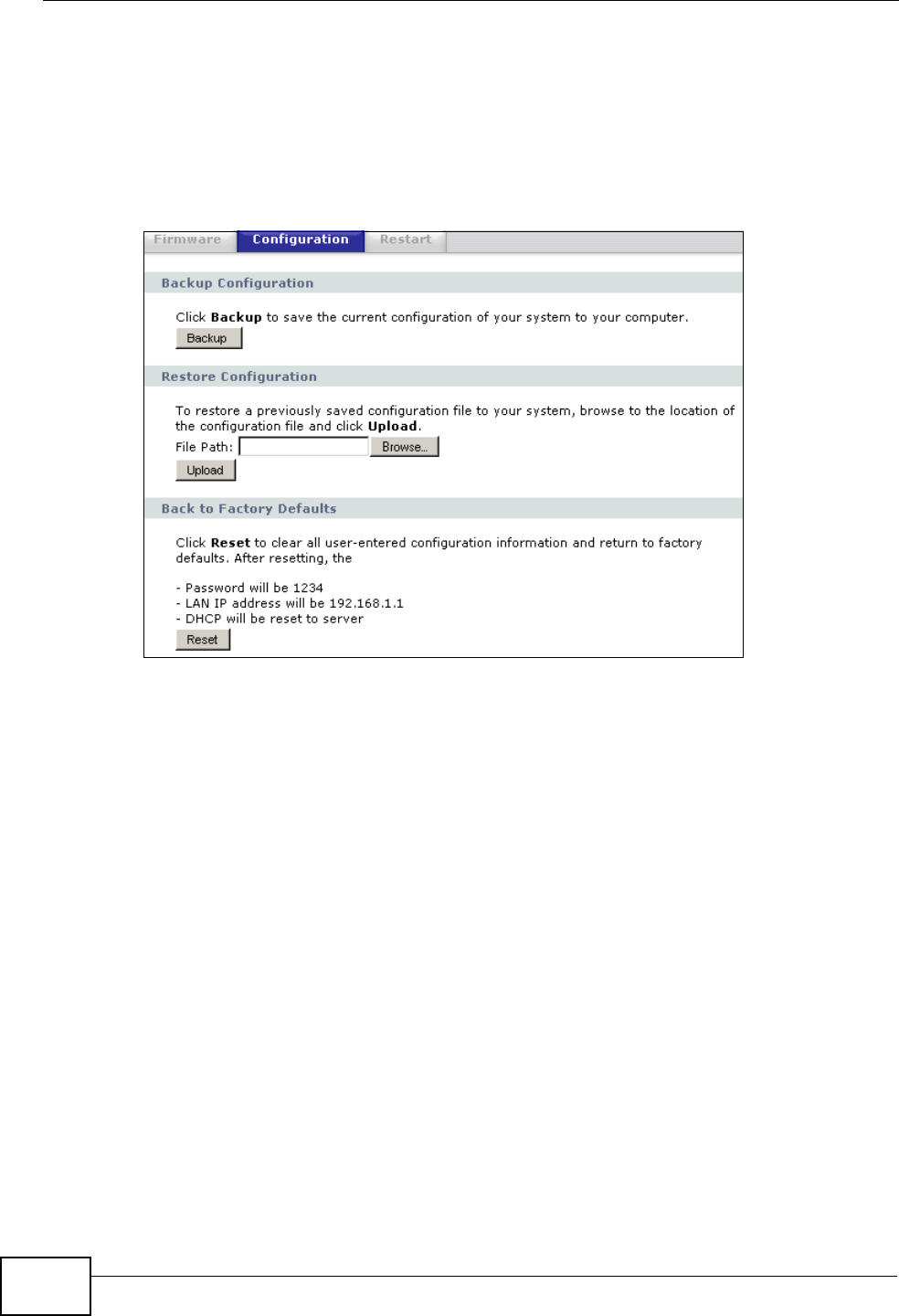
Chapter 17 Tools
NBG-416N User’s Guide
136
17.4 Configuration Screen
Click Maintenance > Tools > Configuration. Information related to factory
defaults, backup configuration, and restoring configuration appears as shown
next.
Figure 84 Maintenance > Tools > Configuration
17.4.1 Backup Configuration
Backup configuration allows you to back up (save) the NBG-416N’s current
configuration to a file on your computer. Once your NBG-416N is configured and
functioning properly, it is highly recommended that you back up your configuration
file before making configuration changes. The backup configuration file will be
useful in case you need to return to your previous settings.
Click Backup to save the NBG-416N’s current configuration to your computer.
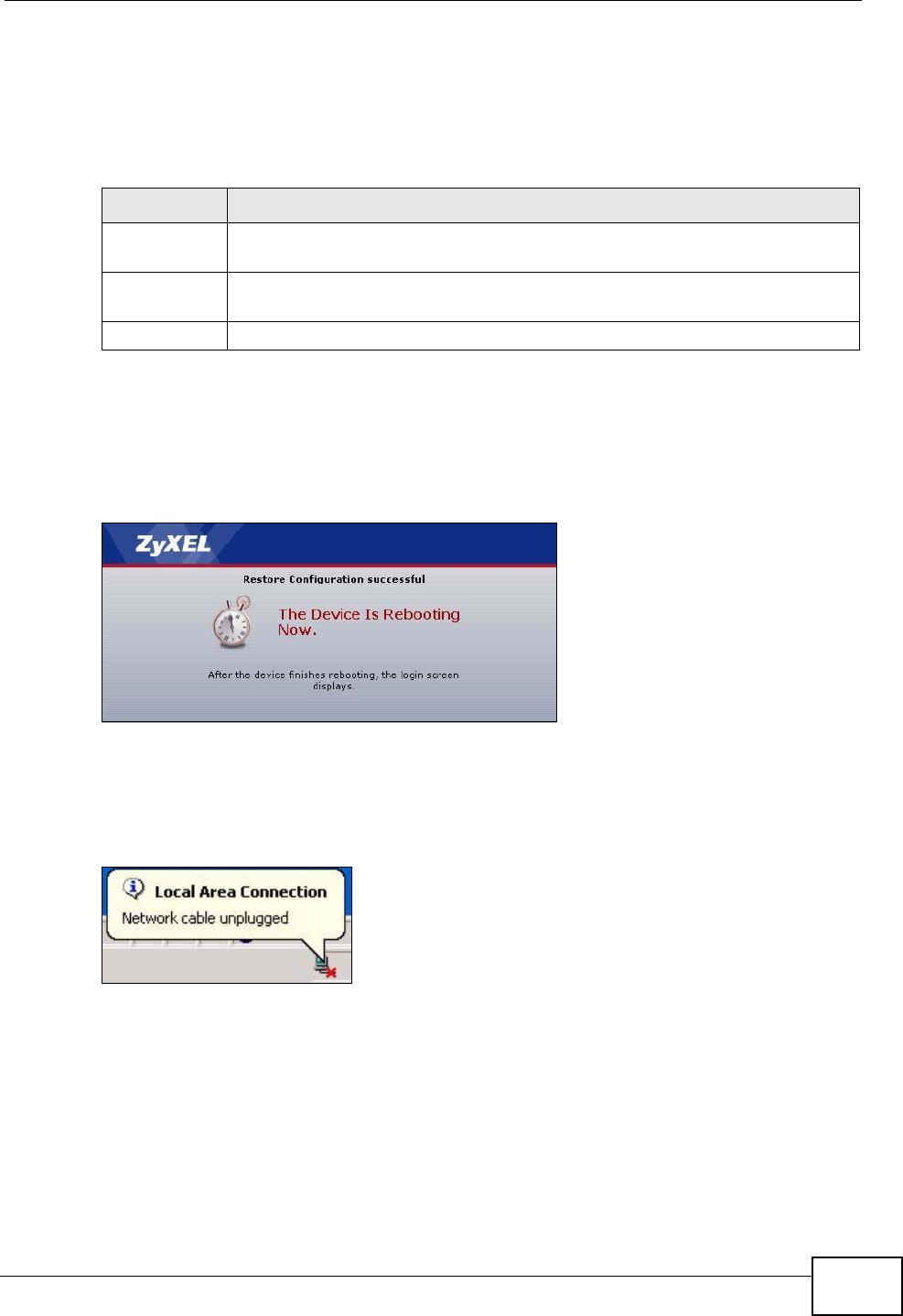
Chapter 17 Tools
NBG-416N User’s Guide 137
17.4.2 Restore Configuration
Restore configuration allows you to upload a new or previously saved
configuration file from your computer to your NBG-416N.
Note: Do not turn off the NBG-416N while configuration file upload is in progress.
After you see a “configuration upload successful” screen, you must then wait one
minute before logging into the NBG-416N again.
Figure 85 Configuration Restore Successful
The NBG-416N automatically restarts in this time causing a temporary network
disconnect. In some operating systems, you may see the following icon on your
desktop.
Figure 86 Temporarily Disconnected
If you uploaded the default configuration file you may need to change the IP
address of your computer to be in the same subnet as that of the default NBG-
416N IP address (192.168.1.1). See Appendix C on page 175 for details on how to
set up your computer’s IP address.
Table 51 Maintenance Restore Configuration
LABEL DESCRIPTION
File Path Type in the location of the file you want to upload in this field or click
Browse... to find it.
Browse... Click Browse... to find the file you want to upload. Remember that you
must decompress compressed (.ZIP) files before you can upload them.
Upload Click Upload to begin the upload process.

Chapter 17 Tools
NBG-416N User’s Guide
138
If the upload was not successful, the following screen will appear. Click Return to
go back to the Configuration screen.
Figure 87 Configuration Restore Error
17.4.3 Back to Factory Defaults
Pressing the Reset button in this section clears all user-entered configuration
information and returns the NBG-416N to its factory defaults.
You can also press the RESET button on the rear panel to reset the factory
defaults of your NBG-416N. Refer to Section 3.3.1 on page 27 for more
information on the RESET button.
17.5 Restart Screen
System restart allows you to reboot the NBG-416N without turning the power off.
Click Maintenance > Tools > Restart. Click Restart to have the NBG-416N
reboot. This does not affect the NBG-416N's configuration.
Figure 88 Maintenance > Tools > Restart
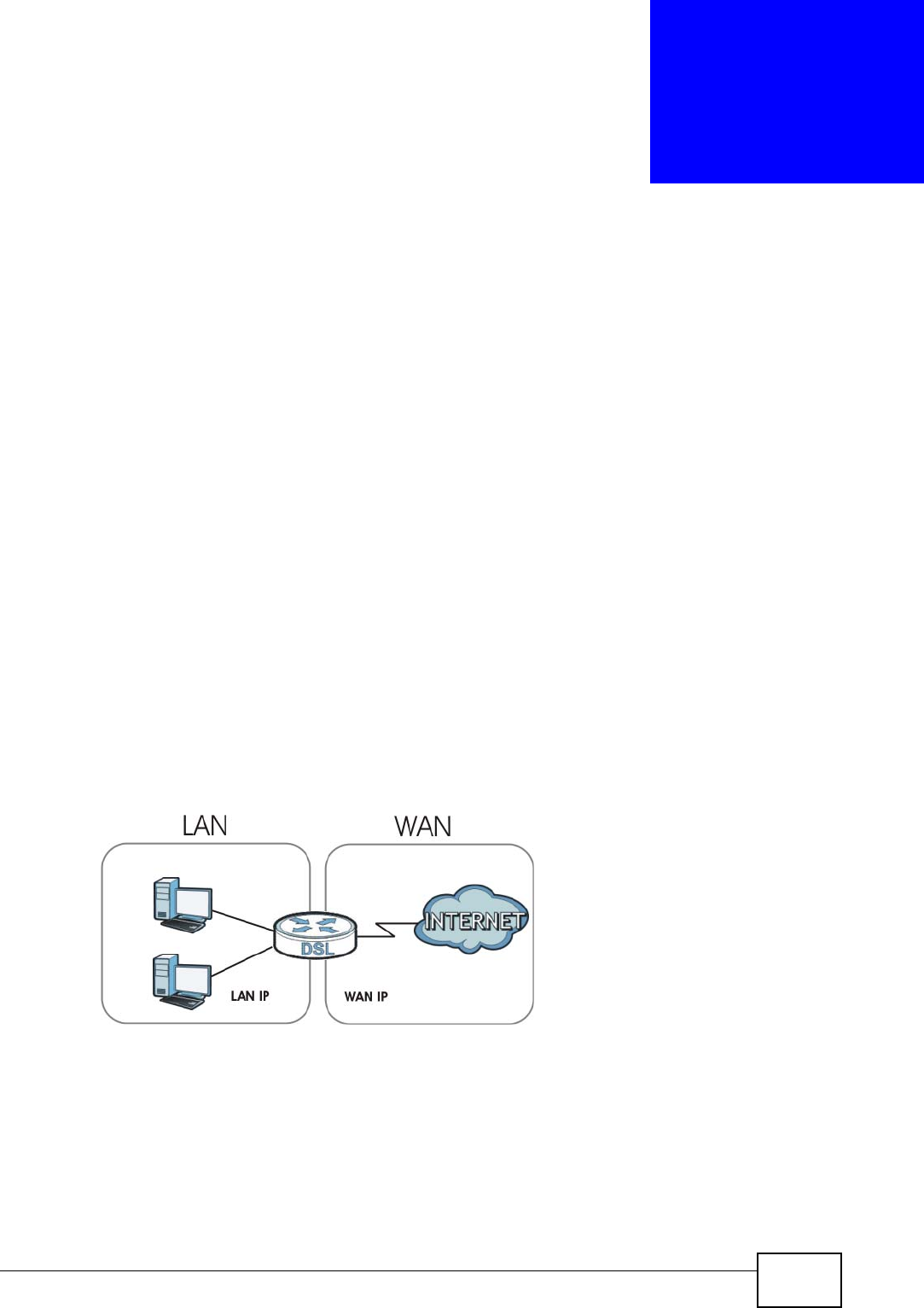
NBG-416N User’s Guide 139
CHAPTER 18
Sys OP Mode
18.1 Overview
The Sys OP Mode (System Operation Mode) function lets you configure whether
your NBG-416N is a router or AP.
You can choose between Router Mode and AP Mode depending on your network
topology and the features you require from your device. See Section 1.1 on page
19 for more information on which mode to choose.
18.2 What You Need to Know
Router
A router connects your local network with another network, such as the Internet.
The router has two IP addresses, the LAN IP address and the WAN IP address.
Figure 89 LAN and WAN IP Addresses in Router Mode

Chapter 18 Sys OP Mode
NBG-416N User’s Guide
140
AP
An AP extends one network and so has just one IP address. All Ethernet ports on
the AP have the same IP address. To connect to the Internet, another device, such
as a router, is required.
Figure 90 IP Address in AP Mode
18.3 General Screen
Use this screen to select how you connect to the Internet.
Figure 91 Maintenance > Sys OP Mode > General
If you select Router mode, the following pop-up message window appears.
Figure 92 Maintenance > Sys Op Mode > General: Router
• In this mode there are both LAN and WAN ports. The LAN Ethernet and WAN
Ethernet ports have different IP addresses.
• The DHCP server on your device is enabled and allocates IP addresses to other
devices on your local network.
• The LAN IP address of the device on the local network is set to 192.168.1.1.

Chapter 18 Sys OP Mode
NBG-416N User’s Guide 141
• You can configure the IP address settings on your WAN port. Contact your ISP or
system administrator for more information on appropriate settings.
If you select Access Point the following pop-up message window appears.
Figure 93 Maintenance > Sys Op Mode > General: AP
•In AP Mode all Ethernet ports have the same IP address.
• All ports on the rear panel of the device are LAN ports, including the port labeled
WAN. There is no WAN port.
• The DHCP server on your device is disabled. In AP mode there must be a device
with a DHCP server on your network such as a router or gateway which can
allocate IP addresses.
The IP address of the device on the local network is set to 192.168.1.2.
The following table describes the labels in the General screen.
Note: If you select the incorrect System Operation Mode, you cannot connect to the
Internet.
Table 52 Maintenance > Sys Op Mode > General
LABEL DESCRIPTION
System Operation Mode
Router Select Router if your device routes traffic between a local
network and another network such as the Internet. This mode
offers services such as a firewall or content filter.
Access Point Select Access Point if your device bridges traffic between clients
on the same network.
Apply Click Apply to save your settings.
Reset Click Reset to return your settings to the default (Router).

Chapter 18 Sys OP Mode
NBG-416N User’s Guide
142

NBG-416N User’s Guide 143
CHAPTER 19
Language
19.1 Language Screen
Use this screen to change the language for the Web Configurator display.
Click the language you prefer. The Web Configurator language changes after a
while without restarting the NBG-416N.
Figure 94 Language

Chapter 19 Language
NBG-416N User’s Guide
144

NBG-416N User’s Guide 145
CHAPTER 20
Troubleshooting
This chapter offers some suggestions to solve problems you might encounter. The
potential problems are divided into the following categories.
•Power, Hardware Connections, and LEDs
•NBG-416N Access and Login
•Internet Access
•Resetting the NBG-416N to Its Factory Defaults
•Wireless Router/AP Troubleshooting
20.1 Power, Hardware Connections, and LEDs
The NBG-416N does not turn on. None of the LEDs turn on.
1Make sure you are using the power adaptor or cord included with the NBG-416N.
2Make sure the power adaptor or cord is connected to the NBG-416N and plugged
in to an appropriate power source. Make sure the power source is turned on.
3Disconnect and re-connect the power adaptor or cord to the NBG-416N.
4If the problem continues, contact the vendor.
One of the LEDs does not behave as expected.
1Make sure you understand the normal behavior of the LED. See Section 1.5 on
page 20.
2Check the hardware connections. See the Quick Start Guide.

Chapter 20 Troubleshooting
NBG-416N User’s Guide
146
3Inspect your cables for damage. Contact the vendor to replace any damaged
cables.
4Disconnect and re-connect the power adaptor to the NBG-416N.
5If the problem continues, contact the vendor.
20.2 NBG-416N Access and Login
I don’t know the IP address of my NBG-416N.
1The default IP address is 192.168.1.1.
2If you changed the IP address and have forgotten it, you might get the IP address
of the NBG-416N by looking up the IP address of the default gateway for your
computer. To do this in most Windows computers, click Start > Run, enter cmd,
and then enter ipconfig. The IP address of the Default Gateway might be the IP
address of the NBG-416N (it depends on the network), so enter this IP address in
your Internet browser.Set your device to Router Mode, login (see the Quick Start
Guide for instructions) and go to the Device Information table in the Status
screen. Your NBG-416N’s IP address is available in the Device Information
table.
•If the DHCP setting under LAN information is None, your device has a fixed
IP address.
•If the DHCP setting under LAN information is Client, then your device
receives an IP address from a DHCP server on the network.
3If your NBG-416N is a DHCP client, you can find your IP address from the DHCP
server. This information is only available from the DHCP server which allocates IP
addresses on your network. Find this information directly from the DHCP server or
contact your system administrator for more information.
4Reset your NBG-416N to change all settings back to their default. This means your
current settings are lost. See Section 20.4 on page 149 in the Troubleshooting
for information on resetting your NBG-416N.
I forgot the username and password.
1The default username is admin and default password is 1234.

Chapter 20 Troubleshooting
NBG-416N User’s Guide 147
2If this does not work, you have to reset the device to its factory defaults. See
Section 20.4 on page 149.
I cannot see or access the Login screen in the Web Configurator.
1Make sure you are using the correct IP address.
• The default IP address is 192.168.1.1.
• If you changed the IP address (Section 7.3 on page 102), use the new IP
address.
• If you changed the IP address and have forgotten it, see the troubleshooting
suggestions for I don’t know the IP address of my NBG-416N.
2Check the hardware connections, and make sure the LEDs are behaving as
expected. See the Quick Start Guide.
3Make sure your Internet browser does not block pop-up windows and has
JavaScript and Java enabled. See Appendix B on page 167.
4Make sure your computer is in the same subnet as the NBG-416N. (If you know
that there are routers between your computer and the NBG-416N, skip this step.)
• If there is a DHCP server on your network, make sure your computer is using
a dynamic IP address. See Section 7.3 on page 102.
• If there is no DHCP server on your network, make sure your computer’s IP
address is in the same subnet as the NBG-416N. See Section 7.3 on page
102.
5Reset the device to its factory defaults, and try to access the NBG-416N with the
default IP address. See Section 7.3 on page 102.
6If the problem continues, contact the network administrator or vendor, or try one
of the advanced suggestions.
Advanced Suggestions
• If your computer is connected to the WAN port or is connected wirelessly, use a
computer that is connected to a LAN/ETHERNET port.
I can see the Login screen, but I cannot log in to the NBG-416N.

Chapter 20 Troubleshooting
NBG-416N User’s Guide
148
1Make sure you have entered the password correctly. The default username is
admin and default password is 1234. This field is case-sensitive, so make sure
[Caps Lock] is not on.
2This can happen when you fail to log out properly from your last session. Try
logging in again after 5 minutes.
3Disconnect and re-connect the power adaptor or cord to the NBG-416N.
4If this does not work, you have to reset the device to its factory defaults. See
Section 20.4 on page 149.
20.3 Internet Access
I cannot access the Internet.
1Check the hardware connections, and make sure the LEDs are behaving as
expected. See the Quick Start Guide.
2Make sure you entered your ISP account information correctly in the wizard. These
fields are case-sensitive, so make sure [Caps Lock] is not on.
3If you are trying to access the Internet wirelessly, make sure the wireless settings
in the wireless client are the same as the settings in the AP.
4Disconnect all the cables from your device, and follow the directions in the Quick
Start Guide again.
5Go to Maintenance > Sys OP Mode > General. Check your System Operation
Mode setting.
• Select Router if your device routes traffic between a local network and
another network such as the Internet.
• Select Access Point if your device bridges traffic between clients on the
same network.
6If the problem continues, contact your ISP.
I cannot access the Internet anymore. I had access to the Internet (with the NBG-
416N), but my Internet connection is not available anymore.

Chapter 20 Troubleshooting
NBG-416N User’s Guide 149
1Check the hardware connections, and make sure the LEDs are behaving as
expected. See the Quick Start Guide and Section 1.5 on page 20.
2Reboot the NBG-416N.
3If the problem continues, contact your ISP.
The Internet connection is slow or intermittent.
1There might be a lot of traffic on the network. Look at the LEDs, and check Section
1.5 on page 20. If the NBG-416N is sending or receiving a lot of information, try
closing some programs that use the Internet, especially peer-to-peer applications.
2Check the signal strength. If the signal strength is low, try moving the NBG-416N
closer to the AP if possible, and look around to see if there are any devices that
might be interfering with the wireless network (for example, microwaves, other
wireless networks, and so on).
3Reboot the NBG-416N.
4If the problem continues, contact the network administrator or vendor, or try one
of the advanced suggestions.
Advanced Suggestion
• Check the settings for QoS. If it is disabled, you might consider activating it.
20.4 Resetting the NBG-416N to Its Factory
Defaults
If you reset the NBG-416N, you lose all of the changes you have made. The NBG-
416N re-loads its default settings, and the username/password resets to admin/
1234. You have to make all of your changes again.
You will lose all of your changes when you push the RESET button.
To reset the NBG-416N,
1Make sure the power LED is on.

Chapter 20 Troubleshooting
NBG-416N User’s Guide
150
2Press the RESET button for longer than 1 second to restart/reboot the NBG-416N.
3Press the RESET button for longer than five seconds to set the NBG-416N back to
its factory-default configurations.
If the NBG-416N restarts automatically, wait for the NBG-416N to finish
restarting, and log in to the Web Configurator. The username is admin and
password is 1234.
If the NBG-416N does not restart automatically, disconnect and reconnect the
NBG-416N’s power. Then, follow the directions above again.
20.5 Wireless Router/AP Troubleshooting
I cannot access the NBG-416N or ping any computer from the WLAN (wireless
AP or router).
1Make sure the wireless LAN is enabled on the NBG-416N.
2Make sure the wireless adapter on the wireless station is working properly.
3Make sure the wireless adapter installed on your computer is IEEE 802.11
compatible and supports the same wireless standard as the NBG-416N.
4Make sure your computer (with a wireless adapter installed) is within the
transmission range of the NBG-416N.
5Check that both the NBG-416N and your wireless station are using the same
wireless and wireless security settings.
6Make sure traffic between the WLAN and the LAN is not blocked by the firewall on
the NBG-416N.
7Make sure you allow the NBG-416N to be remotely accessed through the WLAN
interface. Check your remote management settings.
• See Chapter 7 Wireless LAN for more information.
I can access the Web Configurator after I switched to AP mode.

Chapter 20 Troubleshooting
NBG-416N User’s Guide
152

NBG-416N User’s Guide 153
CHAPTER 21
Product Specifications
The following tables summarize the NBG-416N’s hardware and firmware features.
Table 53 Hardware Features
Dimensions (W x D x
H) 162 mm x 115 mm x 33 mm
Weight 216 g
Power Specification Input: 100 -- 240VAC, 50/60 Hz
Output: 5VDC /1A
Ethernet ports Auto-negotiating: 10 Mbps, 100 Mbps in either half-duplex or full-
duplex mode.
Auto-crossover: Use either crossover or straight-through Ethernet
cables.
4-5 Port Switch A combination of switch and router makes your NBG-416N a cost-
effective and viable network solution. You can add up to four
computers to the NBG-416N without the cost of a hub when
connecting to the Internet through the WAN port. You can add up
to five computers to the NBG-416N when you connect to the
Internet in AP mode. Add more than four computers to your LAN
by using a hub.
LEDs PWR, LAN1-4, WAN, WLAN, WPS
Reset Button The reset button is built into the rear panel. Use this button to
restore the NBG-416N to its factory default settings. Press for 1
second to restart the device. Press for 5 seconds to restore to
factory default settings.
WPS button Press the WPS on two WPS enabled devices within 120 seconds
for a security-enabled wireless connection.
Antenna The NBG-416N is equipped with a 2.4GHz detachable antenna to
provide clear radio transmission and reception on the wireless
network.
Operation
Environment Temperature: 0º C ~ 40º C / 32ºF ~ 104ºF
Humidity: 20% ~ 90%
Storage Environment Temperature: -30º C ~ 70º C / -22ºF ~ 158ºF
Humidity: 20% ~ 95%

Chapter 21 Product Specifications
NBG-416N User’s Guide
154
Table 54 Firmware Features
FEATURE DESCRIPTION
Default LAN IP Address 192.168.1.1 (router)
192.168.1.2. (AP)
Default LAN Subnet
Mask 255.255.255.0 (24 bits)
Default Username admin
Default Password 1234
DHCP Pool 192.168.1.33 to 192.168.1.64
Wireless Interface Wireless LAN
Default Wireless SSID NBG-416N
Device Management Use the Web Configurator to easily configure the rich range of
features on the NBG-416N.
Wireless Functionality Allows IEEE802.11b, IEEE802.11g, and/or IEEE 802.11n
wireless clients to connect to the NBG-416N wirelessly. Enable
wireless security ( WPA(2)-PSK) and/or MAC filtering to protect
your wireless network.
Note: The NBG-416N may be prone to RF (Radio
Frequency) interference from other 2.4 GHz devices
such as microwave ovens, wireless phones,
Bluetooth enabled devices, and other wireless LANs.
Firmware Upgrade Download new firmware (when available) from the ZyXEL web
site and use the Web Configurator to put it on the NBG-416N.
Note: Only upload firmware for your specific model!
Configuration Backup &
Restoration Make a copy of the NBG-416N’s configuration and put it back
on the NBG-416N later if you decide you want to revert back to
an earlier configuration.
Network Address
Translation (NAT) Each computer on your network must have its own unique IP
address. Use NAT to convert a single public IP address to
multiple private IP addresses for the computers on your
network.
Firewall You can configure firewall on the NBG-416N for secure Internet
access. When the firewall is on, by default, all incoming traffic
from the Internet to your network is blocked unless it is
initiated from your network. This means that probes from the
outside to your network are not allowed, but you can safely
browse the Internet and download files for example.
Remote Management This allows you to decide whether a service (HTTP or FTP traffic
for example) from a computer on a network (LAN or WAN for
example) can access the NBG-416N.
Wireless LAN Scheduler You can schedule the times the Wireless LAN is enabled/
disabled.
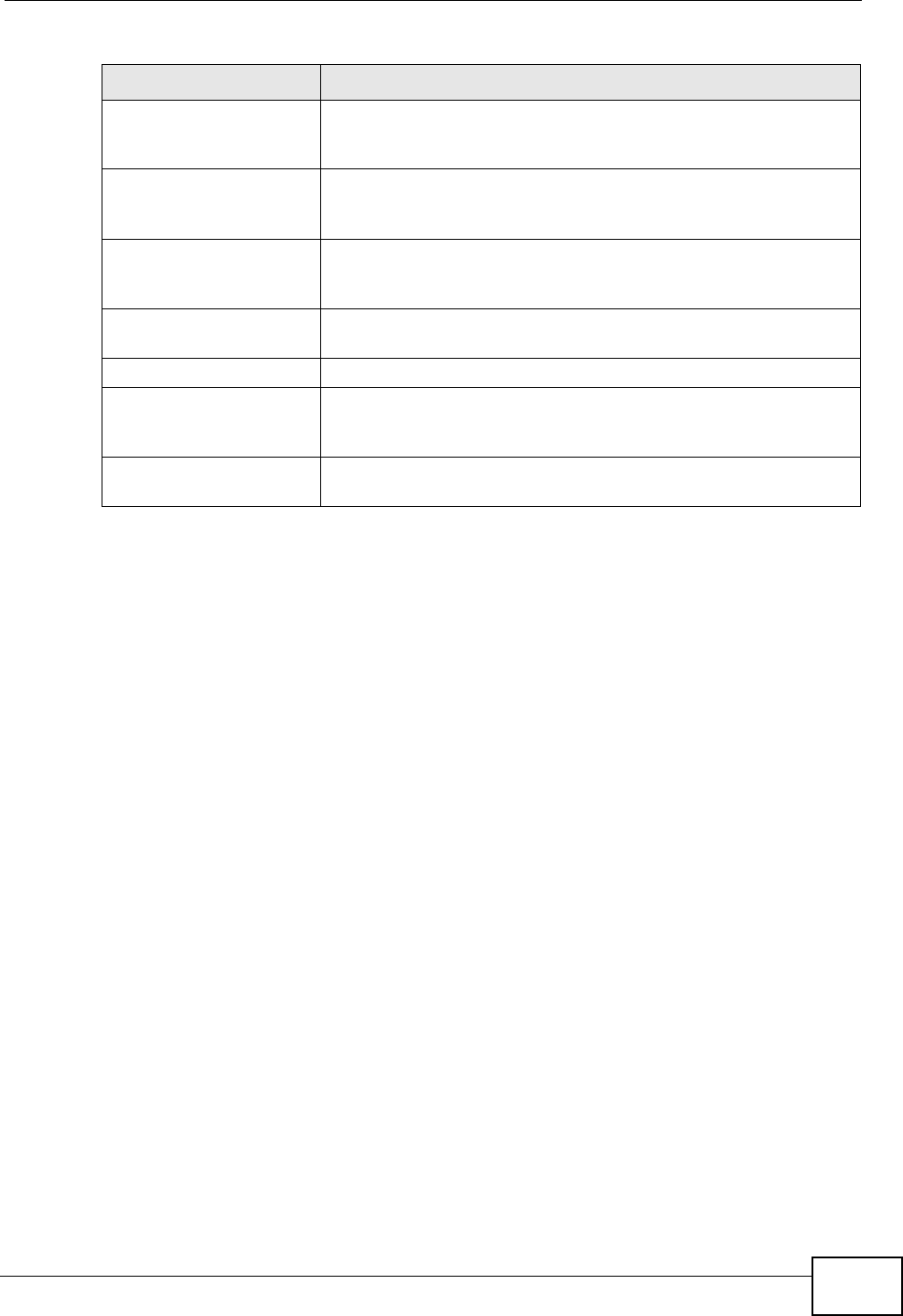
Chapter 21 Product Specifications
NBG-416N User’s Guide 155
Time and Date Get the current time and date from an external server when
you turn on your NBG-416N. You can also set the time
manually. These dates and times are then used in logs.
Port Forwarding If you have a server (mail or web server for example) on your
network, then use this feature to let people access it from the
Internet.
DHCP (Dynamic Host
Configuration Protocol) Use this feature to have the NBG-416N assign IP addresses, an
IP default gateway and DNS servers to computers on your
network.
Logging Use logs for troubleshooting. You can view logs in the Web
Configurator.
PPPoE PPPoE mimics a dial-up Internet access connection.
PPTP Encapsulation Point-to-Point Tunneling Protocol (PPTP) enables secure
transfer of data through a Virtual Private Network (VPN). The
NBG-416N supports one PPTP connection at a time.
Universal Plug and Play
(UPnP) The NBG-416N can communicate with other UPnP enabled
devices in a network.
Table 54 Firmware Features (continued)
FEATURE DESCRIPTION

Chapter 21 Product Specifications
NBG-416N User’s Guide
156

NBG-416N User’s Guide 157
APPENDIX A
IP Addresses and Subnetting
This appendix introduces IP addresses and subnet masks.
IP addresses identify individual devices on a network. Every networking device
(including computers, servers, routers, printers, etc.) needs an IP address to
communicate across the network. These networking devices are also known as
hosts.
Subnet masks determine the maximum number of possible hosts on a network.
You can also use subnet masks to divide one network into multiple sub-networks.
Introduction to IP Addresses
One part of the IP address is the network number, and the other part is the host
ID. In the same way that houses on a street share a common street name, the
hosts on a network share a common network number. Similarly, as each house
has its own house number, each host on the network has its own unique
identifying number - the host ID. Routers use the network number to send packets
to the correct network, while the host ID determines to which host on the network
the packets are delivered.
Structure
An IP address is made up of four parts, written in dotted decimal notation (for
example, 192.168.1.1). Each of these four parts is known as an octet. An octet is
an eight-digit binary number (for example 11000000, which is 192 in decimal
notation).
Therefore, each octet has a possible range of 00000000 to 11111111 in binary, or
0 to 255 in decimal.
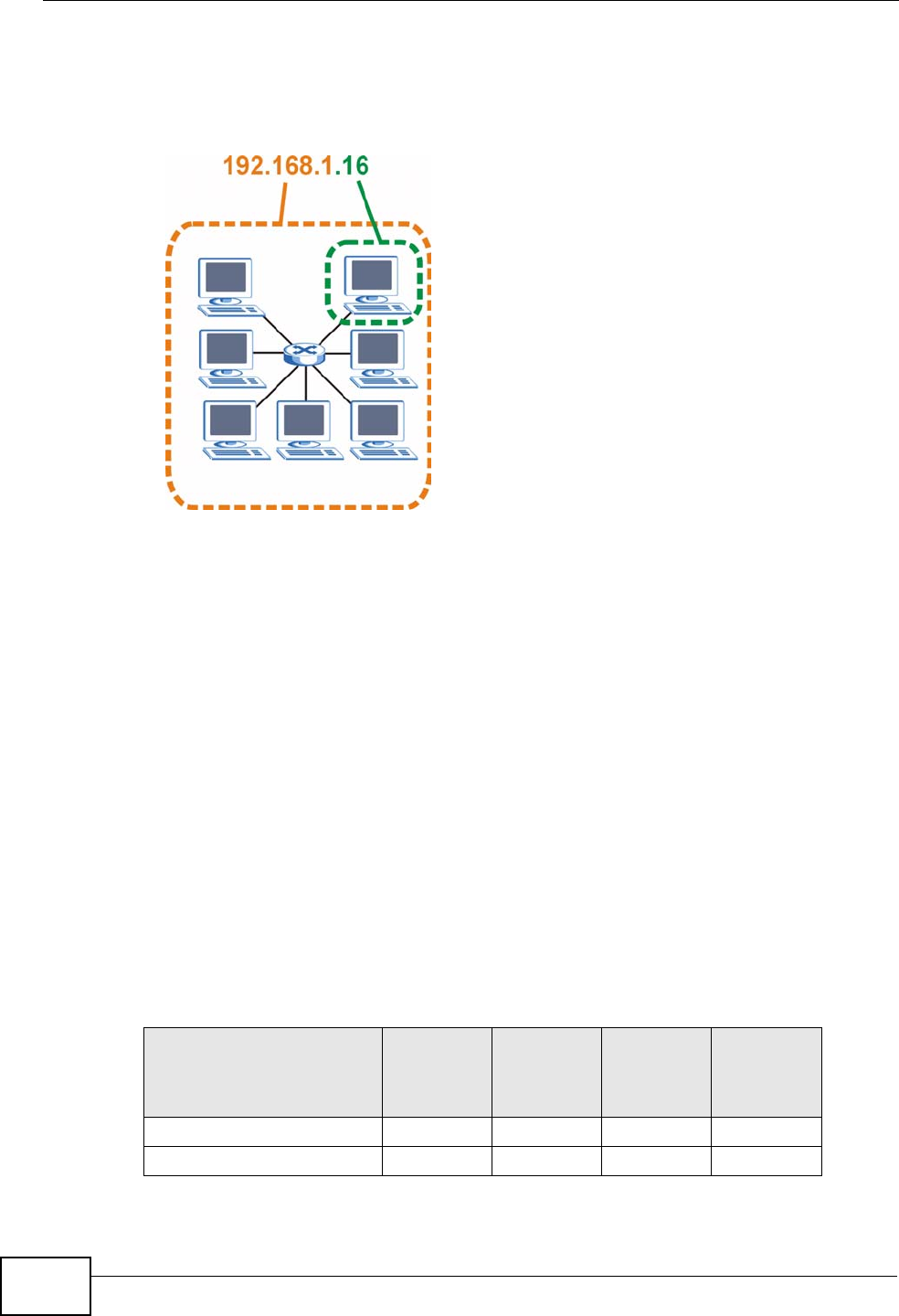
Appendix A IP Addresses and Subnetting
NBG-416N User’s Guide
158
The following figure shows an example IP address in which the first three octets
(192.168.1) are the network number, and the fourth octet (16) is the host ID.
Figure 95 Network Number and Host ID
How much of the IP address is the network number and how much is the host ID
varies according to the subnet mask.
Subnet Masks
A subnet mask is used to determine which bits are part of the network number,
and which bits are part of the host ID (using a logical AND operation). The term
“subnet” is short for “sub-network”.
A subnet mask has 32 bits. If a bit in the subnet mask is a “1” then the
corresponding bit in the IP address is part of the network number. If a bit in the
subnet mask is “0” then the corresponding bit in the IP address is part of the host
ID.
The following example shows a subnet mask identifying the network number (in
bold text) and host ID of an IP address (192.168.1.2 in decimal).
Table 55 Subnet Mask - Identifying Network Number
1ST
OCTET:
(192)
2ND
OCTET:
(168)
3RD
OCTET:
(1)
4TH
OCTET
(2)
IP Address (Binary) 11000000 10101000 00000001 00000010
Subnet Mask (Binary) 11111111 11111111 11111111 00000000

Appendix A IP Addresses and Subnetting
NBG-416N User’s Guide 159
By convention, subnet masks always consist of a continuous sequence of ones
beginning from the leftmost bit of the mask, followed by a continuous sequence of
zeros, for a total number of 32 bits.
Subnet masks can be referred to by the size of the network number part (the bits
with a “1” value). For example, an “8-bit mask” means that the first 8 bits of the
mask are ones and the remaining 24 bits are zeroes.
Subnet masks are expressed in dotted decimal notation just like IP addresses. The
following examples show the binary and decimal notation for 8-bit, 16-bit, 24-bit
and 29-bit subnet masks.
Network Size
The size of the network number determines the maximum number of possible
hosts you can have on your network. The larger the number of network number
bits, the smaller the number of remaining host ID bits.
An IP address with host IDs of all zeros is the IP address of the network
(192.168.1.0 with a 24-bit subnet mask, for example). An IP address with host
IDs of all ones is the broadcast address for that network (192.168.1.255 with a
24-bit subnet mask, for example).
Network Number 11000000 10101000 00000001
Host ID 00000010
Table 56 Subnet Masks
BINARY
DECIMAL
1ST
OCTET 2ND
OCTET 3RD
OCTET 4TH
OCTET
8-bit mask 11111111 00000000 00000000 00000000 255.0.0.0
16-bit
mask 11111111 11111111 00000000 00000000 255.255.0.0
24-bit
mask 11111111 11111111 11111111 00000000 255.255.255.0
29-bit
mask 11111111 11111111 11111111 11111000 255.255.255.24
8
Table 55 Subnet Mask - Identifying Network Number
1ST
OCTET:
(192)
2ND
OCTET:
(168)
3RD
OCTET:
(1)
4TH
OCTET
(2)

Appendix A IP Addresses and Subnetting
NBG-416N User’s Guide
160
As these two IP addresses cannot be used for individual hosts, calculate the
maximum number of possible hosts in a network as follows:
Notation
Since the mask is always a continuous number of ones beginning from the left,
followed by a continuous number of zeros for the remainder of the 32 bit mask,
you can simply specify the number of ones instead of writing the value of each
octet. This is usually specified by writing a “/” followed by the number of bits in
the mask after the address.
For example, 192.1.1.0 /25 is equivalent to saying 192.1.1.0 with subnet mask
255.255.255.128.
The following table shows some possible subnet masks using both notations.
Table 57 Maximum Host Numbers
SUBNET MASK HOST ID SIZE MAXIMUM NUMBER OF
HOSTS
8 bits 255.0.0.0 24 bits 224 – 2 16777214
16 bits 255.255.0.0 16 bits 216 – 2 65534
24 bits 255.255.255.0 8 bits 28 – 2 254
29 bits 255.255.255.2
48 3 bits 23 – 2 6
Table 58 Alternative Subnet Mask Notation
SUBNET
MASK ALTERNATIVE
NOTATION LAST OCTET
(BINARY) LAST OCTET
(DECIMAL)
255.255.255.0 /24 0000 0000 0
255.255.255.12
8/25 1000 0000 128
255.255.255.19
2/26 1100 0000 192
255.255.255.22
4/27 1110 0000 224
255.255.255.24
0/28 1111 0000 240
255.255.255.24
8/29 1111 1000 248
255.255.255.25
2/30 1111 1100 252

Appendix A IP Addresses and Subnetting
NBG-416N User’s Guide 161
Subnetting
You can use subnetting to divide one network into multiple sub-networks. In the
following example a network administrator creates two sub-networks to isolate a
group of servers from the rest of the company network for security reasons.
In this example, the company network address is 192.168.1.0. The first three
octets of the address (192.168.1) are the network number, and the remaining
octet is the host ID, allowing a maximum of 28 – 2 or 254 possible hosts.
The following figure shows the company network before subnetting.
Figure 96 Subnetting Example: Before Subnetting
You can “borrow” one of the host ID bits to divide the network 192.168.1.0 into
two separate sub-networks. The subnet mask is now 25 bits (255.255.255.128 or
/25).
The “borrowed” host ID bit can have a value of either 0 or 1, allowing two
subnets; 192.168.1.0 /25 and 192.168.1.128 /25.
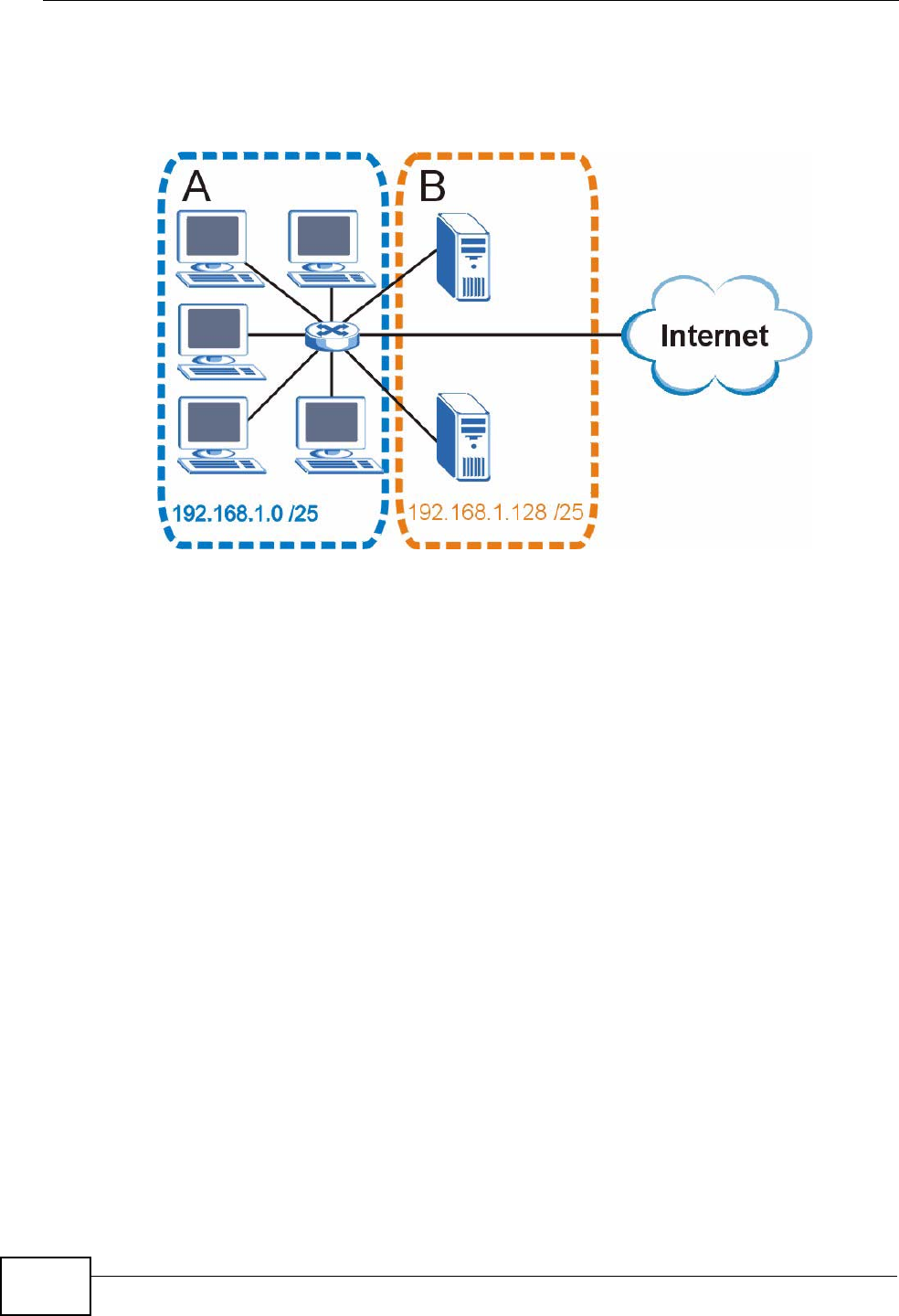
Appendix A IP Addresses and Subnetting
NBG-416N User’s Guide
162
The following figure shows the company network after subnetting. There are now
two sub-networks, A and B.
Figure 97 Subnetting Example: After Subnetting
In a 25-bit subnet the host ID has 7 bits, so each sub-network has a maximum of
27 – 2 or 126 possible hosts (a host ID of all zeroes is the subnet’s address itself,
all ones is the subnet’s broadcast address).
192.168.1.0 with mask 255.255.255.128 is subnet A itself, and 192.168.1.127
with mask 255.255.255.128 is its broadcast address. Therefore, the lowest IP
address that can be assigned to an actual host for subnet A is 192.168.1.1 and
the highest is 192.168.1.126.
Similarly, the host ID range for subnet B is 192.168.1.129 to 192.168.1.254.
Example: Four Subnets
The previous example illustrated using a 25-bit subnet mask to divide a 24-bit
address into two subnets. Similarly, to divide a 24-bit address into four subnets,
you need to “borrow” two host ID bits to give four possible combinations (00, 01,
10 and 11). The subnet mask is 26 bits
(11111111.11111111.11111111.11000000) or 255.255.255.192.
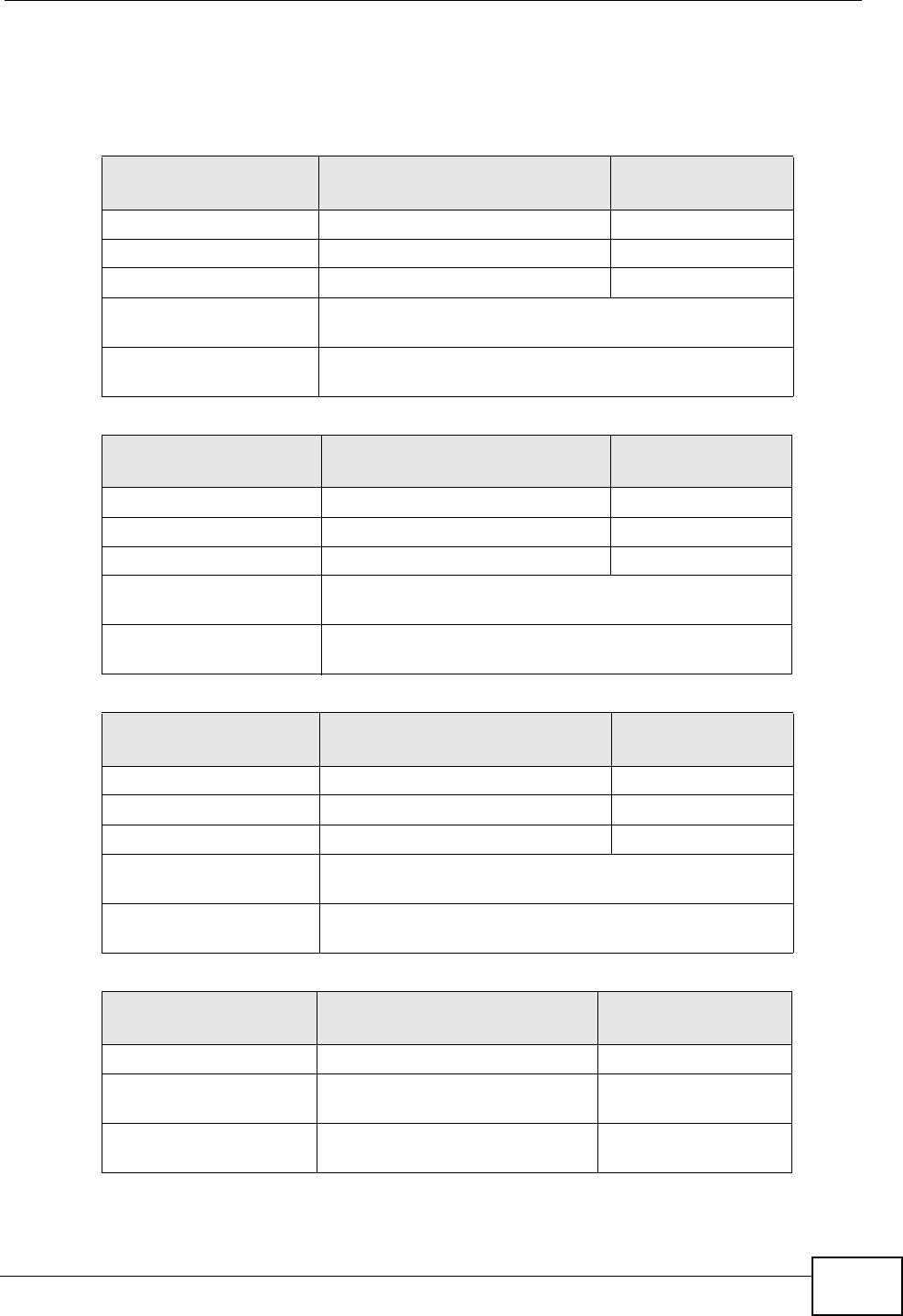
Appendix A IP Addresses and Subnetting
NBG-416N User’s Guide 163
Each subnet contains 6 host ID bits, giving 26 - 2 or 62 hosts for each subnet (a
host ID of all zeroes is the subnet itself, all ones is the subnet’s broadcast
address).
Table 59 Subnet 1
IP/SUBNET MASK NETWORK NUMBER LAST OCTET BIT
VALUE
IP Address (Decimal) 192.168.1. 0
IP Address (Binary) 11000000.10101000.00000001. 00000000
Subnet Mask (Binary) 11111111.11111111.11111111. 11000000
Subnet Address:
192.168.1.0 Lowest Host ID: 192.168.1.1
Broadcast Address:
192.168.1.63 Highest Host ID: 192.168.1.62
Table 60 Subnet 2
IP/SUBNET MASK NETWORK NUMBER LAST OCTET BIT
VALUE
IP Address 192.168.1. 64
IP Address (Binary) 11000000.10101000.00000001. 01000000
Subnet Mask (Binary) 11111111.11111111.11111111. 11000000
Subnet Address:
192.168.1.64 Lowest Host ID: 192.168.1.65
Broadcast Address:
192.168.1.127 Highest Host ID: 192.168.1.126
Table 61 Subnet 3
IP/SUBNET MASK NETWORK NUMBER LAST OCTET BIT
VALUE
IP Address 192.168.1. 128
IP Address (Binary) 11000000.10101000.00000001. 10000000
Subnet Mask (Binary) 11111111.11111111.11111111. 11000000
Subnet Address:
192.168.1.128 Lowest Host ID: 192.168.1.129
Broadcast Address:
192.168.1.191 Highest Host ID: 192.168.1.190
Table 62 Subnet 4
IP/SUBNET MASK NETWORK NUMBER LAST OCTET BIT
VALUE
IP Address 192.168.1. 192
IP Address (Binary) 11000000.10101000.00000001
. 11000000
Subnet Mask (Binary) 11111111.11111111.11111111
. 11000000

Appendix A IP Addresses and Subnetting
NBG-416N User’s Guide
164
Example: Eight Subnets
Similarly, use a 27-bit mask to create eight subnets (000, 001, 010, 011, 100,
101, 110 and 111).
The following table shows IP address last octet values for each subnet.
Subnet Planning
The following table is a summary for subnet planning on a network with a 24-bit
network number.
Subnet Address:
192.168.1.192 Lowest Host ID: 192.168.1.193
Broadcast Address:
192.168.1.255 Highest Host ID: 192.168.1.254
Table 62 Subnet 4 (continued)
IP/SUBNET MASK NETWORK NUMBER LAST OCTET BIT
VALUE
Table 63 Eight Subnets
SUBNET SUBNET
ADDRESS FIRST ADDRESS LAST
ADDRESS BROADCAST
ADDRESS
1 0 1 30 31
232 33 62 63
364 65 94 95
496 97 126 127
5128 129 158 159
6160 161 190 191
7192 193 222 223
8224 225 254 255
Table 64 24-bit Network Number Subnet Planning
NO. “BORROWED”
HOST BITS SUBNET MASK NO. SUBNETS NO. HOSTS PER
SUBNET
1255.255.255.128 (/25) 2126
2255.255.255.192 (/26) 462
3255.255.255.224 (/27) 830
4255.255.255.240 (/28) 16 14
5255.255.255.248 (/29) 32 6
6255.255.255.252 (/30) 64 2
7255.255.255.254 (/31) 128 1
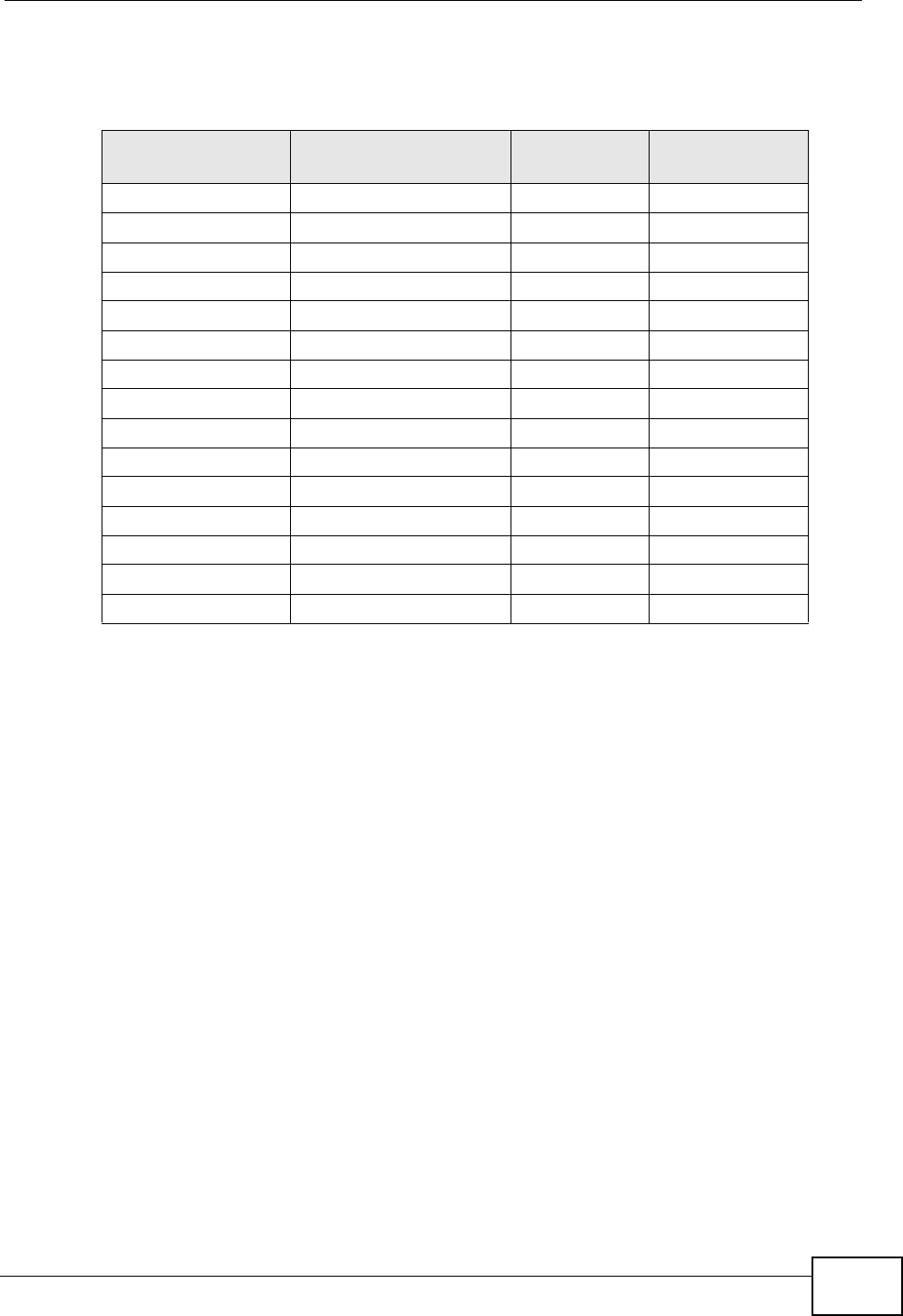
Appendix A IP Addresses and Subnetting
NBG-416N User’s Guide 165
The following table is a summary for subnet planning on a network with a 16-bit
network number.
Configuring IP Addresses
Where you obtain your network number depends on your particular situation. If
the ISP or your network administrator assigns you a block of registered IP
addresses, follow their instructions in selecting the IP addresses and the subnet
mask.
If the ISP did not explicitly give you an IP network number, then most likely you
have a single user account and the ISP will assign you a dynamic IP address when
the connection is established. If this is the case, it is recommended that you select
a network number from 192.168.0.0 to 192.168.255.0. The Internet Assigned
Number Authority (IANA) reserved this block of addresses specifically for private
use; please do not use any other number unless you are told otherwise. You must
also enable Network Address Translation (NAT) on the NBG-416N.
Once you have decided on the network number, pick an IP address for your NBG-
416N that is easy to remember (for instance, 192.168.1.1) but make sure that no
other device on your network is using that IP address.
The subnet mask specifies the network number portion of an IP address. Your
NBG-416N will compute the subnet mask automatically based on the IP address
Table 65 16-bit Network Number Subnet Planning
NO. “BORROWED”
HOST BITS SUBNET MASK NO. SUBNETS NO. HOSTS PER
SUBNET
1255.255.128.0 (/17) 232766
2255.255.192.0 (/18) 416382
3255.255.224.0 (/19) 88190
4255.255.240.0 (/20) 16 4094
5255.255.248.0 (/21) 32 2046
6255.255.252.0 (/22) 64 1022
7255.255.254.0 (/23) 128 510
8255.255.255.0 (/24) 256 254
9255.255.255.128 (/25) 512 126
10 255.255.255.192 (/26) 1024 62
11 255.255.255.224 (/27) 2048 30
12 255.255.255.240 (/28) 4096 14
13 255.255.255.248 (/29) 8192 6
14 255.255.255.252 (/30) 16384 2
15 255.255.255.254 (/31) 32768 1

Appendix A IP Addresses and Subnetting
NBG-416N User’s Guide
166
that you entered. You don't need to change the subnet mask computed by the
NBG-416N unless you are instructed to do otherwise.
Private IP Addresses
Every machine on the Internet must have a unique address. If your networks are
isolated from the Internet (running only between two branch offices, for example)
you can assign any IP addresses to the hosts without problems. However, the
Internet Assigned Numbers Authority (IANA) has reserved the following three
blocks of IP addresses specifically for private networks:
• 10.0.0.0 — 10.255.255.255
• 172.16.0.0 — 172.31.255.255
• 192.168.0.0 — 192.168.255.255
You can obtain your IP address from the IANA, from an ISP, or it can be assigned
from a private network. If you belong to a small organization and your Internet
access is through an ISP, the ISP can provide you with the Internet addresses for
your local networks. On the other hand, if you are part of a much larger
organization, you should consult your network administrator for the appropriate IP
addresses.
Regardless of your particular situation, do not create an arbitrary IP address;
always follow the guidelines above. For more information on address assignment,
please refer to RFC 1597, Address Allocation for Private Internets and RFC 1466,
Guidelines for Management of IP Address Space.

NBG-416N User’s Guide 167
APPENDIX B
Pop-up Windows, JavaScript
and Java Permissions
In order to use the Web Configurator you need to allow:
• Web browser pop-up windows from your device.
• JavaScript (enabled by default).
• Java permissions (enabled by default).
Note: Internet Explorer 6 screens are used here. Screens for other Internet Explorer
versions may vary.
Internet Explorer Pop-up Blockers
You may have to disable pop-up blocking to log into your device.
Either disable pop-up blocking (enabled by default in Windows XP SP (Service
Pack) 2) or allow pop-up blocking and create an exception for your device’s IP
address.
Disable pop-up Blockers
1In Internet Explorer, select Tools, Pop-up Blocker and then select Turn Off
Pop-up Blocker.
Figure 98 Pop-up Blocker
You can also check if pop-up blocking is disabled in the Pop-up Blocker section in
the Privacy tab.
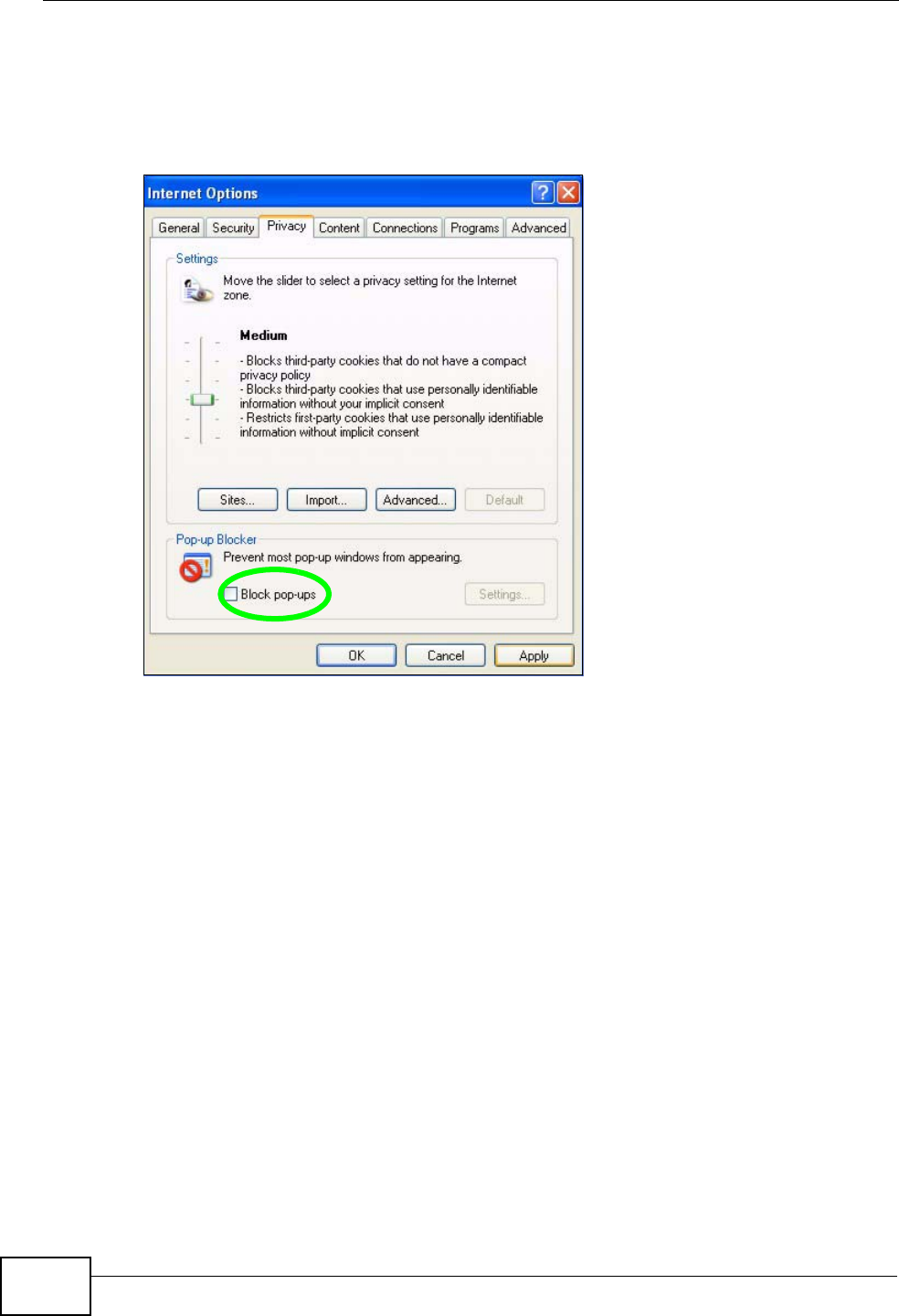
Appendix B Pop-up Windows, JavaScript and Java Permissions
NBG-416N User’s Guide
168
1In Internet Explorer, select Tools, Internet Options, Privacy.
2Clear the Block pop-ups check box in the Pop-up Blocker section of the screen.
This disables any web pop-up blockers you may have enabled.
Figure 99 Internet Options: Privacy
3Click Apply to save this setting.
Enable pop-up Blockers with Exceptions
Alternatively, if you only want to allow pop-up windows from your device, see the
following steps.
1In Internet Explorer, select Tools, Internet Options and then the Privacy tab.

Appendix B Pop-up Windows, JavaScript and Java Permissions
NBG-416N User’s Guide 169
2Select Settings…to open the Pop-up Blocker Settings screen.
Figure 100 Internet Options: Privacy
3Type the IP address of your device (the web page that you do not want to have
blocked) with the prefix “http://”. For example, http://192.168.167.1.

Appendix B Pop-up Windows, JavaScript and Java Permissions
NBG-416N User’s Guide
170
4Click Add to move the IP address to the list of Allowed sites.
Figure 101 Pop-up Blocker Settings
5Click Close to return to the Privacy screen.
6Click Apply to save this setting.
JavaScript
If pages of the Web Configurator do not display properly in Internet Explorer,
check that JavaScript are allowed.

Appendix B Pop-up Windows, JavaScript and Java Permissions
NBG-416N User’s Guide 171
1In Internet Explorer, click Tools, Internet Options and then the Security tab.
Figure 102 Internet Options: Security
2Click the Custom Level... button.
3Scroll down to Scripting.
4Under Active scripting make sure that Enable is selected (the default).
5Under Scripting of Java applets make sure that Enable is selected (the
default).

Appendix B Pop-up Windows, JavaScript and Java Permissions
NBG-416N User’s Guide
172
6Click OK to close the window.
Figure 103 Security Settings - Java Scripting
Java Permissions
1From Internet Explorer, click Tools, Internet Options and then the Security
tab.
2Click the Custom Level... button.
3Scroll down to Microsoft VM.
4Under Java permissions make sure that a safety level is selected.
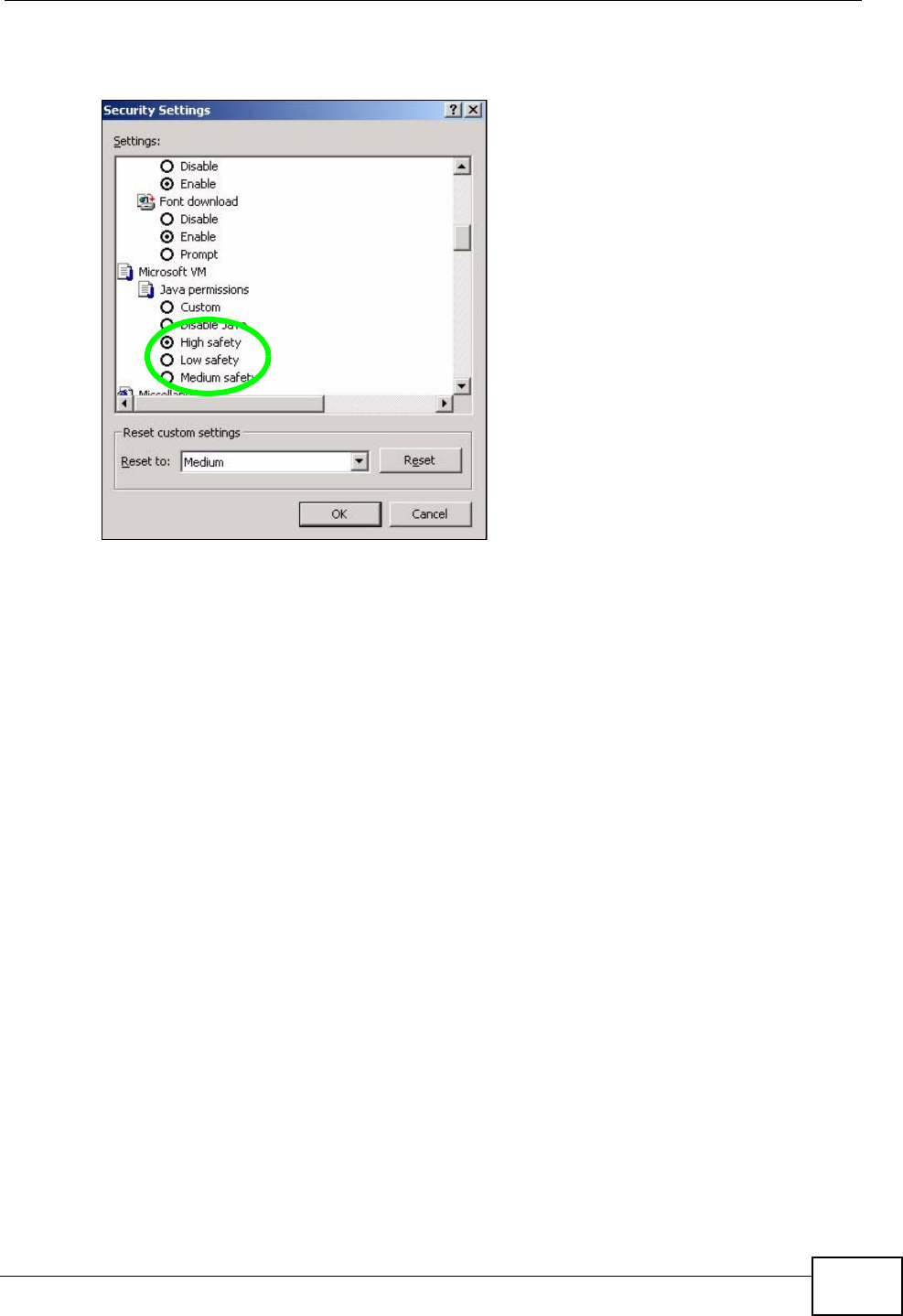
Appendix B Pop-up Windows, JavaScript and Java Permissions
NBG-416N User’s Guide 173
5Click OK to close the window.
Figure 104 Security Settings - Java
JAVA (Sun)
1From Internet Explorer, click Tools, Internet Options and then the Advanced
tab.
2Make sure that Use Java 2 for <applet> under Java (Sun) is selected.

Appendix B Pop-up Windows, JavaScript and Java Permissions
NBG-416N User’s Guide
174
3Click OK to close the window.
Figure 105 Java (Sun)

NBG-416N User’s Guide 175
APPENDIX C
Setting up Your Computer’s IP
Address
All computers must have a 10M or 100M Ethernet adapter card and TCP/IP
installed.
Windows 95/98/Me/NT/2000/XP, Macintosh OS 7 and later operating systems and
all versions of UNIX/LINUX include the software components you need to install
and use TCP/IP on your computer. Windows 3.1 requires the purchase of a third-
party TCP/IP application package.
TCP/IP should already be installed on computers using Windows NT/2000/XP,
Macintosh OS 7 and later operating systems.
After the appropriate TCP/IP components are installed, configure the TCP/IP
settings in order to "communicate" with your network.
If you manually assign IP information instead of using dynamic assignment, make
sure that your computers have IP addresses that place them in the same subnet
as the Prestige’s LAN port.

Appendix C Setting up Your Computer’s IP Address
NBG-416N User’s Guide
176
Windows 95/98/Me
Click Start, Settings, Control Panel and double-click the Network icon to open
the Network window.
Figure 106 WIndows 95/98/Me: Network: Configuration
Installing Components
The Network window Configuration tab displays a list of installed components.
You need a network adapter, the TCP/IP protocol and Client for Microsoft
Networks.
If you need the adapter:
1In the Network window, click Add.
2Select Adapter and then click Add.
3Select the manufacturer and model of your network adapter and then click OK.
If you need TCP/IP:
1In the Network window, click Add.
2Select Protocol and then click Add.
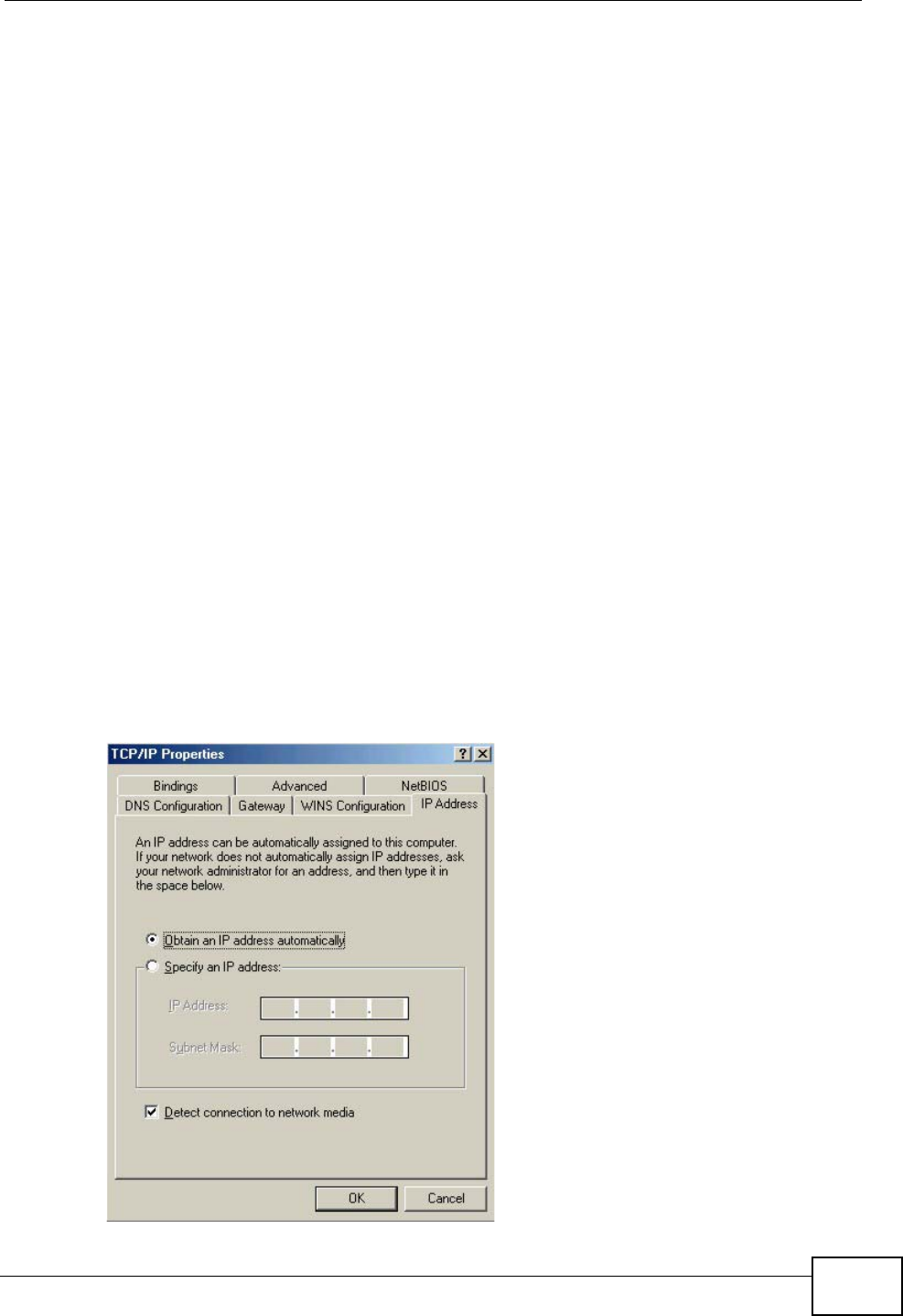
Appendix C Setting up Your Computer’s IP Address
NBG-416N User’s Guide 177
3Select Microsoft from the list of manufacturers.
4Select TCP/IP from the list of network protocols and then click OK.
If you need Client for Microsoft Networks:
1Click Add.
2Select Client and then click Add.
3Select Microsoft from the list of manufacturers.
4Select Client for Microsoft Networks from the list of network clients and then
click OK.
5Restart your computer so the changes you made take effect.
Configuring
1In the Network window Configuration tab, select your network adapter's TCP/IP
entry and click Properties
2Click the IP Address tab.
• If your IP address is dynamic, select Obtain an IP address automatically.
• If you have a static IP address, select Specify an IP address and type your
information into the IP Address and Subnet Mask fields.
Figure 107 Windows 95/98/Me: TCP/IP Properties: IP Address
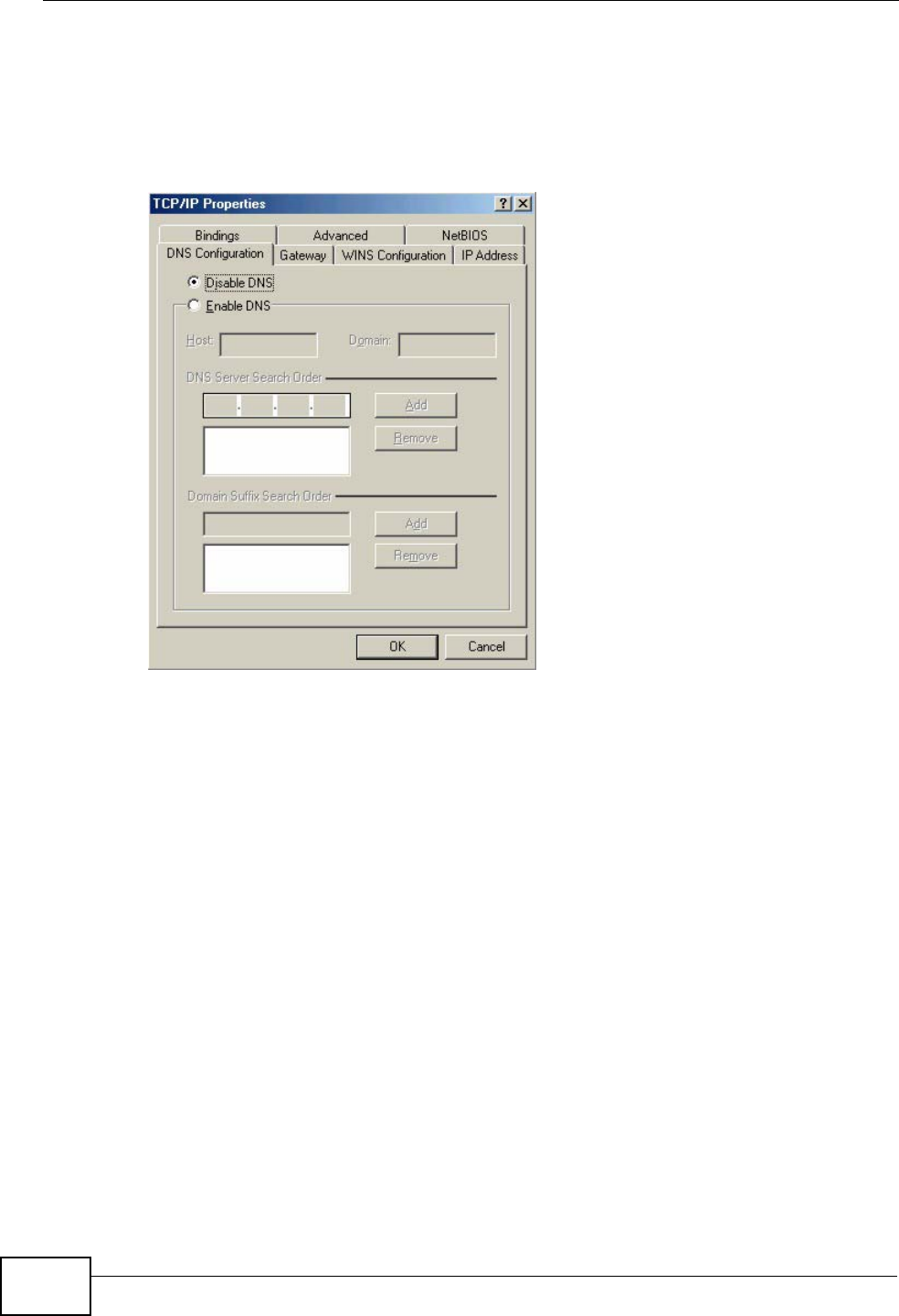
Appendix C Setting up Your Computer’s IP Address
NBG-416N User’s Guide
178
3Click the DNS Configuration tab.
• If you do not know your DNS information, select Disable DNS.
• If you know your DNS information, select Enable DNS and type the
information in the fields below (you may not need to fill them all in).
Figure 108 Windows 95/98/Me: TCP/IP Properties: DNS Configuration
4Click the Gateway tab.
• If you do not know your gateway’s IP address, remove previously installed
gateways.
• If you have a gateway IP address, type it in the New gateway field and click
Add.
5Click OK to save and close the TCP/IP Properties window.
6Click OK to close the Network window. Insert the Windows CD if prompted.
7Turn on your Prestige and restart your computer when prompted.
Verifying Settings
1Click Start and then Run.
2In the Run window, type "winipcfg" and then click OK to open the IP
Configuration window.

Appendix C Setting up Your Computer’s IP Address
NBG-416N User’s Guide 179
3Select your network adapter. You should see your computer's IP address, subnet
mask and default gateway.
Windows 2000/NT/XP
The following example figures use the default Windows XP GUI theme.
1Click start (Start in Windows 2000/NT), Settings, Control Panel.
Figure 109 Windows XP: Start Menu
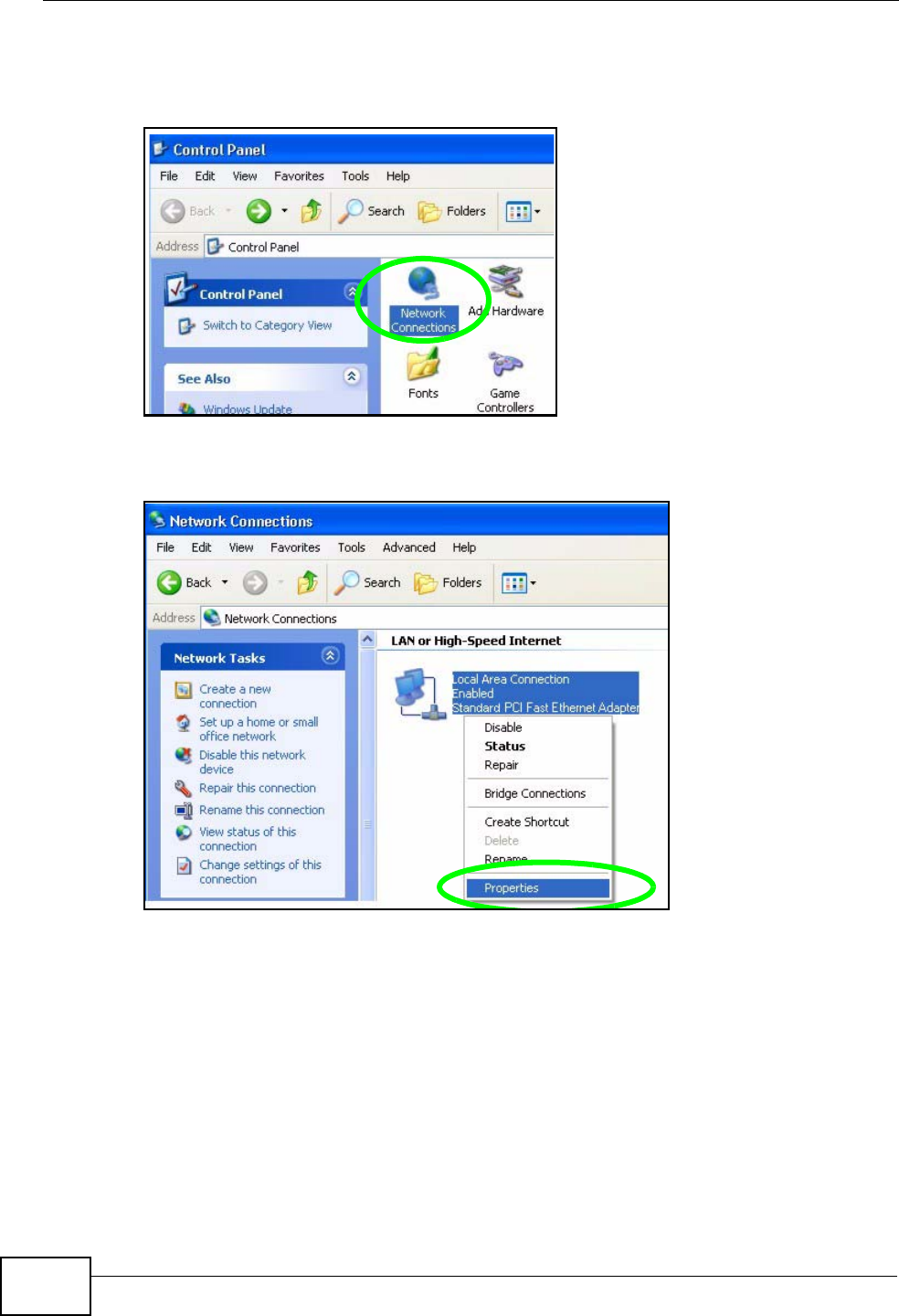
Appendix C Setting up Your Computer’s IP Address
NBG-416N User’s Guide
180
2In the Control Panel, double-click Network Connections (Network and Dial-
up Connections in Windows 2000/NT).
Figure 110 Windows XP: Control Panel
3Right-click Local Area Connection and then click Properties.
Figure 111 Windows XP: Control Panel: Network Connections: Properties

Appendix C Setting up Your Computer’s IP Address
NBG-416N User’s Guide 181
4Select Internet Protocol (TCP/IP) (under the General tab in Win XP) and then
click Properties.
Figure 112 Windows XP: Local Area Connection Properties
5The Internet Protocol TCP/IP Properties window opens (the General tab in
Windows XP).
• If you have a dynamic IP address click Obtain an IP address
automatically.
• If you have a static IP address click Use the following IP Address and fill in
the IP address, Subnet mask, and Default gateway fields.

Appendix C Setting up Your Computer’s IP Address
NBG-416N User’s Guide
182
•Click Advanced.
Figure 113 Windows XP: Internet Protocol (TCP/IP) Properties
6 If you do not know your gateway's IP address, remove any previously installed
gateways in the IP Settings tab and click OK.
Do one or more of the following if you want to configure additional IP addresses:
•In the IP Settings tab, in IP addresses, click Add.
•In TCP/IP Address, type an IP address in IP address and a subnet mask in
Subnet mask, and then click Add.
• Repeat the above two steps for each IP address you want to add.
• Configure additional default gateways in the IP Settings tab by clicking Add
in Default gateways.
•In TCP/IP Gateway Address, type the IP address of the default gateway in
Gateway. To manually configure a default metric (the number of transmission
hops), clear the Automatic metric check box and type a metric in Metric.
•Click Add.
• Repeat the previous three steps for each default gateway you want to add.
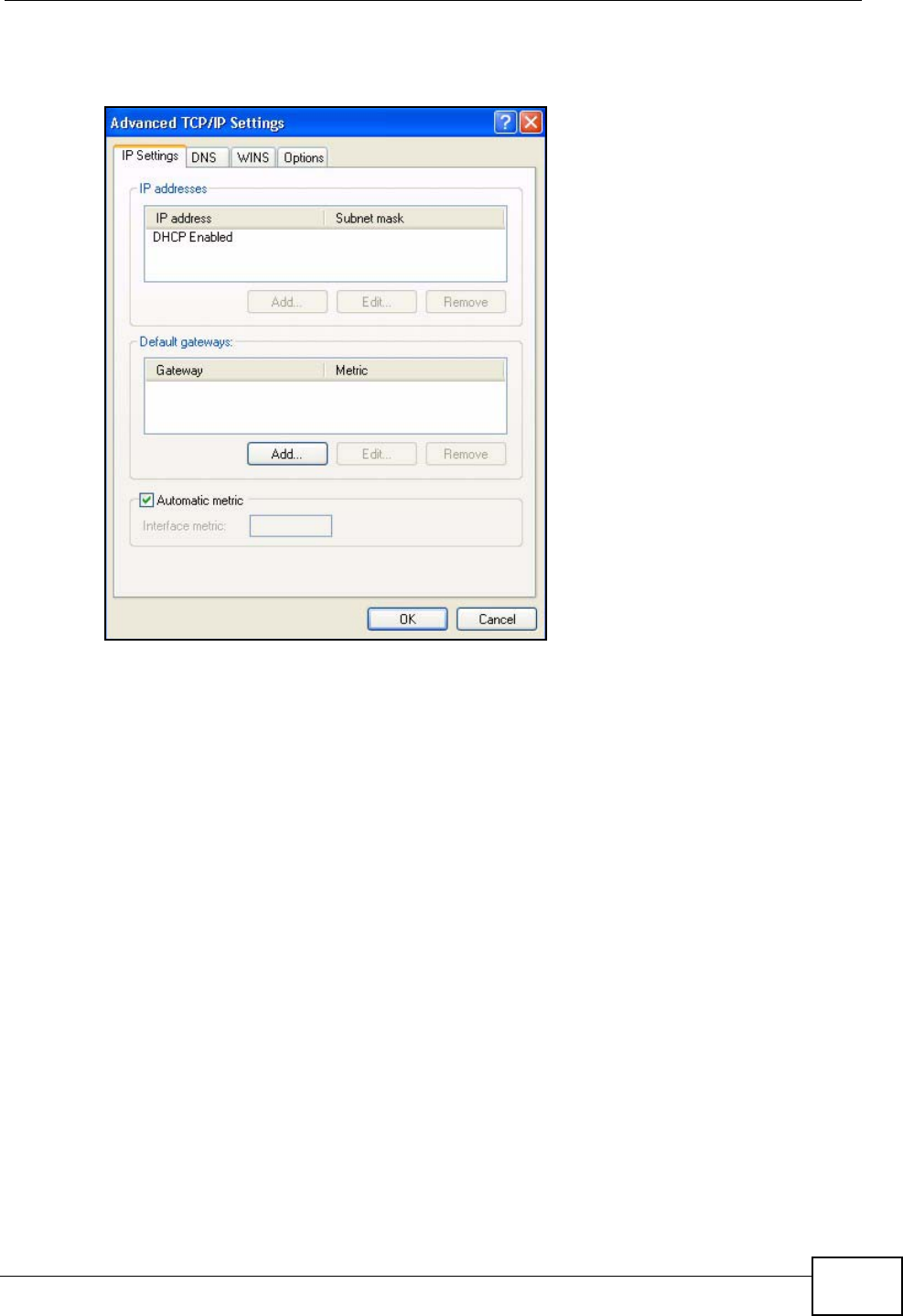
Appendix C Setting up Your Computer’s IP Address
NBG-416N User’s Guide 183
•Click OK when finished.
Figure 114 Windows XP: Advanced TCP/IP Properties
7In the Internet Protocol TCP/IP Properties window (the General tab in
Windows XP):
•Click Obtain DNS server address automatically if you do not know your
DNS server IP address(es).
• If you know your DNS server IP address(es), click Use the following DNS
server addresses, and type them in the Preferred DNS server and
Alternate DNS server fields.

Appendix C Setting up Your Computer’s IP Address
NBG-416N User’s Guide
184
If you have previously configured DNS servers, click Advanced and then the
DNS tab to order them.
Figure 115 Windows XP: Internet Protocol (TCP/IP) Properties
8Click OK to close the Internet Protocol (TCP/IP) Properties window.
9Click Close (OK in Windows 2000/NT) to close the Local Area Connection
Properties window.
10 Close the Network Connections window (Network and Dial-up Connections
in Windows 2000/NT).
11 Turn on your Prestige and restart your computer (if prompted).
Verifying Settings
1Click Start, All Programs, Accessories and then Command Prompt.
2In the Command Prompt window, type "ipconfig" and then press [ENTER]. You
can also open Network Connections, right-click a network connection, click
Status and then click the Support tab.

Appendix C Setting up Your Computer’s IP Address
NBG-416N User’s Guide 185
Macintosh OS 8/9
1Click the Apple menu, Control Panel and double-click TCP/IP to open the TCP/
IP Control Panel.
Figure 116 Macintosh OS 8/9: Apple Menu
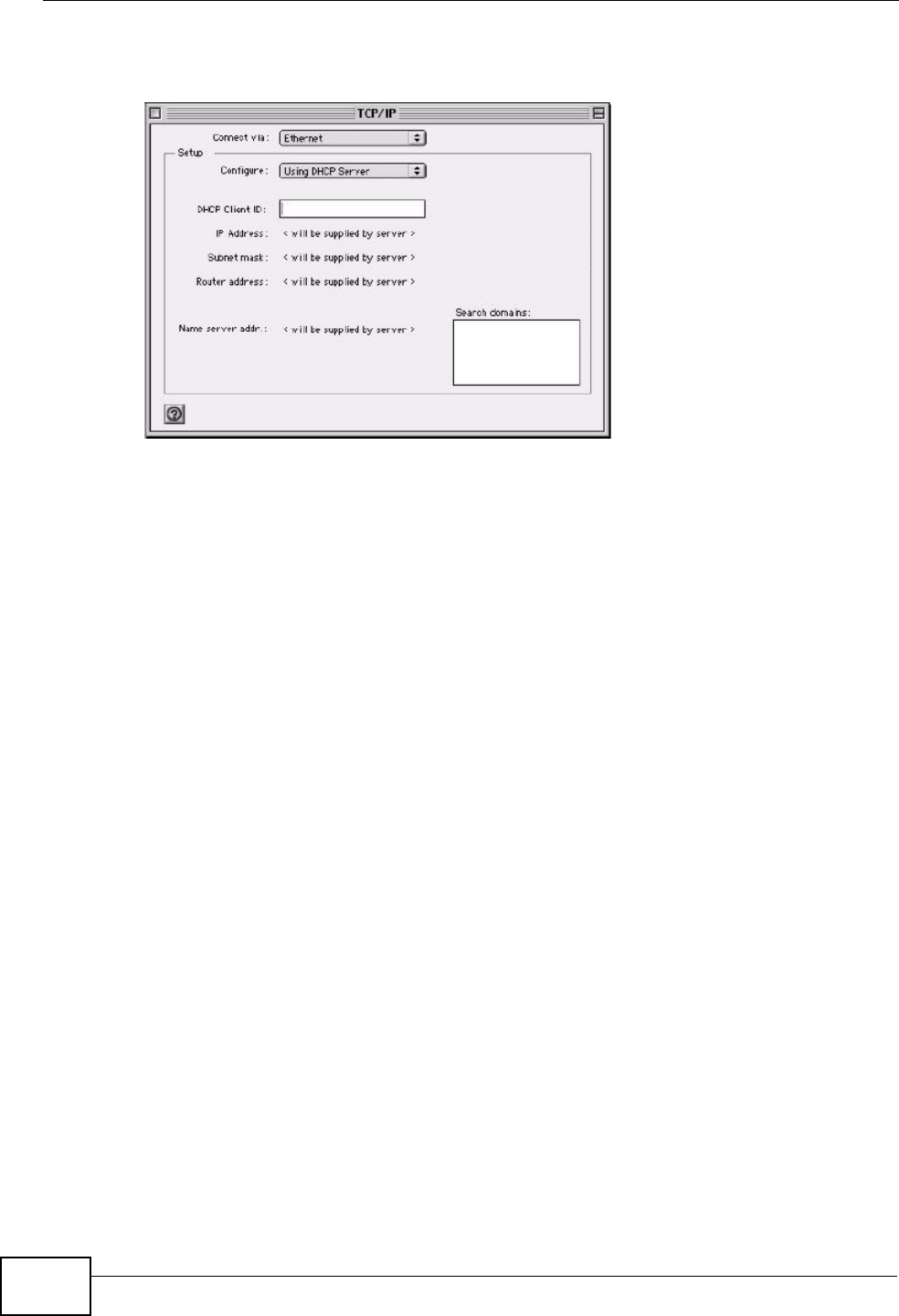
Appendix C Setting up Your Computer’s IP Address
NBG-416N User’s Guide
186
2Select Ethernet built-in from the Connect via list.
Figure 117 Macintosh OS 8/9: TCP/IP
3For dynamically assigned settings, select Using DHCP Server from the
Configure: list.
4For statically assigned settings, do the following:
•From the Configure box, select Manually.
• Type your IP address in the IP Address box.
• Type your subnet mask in the Subnet mask box.
• Type the IP address of your Prestige in the Router address box.
5Close the TCP/IP Control Panel.
6Click Save if prompted, to save changes to your configuration.
7Turn on your Prestige and restart your computer (if prompted).
Verifying Settings
Check your TCP/IP properties in the TCP/IP Control Panel window.

Appendix C Setting up Your Computer’s IP Address
NBG-416N User’s Guide 187
Macintosh OS X
1Click the Apple menu, and click System Preferences to open the System
Preferences window.
Figure 118 Macintosh OS X: Apple Menu
2Click Network in the icon bar.
• Select Automatic from the Location list.
• Select Built-in Ethernet from the Show list.
•Click the TCP/IP tab.
3For dynamically assigned settings, select Using DHCP from the Configure list.
Figure 119 Macintosh OS X: Network

Appendix C Setting up Your Computer’s IP Address
NBG-416N User’s Guide
188
4For statically assigned settings, do the following:
•From the Configure box, select Manually.
• Type your IP address in the IP Address box.
• Type your subnet mask in the Subnet mask box.
• Type the IP address of your Prestige in the Router address box.
5Click Apply Now and close the window.
6Turn on your Prestige and restart your computer (if prompted).
Verifying Settings
Check your TCP/IP properties in the Network window.
Linux
This section shows you how to configure your computer’s TCP/IP settings in Red
Hat Linux 9.0. Procedure, screens and file location may vary depending on your
Linux distribution and release version.
Note: Make sure you are logged in as the root administrator.
Using the K Desktop Environment (KDE)
Follow the steps below to configure your computer IP address using the KDE.
1Click the Red Hat button (located on the bottom left corner), select System
Setting and click Network.
Figure 120 Red Hat 9.0: KDE: Network Configuration: Devices

Appendix C Setting up Your Computer’s IP Address
NBG-416N User’s Guide 189
2Double-click on the profile of the network card you wish to configure. The
Ethernet Device General screen displays as shown.
Figure 121 Red Hat 9.0: KDE: Ethernet Device: General
• If you have a dynamic IP address click Automatically obtain IP address
settings with and select dhcp from the drop down list.
• If you have a static IP address click Statically set IP Addresses and fill in
the Address, Subnet mask, and Default Gateway Address fields.
3Click OK to save the changes and close the Ethernet Device General screen.
4If you know your DNS server IP address(es), click the DNS tab in the Network
Configuration screen. Enter the DNS server information in the fields provided.
Figure 122 Red Hat 9.0: KDE: Network Configuration: DNS

Appendix C Setting up Your Computer’s IP Address
NBG-416N User’s Guide
190
5Click the Devices tab.
6Click the Activate button to apply the changes. The following screen displays.
Click Yes to save the changes in all screens.
Figure 123 Red Hat 9.0: KDE: Network Configuration: Activate
7After the network card restart process is complete, make sure the Status is
Active in the Network Configuration screen.
Using Configuration Files
Follow the steps below to edit the network configuration files and set your
computer IP address.
1Assuming that you have only one network card on the computer, locate the
ifconfig-eth0 configuration file (where eth0 is the name of the Ethernet card).
Open the configuration file with any plain text editor.
• If you have a dynamic IP address, enter dhcp in the BOOTPROTO= field. The
following figure shows an example.
Figure 124 Red Hat 9.0: Dynamic IP Address Setting in ifconfig-eth0
DEVICE=eth0
ONBOOT=yes
BOOTPROTO=dhcp
USERCTL=no
PEERDNS=yes
TYPE=Ethernet

Appendix C Setting up Your Computer’s IP Address
NBG-416N User’s Guide 191
• If you have a static IP address, enter static in the BOOTPROTO= field. Type
IPADDR= followed by the IP address (in dotted decimal notation) and type
NETMASK= followed by the subnet mask. The following example shows an
example where the static IP address is 192.168.1.10 and the subnet mask is
255.255.255.0.
Figure 125 Red Hat 9.0: Static IP Address Setting in ifconfig-eth0
2If you know your DNS server IP address(es), enter the DNS server information in
the resolv.conf file in the /etc directory. The following figure shows an example
where two DNS server IP addresses are specified.
Figure 126 Red Hat 9.0: DNS Settings in resolv.conf
3After you edit and save the configuration files, you must restart the network card.
Enter./network restart in the /etc/rc.d/init.d directory. The following figure
shows an example.
Figure 127 Red Hat 9.0: Restart Ethernet Card
DEVICE=eth0
ONBOOT=yes
BOOTPROTO=static
IPADDR=192.168.1.10
NETMASK=255.255.255.0
USERCTL=no
PEERDNS=yes
TYPE=Ethernet
nameserver 172.23.5.1
nameserver 172.23.5.2
[root@localhost init.d]# network restart
Shutting down interface eth0: [OK]
Shutting down loopback interface: [OK]
Setting network parameters: [OK]
Bringing up loopback interface: [OK]
Bringing up interface eth0: [OK]

Appendix C Setting up Your Computer’s IP Address
NBG-416N User’s Guide
192
21.0.1 Verifying Settings
Enter ifconfig in a terminal screen to check your TCP/IP properties.
Figure 128 Red Hat 9.0: Checking TCP/IP Properties
[root@localhost]# ifconfig
eth0 Link encap:Ethernet HWaddr 00:50:BA:72:5B:44
inet addr:172.23.19.129 Bcast:172.23.19.255 Mask:255.255.255.0
UP BROADCAST RUNNING MULTICAST MTU:1500 Metric:1
RX packets:717 errors:0 dropped:0 overruns:0 frame:0
TX packets:13 errors:0 dropped:0 overruns:0 carrier:0
collisions:0 txqueuelen:100
RX bytes:730412 (713.2 Kb) TX bytes:1570 (1.5 Kb)
Interrupt:10 Base address:0x1000
[root@localhost]#

NBG-416N User’s Guide 193
APPENDIX D
Wireless LANs
Wireless LAN Topologies
This section discusses ad-hoc and infrastructure wireless LAN topologies.
Ad-hoc Wireless LAN Configuration
The simplest WLAN configuration is an independent (Ad-hoc) WLAN that connects
a set of computers with wireless stations (A, B, C). Any time two or more wireless
adapters are within range of each other, they can set up an independent network,
which is commonly referred to as an Ad-hoc network or Independent Basic Service
Set (IBSS). The following diagram shows an example of notebook computers
using wireless adapters to form an Ad-hoc wireless LAN.
Figure 129 Peer-to-Peer Communication in an Ad-hoc Network
BSS
A Basic Service Set (BSS) exists when all communications between wireless
stations or between a wireless station and a wired network client go through one
access point (AP).
Intra-BSS traffic is traffic between wireless stations in the BSS. When Intra-BSS is
enabled, wireless station A and B can access the wired network and communicate

Appendix D Wireless LANs
NBG-416N User’s Guide
194
with each other. When Intra-BSS is disabled, wireless station A and B can still
access the wired network but cannot communicate with each other.
Figure 130 Basic Service Set
ESS
An Extended Service Set (ESS) consists of a series of overlapping BSSs, each
containing an access point, with each access point connected together by a wired
network. This wired connection between APs is called a Distribution System (DS).
This type of wireless LAN topology is called an Infrastructure WLAN. The Access
Points not only provide communication with the wired network but also mediate
wireless network traffic in the immediate neighborhood.

Appendix D Wireless LANs
NBG-416N User’s Guide 195
An ESSID (ESS IDentification) uniquely identifies each ESS. All access points and
their associated wireless stations within the same ESS must have the same ESSID
in order to communicate.
Figure 131 Infrastructure WLAN
Channel
A channel is the radio frequency(ies) used by IEEE 802.11a/b/g wireless devices.
Channels available depend on your geographical area. You may have a choice of
channels (for your region) so you should use a different channel than an adjacent
AP (access point) to reduce interference. Interference occurs when radio signals
from different access points overlap causing interference and degrading
performance.
Adjacent channels partially overlap however. To avoid interference due to overlap,
your AP should be on a channel at least five channels away from a channel that an
adjacent AP is using. For example, if your region has 11 channels and an adjacent
AP is using channel 1, then you need to select a channel between 6 or 11.
RTS/CTS
A hidden node occurs when two stations are within range of the same access
point, but are not within range of each other. The following figure illustrates a
hidden node. Both stations (STA) are within range of the access point (AP) or

Appendix D Wireless LANs
NBG-416N User’s Guide
196
wireless gateway, but out-of-range of each other, so they cannot "hear" each
other, that is they do not know if the channel is currently being used. Therefore,
they are considered hidden from each other.
Figure 132 RTS/CTS
When station A sends data to the AP, it might not know that the station B is
already using the channel. If these two stations send data at the same time,
collisions may occur when both sets of data arrive at the AP at the same time,
resulting in a loss of messages for both stations.
RTS/CTS is designed to prevent collisions due to hidden nodes. An RTS/CTS
defines the biggest size data frame you can send before an RTS (Request To
Send)/CTS (Clear to Send) handshake is invoked.
When a data frame exceeds the RTS/CTS value you set (between 0 to 2432
bytes), the station that wants to transmit this frame must first send an RTS
(Request To Send) message to the AP for permission to send it. The AP then
responds with a CTS (Clear to Send) message to all other stations within its range
to notify them to defer their transmission. It also reserves and confirms with the
requesting station the time frame for the requested transmission.
Stations can send frames smaller than the specified RTS/CTS directly to the AP
without the RTS (Request To Send)/CTS (Clear to Send) handshake.
You should only configure RTS/CTS if the possibility of hidden nodes exists on
your network and the "cost" of resending large frames is more than the extra
network overhead involved in the RTS (Request To Send)/CTS (Clear to Send)
handshake.
If the RTS/CTS value is greater than the Fragmentation Threshold value (see
next), then the RTS (Request To Send)/CTS (Clear to Send) handshake will never
occur as data frames will be fragmented before they reach RTS/CTS size.
Note: Enabling the RTS Threshold causes redundant network overhead that could
negatively affect the throughput performance instead of providing a remedy.

Appendix D Wireless LANs
NBG-416N User’s Guide 197
Fragmentation Threshold
A Fragmentation Threshold is the maximum data fragment size (between 256
and 2432 bytes) that can be sent in the wireless network before the AP will
fragment the packet into smaller data frames.
A large Fragmentation Threshold is recommended for networks not prone to
interference while you should set a smaller threshold for busy networks or
networks that are prone to interference.
If the Fragmentation Threshold value is smaller than the RTS/CTS value (see
previously) you set then the RTS (Request To Send)/CTS (Clear to Send)
handshake will never occur as data frames will be fragmented before they reach
RTS/CTS size.
Preamble Type
A preamble is used to synchronize the transmission timing in your wireless
network. There are two preamble modes: Long and Short.
Short preamble takes less time to process and minimizes overhead, so it should
be used in a good wireless network environment when all wireless stations
support it.
Select Long if you have a ‘noisy’ network or are unsure of what preamble mode
your wireless stations support as all IEEE 802.11b compliant wireless adapters
must support long preamble. However, not all wireless adapters support short
preamble. Use long preamble if you are unsure what preamble mode the wireless
adapters support, to ensure interpretability between the AP and the wireless
stations and to provide more reliable communication in ‘noisy’ networks.
Select Dynamic to have the AP automatically use short preamble when all
wireless stations support it, otherwise the AP uses long preamble.
Note: The AP and the wireless stations MUST use the same preamble mode in order
to communicate.
IEEE 802.11g Wireless LAN
IEEE 802.11g is fully compatible with the IEEE 802.11b standard. This means an
IEEE 802.11b adapter can interface directly with an IEEE 802.11g access point
(and vice versa) at 11 Mbps or lower depending on range. IEEE 802.11g has

Appendix D Wireless LANs
NBG-416N User’s Guide
198
several intermediate rate steps between the maximum and minimum data rates.
The IEEE 802.11g data rate and modulation are as follows:
IEEE 802.1x
In June 2001, the IEEE 802.1x standard was designed to extend the features of
IEEE 802.11 to support extended authentication as well as providing additional
accounting and control features. It is supported by Windows XP and a number of
network devices. Some advantages of IEEE 802.1x are:
• User based identification that allows for roaming.
• Support for RADIUS (Remote Authentication Dial In User Service, RFC 2138,
2139) for centralized user profile and accounting management on a network
RADIUS server.
• Support for EAP (Extensible Authentication Protocol, RFC 2486) that allows
additional authentication methods to be deployed with no changes to the access
point or the wireless stations.
RADIUS
RADIUS is based on a client-server model that supports authentication,
authorization and accounting. The access point is the client and the server is the
RADIUS server. The RADIUS server handles the following tasks:
• Authentication
Determines the identity of the users.
• Authorization
Determines the network services available to authenticated users once they are
connected to the network.
•Accounting
Keeps track of the client’s network activity.
RADIUS is a simple package exchange in which your AP acts as a message relay
between the wireless station and the network RADIUS server.
Table 66 IEEE 802.11g
DATA RATE
(MBPS) MODULATION
1 DBPSK (Differential Binary Phase Shift Keyed)
2 DQPSK (Differential Quadrature Phase Shift Keying)
5.5 / 11 CCK (Complementary Code Keying)
6/9/12/18/24/36/
48/54 OFDM (Orthogonal Frequency Division Multiplexing)

Appendix D Wireless LANs
NBG-416N User’s Guide 199
Types of RADIUS Messages
The following types of RADIUS messages are exchanged between the access point
and the RADIUS server for user authentication:
• Access-Request
Sent by an access point requesting authentication.
• Access-Reject
Sent by a RADIUS server rejecting access.
• Access-Accept
Sent by a RADIUS server allowing access.
• Access-Challenge
Sent by a RADIUS server requesting more information in order to allow access.
The access point sends a proper response from the user and then sends another
Access-Request message.
The following types of RADIUS messages are exchanged between the access point
and the RADIUS server for user accounting:
•Accounting-Request
Sent by the access point requesting accounting.
• Accounting-Response
Sent by the RADIUS server to indicate that it has started or stopped accounting.
In order to ensure network security, the access point and the RADIUS server use a
shared secret key, which is a password, they both know. The key is not sent over
the network. In addition to the shared key, password information exchanged is
also encrypted to protect the network from unauthorized access.
Types of Authentication
This appendix discusses some popular authentication types: EAP-MD5, EAP-TLS,
EAP-TTLS, PEAP and LEAP.
The type of authentication you use depends on the RADIUS server or the AP.
Consult your network administrator for more information.
EAP-MD5 (Message-Digest Algorithm 5)
MD5 authentication is the simplest one-way authentication method. The
authentication server sends a challenge to the wireless station. The wireless
station ‘proves’ that it knows the password by encrypting the password with the
challenge and sends back the information. Password is not sent in plain text.

Appendix D Wireless LANs
NBG-416N User’s Guide
200
However, MD5 authentication has some weaknesses. Since the authentication
server needs to get the plaintext passwords, the passwords must be stored. Thus
someone other than the authentication server may access the password file. In
addition, it is possible to impersonate an authentication server as MD5
authentication method does not perform mutual authentication. Finally, MD5
authentication method does not support data encryption with dynamic session
key. You must configure WEP encryption keys for data encryption.
EAP-TLS (Transport Layer Security)
With EAP-TLS, digital certifications are needed by both the server and the wireless
stations for mutual authentication. The server presents a certificate to the client.
After validating the identity of the server, the client sends a different certificate to
the server. The exchange of certificates is done in the open before a secured
tunnel is created. This makes user identity vulnerable to passive attacks. A digital
certificate is an electronic ID card that authenticates the sender’s identity.
However, to implement EAP-TLS, you need a Certificate Authority (CA) to handle
certificates, which imposes a management overhead.
EAP-TTLS (Tunneled Transport Layer Service)
EAP-TTLS is an extension of the EAP-TLS authentication that uses certificates for
only the server-side authentications to establish a secure connection. Client
authentication is then done by sending username and password through the
secure connection, thus client identity is protected. For client authentication, EAP-
TTLS supports EAP methods and legacy authentication methods such as PAP,
CHAP, MS-CHAP and MS-CHAP v2.
PEAP (Protected EAP)
Like EAP-TTLS, server-side certificate authentication is used to establish a secure
connection, then use simple username and password methods through the
secured connection to authenticate the clients, thus hiding client identity.
However, PEAP only supports EAP methods, such as EAP-MD5, EAP-MSCHAPv2
and EAP-GTC (EAP-Generic Token Card), for client authentication. EAP-GTC is
implemented only by Cisco.
LEAP
LEAP (Lightweight Extensible Authentication Protocol) is a Cisco implementation of
IEEE 802.1x.
Dynamic WEP Key Exchange
The AP maps a unique key that is generated with the RADIUS server. This key
expires when the wireless connection times out, disconnects or reauthentication
times out. A new WEP key is generated each time reauthentication is performed.

Appendix D Wireless LANs
NBG-416N User’s Guide 201
If this feature is enabled, it is not necessary to configure a default encryption key
in the Wireless screen. You may still configure and store keys here, but they will
not be used while Dynamic WEP is enabled.
Note: EAP-MD5 cannot be used with dynamic WEP key exchange
For added security, certificate-based authentications (EAP-TLS, EAP-TTLS and
PEAP) use dynamic keys for data encryption. They are often deployed in corporate
environments, but for public deployment, a simple user name and password pair
is more practical. The following table is a comparison of the features of
authentication types.
WPA(2)
Wi-Fi Protected Access (WPA) is a subset of the IEEE 802.11i standard. WPA2
(IEEE 802.11i) is a wireless security standard that defines stronger encryption,
authentication and key management than WPA.
Key differences between WPA(2) and WEP are improved data encryption and user
authentication.
Encryption
Both WPA and WPA2 improve data encryption by using Temporal Key Integrity
Protocol (TKIP), Message Integrity Check (MIC) and IEEE 802.1x. In addition to
TKIP, WPA2 also uses Advanced Encryption Standard (AES) in the Counter mode
with Cipher block chaining Message authentication code Protocol (CCMP) to offer
stronger encryption.
Temporal Key Integrity Protocol (TKIP) uses 128-bit keys that are dynamically
generated and distributed by the authentication server. It includes a per-packet
key mixing function, a Message Integrity Check (MIC) named Michael, an
extended initialization vector (IV) with sequencing rules, and a re-keying
mechanism.
Table 67 Comparison of EAP Authentication Types
EAP-MD5 EAP-TLS EAP-TTLS PEAP LEAP
Mutual Authentication No Yes Yes Yes Yes
Certificate – Client No Yes Optional Optional No
Certificate – Server No Yes Yes Yes No
Dynamic Key Exchange No Yes Yes Yes Yes
Credential Integrity None Strong Strong Strong Moderate
Deployment Difficulty Easy Hard Moderate Moderate Moderate
Client Identity
Protection No No Yes Yes No

Appendix D Wireless LANs
NBG-416N User’s Guide
202
TKIP regularly changes and rotates the encryption keys so that the same
encryption key is never used twice. The RADIUS server distributes a Pairwise
Master Key (PMK) key to the AP that then sets up a key hierarchy and
management system, using the pair-wise key to dynamically generate unique data
encryption keys to encrypt every data packet that is wirelessly communicated
between the AP and the wireless clients. This all happens in the background
automatically.
WPA2 AES (Advanced Encryption Standard) is a block cipher that uses a 256-bit
mathematical algorithm called Rijndael.
The Message Integrity Check (MIC) is designed to prevent an attacker from
capturing data packets, altering them and resending them. The MIC provides a
strong mathematical function in which the receiver and the transmitter each
compute and then compare the MIC. If they do not match, it is assumed that the
data has been tampered with and the packet is dropped.
By generating unique data encryption keys for every data packet and by creating
an integrity checking mechanism (MIC), TKIP makes it much more difficult to
decode data on a Wi-Fi network than WEP, making it difficult for an intruder to
break into the network.
The encryption mechanisms used for WPA and WPA-PSK are the same. The only
difference between the two is that WPA-PSK uses a simple common password,
instead of user-specific credentials. The common-password approach makes WPA-
PSK susceptible to brute-force password-guessing attacks but it's still an
improvement over WEP as it employs an easier-to-use, consistent, single,
alphanumeric password.
User Authentication
WPA or WPA2 applies IEEE 802.1x and Extensible Authentication Protocol (EAP) to
authenticate wireless clients using an external RADIUS database.
If both an AP and the wireless clients support WPA2 and you have an external
RADIUS server, use WPA2 for stronger data encryption. If you don't have an
external RADIUS server, you should use WPA2 -PSK (WPA2 -Pre-Shared Key) that
only requires a single (identical) password entered into each access point, wireless
gateway and wireless client. As long as the passwords match, a wireless client will
be granted access to a WLAN.
If the AP or the wireless clients do not support WPA2, just use WPA or WPA-PSK
depending on whether you have an external RADIUS server or not.
Select WEP only when the AP and/or wireless clients do not support WPA or WPA2.
WEP is less secure than WPA or WPA2.
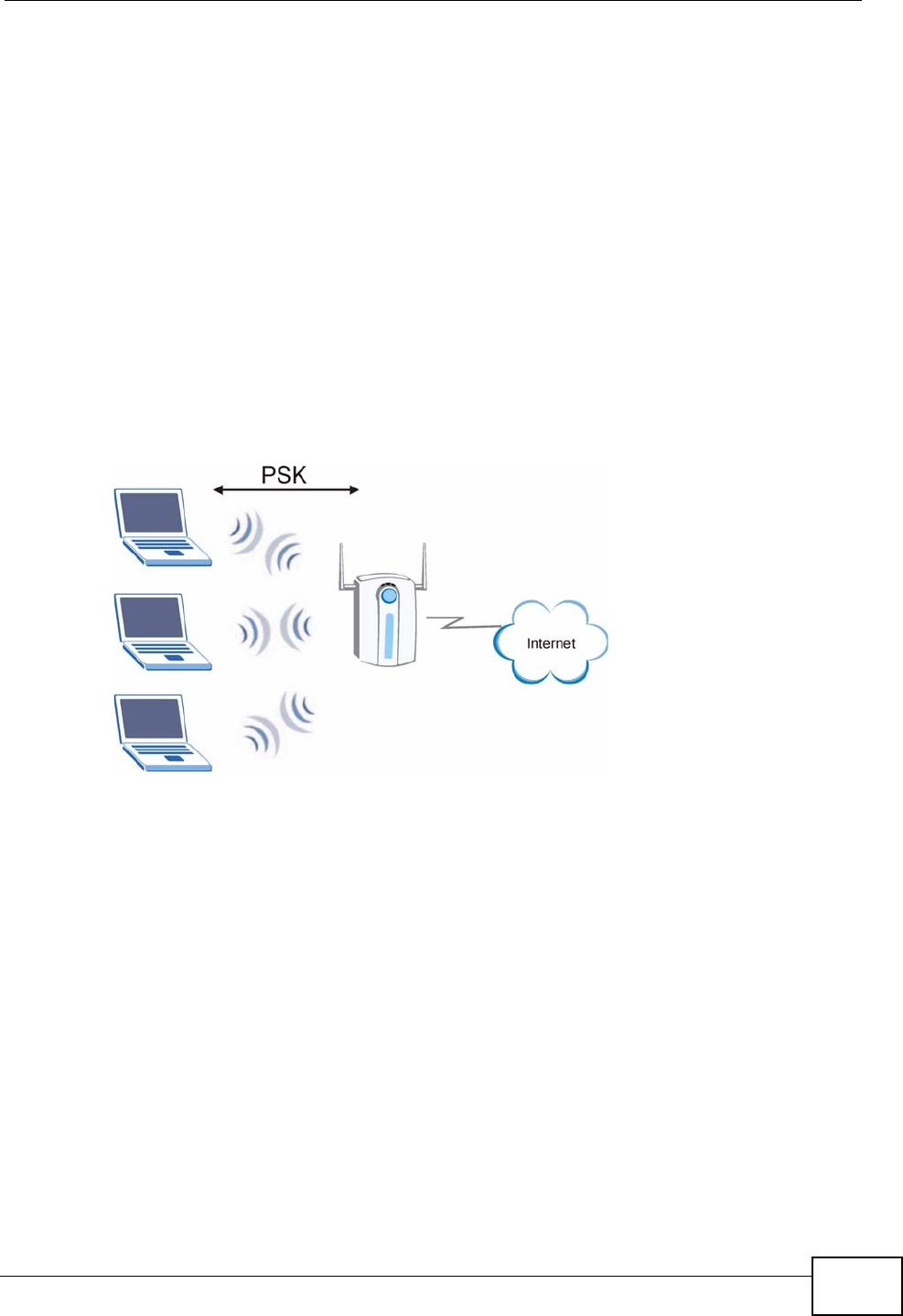
Appendix D Wireless LANs
NBG-416N User’s Guide 203
21.0.2 WPA(2)-PSK Application Example
A WPA(2)-PSK application looks as follows.
1First enter identical passwords into the AP and all wireless clients. The Pre-Shared
Key (PSK) must consist of between 8 and 63 ASCII characters (including spaces
and symbols).
2The AP checks each wireless client's password and (only) allows it to join the
network if the password matches.
3The AP derives and distributes keys to the wireless clients.
4The AP and wireless clients use the TKIP or AES encryption process to encrypt
data exchanged between them.
Figure 133 WPA(2)-PSK Authentication
21.0.3 WPA(2) with RADIUS Application Example
You need the IP address of the RADIUS server, its port number (default is 1812),
and the RADIUS shared secret. A WPA(2) application example with an external
RADIUS server looks as follows. "A" is the RADIUS server. "DS" is the distribution
system.
1The AP passes the wireless client's authentication request to the RADIUS server.
2The RADIUS server then checks the user's identification against its database and
grants or denies network access accordingly.
3The RADIUS server distributes a Pairwise Master Key (PMK) key to the AP that
then sets up a key hierarchy and management system, using the pair-wise key to
dynamically generate unique data encryption keys to encrypt every data packet
that is wirelessly communicated between the AP and the wireless clients.

Appendix D Wireless LANs
NBG-416N User’s Guide
204
Security Parameters Summary
Refer to this table to see what other security parameters you should configure for
each Authentication Method/ key management protocol type. MAC address filters
are not dependent on how you configure these security features.
Table 68 Wireless Security Relational Matrix
AUTHENTICATION
METHOD/ KEY
MANAGEMENT
PROTOCOL
ENCRYPTIO
N METHOD ENTER
MANUAL KEY IEEE 802.1X
Open None No Disable
Enable without Dynamic WEP
Key
Open WEP No Enable with Dynamic WEP
Key
Yes Enable without Dynamic WEP
Key
Yes Disable
Shared WEP No Enable with Dynamic WEP
Key
Yes Enable without Dynamic WEP
Key
Yes Disable
WPA TKIP No Enable
WPA-PSK TKIP Yes Enable
WPA2 AES No Enable
WPA2-PSK AES Yes Enable
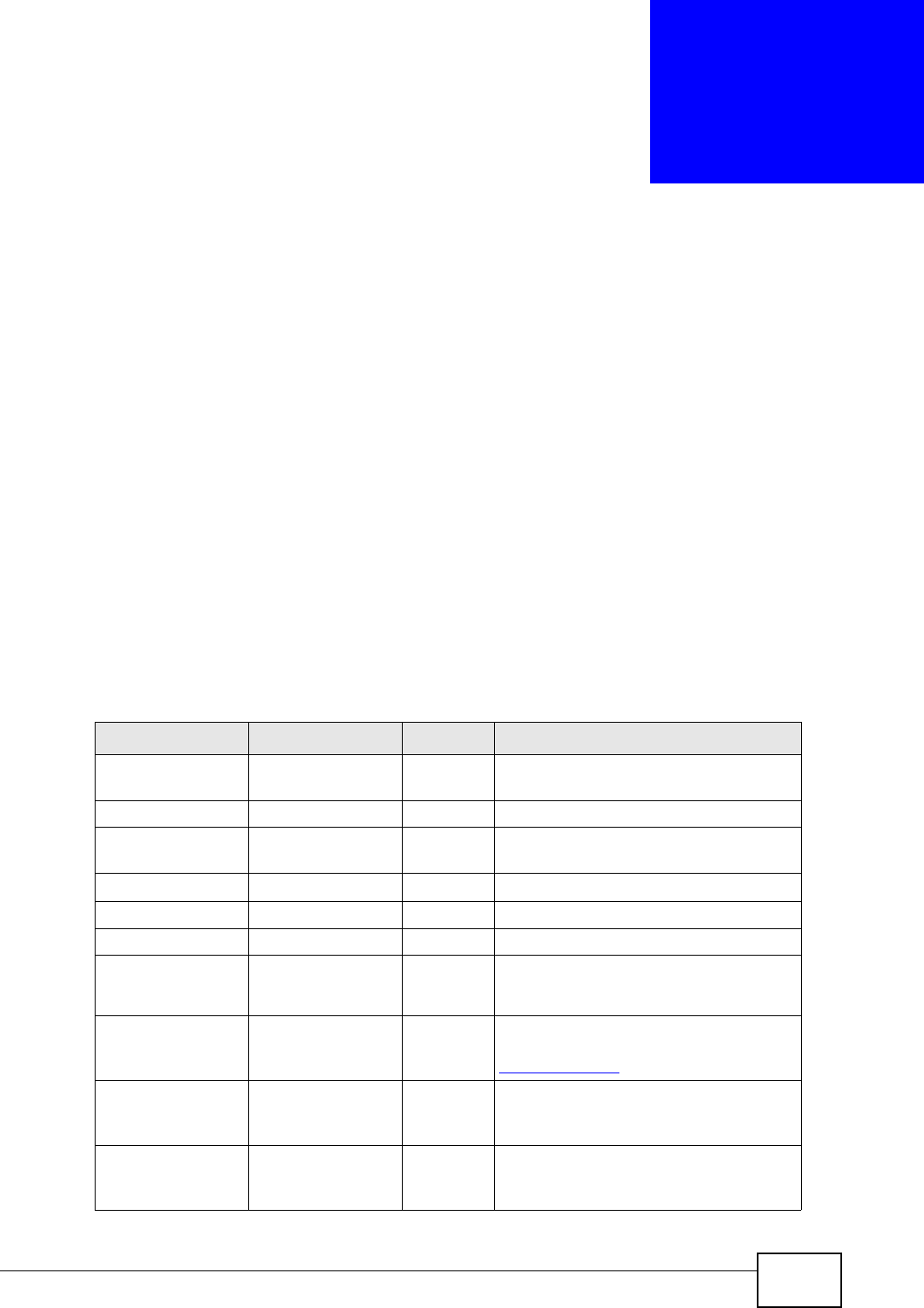
NBG-416N User’s Guide 205
APPENDIX E
Services
The following table lists some commonly-used services and their associated
protocols and port numbers.
•Name: This is a short, descriptive name for the service. You can use this one or
create a different one, if you like.
•Protocol: This is the type of IP protocol used by the service. If this is TCP/
UDP, then the service uses the same port number with TCP and UDP. If this is
User-Defined, the Port(s) is the IP protocol number, not the port number.
•Port(s): This value depends on the Protocol.
•If the Protocol is TCP, UDP, or TCP/UDP, this is the IP port number.
•If the Protocol is USER, this is the IP protocol number.
•Description: This is a brief explanation of the applications that use this service
or the situations in which this service is used.
Table 69 Examples of Services
NAME PROTOCOL PORT(S) DESCRIPTION
AH
(IPSEC_TUNNEL) User-Defined 51 The IPSEC AH (Authentication Header)
tunneling protocol uses this service.
AIM TCP 5190 AOL’s Internet Messenger service.
AUTH TCP 113 Authentication protocol used by some
servers.
BGP TCP 179 Border Gateway Protocol.
BOOTP_CLIENT UDP 68 DHCP Client.
BOOTP_SERVER UDP 67 DHCP Server.
CU-SEEME TCP/UDP
TCP/UDP
7648
24032
A popular videoconferencing solution
from White Pines Software.
DNS TCP/UDP 53 Domain Name Server, a service that
matches web names (e.g.
www.zyxel.com) to IP numbers.
ESP
(IPSEC_TUNNEL) User-Defined 50 The IPSEC ESP (Encapsulation
Security Protocol) tunneling protocol
uses this service.
FINGER TCP 79 Finger is a UNIX or Internet related
command that can be used to find out
if a user is logged on.

Appendix E Services
NBG-416N User’s Guide
206
FTP TCP
TCP
20
21
File Transfer Program, a program to
enable fast transfer of files, including
large files that may not be possible by
e-mail.
H.323 TCP 1720 NetMeeting uses this protocol.
HTTP TCP 80 Hyper Text Transfer Protocol - a client/
server protocol for the world wide
web.
HTTPS TCP 443 HTTPS is a secured http session often
used in e-commerce.
ICMP User-Defined 1Internet Control Message Protocol is
often used for diagnostic purposes.
ICQ UDP 4000 This is a popular Internet chat
program.
IGMP
(MULTICAST) User-Defined 2Internet Group Multicast Protocol is
used when sending packets to a
specific group of hosts.
IKE UDP 500 The Internet Key Exchange algorithm
is used for key distribution and
management.
IMAP4 TCP 143 The Internet Message Access Protocol
is used for e-mail.
IMAP4S TCP 993 This is a more secure version of IMAP4
that runs over SSL.
IRC TCP/UDP 6667 This is another popular Internet chat
program.
MSN Messenger TCP 1863 Microsoft Networks’ messenger
service uses this protocol.
NetBIOS TCP/UDP
TCP/UDP
TCP/UDP
TCP/UDP
137
138
139
445
The Network Basic Input/Output
System is used for communication
between computers in a LAN.
NEW-ICQ TCP 5190 An Internet chat program.
NEWS TCP 144 A protocol for news groups.
NFS UDP 2049 Network File System - NFS is a client/
server distributed file service that
provides transparent file sharing for
network environments.
NNTP TCP 119 Network News Transport Protocol is
the delivery mechanism for the
USENET newsgroup service.
PING User-Defined 1Packet INternet Groper is a protocol
that sends out ICMP echo requests to
test whether or not a remote host is
reachable.
Table 69 Examples of Services (continued)
NAME PROTOCOL PORT(S) DESCRIPTION

Appendix E Services
NBG-416N User’s Guide 207
POP3 TCP 110 Post Office Protocol version 3 lets a
client computer get e-mail from a
POP3 server through a temporary
connection (TCP/IP or other).
POP3S TCP 995 This is a more secure version of POP3
that runs over SSL.
PPTP TCP 1723 Point-to-Point Tunneling Protocol
enables secure transfer of data over
public networks. This is the control
channel.
PPTP_TUNNEL
(GRE) User-Defined 47 PPTP (Point-to-Point Tunneling
Protocol) enables secure transfer of
data over public networks. This is the
data channel.
RCMD TCP 512 Remote Command Service.
REAL_AUDIO TCP 7070 A streaming audio service that
enables real time sound over the web.
REXEC TCP 514 Remote Execution Daemon.
RLOGIN TCP 513 Remote Login.
ROADRUNNER TCP/UDP 1026 This is an ISP that provides services
mainly for cable modems.
RTELNET TCP 107 Remote Telnet.
RTSP TCP/UDP 554 The Real Time Streaming (media
control) Protocol (RTSP) is a remote
control for multimedia on the
Internet.
SFTP TCP 115 The Simple File Transfer Protocol is an
old way of transferring files between
computers.
SMTP TCP 25 Simple Mail Transfer Protocol is the
message-exchange standard for the
Internet. SMTP enables you to move
messages from one e-mail server to
another.
SMTPS TCP 465 This is a more secure version of SMTP
that runs over SSL.
SNMP TCP/UDP 161 Simple Network Management
Program.
SNMP-TRAPS TCP/UDP 162 Traps for use with the SNMP
(RFC:1215).
SQL-NET TCP 1521 Structured Query Language is an
interface to access data on many
different types of database systems,
including mainframes, midrange
systems, UNIX systems and network
servers.
Table 69 Examples of Services (continued)
NAME PROTOCOL PORT(S) DESCRIPTION

Appendix E Services
NBG-416N User’s Guide
208
SSDP UDP 1900 The Simple Service Discovery Protocol
supports Universal Plug-and-Play
(UPnP).
SSH TCP/UDP 22 Secure Shell Remote Login Program.
STRM WORKS UDP 1558 Stream Works Protocol.
SYSLOG UDP 514 Syslog allows you to send system logs
to a UNIX server.
TACACS UDP 49 Login Host Protocol used for (Terminal
Access Controller Access Control
System).
TELNET TCP 23 Telnet is the login and terminal
emulation protocol common on the
Internet and in UNIX environments. It
operates over TCP/IP networks. Its
primary function is to allow users to
log into remote host systems.
TFTP UDP 69 Trivial File Transfer Protocol is an
Internet file transfer protocol similar
to FTP, but uses the UDP (User
Datagram Protocol) rather than TCP
(Transmission Control Protocol).
VDOLIVE TCP
UDP
7000
user-
defined
A videoconferencing solution. The UDP
port number is specified in the
application.
Table 69 Examples of Services (continued)
NAME PROTOCOL PORT(S) DESCRIPTION

NBG-416N User’s Guide 209
APPENDIX F
Open Software Announcements
End-User License Agreement for “NBG416N”
WARNING: ZyXEL Communications Corp. IS WILLING TO LICENSE THE
SOFTWARE TO YOU ONLY UPON THE CONDITION THAT YOU ACCEPT ALL OF THE
TERMS CONTAINED IN THIS LICENSE AGREEMENT. PLEASE READ THE TERMS
CAREFULLY BEFORE COMPLETING THE INSTALLATION PROCESS AS INSTALLING
THE SOFTWARE WILL INDICATE YOUR ASSENT TO THEM. IF YOU DO NOT AGREE
TO THESE TERMS, THEN ZyXEL IS UNWILLING TO LICENSE THE SOFTWARE TO
YOU, IN WHICH EVENT YOU SHOULD RETURN THE UNINSTALLED SOFTWARE AND
PACKAGING TO THE PLACE FROM WHICH IT WAS ACQUIRED OR ZyXEL, AND
YOUR MONEY WILL BE REFUNDED. HOWEVER, CERTAIN ZYXEL'S PRODUCTS MAY
CONTAIN-IN PART-SOME THIRD PARTY'S FREE AND OPEN SOFTWARE PROGRAMS
WHICH ALLOW YOU TO FREELY COPY, RUN, DISTRIBUTE, MODIFY AND IMPROVE
THE SOFTWARE UNDER THE APPLICABLE TERMS OF SUCH THRID PARTY'S
LICENSES ("OPEN-SOURCED COMPONENTS"). THE OPEN-SOURCED
COMPONENTS ARE LISTED IN THE NOTICE OR APPENDIX BELOW. ZYXEL MAY
HAVE DISTRIBUTED TO YOU HARDWARE AND/OR SOFTWARE, OR MADE
AVAILABLE FOR ELECTRONIC DOWNLOADS THESE FREE SOFTWARE PROGRAMS
OF THRID PARTIES AND YOU ARE LICENSED TO FREELY COPY, MODIFY AND
REDISTIBUTE THAT SOFTWARE UNDER THE APPLICABLE LICENSE TERMS OF
SUCH THIRD PARTY. NONE OF THE STATEMENTS OR DOCUMENTATION FROM
ZYXEL INCLUDING ANY RESTRICTIONS OR CONDITIONS STATED IN THIS END
USER LICENSE AGREEMENT SHALL RESTRICT ANY RIGHTS AND LICENSES YOU
MAY HAVE WITH RESPECT TO THE OPEN-SOURCED COMPONENTS UNDER THE
APPLICABLE LICENSE TERMS OF SUCH THIRD PARTY.
1.Grant of License for Personal Use
ZyXEL Communications Corp. ("ZyXEL") grants you a non-exclusive, non-
sublicense, non-transferable license to use the program with which this license is
distributed (the "Software"), including any documentation files accompanying the
Software ("Documentation"), for internal business use only, for up to the number
of users specified in sales order and invoice. You have the right to make one
backup copy of the Software and Documentation solely for archival, back-up or
disaster recovery purposes. You shall not exceed the scope of the license granted

Appendix F Open Software Announcements
NBG-416N User’s Guide
210
hereunder. Any rights not expressly granted by ZyXEL to you are reserved by
ZyXEL, and all implied licenses are disclaimed.
2.Ownership
You have no ownership rights in the Software. Rather, you have a license to use
the Software as long as this License Agreement remains in full force and effect.
Ownership of the Software, Documentation and all intellectual property rights
therein shall remain at all times with ZyXEL. Any other use of the Software by any
other entity is strictly forbidden and is a violation of this License Agreement.
3.Copyright
The Software and Documentation contain material that is protected by
international copyright law, trade secret law, international treaty provisions, and
the applicable national laws of each respective country. All rights not granted to
you herein are expressly reserved by ZyXEL. You may not remove any proprietary
notice of ZyXEL or any of its licensors from any copy of the Software or
Documentation.
4.Restrictions
You may not publish, display, disclose, sell, rent, lease, modify, store, loan,
distribute, or create derivative works of the Software, or any part thereof. You
may not assign, sublicense, convey or otherwise transfer, pledge as security or
otherwise encumber the rights and licenses granted hereunder with respect to the
Software. ZyXEL is not obligated to provide any maintenance, technical or other
support for the resultant modified Software. You may not copy, reverse engineer,
decompile, reverse compile, translate, adapt, or disassemble the Software, or any
part thereof, nor shall you attempt to create the source code from the object code
for the Software. Except as and only to the extent expressly permitted in this
License, you may not market, co-brand, and private label or otherwise permit
third parties to link to the Software, or any part thereof. You may not use the
Software, or any part thereof, in the operation of a service bureau or for the
benefit of any other person or entity. You may not cause, assist or permit any
third party to do any of the foregoing. Portions of the Software utilize or include
third party software and other copyright material. Acknowledgements, licensing
terms and disclaimers for such material are contained in the License Notice as
below for the third party software, and your use of such material is exclusively
governed by their respective terms. ZyXEL has provided, as part of the Software
package, access to certain third party software as a convenience. To the extent
that the Software contains third party software, ZyXEL has no express or implied
obligation to provide any technical or other support for such software other than
compliance with the applicable license terms of such third party, and makes no
warranty (express, implied or statutory) whatsoever with respect thereto. Please
contact the appropriate software vendor or manufacturer directly for technical
support and customer service related to its software and products.

Appendix F Open Software Announcements
NBG-416N User’s Guide 211
5.Confidentiality
You acknowledge that the Software contains proprietary trade secrets of ZyXEL
and you hereby agree to maintain the confidentiality of the Software using at least
as great a degree of care as you use to maintain the confidentiality of your own
most confidential information. You agree to reasonably communicate the terms
and conditions of this License Agreement to those persons employed by you who
come into contact with the Software, and to use reasonable best efforts to ensure
their compliance with such terms and conditions, including, without limitation, not
knowingly permitting such persons to use any portion of the Software for the
purpose of deriving the source code of the Software.
6.No Warranty
THE SOFTWARE IS PROVIDED "AS IS." TO THE MAXIMUM EXTENT PERMITTED BY
LAW, ZyXEL DISCLAIMS ALL WARRANTIES OF ANY KIND, EITHER EXPRESSED OR
IMPLIED, INCLUDING, WITHOUT LIMITATION, IMPLIED WARRANTIES OF
MERCHANTABILITY AND FITNESS FOR A PARTICULAR PURPOSE, AND NON-
INFRINGEMENT. ZyXEL DOES NOT WARRANT THAT THE FUNCTIONS CONTAINED
IN THE SOFTWARE WILL MEET ANY REQUIREMENTS OR NEEDS YOU MAY HAVE,
OR THAT THE SOFTWARE WILL OPERATE ERROR FREE, OR IN AN UNINTERUPTED
FASHION, OR THAT ANY DEFECTS OR ERRORS IN THE SOFTWARE WILL BE
CORRECTED, OR THAT THE SOFTWARE IS COMPATIBLE WITH ANY PARTICULAR
PLATFORM. SOME JURISDICTIONS DO NOT ALLOW THE WAIVER OR EXCLUSION
OF IMPLIED WARRANTIES SO THEY MAY NOT APPLY TO YOU. IF THIS EXCLUSION
IS HELD TO BE UNENFORCEABLE BY A COURT OF COMPETENT JURISDICTION,
THEN ALL EXPRESS AND IMPLIED WARRANTIES SHALL BE LIMITED IN DURATION
TO A PERIOD OF THIRTY (30) DAYS FROM THE DATE OF PURCHASE OF THE
SOFTWARE, AND NO WARRANTIES SHALL APPLY AFTER THAT PERIOD.
7.Limitation of Liability
IN NO EVENT WILL ZyXEL BE LIABLE TO YOU OR ANY THIRD PARTY FOR ANY
INCIDENTAL OR CONSEQUENTIAL DAMAGES (INCLUDING, WITHOUT LIMITATION,
INDIRECT, SPECIAL, PUNITIVE, OR EXEMPLARY DAMAGES FOR LOSS OF
BUSINESS, LOSS OF PROFITS, BUSINESS INTERRUPTION, OR LOSS OF BUSINESS
INFORMATION) ARISING OUT OF THE USE OF OR INABILITY TO USE THE
SOFTWARE OR PROGRAM, OR FOR ANY CLAIM BY ANY OTHER PARTY, EVEN IF
ZyXEL HAS BEEN ADVISED OF THE POSSIBILITY OF SUCH DAMAGES. ZyXEL's
TOTAL AGGREGATE LIABILITY WITH RESPECT TO ITS OBLIGATIONS UNDER THIS
AGREEMENT OR OTHERWISE WITH RESPECT TO THE SOFTWARE AND
DOCUMENTATION OR OTHERWISE SHALL BE EQUAL TO THE PURCHASE PRICE,
BUT SHALL IN NO EVENT EXCEED THE PRODUCT'S PRICE. BECAUSE SOME
STATES/COUNTRIES DO NOT ALLOW THE EXCLUSION OR LIMITATION OF
LIABILITY FOR CONSEQUENTIAL OR INCIDENTAL DAMAGES, THE ABOVE
LIMITATION MAY NOT APPLY TO YOU.

Appendix F Open Software Announcements
NBG-416N User’s Guide
212
8.Export Restrictions
THIS LICENSE AGREEMENT IS EXPRESSLY MADE SUBJECT TO ANY APPLICABLE
LAWS, REGULATIONS, ORDERS, OR OTHER RESTRICTIONS ON THE EXPORT OF
THE SOFTWARE OR INFORMATION ABOUT SUCH SOFTWARE WHICH MAY BE
IMPOSED FROM TIME TO TIME. YOU SHALL NOT EXPORT THE SOFTWARE,
DOCUMENTATION OR INFORMATION ABOUT THE SOFTWARE AND
DOCUMENTATION WITHOUT COMPLYING WITH SUCH LAWS, REGULATIONS,
ORDERS, OR OTHER RESTRICTIONS. YOU AGREE TO INDEMNIFY ZyXEL AGAINST
ALL CLAIMS, LOSSES, DAMAGES, LIABILITIES, COSTS AND EXPENSES,
INCLUDING REASONABLE ATTORNEYS' FEES, TO THE EXTENT SUCH CLAIMS
ARISE OUT OF ANY BREACH OF THIS SECTION 8.
9.Audit Rights
ZyXEL SHALL HAVE THE RIGHT, AT ITS OWN EXPENSE, UPON REASONABLE PRIOR
NOTICE, TO PERIODICALLY INSPECT AND AUDIT YOUR RECORDS TO ENSURE
YOUR COMPLIANCE WITH THE TERMS AND CONDITIONS OF THIS LICENSE
AGREEMENT.
10.Termination
This License Agreement is effective until it is terminated. You may terminate this
License Agreement at any time by destroying or returning to ZyXEL all copies of
the Software and Documentation in your possession or under your control. ZyXEL
may terminate this License Agreement for any reason, including, but not limited
to, if ZyXEL finds that you have violated any of the terms of this License
Agreement. Upon notification of termination, you agree to destroy or return to
ZyXEL all copies of the Software and Documentation and to certify in writing that
all known copies, including backup copies, have been destroyed. All provisions
relating to confidentiality, proprietary rights, and non-disclosure shall survive the
termination of this Software License Agreement.
11.General
This License Agreement shall be construed, interpreted and governed by the laws
of Republic of China without regard to conflicts of laws provisions thereof. The
exclusive forum for any disputes arising out of or relating to this License
Agreement shall be an appropriate court or Commercial Arbitration Association
sitting in ROC, Taiwan if the parties agree to a binding arbitration. This License
Agreement shall constitute the entire Agreement between the parties hereto. This
License Agreement, the rights granted hereunder, the Software and
Documentation shall not be assigned by you without the prior written consent of
ZyXEL. Any waiver or modification of this License Agreement shall only be
effective if it is in writing and signed by both parties hereto. If any part of this
License Agreement is found invalid or unenforceable by a court of competent

Appendix F Open Software Announcements
NBG-416N User’s Guide 213
jurisdiction, the remainder of this License Agreement shall be interpreted so as to
reasonably effect the intention of the parties.
NOTE: Some components of this product incorporate free software programs
covered under the open source code licenses which allows you to freely copy,
modify and redistribute the software. For at least three (3) years from the date of
distribution of the applicable product or software, we will give to anyone who
contacts us at the ZyXEL Technical Support (support@zyxel.com.tw), for a charge
of no more than our cost of physically performing source code distribution, a
complete machine-readable copy of the complete corresponding source code for
the version of the Programs that we distributed to you if we are in possession of
such.
Notice
Information herein is subject to change without notice. Companies, names, and
data used in examples herein are fictitious unless otherwise noted. No part may
be reproduced or transmitted in any form or by any means, electronic or
mechanical, for any purpose, except the express written permission of ZyXEL
Communications Corporation.
This Product includes Linux Kernel , Busybox, dnsmasq, iptables, wireless_tools,
Pptp-client and igmpproxy software under GPL 2.0 license.
GNU GENERAL PUBLIC LICENSE
Version 2, June 1991
Copyright (C) 1989, 1991 Free Software Foundation, Inc.
59 Temple Place - Suite 330, Boston, MA 02111-1307, USA
Everyone is permitted to copy and distribute verbatim copies of this license
document, but changing it is not allowed.

Appendix F Open Software Announcements
NBG-416N User’s Guide
214
Preamble
The licenses for most software are designed to take away your freedom to share
and change it. By contrast, the GNU General Public License is intended to
guarantee your freedom to share and change free software--to make sure the
software is free for all its users. This General Public License applies to most of the
Free Software Foundation's software and to any other program whose authors
commit to using it. (Some other Free Software Foundation software is covered by
the GNU Library General Public License instead.) You can apply it to your
programs, too.
When we speak of free software, we are referring to freedom, not price. Our
General Public Licenses are designed to make sure that you have the freedom to
distribute copies of free software (and charge for this service if you wish), that you
receive source code or can get it if you want it, that you can change the software
or use pieces of it in new free programs; and that you know you can do these
things.
To protect your rights, we need to make restrictions that forbid anyone to deny
you these rights or to ask you to surrender the rights. These restrictions translate
to certain responsibilities for you if you distribute copies of the software, or if you
modify it. For example, if you distribute copies of such a program, whether gratis
or for a fee, you must give the recipients all the rights that you have. You must
make sure that they, too, receive or can get the source code. And you must show
them these terms so they know their rights.
We protect your rights with two steps: (1) copyright the software, and (2) offer
you this license which gives you legal permission to copy, distribute and/or modify
the software. Also, for each author's protection and ours, we want to make certain
that everyone understands that there is no warranty for this free software. If the
software is modified by someone else and passed on, we want its recipients to
know that what they have is not the original, so that any problems introduced by
others will not reflect on the original authors' reputations.
Finally, any free program is threatened constantly by software patents. We wish to
avoid the danger that redistributors of a free program will individually obtain
patent licenses, in effect making the program proprietary. To prevent this, we
have made it clear that any patent must be licensed for everyone's free use or not
licensed at all.
The precise terms and conditions for copying, distribution and modification follow.
TERMS AND CONDITIONS FOR COPYING, DISTRIBUTION AND MODIFICATION

Appendix F Open Software Announcements
NBG-416N User’s Guide 215
0. This License applies to any program or other work which contains a notice
placed by the copyright holder saying it may be distributed under the terms of this
General Public License. The "Program", below, refers to any such program or
work, and a "work based on the Program" means either the Program or any
derivative work under copyright law: that is to say, a work containing the Program
or a portion of it, either verbatim or with modifications and/or translated into
another language. (Hereinafter, translation is included without limitation in the
term "modification".) Each licensee is addressed as "you". Activities other than
copying, distribution and modification are not covered by this License; they are
outside its scope. The act of running the Program is not restricted, and the output
from the Program is covered only if its contents constitute a work based on the
Program (independent of having been made by running the Program). Whether
that is true depends on what the Program does.
1. You may copy and distribute verbatim copies of the Program's source code as
you receive it, in any medium, provided that you conspicuously and appropriately
publish on each copy an appropriate copyright notice and disclaimer of warranty;
keep intact all the notices that refer to this License and to the absence of any
warranty; and give any other recipients of the Program a copy of this License
along with the Program. You may charge a fee for the physical act of transferring a
copy, and you may at your option offer warranty protection in exchange for a fee.
2. You may modify your copy or copies of the Program or any portion of it, thus
forming a work based on the Program, and copy and distribute such modifications
or work under the terms of Section 1 above, provided that you also meet all of
these conditions:
a) You must cause the modified files to carry prominent notices stating that you
changed the files and the date of any change.
b) You must cause any work that you distribute or publish, that in whole or in part
contains or is derived from the Program or any part thereof, to be licensed as a
whole at no charge to all third parties under the terms of this License.
c) If the modified program normally reads commands interactively when run, you
must cause it, when started running for such interactive use in the most ordinary
way, to print or display an announcement including an appropriate copyright
notice and a notice that there is no warranty (or else, saying that you provide a
warranty) and that users may redistribute the program under these conditions,
and telling the user how to view a copy of this License. (Exception: if the Program
itself is interactive but does not normally print such an announcement, your work
based on the Program is not required to print an announcement.)
These requirements apply to the modified work as a whole. If identifiable sections
of that work are not derived from the Program, and can be reasonably considered
independent and separate works in themselves, then this License, and its terms,
do not apply to those sections when you distribute them as separate works. But

Appendix F Open Software Announcements
NBG-416N User’s Guide
216
when you distribute the same sections as part of a whole which is a work based on
the Program, the distribution of the whole must be on the terms of this License,
whose permissions for other licensees extend to the entire whole, and thus to
each and every part regardless of who wrote it. Thus, it is not the intent of this
section to claim rights or contest your rights to work written entirely by you;
rather, the intent is to exercise the right to control the distribution of derivative or
collective works based on the Program. In addition, mere aggregation of another
work not based on the Program with the Program (or with a work based on the
Program) on a volume of a storage or distribution medium does not bring the
other work under the scope of this License.
3. You may copy and distribute the Program (or a work based on it, under Section
2) in object code or executable form under the terms of Sections 1 and 2 above
provided that you also do one of the following:
a) Accompany it with the complete corresponding machine-readable source code,
which must be distributed under the terms of Sections 1 and 2 above on a
medium customarily used for software interchange; or,
b) Accompany it with a written offer, valid for at least three years, to give any
third party, for a charge no more than your cost of physically performing source
distribution, a complete machine-readable copy of the corresponding source code,
to be distributed under the terms of Sections 1 and 2 above on a medium
customarily used for software interchange; or, c) Accompany it with the
information you received as to the offer to distribute corresponding source code.
(This alternative is allowed only for noncommercial distribution and only if you
received the program in object code or executable form with such an offer, in
accord with Subsection b above.) The source code for a work means the preferred
form of the work for making modifications to it. For an executable work, complete
source code means all the source code for all modules it contains, plus any
associated interface definition files, plus the scripts used to control compilation
and installation of the executable. However, as a special exception, the source
code distributed need not include anything that is normally distributed (in either
source or binary form) with the major components (compiler, kernel, and so on) of
the operating system on which the executable runs, unless that component itself
accompanies the executable. If distribution of executable or object code is made
by offering access to copy from a designated place, then offering equivalent
access to copy the source code from the same place counts as distribution of the
source code, even though third parties are not compelled to copy the source along
with the object code.
4. You may not copy, modify, sublicense, or distribute the Program except as
expressly provided under this License. Any attempt otherwise to copy, modify,
sublicense or distribute the Program is void, and will automatically terminate your
rights under this License. However, parties who have received copies, or rights,
from you under this License will not have their licenses terminated so long as such
parties remain in full compliance.

Appendix F Open Software Announcements
NBG-416N User’s Guide 217
5. You are not required to accept this License, since you have not signed it.
However, nothing else grants you permission to modify or distribute the Program
or its derivative works. These actions are prohibited by law if you do not accept
this License. Therefore, by modifying or distributing the Program (or any work
based on the Program), you indicate your acceptance of this License to do so, and
all its terms and conditions for copying, distributing or modifying the Program or
works based on it.
6. Each time you redistribute the Program (or any work based on the Program),
the recipient automatically receives a license from the original licensor to copy,
distribute or modify the Program subject to these terms and conditions. You may
not impose any further restrictions on the recipients' exercise of the rights granted
herein. You are not responsible for enforcing compliance by third parties to this
License.
7. If, as a consequence of a court judgment or allegation of patent infringement or
for any other reason (not limited to patent issues), conditions are imposed on you
(whether by court order, agreement or otherwise) that contradict the conditions of
this License, they do not excuse you from the conditions of this License. If you
cannot distribute so as to satisfy simultaneously your obligations under this
License and any other pertinent obligations, then as a consequence you may not
distribute the Program at all. For example, if a patent license would not permit
royalty-free redistribution of the Program by all those who receive copies directly
or indirectly through you, then the only way you could satisfy both it and this
License would be to refrain entirely from distribution of the Program. If any
portion of this section is held invalid or unenforceable under any particular
circumstance, the balance of the section is intended to apply and the section as a
whole is intended to apply in other circumstances. It is not the purpose of this
section to induce you to infringe any patents or other property right claims or to
contest validity of any such claims; this section has the sole purpose of protecting
the integrity of the free software distribution system, which is implemented by
public license practices. Many people have made generous contributions to the
wide range of software distributed through that system in reliance on consistent
application of that system; it is up to the author/donor to decide if he or she is
willing to distribute software through any other system and a licensee cannot
impose that choice. This section is intended to make thoroughly clear what is
believed to be a consequence of the rest of this License.
8. If the distribution and/or use of the Program is restricted in certain countries
either by patents or by copyrighted interfaces, the original copyright holder who
places the Program under this License may add an explicit geographical
distribution limitation excluding those countries, so that distribution is permitted
only in or among countries not thus excluded. In such case, this License
incorporates the limitation as if written in the body of this License.
9. The Free Software Foundation may publish revised and/or new versions of the
General Public License from time to time. Such new versions will be similar in

Appendix F Open Software Announcements
NBG-416N User’s Guide
218
spirit to the present version, but may differ in detail to address new problems or
concerns. Each version is given a distinguishing version number. If the Program
specifies a version number of this License which applies to it and "any later
version", you have the option of following the terms and conditions either of that
version or of any later version published by the Free Software Foundation. If the
Program does not specify a version number of this License, you may choose any
version ever published by the Free Software Foundation.
10. If you wish to incorporate parts of the Program into other free programs
whose distribution conditions are different, write to the author to ask for
permission. For software which is copyrighted by the Free Software Foundation,
write to the Free Software Foundation; we sometimes make exceptions for this.
Our decision will be guided by the two goals of preserving the free status of all
derivatives of our free software and of promoting the sharing and reuse of
software generally.
NO WARRANTY
11. BECAUSE THE PROGRAM IS LICENSED FREE OF CHARGE, THERE IS NO
WARRANTY FOR THE PROGRAM, TO THE EXTENT PERMITTED BY APPLICABLE LAW.
EXCEPT WHEN OTHERWISE STATED IN WRITING THE COPYRIGHT HOLDERS AND/
OR OTHER PARTIES PROVIDE THE PROGRAM "AS IS" WITHOUT WARRANTY OF
ANY KIND, EITHER EXPRESSED OR IMPLIED, INCLUDING, BUT NOT LIMITED TO,
THE IMPLIED WARRANTIES OF MERCHANTABILITY AND FITNESS FOR A
PARTICULAR PURPOSE. THE ENTIRE RISK AS TO THE QUALITY AND
PERFORMANCE OF THE PROGRAM IS WITH YOU. SHOULD THE PROGRAM PROVE
DEFECTIVE, YOU ASSUME THE COST OF ALL NECESSARY SERVICING, REPAIR OR
CORRECTION.
12. IN NO EVENT UNLESS REQUIRED BY APPLICABLE LAW OR AGREED TO IN
WRITING WILL ANY COPYRIGHT HOLDER, OR ANY OTHER PARTY WHO MAY
MODIFY AND/OR REDISTRIBUTE THE PROGRAM AS PERMITTED ABOVE, BE
LIABLE TO YOU FOR DAMAGES, INCLUDING ANY GENERAL, SPECIAL, INCIDENTAL
OR CONSEQUENTIAL DAMAGES ARISING OUT OF THE USE OR INABILITY TO USE
THE PROGRAM (INCLUDING BUT NOT LIMITED TO LOSS OF DATA OR DATA BEING
RENDERED INACCURATE OR LOSSES SUSTAINED BY YOU OR THIRD PARTIES OR
A FAILURE OF THE PROGRAM TO OPERATE WITH ANY OTHER PROGRAMS), EVEN
IF SUCH HOLDER OR OTHER PARTY HAS BEEN ADVISED OF THE POSSIBILITY OF
SUCH DAMAGES.
END OF TERMS AND CONDITIONS
All other trademarks or trade names mentioned herein, if any, are the property of
their respective owners.

Appendix F Open Software Announcements
NBG-416N User’s Guide 219
This Product includes ppp software under below license
Copyrights:
***********
All of the code can be freely used and redistributed. The individual source files
each have their own copyright and permission notice. Pppd, pppstats and
pppdump are under BSD-style notices. Some of the pppd plugins are GPL'd. Chat
is public domain.
This Product includes mini_upnp software under below license
Copyright (c) 2005-2008, Thomas BERNARD
All rights reserved.
Redistribution and use in source and binary forms, with or without
modification, are permitted provided that the following conditions are met:
* Redistributions of source code must retain the above copyright notice,
this list of conditions and the following disclaimer.
* Redistributions in binary form must reproduce the above copyright notice,
this list of conditions and the following disclaimer in the documentation
and/or other materials provided with the distribution.
* The name of the author may not be used to endorse or promote products
derived from this software without specific prior written permission.
THIS SOFTWARE IS PROVIDED BY THE COPYRIGHT HOLDERS AND
CONTRIBUTORS "AS IS" AND ANY EXPRESS OR IMPLIED WARRANTIES,
INCLUDING, BUT NOT LIMITED TO, THE IMPLIED WARRANTIES OF
MERCHANTABILITY AND FITNESS FOR A PARTICULAR PURPOSE ARE DISCLAIMED.

Appendix F Open Software Announcements
NBG-416N User’s Guide
220
IN NO EVENT SHALL THE COPYRIGHT OWNER OR CONTRIBUTORS BE LIABLE FOR
ANY DIRECT, INDIRECT, INCIDENTAL, SPECIAL, EXEMPLARY, OR CONSEQUENTIAL
DAMAGES (INCLUDING, BUT NOT LIMITED TO, PROCUREMENT OF SUBSTITUTE
GOODS OR SERVICES; LOSS OF USE, DATA, OR PROFITS; OR BUSINESS
INTERRUPTION) HOWEVER CAUSED AND ON ANY THEORY OF LIABILITY,
WHETHER IN CONTRACT, STRICT LIABILITY, OR TORT (INCLUDING NEGLIGENCE
OR OTHERWISE) ARISING IN ANY WAY OUT OF THE USE OF THIS SOFTWARE,
EVEN IF ADVISED OF THE POSSIBILITY OF SUCH DAMAGE.
This Product includes igmpproxy software under below license
igmpproxy - IGMP proxy based multicast router
Copyright (C) 2005 Johnny Egeland <johnny@rlo.org>
This program is free software; you can redistribute it and/or modify
it under the terms of the GNU General Public License as published by
the Free Software Foundation; either version 2 of the License, or
(at your option) any later version.
This program is distributed in the hope that it will be useful,
but WITHOUT ANY WARRANTY; without even the implied warranty of
MERCHANTABILITY or FITNESS FOR A PARTICULAR PURPOSE. See the
GNU General Public License for more details.
You should have received a copy of the GNU General Public License
along with this program; if not, write to the Free Software
Foundation, Inc., 59 Temple Place, Suite 330, Boston, MA 02111-1307 USA

Appendix F Open Software Announcements
NBG-416N User’s Guide 221
This software is derived work from the following software. The original
source code has been modified from it's original state by the author
of igmpproxy.
smcroute 0.92 - Copyright (C) 2001 Carsten Schill <carsten@cschill.de>
- Licensed under the GNU General Public License, version 2
mrouted 3.9-beta3 - COPYRIGHT 1989 by The Board of Trustees of
Leland Stanford Junior University.
- Original license can be found in the Stanford.txt file.
This Product includes uClibc software under LGPL 2.1 license
GNU LESSER GENERAL PUBLIC LICENSE
Version 2.1, February 1999
Copyright (C) 1991, 1999 Free Software Foundation, Inc.
51 Franklin Street, Fifth Floor, Boston, MA 02110-1301 USA
Everyone is permitted to copy and distribute verbatim copies
of this license document, but changing it is not allowed.
[This is the first released version of the Lesser GPL. It also counts
as the successor of the GNU Library Public License, version 2, hence
the version number 2.1.]
Preamble
The licenses for most software are designed to take away your freedom to share
and change it. By contrast, the GNU General Public Licenses are intended to

Appendix F Open Software Announcements
NBG-416N User’s Guide
222
guarantee your freedom to share and change free software--to make sure the
software is free for all its users.
This license, the Lesser General Public License, applies to some specially
designated software packages--typically libraries--of the Free Software
Foundation and other authors who decide to use it. You can use it too, but we
suggest you first think carefully about whether this license or the ordinary General
Public License is the better strategy to use in any particular case, based on the
explanations below.
When we speak of free software, we are referring to freedom of use, not price.
Our General Public Licenses are designed to make sure that you have the freedom
to distribute copies of free software (and charge for this service if you wish); that
you receive source code or can get it if you want it; that you can change the
software and use pieces of it in new free programs; and that you are informed that
you can do these things.
To protect your rights, we need to make restrictions that forbid distributors to
deny you these rights or to ask you to surrender these rights. These restrictions
translate to certain responsibilities for you if you distribute copies of the library or
if you modify it.
For example, if you distribute copies of the library, whether gratis or for a fee, you
must give the recipients all the rights that we gave you. You must make sure that
they, too, receive or can get the source code. If you link other code with the
library, you must provide complete object files to the recipients, so that they can
relink them with the library after making changes to the library and recompiling it.
And you must show them these terms so they know their rights.
We protect your rights with a two-step method: (1) we copyright the library, and
(2) we offer you this license, which gives you legal permission to copy, distribute
and/or modify the library.
To protect each distributor, we want to make it very clear that there is no warranty
for the free library. Also, if the library is modified by someone else and passed on,
the recipients should know that what they have is not the original version, so that
the original author's reputation will not be affected by problems that might be
introduced by others.
Finally, software patents pose a constant threat to the existence of any free
program. We wish to make sure that a company cannot effectively restrict the
users of a free program by obtaining a restrictive license from a patent holder.
Therefore, we insist that any patent license obtained for a version of the library
must be consistent with the full freedom of use specified in this license.
Most GNU software, including some libraries, is covered by the ordinary GNU
General Public License. This license, the GNU Lesser General Public License,

Appendix F Open Software Announcements
NBG-416N User’s Guide 223
applies to certain designated libraries, and is quite different from the ordinary
General Public License. We use this license for certain libraries in order to permit
linking those libraries into non-free programs.
When a program is linked with a library, whether statically or using a shared
library, the combination of the two is legally speaking a combined work, a
derivative of the original library. The ordinary General Public License therefore
permits such linking only if the entire combination fits its criteria of freedom. The
Lesser General Public License permits more lax criteria for linking other code with
the library.
We call this license the "Lesser" General Public License because it does Less to
protect the user's freedom than the ordinary General Public License. It also
provides other free software developers Less of an advantage over competing
non-free programs. These disadvantages are the reason we use the ordinary
General Public License for many libraries. However, the Lesser license provides
advantages in certain special circumstances.
For example, on rare occasions, there may be a special need to encourage the
widest possible use of a certain library, so that it becomes a de-facto standard. To
achieve this, non-free programs must be allowed to use the library. A more
frequent case is that a free library does the same job as widely used non-free
libraries. In this case, there is little to gain by limiting the free library to free
software only, so we use the Lesser General Public License.
In other cases, permission to use a particular library in non-free programs enables
a greater number of people to use a large body of free software. For example,
permission to use the GNU C Library in non-free programs enables many more
people to use the whole GNU operating system, as well as its variant, the GNU/
Linux operating system.
Although the Lesser General Public License is Less protective of the users'
freedom, it does ensure that the user of a program that is linked with the Library
has the freedom and the wherewithal to run that program using a modified
version of the Library.
The precise terms and conditions for copying, distribution and modification follow.
Pay close attention to the difference between a "work based on the library" and a
"work that uses the library". The former contains code derived from the library,
whereas the latter must be combined with the library in order to run.
TERMS AND CONDITIONS FOR COPYING, DISTRIBUTION AND MODIFICATION
0. This License Agreement applies to any software library or other program which
contains a notice placed by the copyright holder or other authorized party saying it
may be distributed under the terms of this Lesser General Public License (also
called "this License"). Each licensee is addressed as "you".

Appendix F Open Software Announcements
NBG-416N User’s Guide
224
A "library" means a collection of software functions and/or data prepared so as to
be conveniently linked with application programs (which use some of those
functions and data) to form executables.
The "Library", below, refers to any such software library or work which has been
distributed under these terms. A "work based on the Library" means either the
Library or any derivative work under copyright law: that is to say, a work
containing the Library or a portion of it, either verbatim or with modifications and/
or translated straightforwardly into another language. (Hereinafter, translation is
included without limitation in the term "modification".)
"Source code" for a work means the preferred form of the work for making
modifications to it. For a library, complete source code means all the source code
for all modules it contains, plus any associated interface definition files, plus the
scripts used to control compilation and installation of the library.
Activities other than copying, distribution and modification are not covered by this
License; they are outside its scope. The act of running a program using the Library
is not restricted, and output from such a program is covered only if its contents
constitute a work based on the Library (independent of the use of the Library in a
tool for writing it). Whether that is true depends on what the Library does and
what the program that uses the Library does.
1. You may copy and distribute verbatim copies of the Library's complete source
code as you receive it, in any medium, provided that you conspicuously and
appropriately publish on each copy an appropriate copyright notice and disclaimer
of warranty; keep intact all the notices that refer to this License and to the
absence of any warranty; and distribute a copy of this License along with the
Library.
You may charge a fee for the physical act of transferring a copy, and you may at
your option offer warranty protection in exchange for a fee.
2. You may modify your copy or copies of the Library or any portion of it, thus
forming a work based on the Library, and copy and distribute such modifications
or work under the terms of Section 1 above, provided that you also meet all of
these conditions:
a) The modified work must itself be a software library.
b) You must cause the files modified to carry prominent notices stating that you
changed the files and the date of any change.
c) You must cause the whole of the work to be licensed at no charge to all third
parties under the terms of this License.
d) If a facility in the modified Library refers to a function or a table of data to be
supplied by an application program that uses the facility, other than as an

Appendix F Open Software Announcements
NBG-416N User’s Guide 225
argument passed when the facility is invoked, then you must make a good faith
effort to ensure that, in the event an application does not supply such function or
table, the facility still operates, and performs whatever part of its purpose remains
meaningful.
(For example, a function in a library to compute square roots has a purpose that is
entirely well-defined independent of the application. Therefore, Subsection 2d
requires that any application-supplied function or table used by this function must
be optional: if the application does not supply it, the square root function must
still compute square roots.)
These requirements apply to the modified work as a whole. If identifiable sections
of that work are not derived from the Library, and can be reasonably considered
independent and separate works in themselves, then this License, and its terms,
do not apply to those sections when you distribute them as separate works. But
when you distribute the same sections as part of a whole which is a work based on
the Library, the distribution of the whole must be on the terms of this License,
whose permissions for other licensees extend to the entire whole, and thus to
each and every part regardless of who wrote it.
Thus, it is not the intent of this section to claim rights or contest your rights to
work written entirely by you; rather, the intent is to exercise the right to control
the distribution of derivative or collective works based on the Library.
In addition, mere aggregation of another work not based on the Library with the
Library (or with a work based on the Library) on a volume of a storage or
distribution medium does not bring the other work under the scope of this License.
3. You may opt to apply the terms of the ordinary GNU General Public License
instead of this License to a given copy of the Library. To do this, you must alter all
the notices that refer to this License, so that they refer to the ordinary GNU
General Public License, version 2, instead of to this License. (If a newer version
than version 2 of the ordinary GNU General Public License has appeared, then you
can specify that version instead if you wish.) Do not make any other change in
these notices.
Once this change is made in a given copy, it is irreversible for that copy, so the
ordinary GNU General Public License applies to all subsequent copies and
derivative works made from that copy.
This option is useful when you wish to copy part of the code of the Library into a
program that is not a library.
4. You may copy and distribute the Library (or a portion or derivative of it, under
Section 2) in object code or executable form under the terms of Sections 1 and 2
above provided that you accompany it with the complete corresponding machine-

Appendix F Open Software Announcements
NBG-416N User’s Guide
226
readable source code, which must be distributed under the terms of Sections 1
and 2 above on a medium customarily used for software interchange.
If distribution of object code is made by offering access to copy from a designated
place, then offering equivalent access to copy the source code from the same
place satisfies the requirement to distribute the source code, even though third
parties are not compelled to copy the source along with the object code.
5. A program that contains no derivative of any portion of the Library, but is
designed to work with the Library by being compiled or linked with it, is called a
"work that uses the Library". Such a work, in isolation, is not a derivative work of
the Library, and therefore falls outside the scope of this License.
However, linking a "work that uses the Library" with the Library creates an
executable that is a derivative of the Library (because it contains portions of the
Library), rather than a "work that uses the library". The executable is therefore
covered by this License. Section 6 states terms for distribution of such
executables.
When a "work that uses the Library" uses material from a header file that is part
of the Library, the object code for the work may be a derivative work of the Library
even though the source code is not. Whether this is true is especially significant if
the work can be linked without the Library, or if the work is itself a library. The
threshold for this to be true is not precisely defined by law.
If such an object file uses only numerical parameters, data structure layouts and
accessors, and small macros and small inline functions (ten lines or less in length),
then the use of the object file is unrestricted, regardless of whether it is legally a
derivative work. (Executables containing this object code plus portions of the
Library will still fall under Section 6.)
Otherwise, if the work is a derivative of the Library, you may distribute the object
code for the work under the terms of Section 6. Any executables containing that
work also fall under Section 6, whether or not they are linked directly with the
Library itself.
6. As an exception to the Sections above, you may also combine or link a "work
that uses the Library" with the Library to produce a work containing portions of
the Library, and distribute that work under terms of your choice, provided that the
terms permit modification of the work for the customer's own use and reverse
engineering for debugging such modifications.
You must give prominent notice with each copy of the work that the Library is
used in it and that the Library and its use are covered by this License. You must
supply a copy of this License. If the work during execution displays copyright
notices, you must include the copyright notice for the Library among them, as well

Appendix F Open Software Announcements
NBG-416N User’s Guide 227
as a reference directing the user to the copy of this License. Also, you must do one
of these things:
a) Accompany the work with the complete corresponding machine-readable
source code for the Library including whatever changes were used in the work
(which must be distributed under Sections 1 and 2 above); and, if the work is an
executable linked with the Library, with the complete machine-readable "work that
uses the Library", as object code and/or source code, so that the user can modify
the Library and then relink to produce a modified executable containing the
modified Library. (It is understood that the user who changes the contents of
definitions files in the Library will not necessarily be able to recompile the
application to use the modified definitions.)
b) Use a suitable shared library mechanism for linking with the Library. A suitable
mechanism is one that (1) uses at run time a copy of the library already present
on the user's computer system, rather than copying library functions into the
executable, and (2) will operate properly with a modified version of the library, if
the user installs one, as long as the modified version is interface-compatible with
the version that the work was made with.
c) Accompany the work with a written offer, valid for at least three years, to give
the same user the materials specified in Subsection 6a, above, for a charge no
more than the cost of performing this distribution.
d) If distribution of the work is made by offering access to copy from a designated
place, offer equivalent access to copy the above specified materials from the same
place.
e) Verify that the user has already received a copy of these materials or that you
have already sent this user a copy.
For an executable, the required form of the "work that uses the Library" must
include any data and utility programs needed for reproducing the executable from
it. However, as a special exception, the materials to be distributed need not
include anything that is normally distributed (in either source or binary form) with
the major components (compiler, kernel, and so on) of the operating system on
which the executable runs, unless that component itself accompanies the
executable.
It may happen that this requirement contradicts the license restrictions of other
proprietary libraries that do not normally accompany the operating system. Such a
contradiction means you cannot use both them and the Library together in an
executable that you distribute.
7. You may place library facilities that are a work based on the Library side-by-side
in a single library together with other library facilities not covered by this License,
and distribute such a combined library, provided that the separate distribution of

Appendix F Open Software Announcements
NBG-416N User’s Guide
228
the work based on the Library and of the other library facilities is otherwise
permitted, and provided that you do these two things:
a) Accompany the combined library with a copy of the same work based on the
Library, uncombined with any other library facilities. This must be distributed
under the terms of the Sections above.
b) Give prominent notice with the combined library of the fact that part of it is a
work based on the Library, and explaining where to find the accompanying
uncombined form of the same work.
8. You may not copy, modify, sublicense, link with, or distribute the Library except
as expressly provided under this License. Any attempt otherwise to copy, modify,
sublicense, link with, or distribute the Library is void, and will automatically
terminate your rights under this License. However, parties who have received
copies, or rights, from you under this License will not have their licenses
terminated so long as such parties remain in full compliance.
9. You are not required to accept this License, since you have not signed it.
However, nothing else grants you permission to modify or distribute the Library or
its derivative works. These actions are prohibited by law if you do not accept this
License. Therefore, by modifying or distributing the Library (or any work based on
the Library), you indicate your acceptance of this License to do so, and all its
terms and conditions for copying, distributing or modifying the Library or works
based on it.
10. Each time you redistribute the Library (or any work based on the Library), the
recipient automatically receives a license from the original licensor to copy,
distribute, link with or modify the Library subject to these terms and conditions.
You may not impose any further restrictions on the recipients' exercise of the
rights granted herein. You are not responsible for enforcing compliance by third
parties with this License.
11. If, as a consequence of a court judgment or allegation of patent infringement
or for any other reason (not limited to patent issues), conditions are imposed on
you (whether by court order, agreement or otherwise) that contradict the
conditions of this License, they do not excuse you from the conditions of this
License. If you cannot distribute so as to satisfy simultaneously your obligations
under this License and any other pertinent obligations, then as a consequence you
may not distribute the Library at all. For example, if a patent license would not
permit royalty-free redistribution of the Library by all those who receive copies
directly or indirectly through you, then the only way you could satisfy both it and
this License would be to refrain entirely from distribution of the Library.
If any portion of this section is held invalid or unenforceable under any particular
circumstance, the balance of the section is intended to apply, and the section as a
whole is intended to apply in other circumstances.

Appendix F Open Software Announcements
NBG-416N User’s Guide 229
It is not the purpose of this section to induce you to infringe any patents or other
property right claims or to contest validity of any such claims; this section has the
sole purpose of protecting the integrity of the free software distribution system
which is implemented by public license practices. Many people have made
generous contributions to the wide range of software distributed through that
system in reliance on consistent application of that system; it is up to the author/
donor to decide if he or she is willing to distribute software through any other
system and a licensee cannot impose that choice.
This section is intended to make thoroughly clear what is believed to be a
consequence of the rest of this License.
12. If the distribution and/or use of the Library is restricted in certain countries
either by patents or by copyrighted interfaces, the original copyright holder who
places the Library under this License may add an explicit geographical distribution
limitation excluding those countries, so that distribution is permitted only in or
among countries not thus excluded. In such case, this License incorporates the
limitation as if written in the body of this License.
13. The Free Software Foundation may publish revised and/or new versions of the
Lesser General Public License from time to time. Such new versions will be similar
in spirit to the present version, but may differ in detail to address new problems or
concerns.
Each version is given a distinguishing version number. If the Library specifies a
version number of this License which applies to it and "any later version", you
have the option of following the terms and conditions either of that version or of
any later version published by the Free Software Foundation. If the Library does
not specify a license version number, you may choose any version ever published
by the Free Software Foundation.
14. If you wish to incorporate parts of the Library into other free programs whose
distribution conditions are incompatible with these, write to the author to ask for
permission. For software which is copyrighted by the Free Software Foundation,
write to the Free Software Foundation; we sometimes make exceptions for this.
Our decision will be guided by the two goals of preserving the free status of all
derivatives of our free software and of promoting the sharing and reuse of
software generally.
NO WARRANTY
15. BECAUSE THE LIBRARY IS LICENSED FREE OF CHARGE, THERE IS NO
WARRANTY FOR THE LIBRARY, TO THE EXTENT PERMITTED BY APPLICABLE LAW.
EXCEPT WHEN OTHERWISE STATED IN WRITING THE COPYRIGHT HOLDERS AND/
OR OTHER PARTIES PROVIDE THE LIBRARY "AS IS" WITHOUT WARRANTY OF ANY
KIND, EITHER EXPRESSED OR IMPLIED, INCLUDING, BUT NOT LIMITED TO, THE
IMPLIED WARRANTIES OF MERCHANTABILITY AND FITNESS FOR A PARTICULAR

Appendix F Open Software Announcements
NBG-416N User’s Guide
230
PURPOSE. THE ENTIRE RISK AS TO THE QUALITY AND PERFORMANCE OF THE
LIBRARY IS WITH YOU. SHOULD THE LIBRARY PROVE DEFECTIVE, YOU ASSUME
THE COST OF ALL NECESSARY SERVICING, REPAIR OR CORRECTION.
16. IN NO EVENT UNLESS REQUIRED BY APPLICABLE LAW OR AGREED TO IN
WRITING WILL ANY COPYRIGHT HOLDER, OR ANY OTHER PARTY WHO MAY
MODIFY AND/OR REDISTRIBUTE THE LIBRARY AS PERMITTED ABOVE, BE LIABLE
TO YOU FOR DAMAGES, INCLUDING ANY GENERAL, SPECIAL, INCIDENTAL OR
CONSEQUENTIAL DAMAGES ARISING OUT OF THE USE OR INABILITY TO USE THE
LIBRARY (INCLUDING BUT NOT LIMITED TO LOSS OF DATA OR DATA BEING
RENDERED INACCURATE OR LOSSES SUSTAINED BY YOU OR THIRD PARTIES OR
A FAILURE OF THE LIBRARY TO OPERATE WITH ANY OTHER SOFTWARE), EVEN IF
SUCH HOLDER OR OTHER PARTY HAS BEEN ADVISED OF THE POSSIBILITY OF
SUCH DAMAGES.
END OF TERMS AND CONDITIONS

NBG-416N User’s Guide 231
APPENDIX G
Legal Information
Copyright
Copyright © 2011 by ZyXEL Communications Corporation.
The contents of this publication may not be reproduced in any part or as a whole,
transcribed, stored in a retrieval system, translated into any language, or
transmitted in any form or by any means, electronic, mechanical, magnetic,
optical, chemical, photocopying, manual, or otherwise, without the prior written
permission of ZyXEL Communications Corporation.
Published by ZyXEL Communications Corporation. All rights reserved.
Disclaimer
ZyXEL does not assume any liability arising out of the application or use of any
products, or software described herein. Neither does it convey any license under
its patent rights nor the patent rights of others. ZyXEL further reserves the right
to make changes in any products described herein without notice. This publication
is subject to change without notice.
Certifications
Notices
Changes or modifications not expressly approved by the party responsible for
compliance could void the user's authority to operate the equipment.
This device has been designed for the WLAN 2.4 GHz network throughout the EC
region and Switzerland, with restrictions in France.

Appendix G Legal Information
NBG-416N User’s Guide
232
Ce produit est conçu pour les bandes de fréquences 2,4 GHz conformément à la
législation Européenne. En France métropolitaine, suivant les décisions n°03-908
et 03-909 de l'ARCEP, la puissance d'émission ne devra pas dépasser 10 mW (10
dB) dans le cadre d'une installation WiFi en extérieur pour les fréquences
comprises entre 2454 MHz et 2483,5 MHz.
Viewing Certifications
1Go to http://www.zyxel.com.
2Select your product on the ZyXEL home page to go to that product's page.
3Select the certification you wish to view from this page.
Federal Communications Commission (FCC) Interference Statement
The device complies with Part 15 of FCC rules. Operation is subject to the
following two conditions:
• This device may not cause harmful interference.
• This device must accept any interference received, including interference that
may cause undesired operations.
This device has been tested and found to comply with the limits for a Class B
digital device pursuant to Part 15 of the FCC Rules. These limits are designed to
provide reasonable protection against harmful interference in a residential
installation. This device generates, uses, and can radiate radio frequency energy,
and if not installed and used in accordance with the instructions, may cause
harmful interference to radio communications. However, there is no guarantee
that interference will not occur in a particular installation.
If this device does cause harmful interference to radio/television reception, which
can be determined by turning the device off and on, the user is encouraged to try
to correct the interference by one or more of the following measures:
1Reorient or relocate the receiving antenna.
2Increase the separation between the equipment and the receiver.
3Connect the equipment into an outlet on a circuit different from that to which the
receiver is connected.
4Consult the dealer or an experienced radio/TV technician for help.

Appendix G Legal Information
NBG-416N User’s Guide 233
FCC Radiation Exposure Statement
• This transmitter must not be co-located or operating in conjunction with any
other antenna or transmitter.
• IEEE 802.11b or 802.11g operation of this product in the U.S.A. is firmware-
limited to channels 1 through 11.
• To comply with FCC RF exposure compliance requirements, a separation
distance of at least 20 cm must be maintained between the antenna of this
device and all persons.
注意 !
依據 低功率電波輻射性電機管理辦法
第十二條 經型式認證合格之低功率射頻電機,非經許可,公司、商號或使用
者均不得擅自變更頻率、加大功率或變更原設計之特性及功能。
第十四條 低功率射頻電機之使用不得影響飛航安全及干擾合法通信;經發現
有干擾現象時,應立即停用,並改善至無干擾時方得繼續使用。
前項合法通信,指依電信規定作業之無線電信。低功率射頻電機須忍
受合法通信或工業、科學及醫療用電波輻射性電機設備之干擾。
本機限在不干擾合法電臺與不受被干擾保障條件下於室內使用。
減少電磁波影響,請妥適使用。
Notices
Changes or modifications not expressly approved by the party responsible for
compliance could void the user's authority to operate the equipment.
This device has been designed for the WLAN 2.4 GHz network throughout the EC
region and Switzerland, with restrictions in France.
This Class B digital apparatus complies with Canadian ICES-003.
Cet appareil numérique de la classe B est conforme à la norme NMB-003 du
Canada.
Viewing Certifications
1Go to http://www.zyxel.com.
2Select your product on the ZyXEL home page to go to that product's page.

Appendix G Legal Information
NBG-416N User’s Guide
234
3Select the certification you wish to view from this page.
ZyXEL Limited Warranty
ZyXEL warrants to the original end user (purchaser) that this product is free from
any defects in materials or workmanship for a period of up to two years from the
date of purchase. During the warranty period, and upon proof of purchase, should
the product have indications of failure due to faulty workmanship and/or
materials, ZyXEL will, at its discretion, repair or replace the defective products or
components without charge for either parts or labor, and to whatever extent it
shall deem necessary to restore the product or components to proper operating
condition. Any replacement will consist of a new or re-manufactured functionally
equivalent product of equal or higher value, and will be solely at the discretion of
ZyXEL. This warranty shall not apply if the product has been modified, misused,
tampered with, damaged by an act of God, or subjected to abnormal working
conditions.
Note
Repair or replacement, as provided under this warranty, is the exclusive remedy of
the purchaser. This warranty is in lieu of all other warranties, express or implied,
including any implied warranty of merchantability or fitness for a particular use or
purpose. ZyXEL shall in no event be held liable for indirect or consequential
damages of any kind to the purchaser.
To obtain the services of this warranty, contact your vendor. You may also refer to
the warranty policy for the region in which you bought the device at http://
www.zyxel.com/web/support_warranty_info.php.
Registration
Register your product online to receive e-mail notices of firmware upgrades and
information at www.zyxel.com for global products, or at www.us.zyxel.com for
North American products.
End-User License Agreement for "NBG-416N"
WARNING: ZyXEL Communications Corp. IS WILLING TO LICENSE THE
ENCLOSED SOFTWARE TO YOU ONLY UPON THE CONDITION THAT YOU ACCEPT
ALL OF THE TERMS CONTAINED IN THIS LICENSE AGREEMENT. PLEASE READ THE
TERMS CAREFULLY BEFORE COMPLETING THE INSTALLATION PROCESS AS
INSTALLING THE SOFTWARE WILL INDICATE YOUR ASSENT TO THEM. IF YOU DO
NOT AGREE TO THESE TERMS, THEN ZyXEL, INC. IS UNWILLING TO LICENSE THE
SOFTWARE TO YOU, IN WHICH EVENT YOU SHOULD RETURN THE UNINSTALLED

Appendix G Legal Information
NBG-416N User’s Guide 235
SOFTWARE AND PACKAGING TO THE PLACE FROM WHICH IT WAS ACQUIRED,
AND YOUR MONEY WILL BE REFUNDED.
1Grant of License for Personal Use
ZyXEL Communications Corp. ("ZyXEL") grants you a non-exclusive, non-
sublicense, non-transferable license to use the program with which this license is
distributed (the "Software"), including any documentation files accompanying the
Software ("Documentation"), for internal business use only, for up to the number
of users specified in sales order and invoice. You have the right to make one
backup copy of the Software and Documentation solely for archival, back-up or
disaster recovery purposes. You shall not exceed the scope of the license granted
hereunder. Any rights not expressly granted by ZyXEL to you are reserved by
ZyXEL, and all implied licenses are disclaimed.
2Ownership
You have no ownership rights in the Software. Rather, you have a license to use
the Software as long as this License Agreement remains in full force and effect.
Ownership of the Software, Documentation and all intellectual property rights
therein shall remain at all times with ZyXEL. Any other use of the Software by any
other entity is strictly forbidden and is a violation of this License Agreement.
3Copyright
The Software and Documentation contain material that is protected by United
States Copyright Law and trade secret law, and by international treaty provisions.
All rights not granted to you herein are expressly reserved by ZyXEL. You may not
remove any proprietary notice of ZyXEL or any of its licensors from any copy of
the Software or Documentation.
4Restrictions
You may not publish, display, disclose, sell, rent, lease, modify, store, loan,
distribute, or create derivative works of the Software, or any part thereof. You
may not assign, sublicense, convey or otherwise transfer, pledge as security or
otherwise encumber the rights and licenses granted hereunder with respect to the
Software. Certain components of the Software, and third party open source
programs included with the Software, have been or may be made available by
ZyXEL on its Open Source web site (ftp://opensource.zyxel.com) (collectively the
"Open-Sourced Components") You may modify or replace only these Open-
Sourced Components; provided that you comply with the terms of this License and
any applicable licensing terms governing use of the Open-Sourced Components.
ZyXEL is not obligated to provide any maintenance, technical or other support for
the resultant modified Software. You may not copy, reverse engineer, decompile,
reverse compile, translate, adapt, or disassemble the Software, or any part
thereof, nor shall you attempt to create the source code from the object code for

Appendix G Legal Information
NBG-416N User’s Guide
236
the Software. Except as and only to the extent expressly permitted in this License,
by applicable licensing terms governing use of the Open-Sourced Components, or
by applicable law, you may not market, co-brand, private label or otherwise
permit third parties to link to the Software, or any part thereof. You may not use
the Software, or any part thereof, in the operation of a service bureau or for the
benefit of any other person or entity. You may not cause, assist or permit any third
party to do any of the foregoing. Portions of the Software utilize or include third
party software and other copyright material. Acknowledgements, licensing terms
and disclaimers for such material are contained in the online electronic
documentation for the Software (ftp://opensource.zyxel.com), and your use of
such material is governed by their respective terms. ZyXEL has provided, as part
of the Software package, access to certain third party software as a convenience.
To the extent that the Software contains third party software, ZyXEL has no
express or implied obligation to provide any technical or other support for such
software. Please contact the appropriate software vendor or manufacturer directly
for technical support and customer service related to its software and products.
5Confidentiality
You acknowledge that the Software contains proprietary trade secrets of ZyXEL
and you hereby agree to maintain the confidentiality of the Software using at least
as great a degree of care as you use to maintain the confidentiality of your own
most confidential information. You agree to reasonably communicate the terms
and conditions of this License Agreement to those persons employed by you who
come into contact with the Software, and to use reasonable best efforts to ensure
their compliance with such terms and conditions, including, without limitation, not
knowingly permitting such persons to use any portion of the Software for the
purpose of deriving the source code of the Software.
6No Warranty
THE SOFTWARE IS PROVIDED "AS IS." TO THE MAXIMUM EXTENT PERMITTED BY
LAW, ZyXEL DISCLAIMS ALL WARRANTIES OF ANY KIND, EITHER EXPRESSED OR
IMPLIED, INCLUDING, WITHOUT LIMITATION, IMPLIED WARRANTIES OF
MERCHANTABILITY AND FITNESS FOR A PARTICULAR PURPOSE. ZyXEL DOES NOT
WARRANT THAT THE FUNCTIONS CONTAINED IN THE SOFTWARE WILL MEET ANY
REQUIREMENTS OR NEEDS YOU MAY HAVE, OR THAT THE SOFTWARE WILL
OPERATE ERROR FREE, OR IN AN UNINTERUPTED FASHION, OR THAT ANY
DEFECTS OR ERRORS IN THE SOFTWARE WILL BE CORRECTED, OR THAT THE
SOFTWARE IS COMPATIBLE WITH ANY PARTICULAR PLATFORM. SOME
JURISDICTIONS DO NOT ALLOW THE WAIVER OR EXCLUSION OF IMPLIED
WARRANTIES SO THEY MAY NOT APPLY TO YOU. IF THIS EXCLUSION IS HELD TO
BE UNENFORCEABLE BY A COURT OF COMPETENT JURISDICTION, THEN ALL
EXPRESS AND IMPLIED WARRANTIES SHALL BE LIMITED IN DURATION TO A
PERIOD OF THIRTY (30) DAYS FROM THE DATE OF PURCHASE OF THE SOFTWARE,
AND NO WARRANTIES SHALL APPLY AFTER THAT PERIOD.

Appendix G Legal Information
NBG-416N User’s Guide 237
7Limitation of Liability
IN NO EVENT WILL ZyXEL BE LIABLE TO YOU OR ANY THIRD PARTY FOR ANY
INCIDENTAL OR CONSEQUENTIAL DAMAGES (INCLUDING, WITHOUT LIMITATION,
INDIRECT, SPECIAL, PUNITIVE, OR EXEMPLARY DAMAGES FOR LOSS OF
BUSINESS, LOSS OF PROFITS, BUSINESS INTERRUPTION, OR LOSS OF BUSINESS
INFORMATION) ARISING OUT OF THE USE OF OR INABILITY TO USE THE
PROGRAM, OR FOR ANY CLAIM BY ANY OTHER PARTY, EVEN IF ZyXEL HAS BEEN
ADVISED OF THE POSSIBILITY OF SUCH DAMAGES. ZyXEL's AGGREGATE
LIABILITY WITH RESPECT TO ITS OBLIGATIONS UNDER THIS AGREEMENT OR
OTHERWISE WITH RESPECT TO THE SOFTWARE AND DOCUMENTATION OR
OTHERWISE SHALL BE EQUAL TO THE PURCHASE PRICE, BUT SHALL IN NO
EVENT EXCEED THE PRODUCT°ØS PRICE. BECAUSE SOME STATES/COUNTRIES
DO NOT ALLOW THE EXCLUSION OR LIMITATION OF LIABILITY FOR
CONSEQUENTIAL OR INCIDENTAL DAMAGES, THE ABOVE LIMITATION MAY NOT
APPLY TO YOU.
8Export Restrictions
THIS LICENSE AGREEMENT IS EXPRESSLY MADE SUBJECT TO ANY APPLICABLE
LAWS, REGULATIONS, ORDERS, OR OTHER RESTRICTIONS ON THE EXPORT OF
THE SOFTWARE OR INFORMATION ABOUT SUCH SOFTWARE WHICH MAY BE
IMPOSED FROM TIME TO TIME. YOU SHALL NOT EXPORT THE SOFTWARE,
DOCUMENTATION OR INFORMATION ABOUT THE SOFTWARE AND
DOCUMENTATION WITHOUT COMPLYING WITH SUCH LAWS, REGULATIONS,
ORDERS, OR OTHER RESTRICTIONS. YOU AGREE TO INDEMNIFY ZyXEL AGAINST
ALL CLAIMS, LOSSES, DAMAGES, LIABILITIES, COSTS AND EXPENSES,
INCLUDING REASONABLE ATTORNEYS' FEES, TO THE EXTENT SUCH CLAIMS
ARISE OUT OF ANY BREACH OF THIS SECTION 8.
9Audit Rights
ZyXEL SHALL HAVE THE RIGHT, AT ITS OWN EXPENSE, UPON REASONABLE PRIOR
NOTICE, TO PERIODICALLY INSPECT AND AUDIT YOUR RECORDS TO ENSURE
YOUR COMPLIANCE WITH THE TERMS AND CONDITIONS OF THIS LICENSE
AGREEMENT.
10 Termination
This License Agreement is effective until it is terminated. You may terminate this
License Agreement at any time by destroying or returning to ZyXEL all copies of
the Software and Documentation in your possession or under your control. ZyXEL
may terminate this License Agreement for any reason, including, but not limited
to, if ZyXEL finds that you have violated any of the terms of this License
Agreement. Upon notification of termination, you agree to destroy or return to
ZyXEL all copies of the Software and Documentation and to certify in writing that
all known copies, including backup copies, have been destroyed. All provisions

Appendix G Legal Information
NBG-416N User’s Guide
238
relating to confidentiality, proprietary rights, and non-disclosure shall survive the
termination of this Software License Agreement.
11 General
This License Agreement shall be construed, interpreted and governed by the laws
of Republic of China without regard to conflicts of laws provisions thereof. The
exclusive forum for any disputes arising out of or relating to this License
Agreement shall be an appropriate court or Commercial Arbitration Association
sitting in ROC, Taiwan. This License Agreement shall constitute the entire
Agreement between the parties hereto. This License Agreement, the rights
granted hereunder, the Software and Documentation shall not be assigned by you
without the prior written consent of ZyXEL. Any waiver or modification of this
License Agreement shall only be effective if it is in writing and signed by both
parties hereto. If any part of this License Agreement is found invalid or
unenforceable by a court of competent jurisdiction, the remainder of this License
Agreement shall be interpreted so as to reasonably effect the intention of the
parties.
Note: NOTE: Some components of the Vantage CNM 2.3 incorporate source code
covered under the Apache License, GPL License, LGPL License, Sun License,
and Castor License. To obtain the source code covered under those Licenses,
please check ftp://opensource.zyxel.com to get it.

Index
NBG-416N User’s Guide 239
Index
A
Address Assignment 84
Alert 131
alternative subnet mask notation 160
AP 19
AP (Access Point) 195
AP Mode
menu 52
overview 49
status screen 50
AP+Bridge 19
B
Backup configuration 136
Bridge/Repeater 19
BSS 193
C
CA 200
Certificate Authority 200
certifications
notices 231, 233
viewing 232, 233
Channel 29, 51, 195
Interference 195
channel 68
Configuration
backup 136
reset the factory defaults 138
restore 137
copyright 231
CPU usage 29, 51
CTS (Clear to Send) 196
D
Daylight saving 128
DHCP 32, 95
DHCP server
see also Dynamic Host Configuration Protocol
DHCP client information 98
DHCP client list 98
DHCP server 92, 95
DHCP table 32, 98
DHCP client information
DHCP status
Dimensions 153
disclaimer 231
DNS 45, 97
DNS server
see also Domain name system
DNS Server 84
DNS server 97
Domain name 37
vs host name. see also system name
Domain Name System 97
Domain Name System. See DNS.
duplex setting 30, 52
Dynamic Host Configuration Protocol 95
Dynamic WEP Key Exchange 200
E
EAP Authentication 199
Encryption 201
encryption 70
and local (user) database 70
key 70
WPA compatible 70
ESS 194
ESSID 150
Extended Service Set 194
Extended wireless security 39

Index
NBG-416N User’s Guide
240
F
Factory LAN defaults 92, 95
FCC interference statement 232
Firewall
ICMP packets 111
ZyXEL device firewall 110
firewall
stateful inspection 109
Firmware upload 133
file extension
using HTTP
firmware version 29, 51
Fragmentation Threshold 197
G
General wireless LAN screen 71
H
Hidden Node 195
I
IANA 166
IBSS 193
IEEE 802.11g 197
Independent Basic Service Set 193
Internet Assigned Numbers Authority
See IANA
Internet connection
Ethernet
PPPoE. see also PPP over Ethernet
PPTP
WAN connection
Internet connection wizard 39
IP Address 93, 105
IP address 44
dynamic
IP Pool 96
L
LAN 91
IP pool setup 92
LAN overview 91
LAN setup 91
LAN TCP/IP 92
Language 143
Link type 30, 51
local (user) database 69
and encryption 70
Local Area Network 91
Log 131
M
MAC 76
MAC address 69, 84
cloning 47, 85
MAC address filter 69
MAC address filtering 76
MAC filter 76
managing the device
good habits 20
using the Web Configurator. See Web
Configurator.
using the WPS. See WPS.
MBSSID 19
Media access control 76
Memory usage 29, 51
mode 19
N
NAT 101, 104, 165
global 102
how it works 101, 103
inside 102
local 102
outside 102
overview 101
port forwarding 107
see also Network Address Translation

Index
NBG-416N User’s Guide 241
server 103
server sets 107
NAT traversal 117
Navigation Panel 30, 52
navigation panel 30, 52
Network Address Translation 101, 104
O
operating mode 19
P
Point-to-Point Protocol over Ethernet 40, 87
Point-to-Point Tunneling Protocol 42, 88
Pool Size 96
Port forwarding 105, 107
default server 105, 107
example 108
local server 105
port numbers
services
port speed 30, 52
Power Specification 153
PPPoE 40, 87
benefits 41
dial-up connection
see also Point-to-Point Protocol over Ethernet
40
PPTP 42, 88
see also Point-to-Point Tunneling Protocol 42
Preamble Mode 197
product registration 234
Q
Quality of Service (QoS) 79
R
RADIUS 198
Shared Secret Key 199
RADIUS Message Types 199
RADIUS Messages 199
RADIUS server 69
registration
product 234
related documentation 3
Remote management 113
and NAT 114
and the firewall 113
limitations 114
system timeout 114
Reset button 27, 138
Reset the device 27
Restore configuration 137
RF (Radio Frequency) 154
Roaming 77
RTS (Request To Send) 196
RTS Threshold 195, 196
RTS/CTS Threshold 68, 77
S
safety warnings 8
Scheduling 81
Security Parameters 204
Service Set 72
Service Set IDentification 72
Service Set IDentity. See SSID.
services
and port numbers 205
and protocols 205
SSID 29, 51, 68, 72
stateful inspection firewall 109
Static DHCP 96
Status 28
subnet 157
Subnet Mask 93
subnet mask 45, 158
subnetting 161

Index
NBG-416N User’s Guide
242
Summary
DHCP table 32
Packet statistics 33
Wireless station status 34
syntax conventions 6
Sys Op Mode 139
System General Setup 125
System Name 126
System name 36
vs computer name
System restart 138
T
TCP/IP configuration 95
Temperature 153
Time setting 127
U
Universal Plug and Play 117
application 117
UPnP 117
security issues 118
Use Authentication 202
user authentication 69
local (user) database 69
RADIUS server 69
V
VPN 88
W
WAN
IP address assignment 44
WAN (Wide Area Network) 83
WAN IP address 44
WAN IP address assignment 46
WAN MAC address 84
warranty 234
note 234
Web Configurator 20
how to access 25
Overview 25
Web configurator
navigating 27
WEP Encryption 74
WEP encryption 73
WEP key 73
Wireless association list 34
wireless channel 150
wireless LAN 150
wireless LAN scheduling 81
Wireless LAN wizard 38
Wireless network
basic guidelines 68
channel 68
encryption 70
example 67
MAC address filter 69
overview 67
security 68
SSID 68
Wireless security 68
overview 68
type 68
wireless security 150
Wireless tutorial 49, 57
WPS 57
Wizard setup 35
complete 48
Internet connection 39
system information 36
wireless LAN 38
WLAN
Interference 195
Security Parameters 204
WPA compatible 70
WPA, WPA2 201
WPS 20

Index
NBG-416N User’s Guide 243

Index
NBG-416N User’s Guide
244
